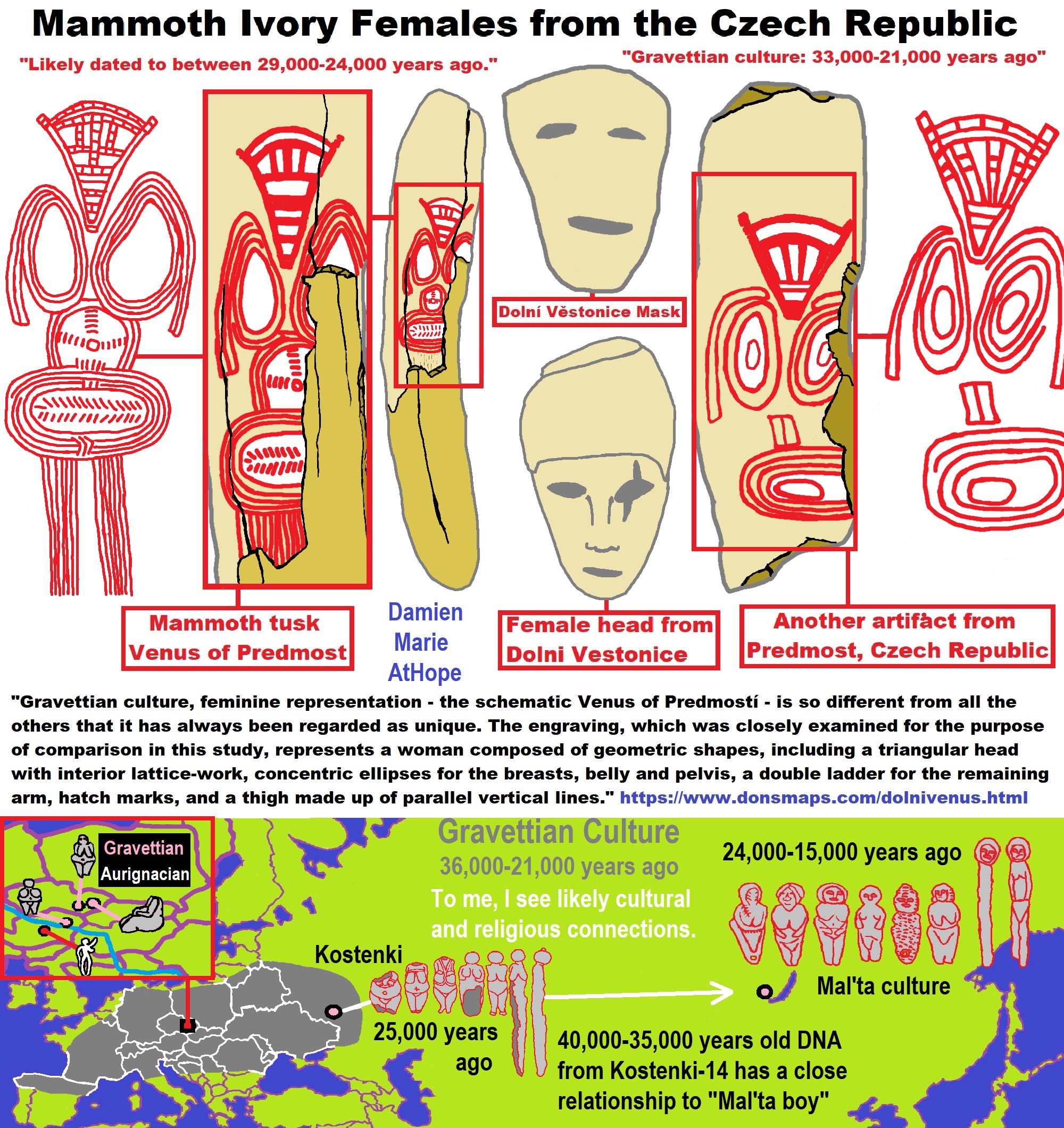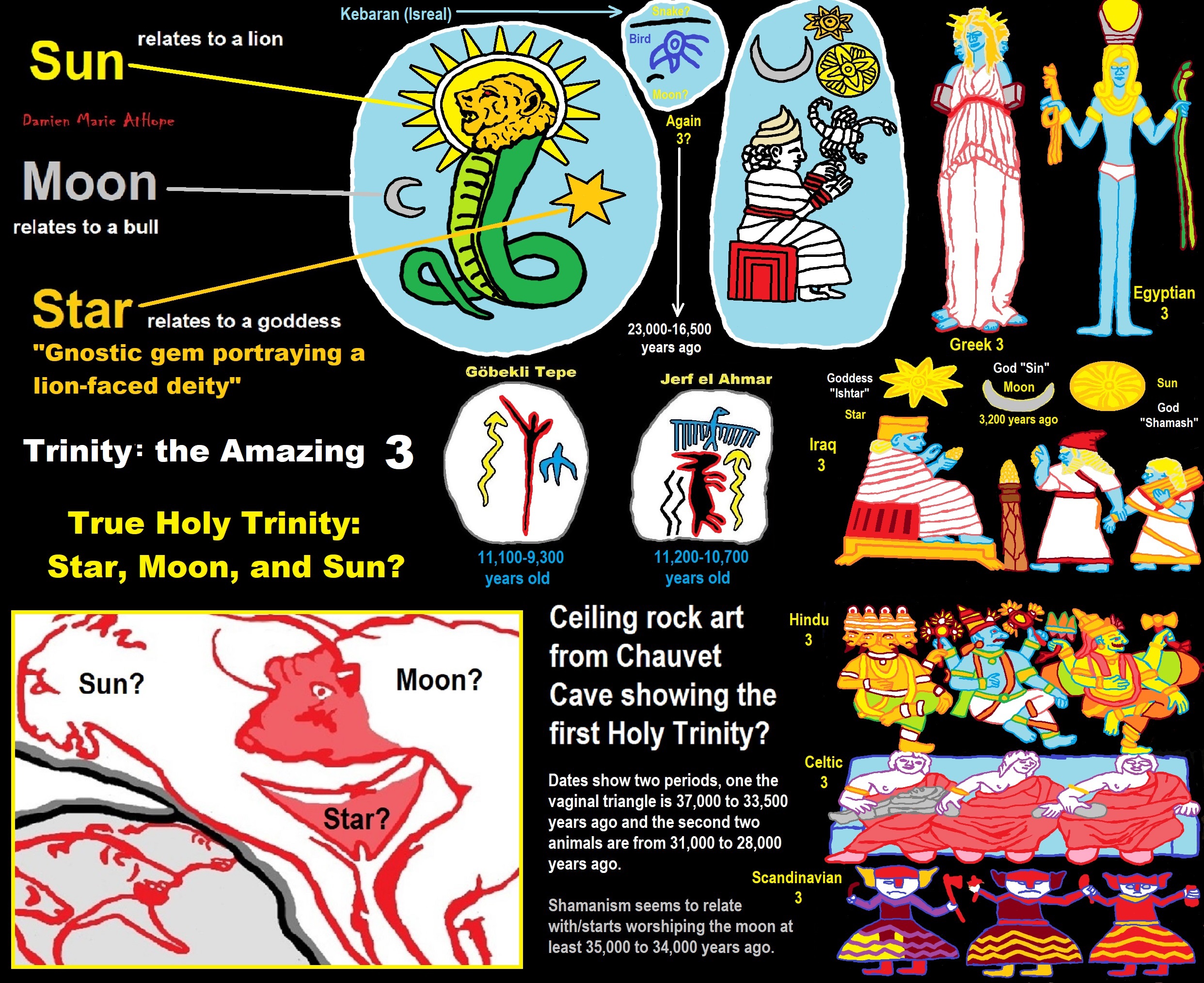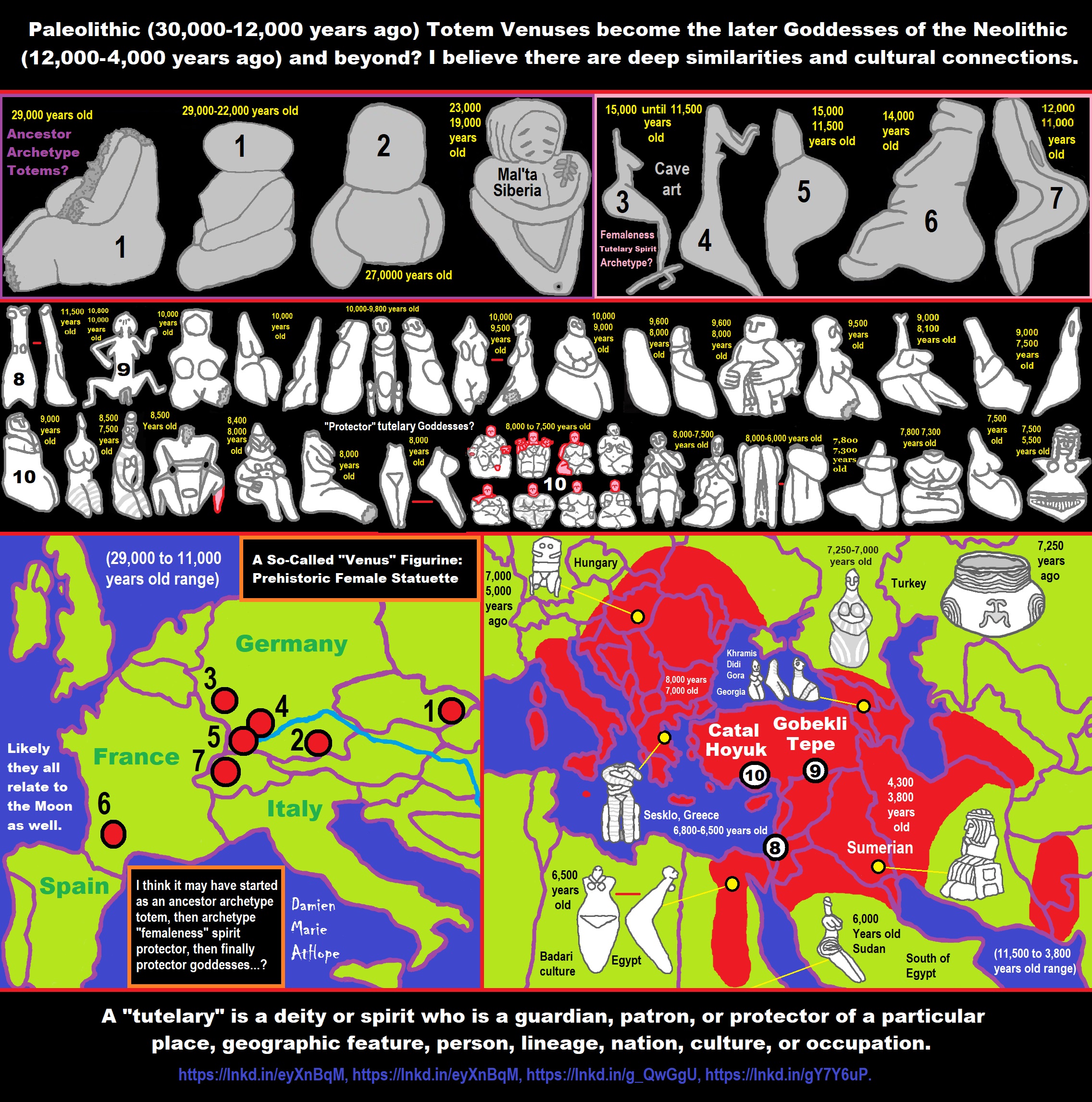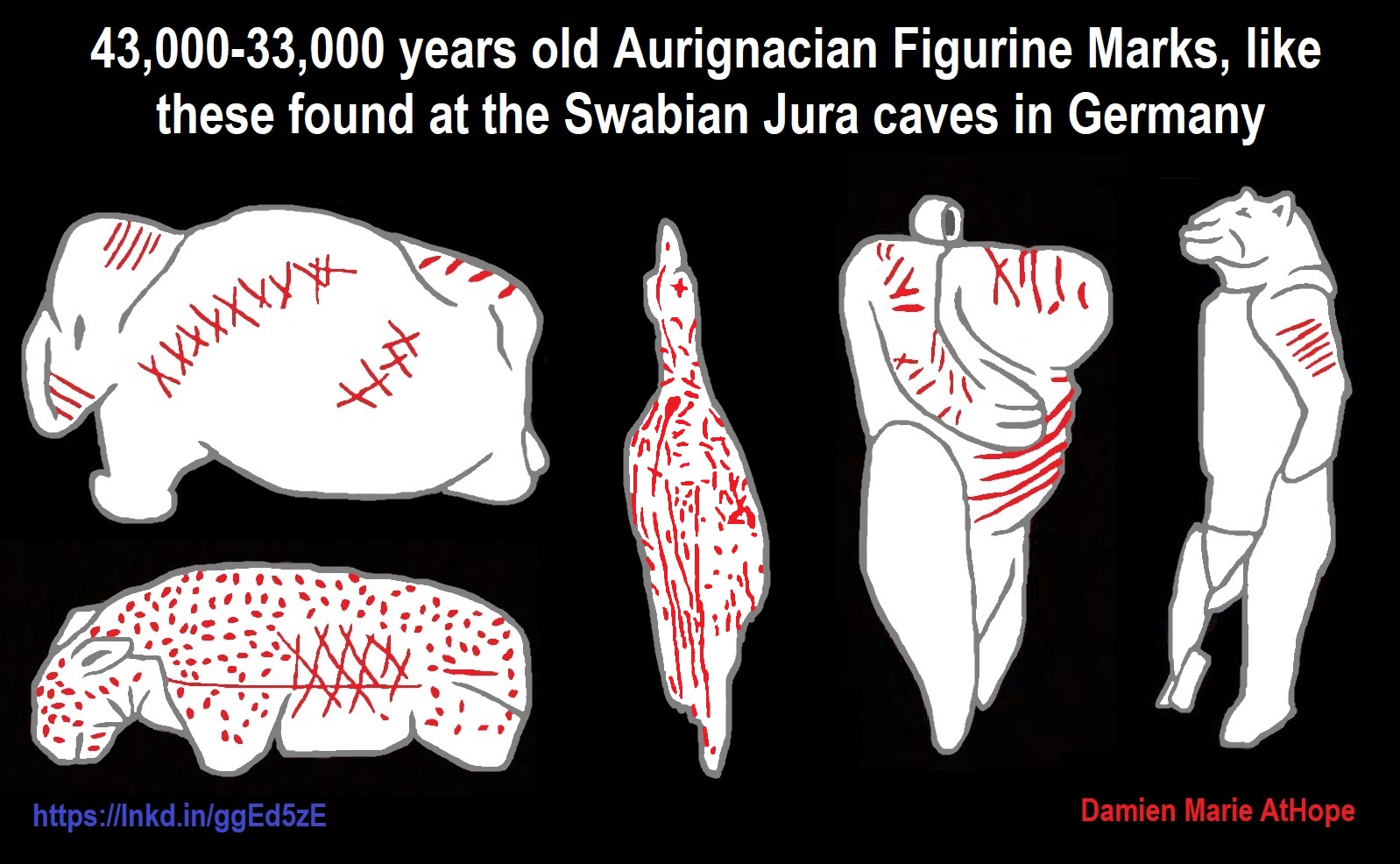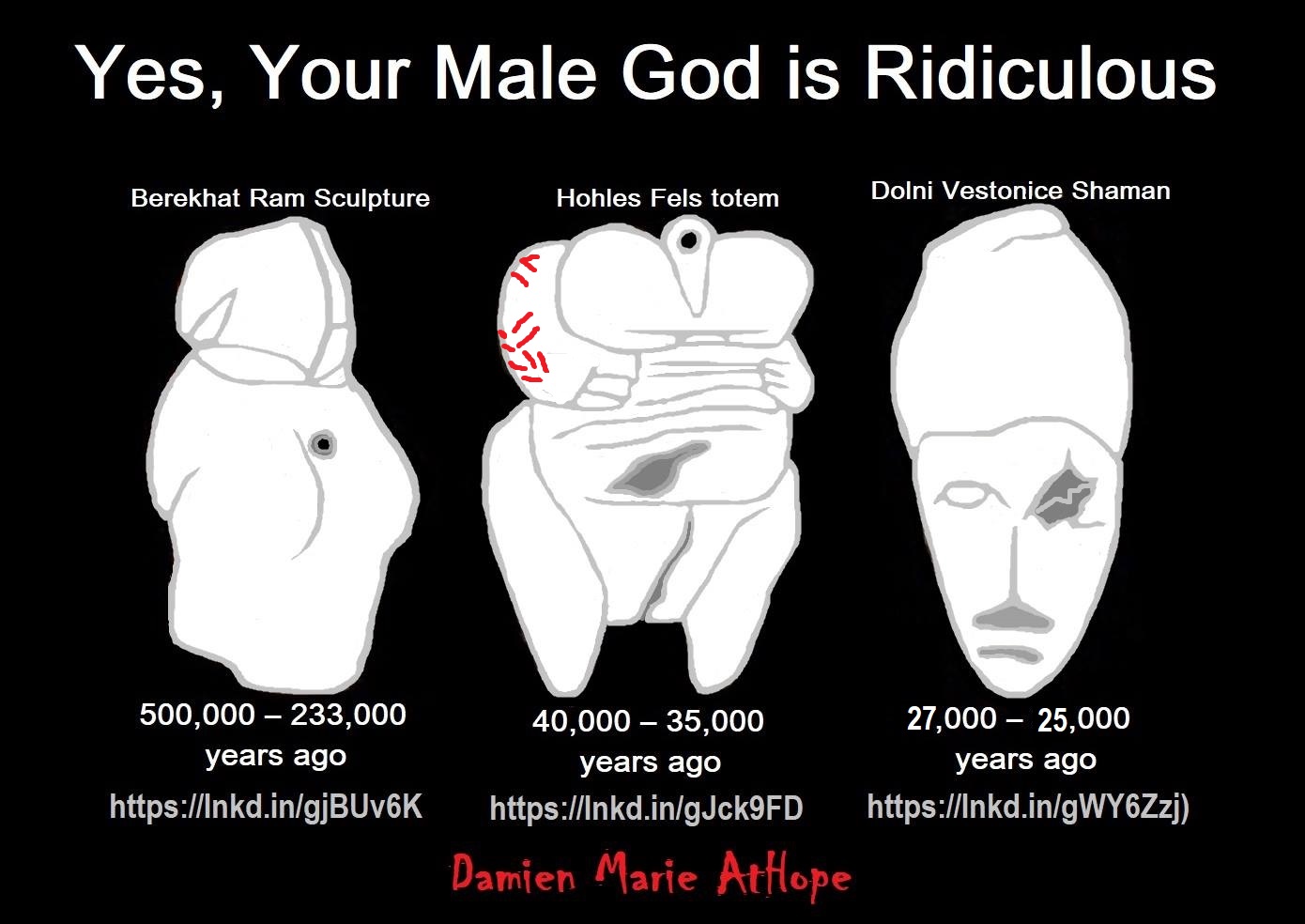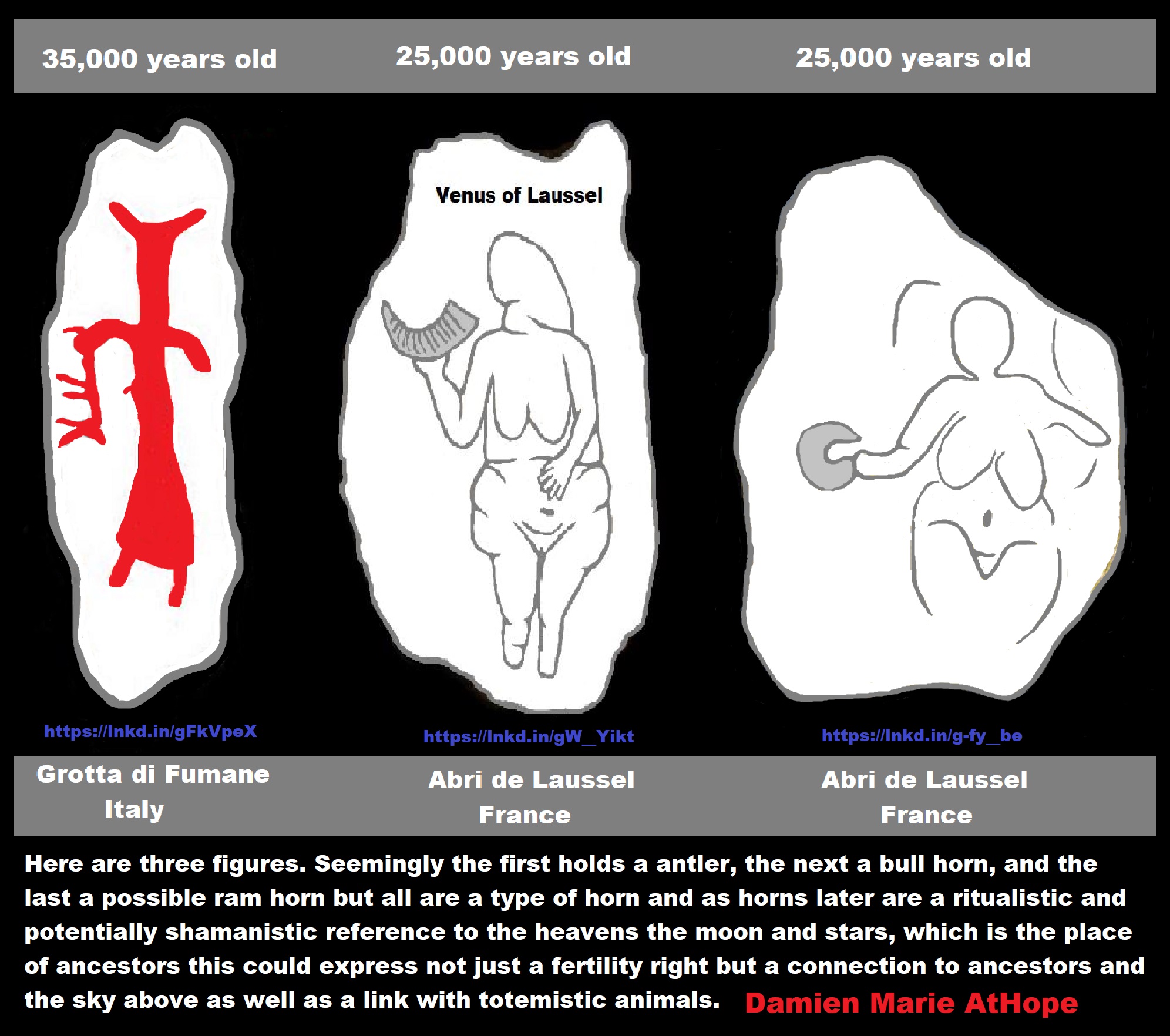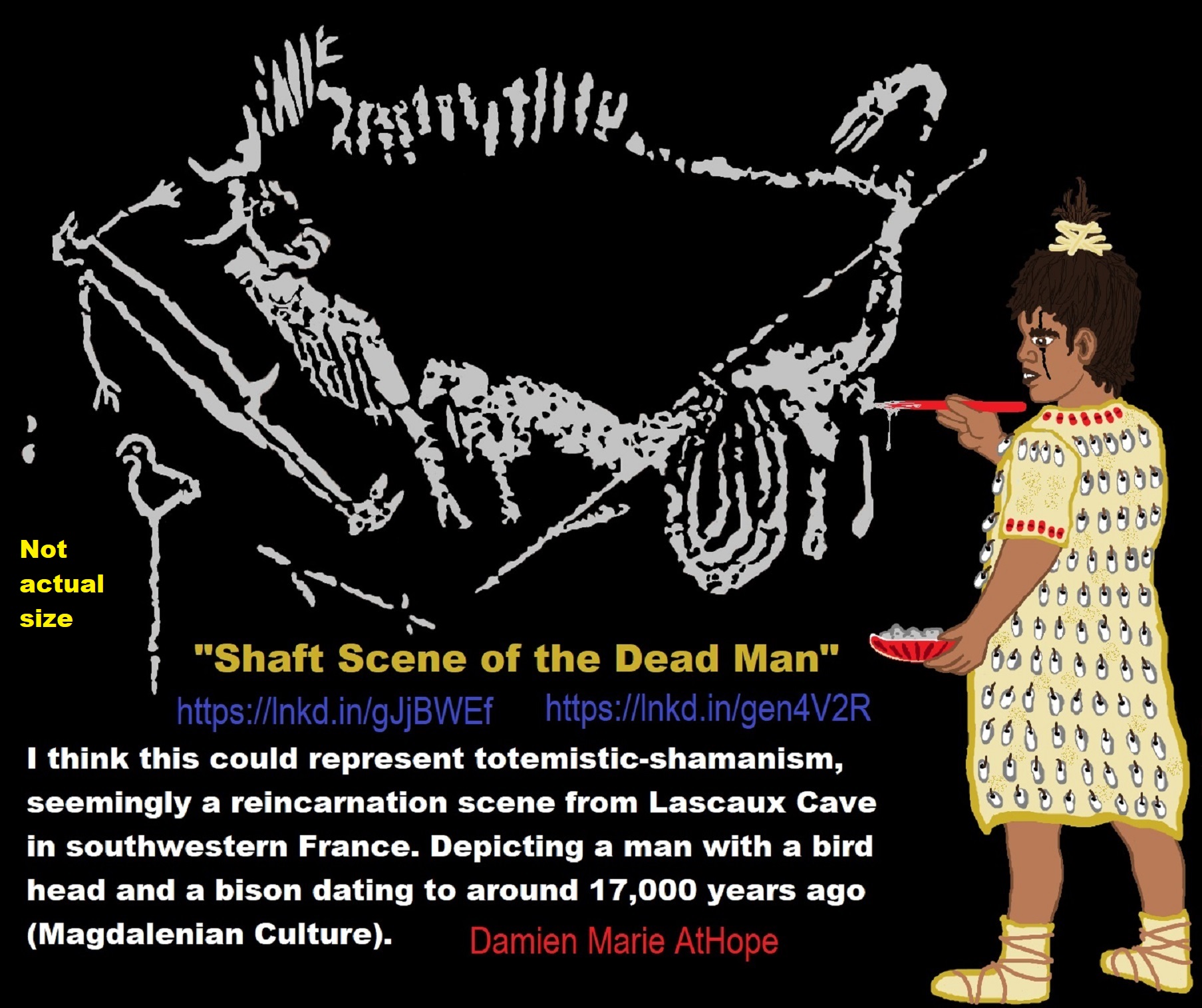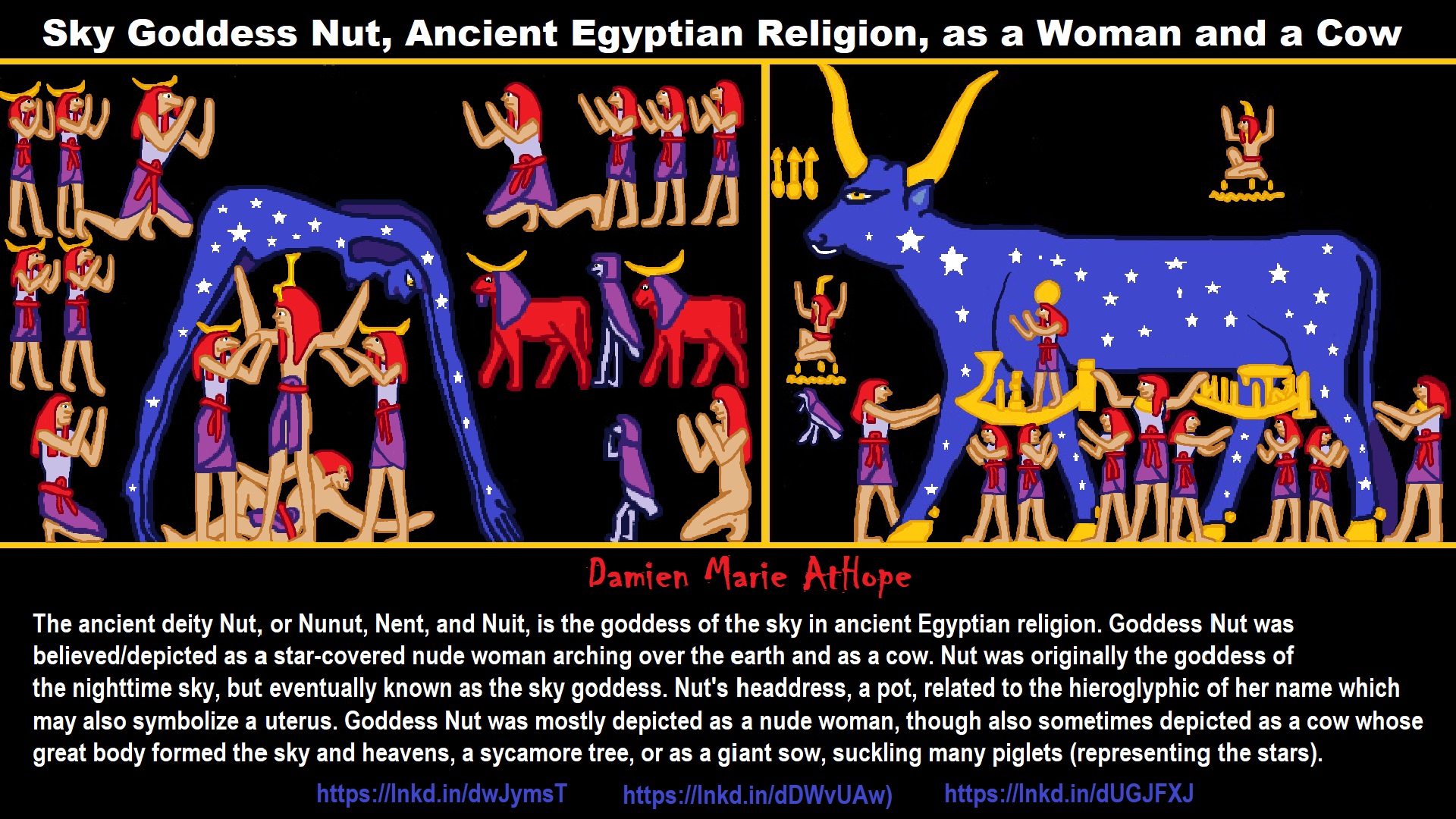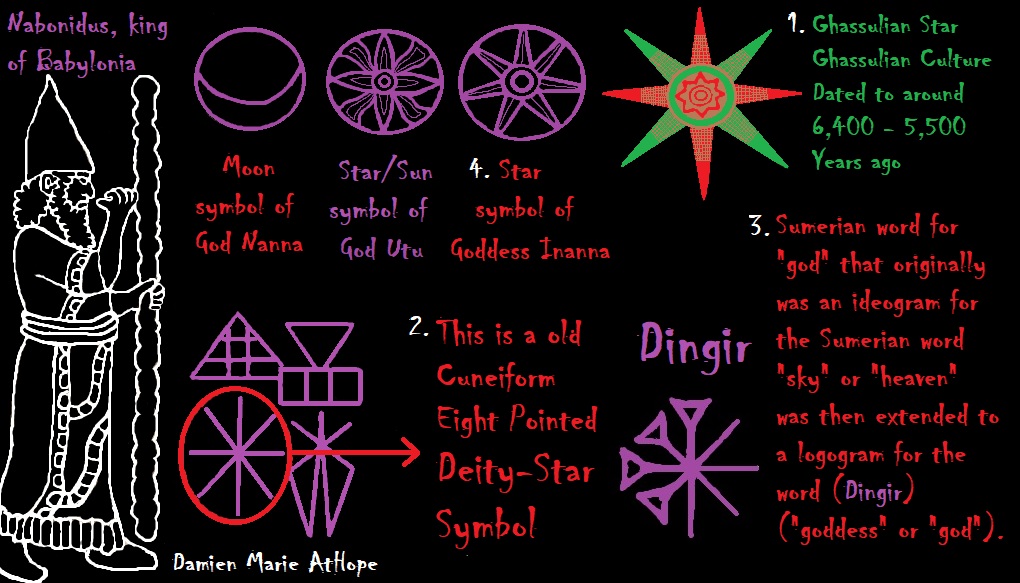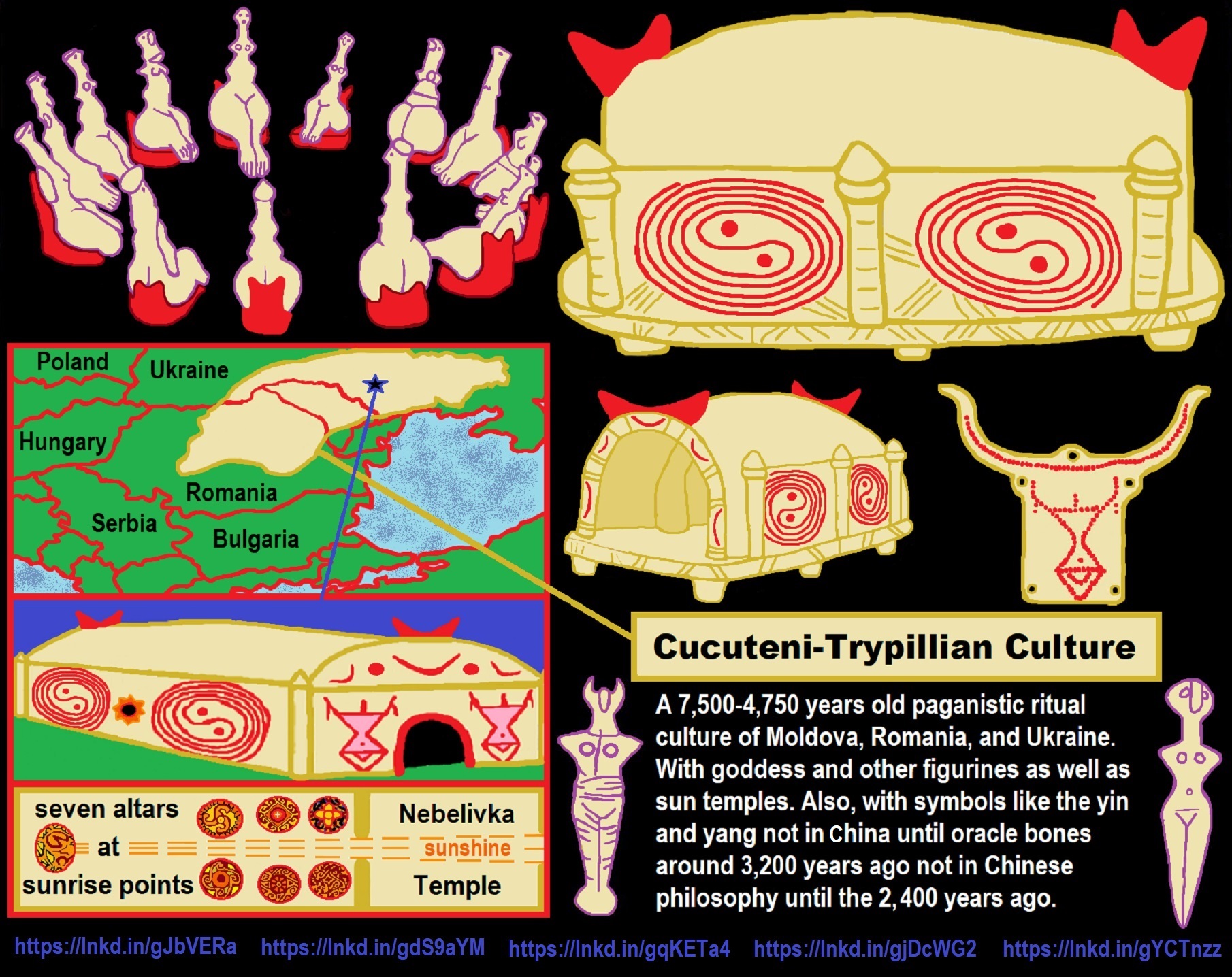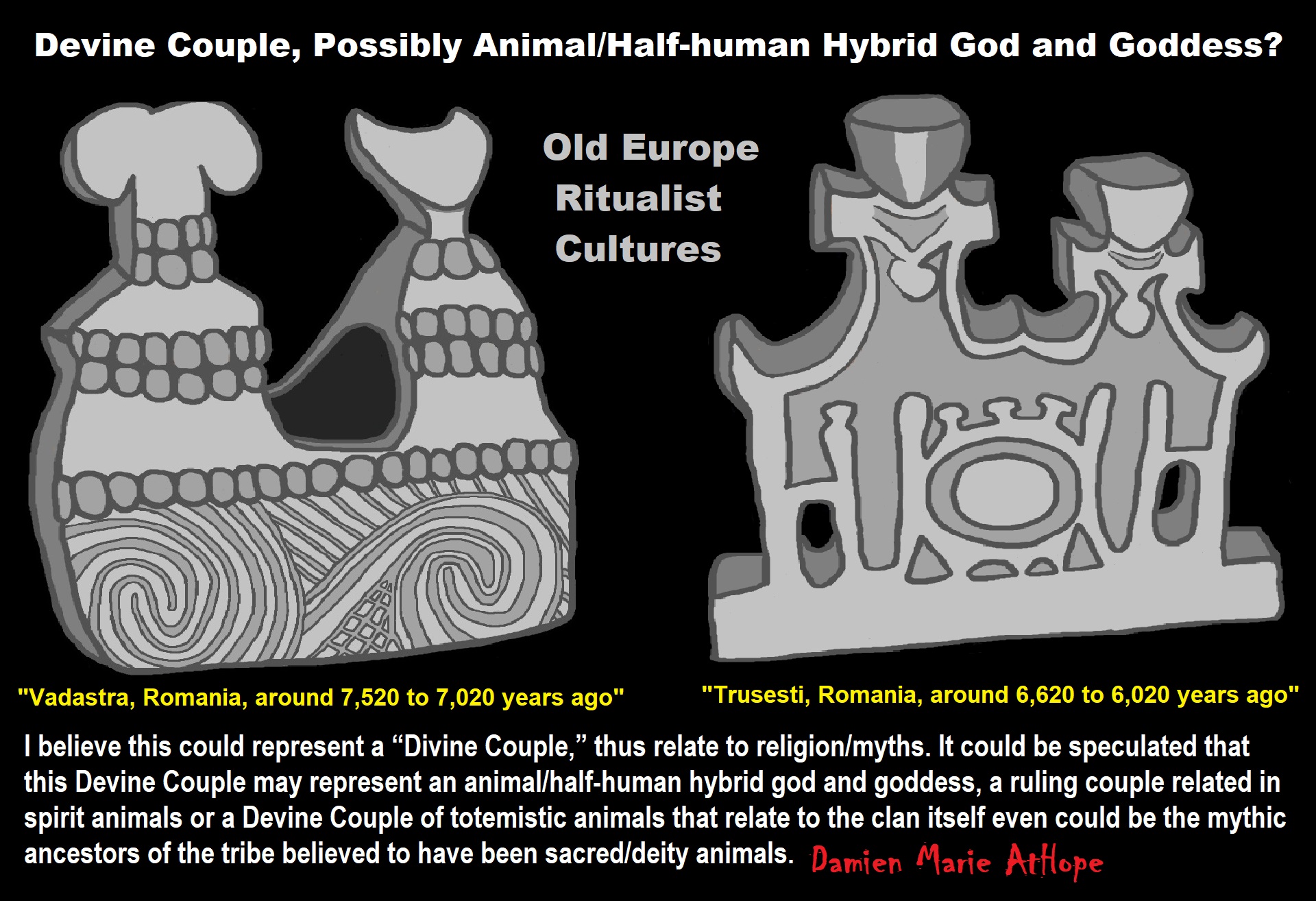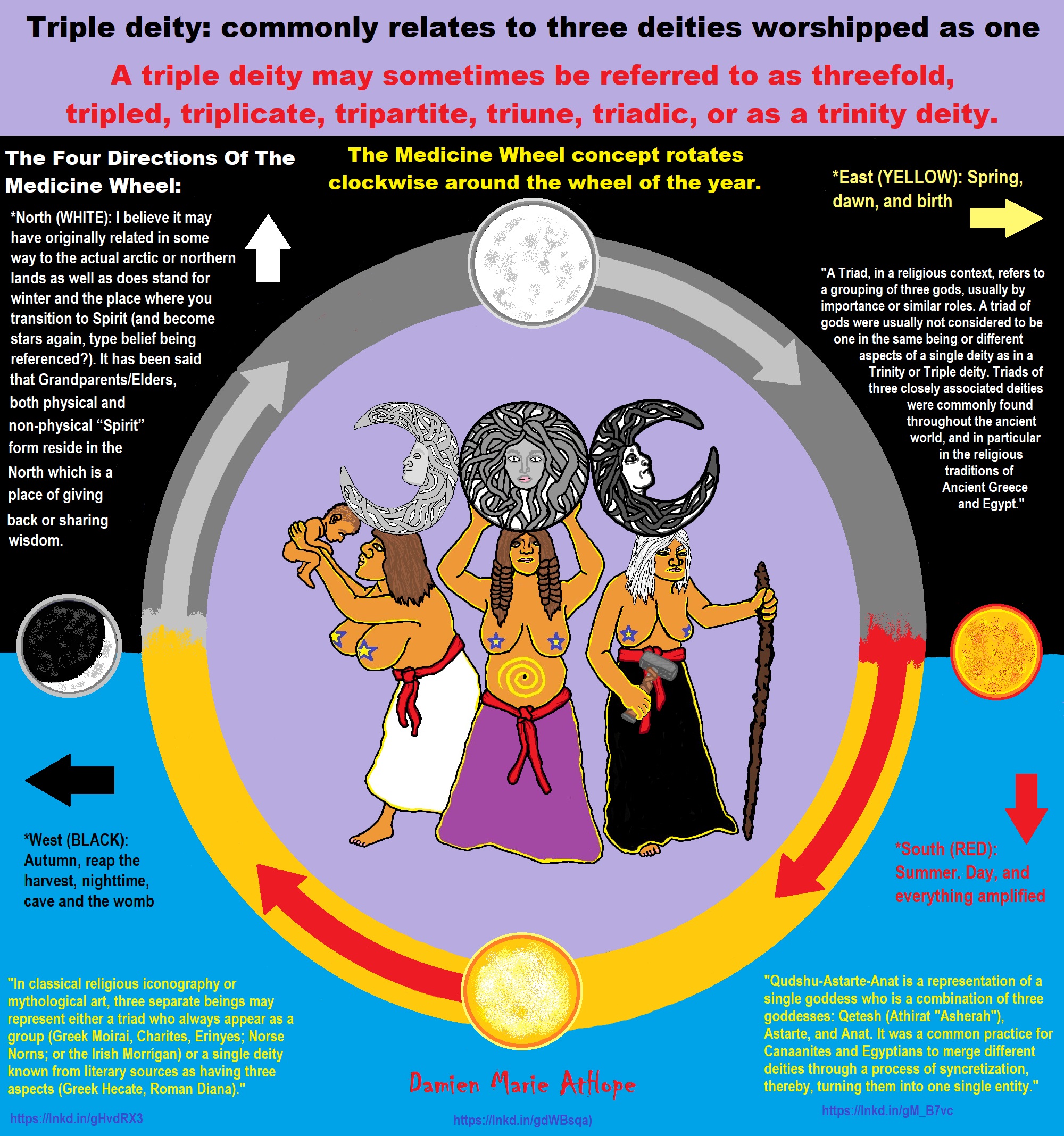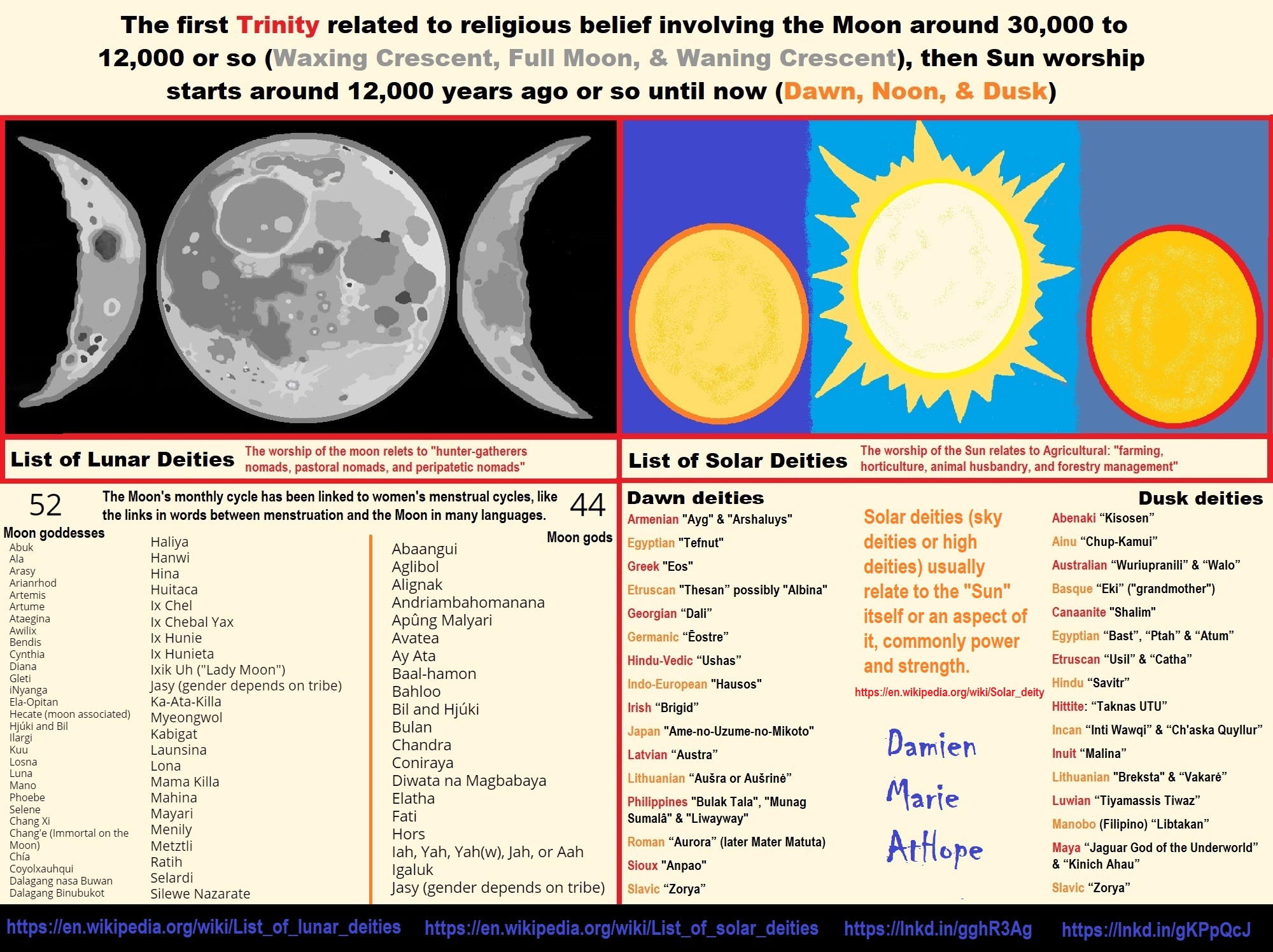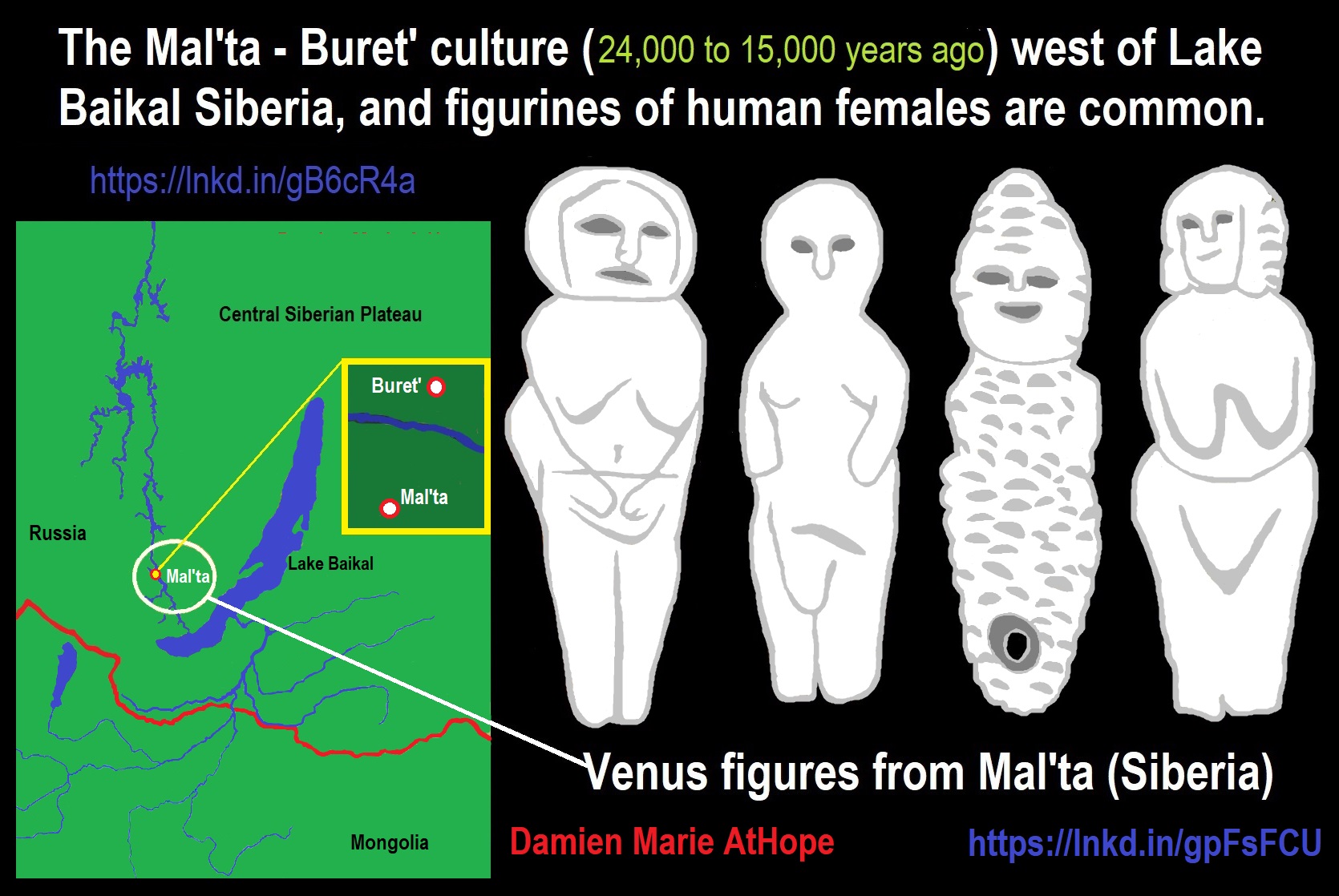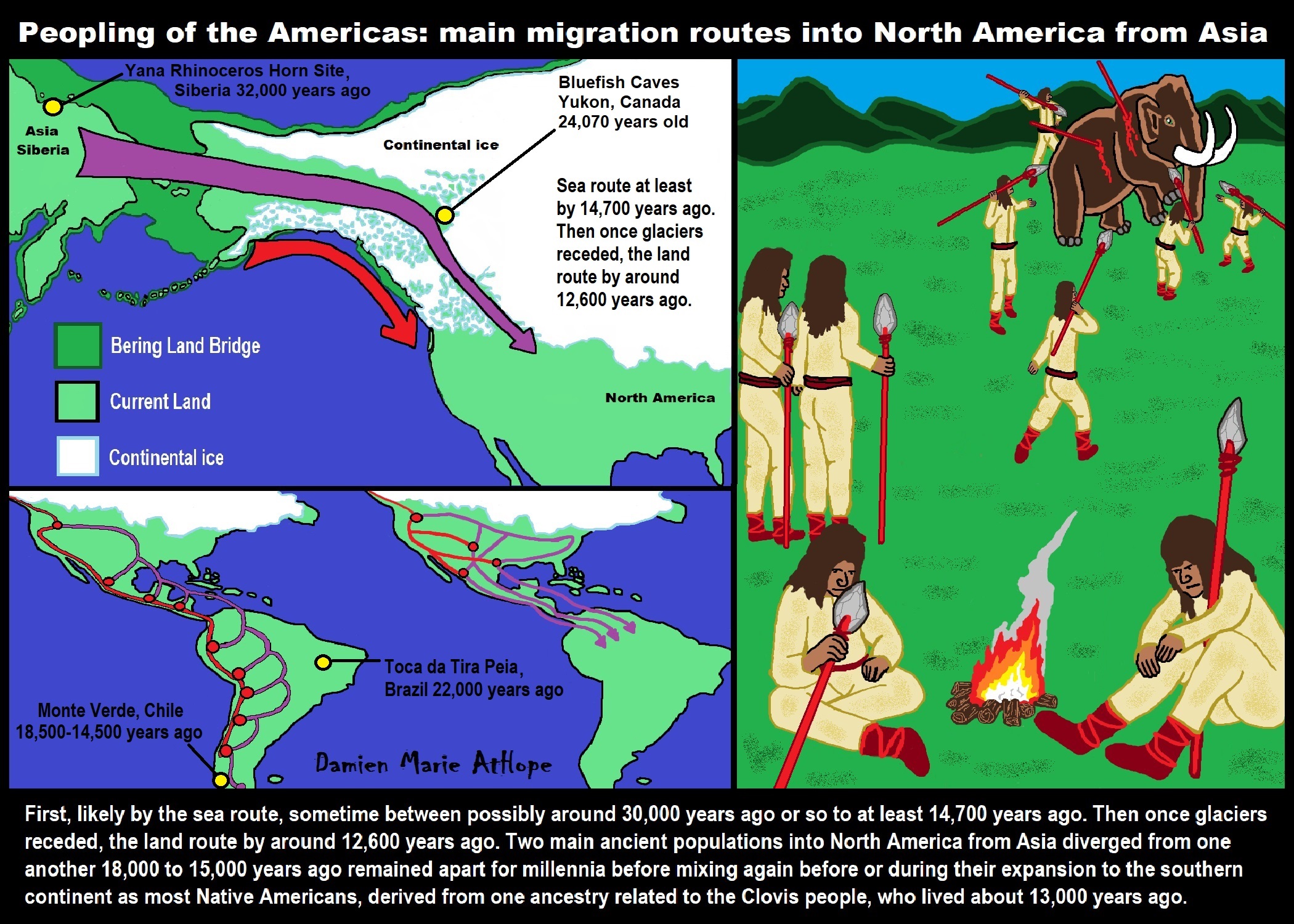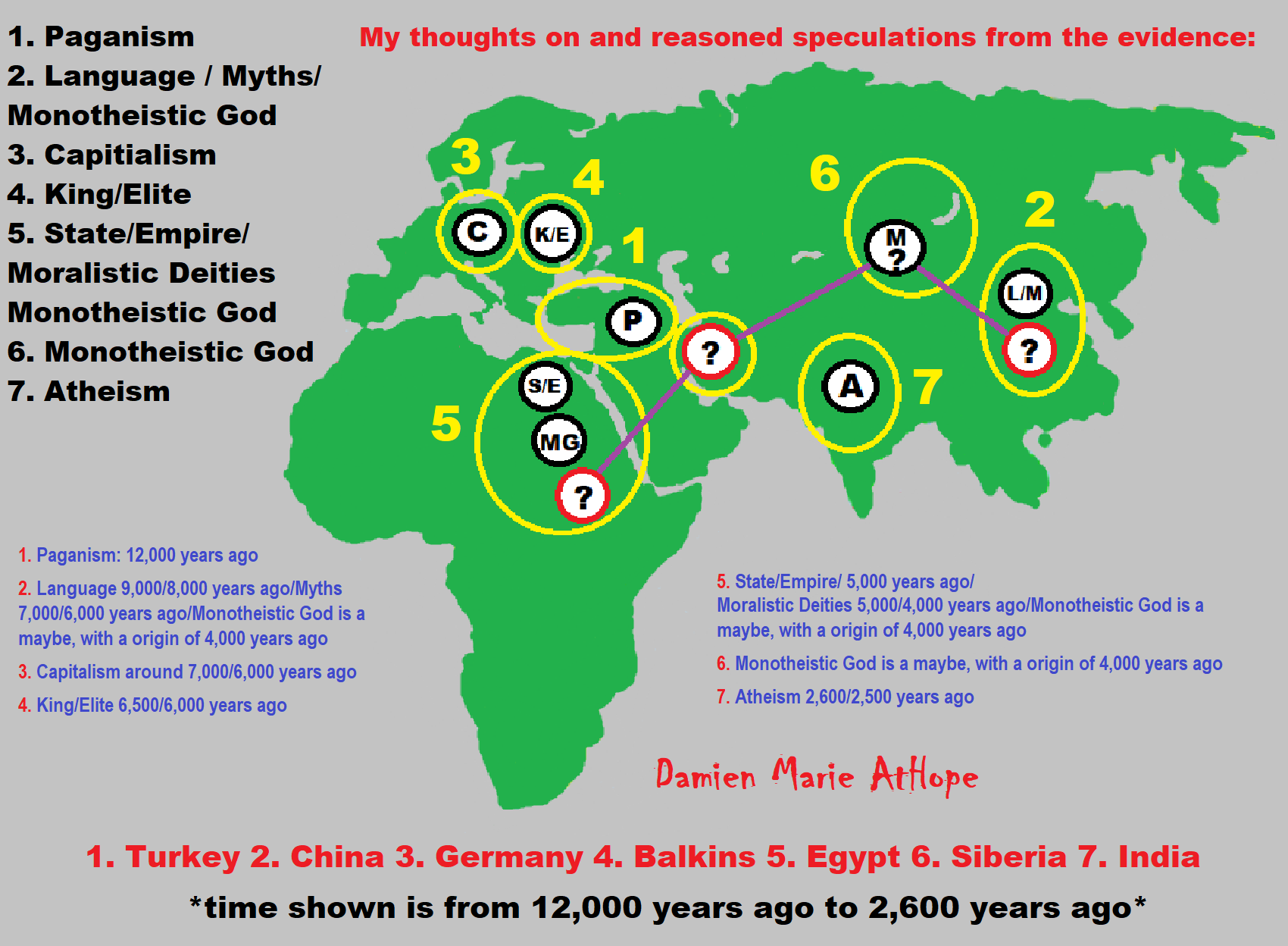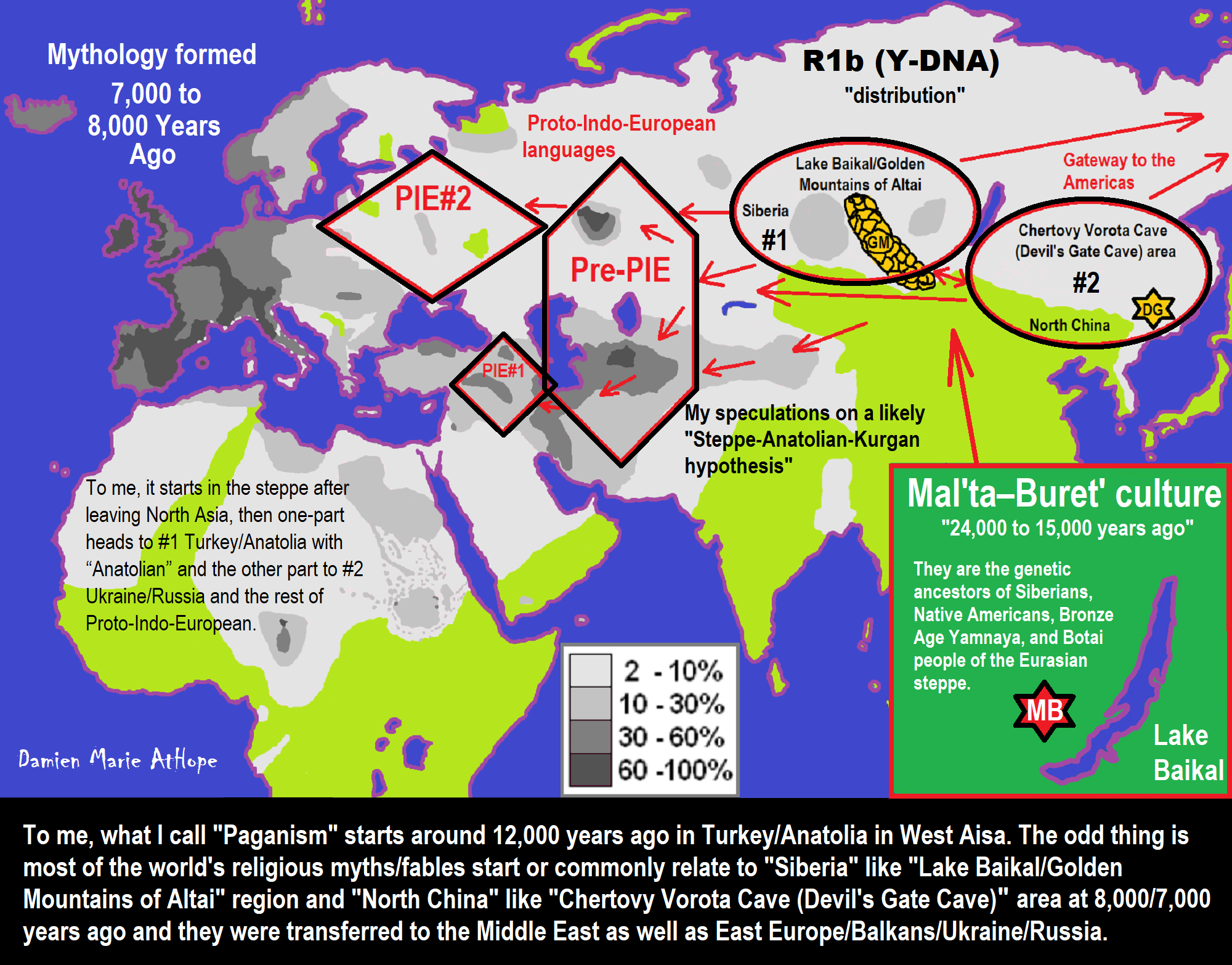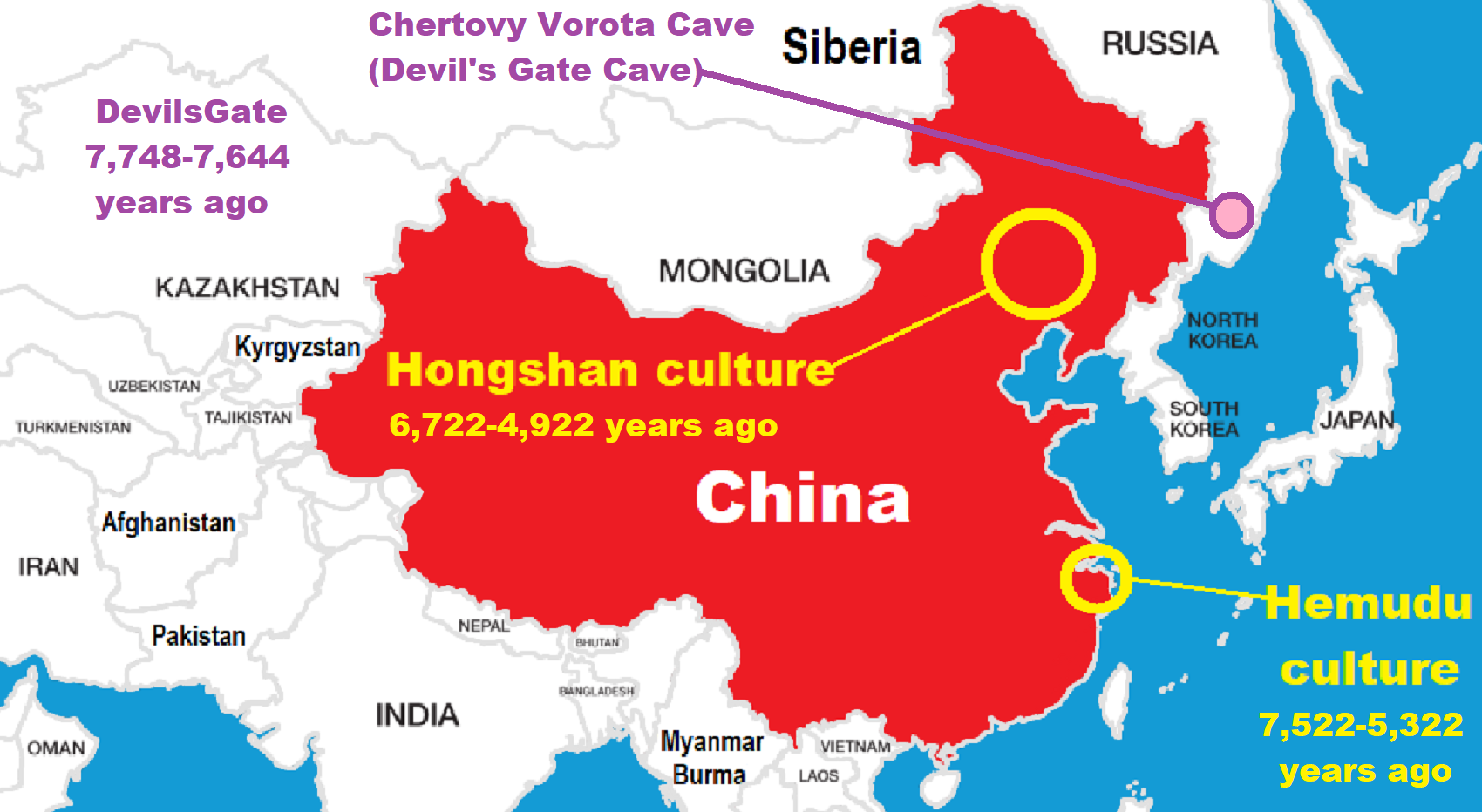
ref, ref, ref, ref, ref, ref, ref, ref, ref, ref, ref, ref, ref, ref, ref, ref, ref, ref, ref, ref, ref, ref
40,000 to 25,000 Years Old Ritual (Venus) Figurines and their Cultural Connections distributed across much of Eurasia, from the Aurignacian to the Gravettian Periods
Venus figurines
(I see them as representing Ancestor spirits/Earth or Nature Spirits/Tutelary spirits, not Deities)
“A Venus figurine is any Upper Palaeolithic statue portraying a woman, usually carved in the round. Most have been unearthed in Europe, but others have been found as far away as Siberia and distributed across much of Eurasia. Most date from the Gravettian period (26,000–21,000 years ago). However, findings are not limited to this period; for example, the Venus of Hohle Fels dates back at least 35,000 years to the Aurignacian era, and the Venus of Monruz dates back about 11,000 years to the Magdalenian. Such figurines were carved from soft stone (such as steatite, calcite or limestone), bone or ivory, or formed of clay and fired. The latter are among the oldest ceramics known to historians. In total, over 200 such figurines are known; virtually all of modest size, between about 3 and 40 cm (1.2 and 15.7 in) in height. These figurines are recognised as some of the earliest works of prehistoric art.” ref
“Most have wide hips and legs that taper to a point. Arms and feet are often absent, and the head is usually small and faceless. Various figurines exaggerate the abdomen, hips, breasts, thighs, or vulva, although many found examples do not reflect these typical characteristics. Depictions of hairstyles can be detailed, and clothing or tattoos may be indicated. The original cultural meaning and purpose of these artefacts is not known. It has frequently been suggested that they may have served a ritual or symbolic function. There are widely varying and speculative interpretations of their use or meaning: they have been seen as religious figures, an expression of health and fertility, grandmother goddesses, or as self-depictions by female artists.” ref
“Upper Palaeolithic female figurines are collectively described as “Venus figurines” in reference to the Roman goddess of beauty Venus. The name was first used in the mid-nineteenth century by the Marquis de Vibraye, who discovered an ivory figurine and named it La Vénus impudique or Venus Impudica (“immodest Venus”). The Marquis then contrasted the ivory figurine to the Aphrodite Of Knidos, a Greco-Roman sculpture depicting Venus covering her naked body with both her hands. In the early 20th century, the general belief among scholars was that the figurines represent an ancient ideal of beauty. Since their discovery, considerable diversity in opinion amongst archaeologists and in palaeoanthropological literature has arisen as to the function and significance of the figures. Most scholars that have differing opinions on the purpose of the figurines, such as anthropologist Randall White, also disapprove of the “Venus” name as a result.” ref
“The use of the name is metaphorical as there is no link between the ancient figurines and the Roman goddess Venus; although they have been interpreted as representations of a primordial female goddess. This perception is said to have derived from the fact that attention is directed to certain features common to most of the figurines, in particular emotionally charged primary and secondary sexual characteristics such as the breasts, stomachs and buttocks. The term has been criticised for being a reflection of modern Western ideas rather than reflecting the beliefs of the sculptures’ original owners, but the original names are unknown as well, so the term Venus has persisted. Like many prehistoric artefacts, the exact cultural meaning of these figures may never be known. Archaeologists speculate, however, that they may be symbolic of security and success, fertility, or a mother goddess. The female figures are a part of Upper Palaeolithic art, specifically the category of Palaeolithic art known as portable art.” ref
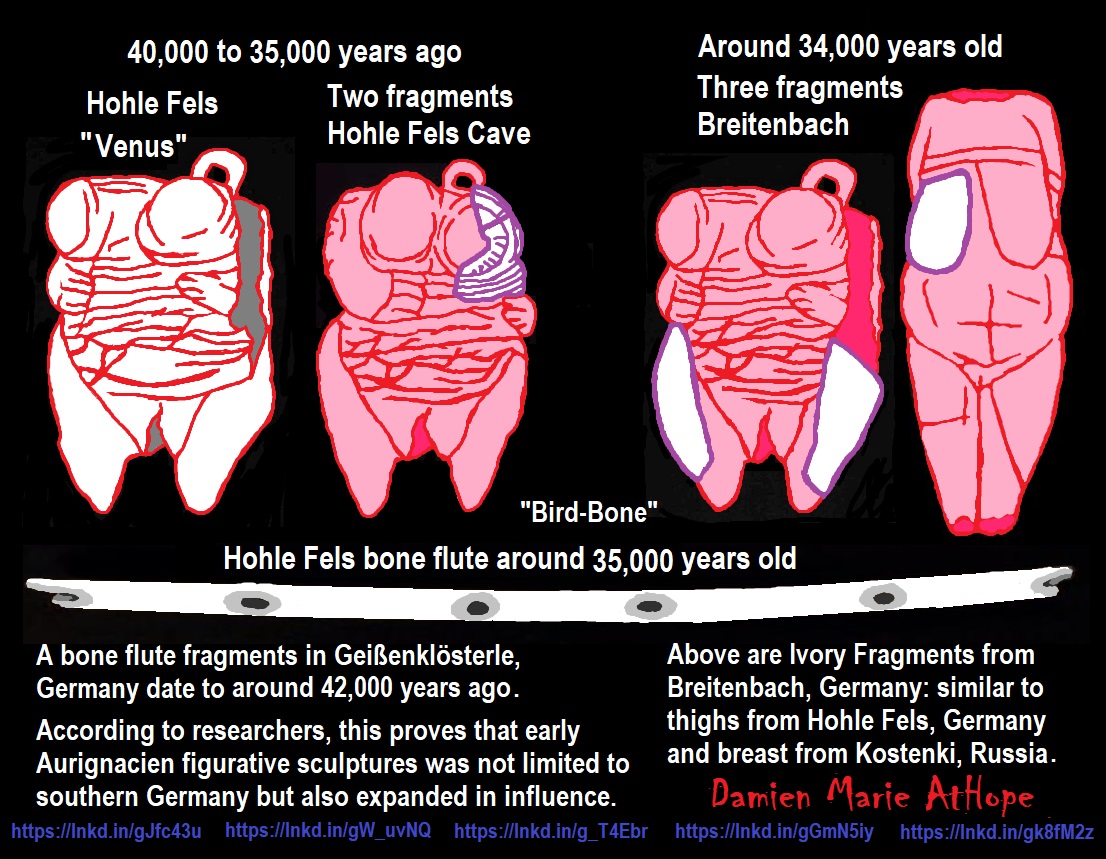
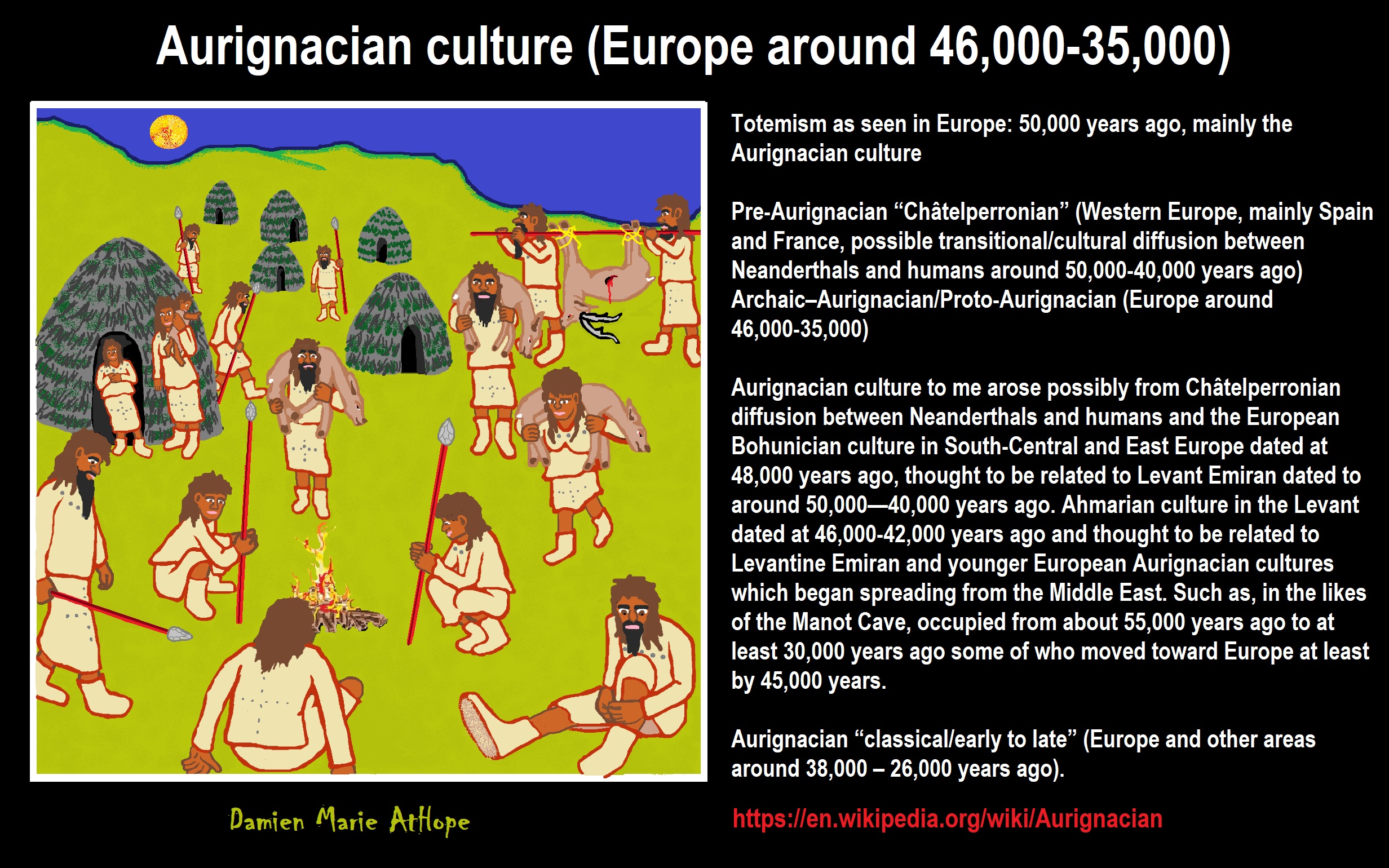
Châtelperronian Culture
“The Châtelperronian is a proposed industry of the Upper Palaeolithic, the existence of which is debated. It represents both the only Upper Palaeolithic industry made by Neanderthals and the earliest Upper Palaeolithic industry in Central and Southwestern France, as well as in Northern Spain. It derives its name from Châtelperron, Allier, France (the closest commune to the type site, the cave La Grotte des Fées). It is preceded by the Mousterian industry, and lasted from c. 45,000 to c. 40,000 years ago. The industry produced denticulate stone tools, and a distinctive flint knife with a single cutting edge and a blunt, curved back. The use of ivory at Châtelperronian sites appears to be more frequent than that of the later Aurignacian, while antler tools have not been found. It is followed by the Aurignacian industry. Scholars who question its existence claim that it is an archaeological mix of Mousterian and Aurignacian layers. The Châtelperronian industry may relate to the origins of the very similar Gravettian culture. French archaeologists have traditionally classified both cultures together under the name Périgordian, Early Perigordian being equivalent to the Châtelperronian and all the other phases corresponding to the Gravettian, though this scheme is not often used by Anglophone authors.” ref
Aurignacian Culture
“Key Issues/Current Debates: Variants of the Aurignacian Across Time and Space… Today, the Aurignacian is separated into many variants that are thought to be temporally or spatially meaningful. The first is the Protoaurignacian (i.e., Proto-Aurignacian, Fumanian) characterized by the production of large (c. 30–45 mm), straight bladelets (subtype
Dufour) from prismatic and pyramidal cores seen by some as the oldest phase of the Aurignacian. In southwest France, northern Italy, and Spain, when found together, the ProtoAurignacian is always superimposed by the Classic (Early)
Aurignacian where bladelets are generally produced from carinated cores. This production method resulted in smaller bladelets (c. 15–20 mm) with characteristic “twisted” profiles that were often retouched into Dufour bladelets (subtype Roc du Combe). However further east, where the ProtoAurignacian is less known, Classic Aurignacian assemblages often
directly follow the Middle Paleolithic and so-called transitional industries and are associated with radiocarbon dates as old as the first occurrence of the ProtoAurignacian in the Mediterranean thus making it difficult to simply consider the two assemblages as successive stages of the same cultural unit. It is also thought by some that the Classic Aurignacian later grew into the Late (Evolved) Aurignacian that is defined as having a larger, more varied tool kit including (backed) micro-
blades. However, such assemblages often share many cultural traits associated with the Gravettian, possibly relating to mechanical admixture, or suggesting that they represent a distinct cultural phenomenon.” ref
“The Aurignacian is an archaeological industry of the Upper Paleolithic associated with European early modern humans (EEMH) lasting from 43,000 to 26,000 years ago. The Upper Paleolithic developed in Europe some time after the Levant, where the Emiran period and the Ahmarian period form the first periods of the Upper Paleolithic, corresponding to the first stages of the expansion of Homo sapiens out of Africa. They then migrated to Europe and created the first European culture of modern humans, the Aurignacian. An Early Aurignacian or Proto-Aurignacian stage is dated between about 43,000 and 37,000 years ago. The Aurignacian proper lasts from about 37,000 to 33,000 years ago. A Late Aurignacian phase transitional with the Gravettian dates to about 33,000 to 26,000 years ago. The type site is the Cave of Aurignac, Haute-Garonne, south-west France. The main preceding period is the Mousterian of the Neanderthals.” ref
“One of the oldest examples of figurative art, the Venus of Hohle Fels, comes from the Aurignacian or Proto-Gravettian and is dated to between 40,000 and 35,000 years ago (though now earlier figurative art may be known, see Lubang Jeriji Saléh). It was discovered in September 2008 in a cave at Schelklingen in Baden-Württemberg in western Germany. The German Lion-man figure is given a similar date range. The Bacho Kiro site in Bulgaria is one of the earliest known Aurignacian burials. A “Levantine Aurignacian” culture is known from the Levant, with a type of blade technology very similar to the European Aurignacian, following chronologically the Emiran and Early Ahmarian in the same area of the Near East, and also closely related to them. The Levantine Aurignacian may have preceded European Aurignacian, but there is a possibility that the Levantine Aurignacian was rather the result of reverse influence from the European Aurignacian: this remains unsettled.” ref
“Expansion of early modern humans from Africa through the Levant were the Levantine Aurignacian stage has been identified.” ref
“The Aurignacian is an archaeological tradition of the Upper Paleolithic associated with European early modern humans (EEMH) lasting from 43,000 to 26,000 years ago. The Upper Paleolithic developed in Europe sometime after the Levant, where the Emiran period and the Ahmarian period form the first periods of the Upper Paleolithic, corresponding to the first stages of the expansion of Homo sapiens out of Africa. They then migrated to Europe and created the first European culture of modern humans, the Aurignacian. An Early Aurignacian or Proto-Aurignacian stage is dated between about 43,000 and 37,000 years ago. The Aurignacian proper lasts from about 37,000 to 33,000 years ago. A Late Aurignacian phase transitional with the Gravettian dates to about 33,000 to 26,000 years ago. The type site is the Cave of Aurignac, Haute-Garonne, south-west France. The main preceding period is the Mousterian of the Neanderthals. One of the oldest examples of figurative art, the Venus of Hohle Fels, comes from the Aurignacian and is dated to between 40,000 and 35,000 years ago (though now earlier figurative art may be known, see Lubang Jeriji Saléh). It was discovered in September 2008 in a cave at Schelklingen in Baden-Württemberg in western Germany. The German Lion-man figure is given a similar date range. The Bacho Kiro site in Bulgaria is one of the earliest known Aurignacian burials. A “Levantine Aurignacian” culture is known from the Levant, with a type of blade technology very similar to the European Aurignacian, following chronologically the Emiran and Early Ahmarian in the same area of the Near East, and also closely related to them. The Levantine Aurignacian may have preceded European Aurignacian, but there is a possibility that the Levantine Aurignacian was rather the result of reverse influence from the European Aurignacian: this remains unsettled.” ref
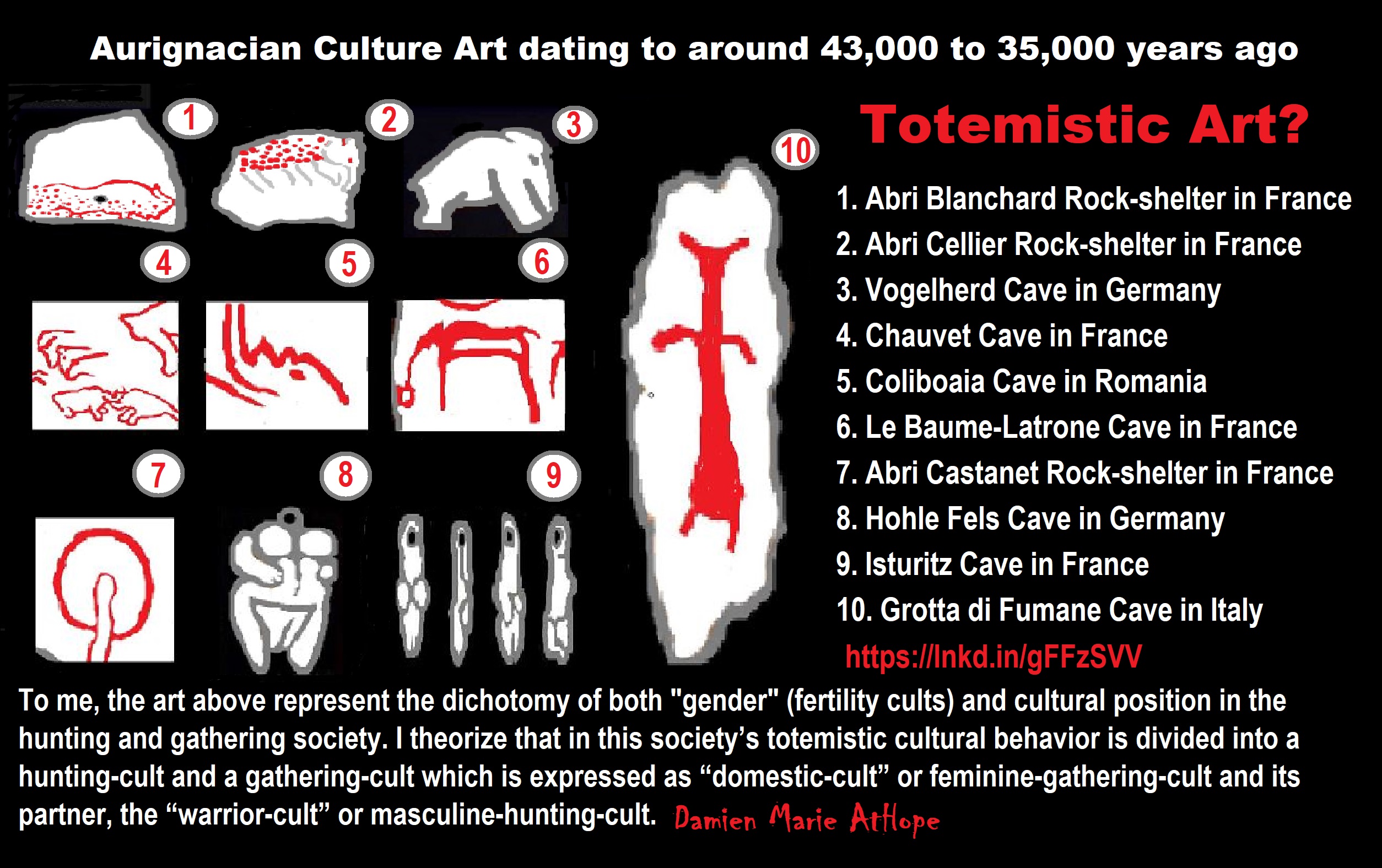

Understanding Religion Evolution per Damien’s speculations from the evidence:
Pre-Animism (at least 300,000 years ago) possibly Africa, Middle East, and Eurasia
Animism (at least 100,000 years ago) possibly Southern Africa or maybe Central Africa
Totemism (at least 50,000/45,000 years ago) possibly around Germany, France, or somewhere in West Europe
Shamanism (at least 30,000/35,000 years ago) possibly West Siberia or East Russia
Paganism (at least 12,000/13,000 years ago) Turkey And/or Levant: “Israel, Jordan, Lebanon, Palestine, Syria”
Progressed organized religion (at least 5,000 years ago), (Egypt, the First Dynasty 5,150 years ago)
I think animism started 100,000 years ago, totemism 50,000-45,000 years ago, and shamanism 30,000-35,000 years ago.
Animism (simplified to me as a belief in a perceived spirit world) passably by at least 100,000 years ago “the primal stage of early religion” To me, Animistic Somethingism: You just feel/think there has to be something supernatural/spirit-world or feel/think things are supernatural/spirit-filled.
Totemism (simplified to me, as a belief that these perceived spirits could be managed or related with by created physical expressions) passably by at least 50,000 years ago “progressed stage of early religion” A totem is a representational spirit being, a sacred object, or symbol of a group of people, clan, or tribe.
Shamanism (simplified to me as a belief that some special person can commune with these perceived spirits on the behalf of others by way of rituals) passably by at least 30,000 years ago Shamanism is an otherworld connection belief thought to heal the sick, communicate with spirits/deities, and escort souls of the dead.
Shamanism (such as that seen in Siberia Gravettian culture: 30,000 years ago)
Gravettian culture (34,000–24,000 years ago; Western Gravettian, mainly France, Spain, and Britain, as well as Eastern Gravettian in Central Europe and Russia. The eastern Gravettians, which include the Pavlovian culture). And, the Pavlovian culture (31,000 – 25,000 years ago such as in Austria and Poland). 31,000 – 20,000 years ago Oldest Shaman was Female, Buried with the Oldest Portrait Carving.
Shamanism is approximately a 30,000-year-old belief system and believe in spirit-filled life and/or afterlife that can be attached to or be expressed in things or objects and these objects can be used by special persons or in special rituals that can connect to spirit-filled life and/or afterlife. If you believe like this, regardless of your faith, you are a hidden shamanist.
Around 29,000 to 25,000 years ago in Dolní Vestonice, Czech Republic, the oldest human face representation is a carved ivory female head that was found nearby a female burial and belong to the Pavlovian culture, a variant of the Gravettian culture. The left side of the figure’s face was a distorted image and is believed to be a portrait of an elder female, who was around 40 years old. She was ritualistically placed beneath a pair of mammoth scapulae, one leaning against the other. Surprisingly, the left side of the skull was disfigured in the same manner as the aforementioned carved ivory figure, indicating that the figure was an intentional depiction of this specific individual. The bones and the earth surrounding the body contained traces of red ocher, a flint spearhead had been placed near the skull, and one hand held the body of a fox. This evidence suggests that this was the burial site of a shaman. This is the oldest site not only of ceramic figurines and artistic portraiture but also of evidence of early female shamans. Before 5,500 years ago, women were much more prominent in religion.
Archaeologists usually describe two regional variants: the western Gravettian, known namely from cave sites in France, Spain, and Britain, and the eastern Gravettian in Central Europe and Russia. The eastern Gravettians include the Pavlovian culture, which were specialized mammoth hunters and whose remains are usually found not in caves but in open air sites. The origins of the Gravettian people are not clear, they seem to appear simultaneously all over Europe. Though they carried distinct genetic signatures, the Gravettians and Aurignacians before them were descended from the same ancient founder population. According to genetic data, 37,000 years ago, all Europeans can be traced back to a single ‘founding population’ that made it through the last ice age. Furthermore, the so-called founding fathers were part of the Aurignacian culture, which was displaced by another group of early humans members of the Gravettian culture. Between 37,000 years ago and 14,000 years ago, different groups of Europeans were descended from a single founder population. To a greater extent than their Aurignacian predecessors, they are known for their Venus figurines.
Haplogroup R possible origin in Central Asia, South Asia, or Siberia and seen in several cultures:
Mal’ta–Buret’ culture (24,000-15,000 years ago)
Afontova Gora culture (21,000-12,000 years ago)
Trialetian culture (16,000–8000 years ago)
Samara culture (7,000-6,500 years ago)
Khvalynsk culture (7,000-6,500 years ago)
Afanasievo culture (5,300-4,500 years ago)
Yamna/Yamnaya Culture (5,300-4,500 years ago)
Andronovo culture (4,000–2,900 years ago)
“Haplogroup U is a human mitochondrial DNA haplogroup (mtDNA). The clade arose from haplogroup R, likely during the early Upper Paleolithic. Basal U was found in the 26,000 years old remains of Ancient North Eurasian, Mal’ta boy (MA1 24,000 years old). Its various subclades (labelled U1–U9, diverging over the course of the Upper Paleolithic) are found widely distributed across Northern and Eastern Europe, Central, Western and South Asia, as well as North Africa, the Horn of Africa, and the Canary Islands. In a 2013 study, all but one of the ancient modern human sequences from Europe belonged to maternal haplogroup U, thus confirming previous findings that haplogroup U was the dominant type of Mitochondrial DNA (mtDNA) in Europe before the spread of agriculture into Europe and the presence and the spread of the Indo-Europeans in Western Europe. The age of U5 is estimated at between 25,000 and 35,000 years old, roughly corresponding to the Gravettian culture. Approximately 11% of Europeans (10% of European-Americans) have some variant of haplogroup U5. U5 was the predominant mtDNA of mesolithic Western Hunter Gatherers (WHG).” ref
“U5 has been found in human remains dating from the Mesolithic in England, Germany, Lithuania, Poland, Portugal, Russia, Sweden, France and Spain. Neolithic skeletons (around 7,000 years old or so) that were excavated from the Avellaner cave in Catalonia, northeastern Spain included a specimen carrying haplogroup U5. Haplogroup U5 and its subclades U5a and U5b today form the highest population concentrations in the far north, among Sami, Finns, and Estonians. However, it is spread widely at lower levels throughout Europe. This distribution, and the age of the haplogroup, indicate individuals belonging to this clade were part of the initial expansion tracking the retreat of ice sheets from Europe around 10,000 years ago. U5b1b: has been found in Saami of Scandinavia, Finnish and the Berbers of North Africa, which were found to share an extremely young branch, aged merely around 9,000 years old or so. U5b1b was also found in Fulbe and Papel people in Guinea-Bissau and Yakuts people of northeastern Siberia. It arose around 11,000 years ago.” ref
Gravettian Culture “last European culture many consider unified” (33/35,000–24/20,000 years ago). Which Damien thinks expresses the first earliest shamanism. https://en.wikipedia.org/wiki/Gravettian
Pavlovian Culture “variant of the Gravettian” as seen in Czech Republic, Austria, and Poland (29,000–25,000 years ago). Which Damien thinks expresses the earliest burial of a shaman. https://en.wikipedia.org/wiki/Pavlovian_culture
Epigravettian Culture (Greek: epi “above, on top of”, and Gravettian, because they likely continued a lot of the Gravettian Culture) as seen in Southern and Eastern Europe (20,000–10,000 years ago) Which Damien thinks may have brought/influenced the people in the Middle East/Turkey to add belief in goddesses and female art/figurine themes to their early paganism emerging out or older shamanism 11,000/10,000 years ago. https://en.wikipedia.org/wiki/Epigravettian
Magdalenian Culture as seen in Western Europe: “The earliest Magdalenian sites are in France and the Epigravettian is a similar culture appearing around the same time” (17,000–12,000 years ago) Which Damien thinks started to evolve Western Eurasian shamanism. https://en.wikipedia.org/wiki/Magdalenian
“The Magdalenian constitutes a civilization in the full meaning of the term, with its unique metaphysics, social rules, exchanges codified with nature via its art and weaponry. Before any climatic improvement then, daring was enough to both distinguish these populations from those that disappeared on a European scale and to invent facultative weapons, a conquering mythology, appropriate displacements, episodic ruptures, long-distance relays, flexibility in control over all kinds of environments, ritual delegation by shamanism, the “descent” of mythical decoration of rock walls in favor of mobile supports, such as modern crucifixes or portable altars.” https://www.sciencedirect.com/science/article/abs/pii/S1040618212001450
The Evidence of Shamanism Rituals in Early Prehistoric Periods of Europe and Anatolia
“Shamanism Rituals in Palaeolithic Siberian shamans (Eastern Eurasian Shamanism) believe that shamanism emerged in the period when hunting and gathering was the main means to support. Ethnographic evidence suggests that hunter-gatherer groups would have seen the environment as giving and reciprocating, and that their spirit worlds would have consisted largely of animals and natural features with which shaman-like figures may have mediated. From this point of view, it is best to begin investigating prehistoric shamanism in Palaeolithic rituals and related cave paintings of Europe. The shamanic hypothesis that cave art is based on a fusion of direct evidence from the caves themselves with observations of more recent hunter-gatherer societies that still produce rock art. However, not all cultures have specific shamanic ritual locations, and even when they are present, shamans will perform some rituals away from them. Ritual areas are typically viewed as the literal doorway between the spiritual and physical worlds, and are often an opening into the earth, like caves or springs, or elevated spaces such as mountains and even caves in mountains.” ref

Ritual Pointillism, to me, references stars/ancestor worship in Aurignacian culture totemism, which I think relates to the Neanderthal Châtelperronian culture totemism. There was 16 engraved and otherwise modified limestone blocks, created 38,000 years ago, pointillist techniques: small dots to create the illusion of a larger image. ref
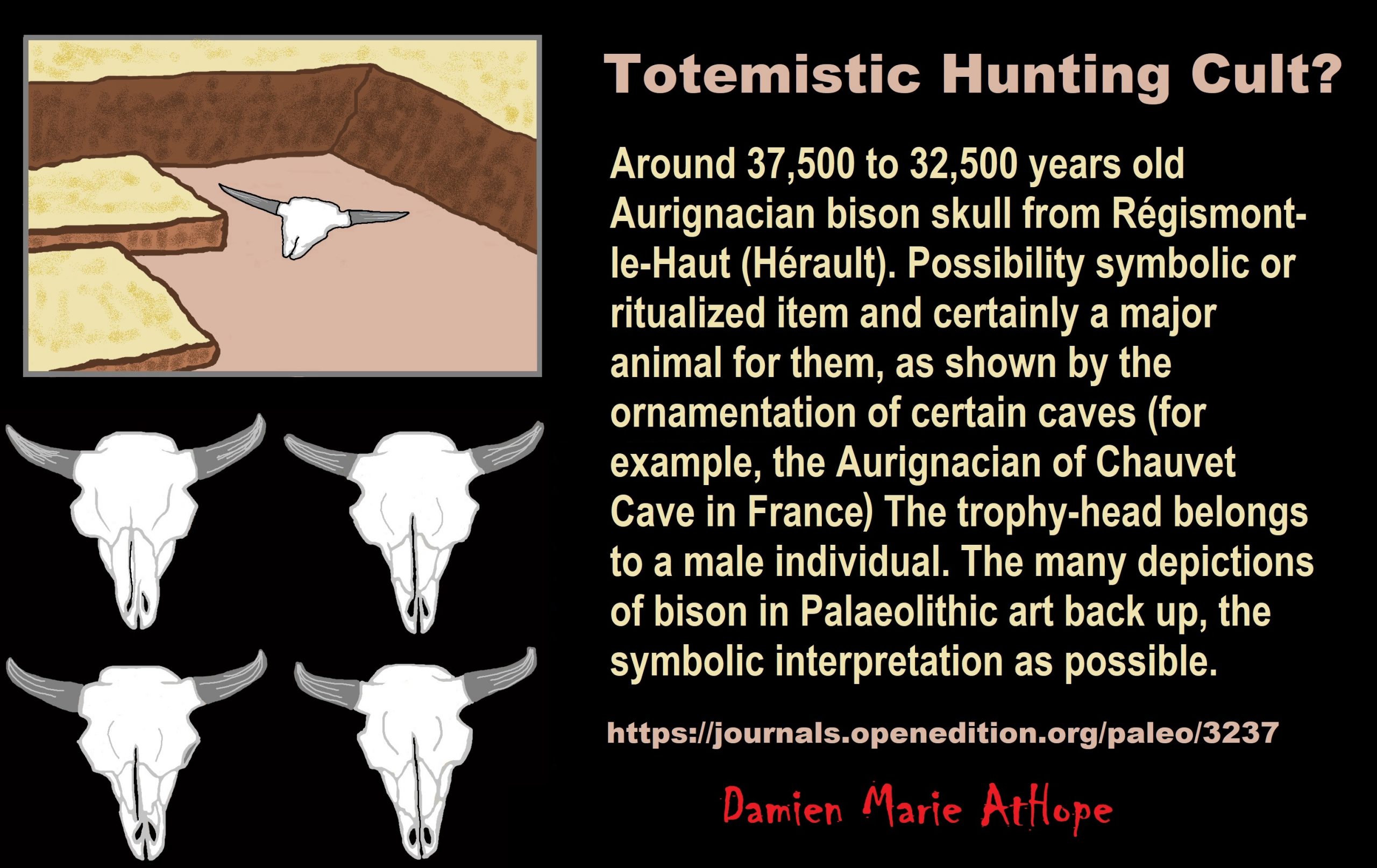
Around 37,500 to 32,500 years old Aurignacian bison skull from Régismont-le-Haut (Hérault). Possibility symbolic or ritualized item and certainly a major animal for them, as shown by the ornamentation of certain caves (for example, the Aurignacian of Chauvet Cave in France. The trophy-head belongs to a male individual. The many depictions of bison in Palaeolithic art back up, the symbolic interpretation as possible. ref
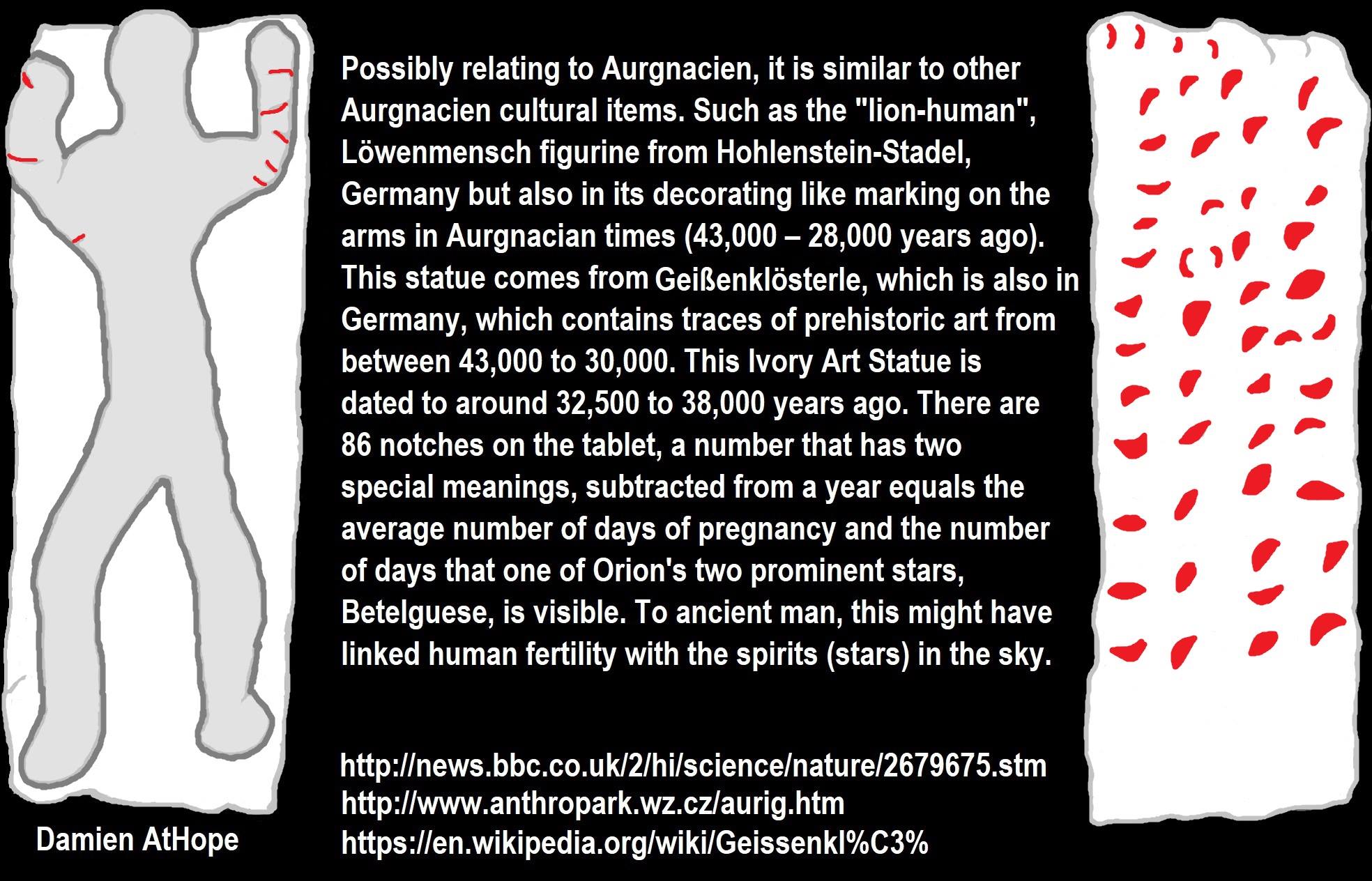
“The Adorant from the Geißenklösterle cave is a 35,000-to-40,000-year-old section of mammoth ivory with a depiction of a human figure, found in the Geißenklösterle cave in the Swabian Jura near Blaubeuren, Germany. The front face has a human figure of uncertain sex in relief, with raised arms and outstretched legs, but no hands. The posture is usually interpreted as an expression of worship, which is why in German the figure is called an “adorant”, a word meaning “worshipper”. It has been claimed that a belt and sword can be seen, although these are probably natural features of the ivory. On the plate’s reverse are rows of small notches. The piece is 38 mm (1.50 in) tall, 14 mm (0.55 in) wide, and 4.5 mm (0.18 in) thick. Traces of manganese and ochre can be found on it by microscope analysis. It is somewhat like the Lion-Human of Hohlenstein-Stadel ivory statue also found in Germany.” ref
“The Löwenmensch figurine, also called the Lion-Human of Hohlenstein-Stadel, is a prehistoric ivory sculpture discovered in Hohlenstein-Stadel, a German cave. The German name, Löwenmensch, meaning “lion-person” or “lion-human”, is used most frequently because it was discovered and is exhibited in Germany. Determined by carbon dating of the layer in which it was found to be between 35,000 and 40,000 years old, it is one of the oldest-known examples of an artistic representation and the oldest confirmed statue ever discovered. Its age associates it with the archaeological Aurignacian culture of the Upper Paleolithic. An example of zoomorphic art, the Lion-Human was carved out of mammoth ivory, using a flint stone knife. Seven parallel, transverse, carved gouges are on the left arm.” ref
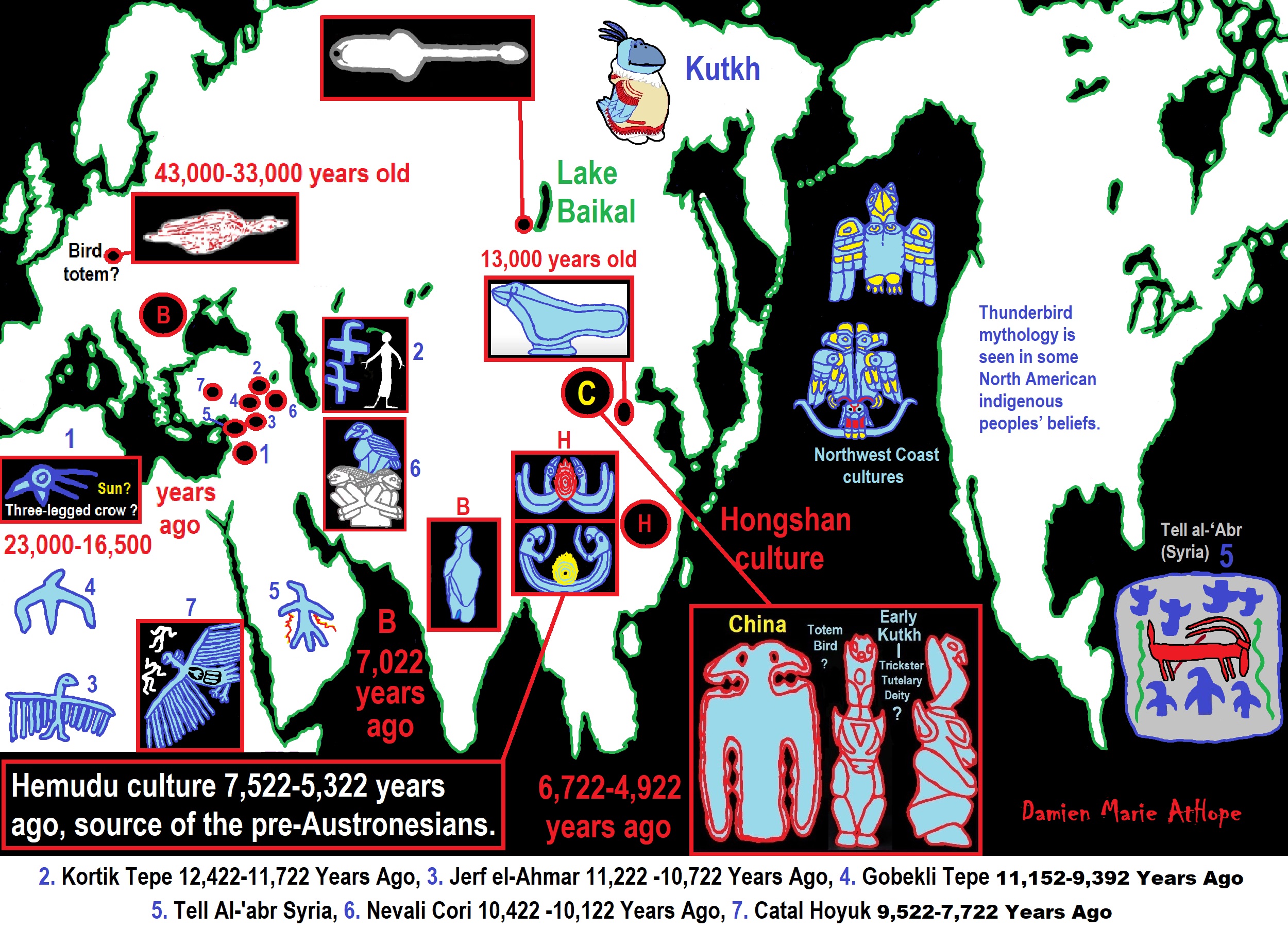
ref, ref, ref, ref, ref, ref, ref, ref, ref, ref, ref, ref, ref, ref
1. Kebaran culture 23,022-16,522 Years Ago, 2. Kortik Tepe 12,422-11,722 Years Ago, 3. Jerf el-Ahmar 11,222 -10,722 Years Ago, 4. Gobekli Tepe 11,152-9,392 Years Ago, 5. Tell Al-‘abrUbaid and Uruk Periods, 6. Nevali Cori 10,422 -10,122 Years Ago, 7. Catal Hoyuk 9,522-7,722 Years Ago
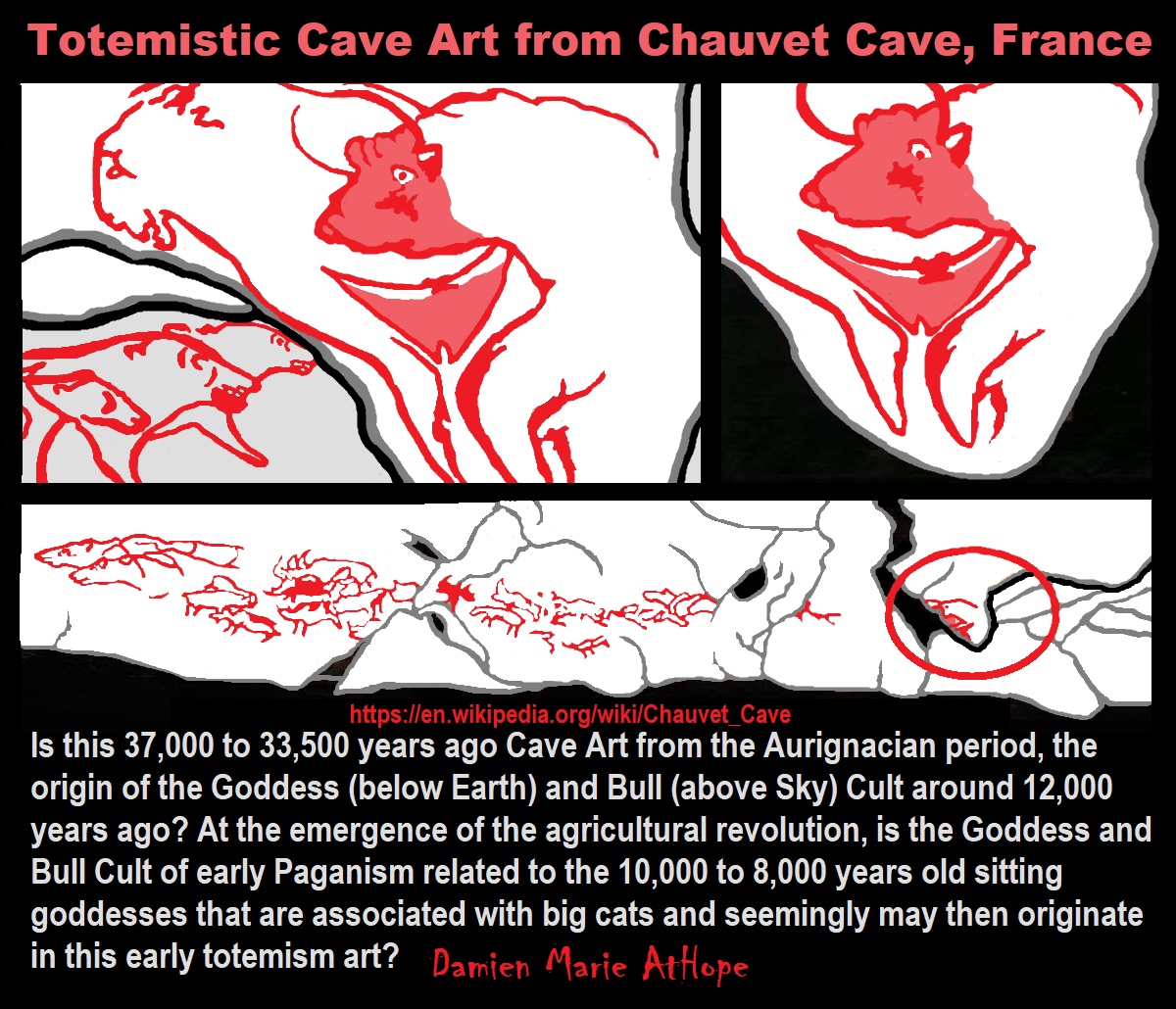
Chauvet cave
“The Chauvet-Pont-d’Arc Cave in the Ardèche department of southeastern France is a cave that contains some of the best-preserved figurative cave paintings in the world, as well as other evidence of Upper Paleolithic life. It is located near the commune of Vallon-Pont-d’Arc on a limestone cliff above the former bed of the river Ardèche, in the Gorges de l’Ardèche. The dates have been a matter of dispute but a study published in 2012 supports placing the art in the Aurignacian period, approximately 32,000–30,000 years ago. A study published in 2016 using additional 88 radiocarbon dates showed two periods of habitation, one from 37,000 to 33,500 years ago and the second from 31,000 to 28,000 years ago, with most of the black drawings dating to the earlier period.” ref
“Hundreds of animal paintings have been cataloged, depicting at least 13 different species, including some rarely or never found in other ice age paintings. Rather than depicting only the familiar herbivores that predominate in Paleolithic cave art, i.e. horses, aurochs, mammoths, etc., the walls of the Chauvet Cave feature many predatory animals, e.g., cave lions, leopards, bears, and cave hyenas. There are also paintings of rhinoceroses. Typical of most cave art, there are no paintings of complete human figures, although there is one partial “Venus” figure composed of what appears to be a vulva attached to an incomplete pair of legs. Above the Venus, and in contact with it, is a bison head, which has led some to describe the composite drawing as a Minotaur. There are a few panels of red ochre hand prints and hand stencils made by blowing pigment over hands pressed against the cave surface. Abstract markings—lines and dots—are found throughout the cave. There are also two unidentifiable images that have a vaguely butterfly or avian shape to them. This combination of subjects has led some students of prehistoric art and cultures to believe that there was a ritual, shamanic, or magical aspect to these paintings.” ref
“One drawing, later overlaid with a sketch of a deer, is reminiscent of a volcano spewing lava, similar to the regional volcanoes that were active at the time. If confirmed, this would represent the earliest known drawing of a volcanic eruption. The artists who produced these paintings used techniques rarely found in other cave art. Many of the paintings appear to have been made only after the walls were scraped clear of debris and concretions, leaving a smoother and noticeably lighter area upon which the artists worked. Similarly, a three-dimensional quality and the suggestion of movement are achieved by incising or etching around the outlines of certain figures. The art is also exceptional for its time for including “scenes”, e.g., animals interacting with each other; a pair of woolly rhinoceroses, for example, are seen butting horns in an apparent contest for territory or mating rights.” ref
Aurignacian burials (around 37,000-30,000 years ago) belong to the early phase of this period in Europe. Examples have been excavated at Cave of Cavillon, Liguria – a burial wearing a cap of netted whelk shells with a border of deer’s teeth, red ochre around the face, and a bone awl at the side. ref
Aurignacian in the Zagros region dates back to about 35,500 years ago at Yafteh Cave, Lorestan, Iran. ref
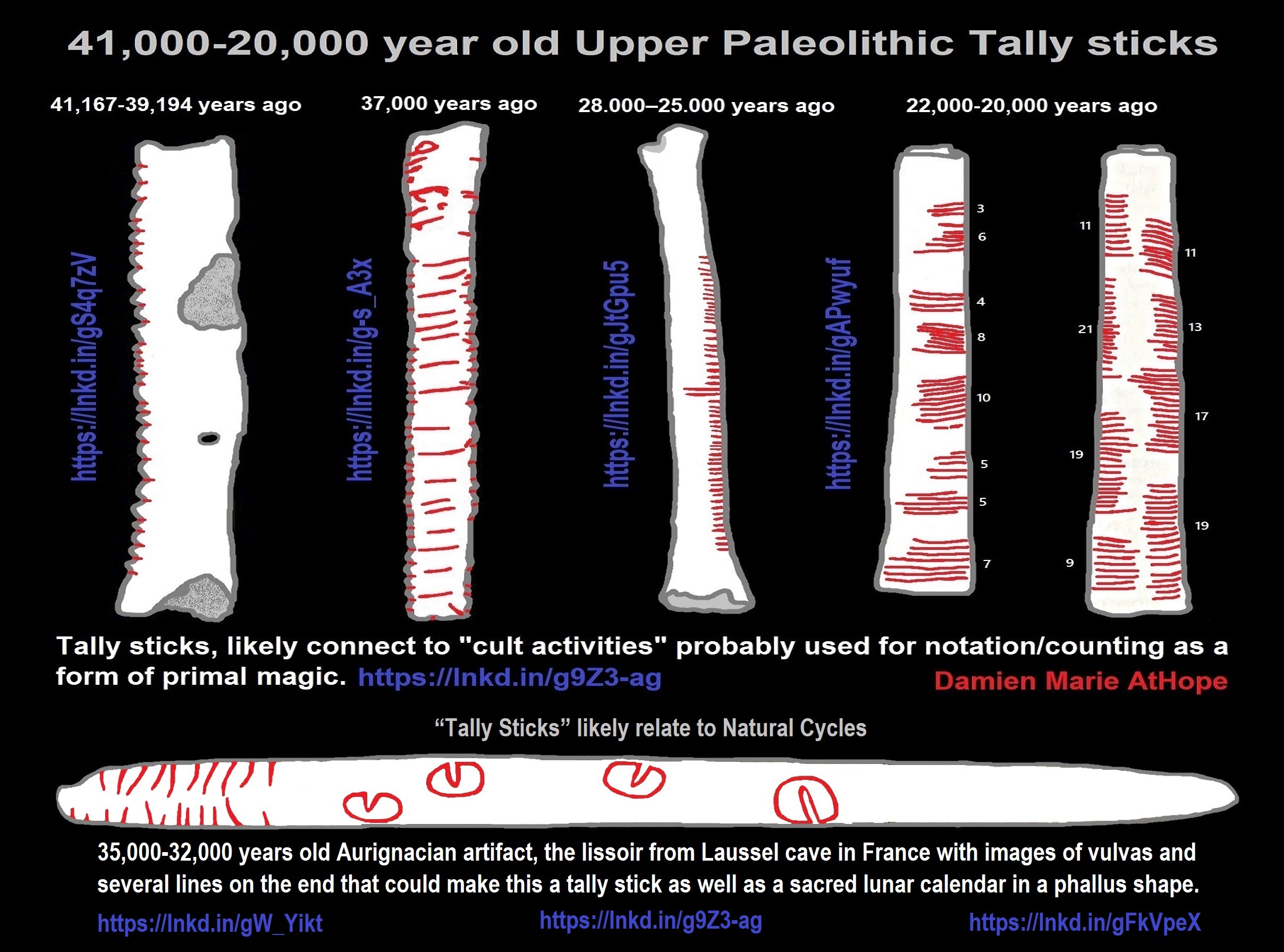
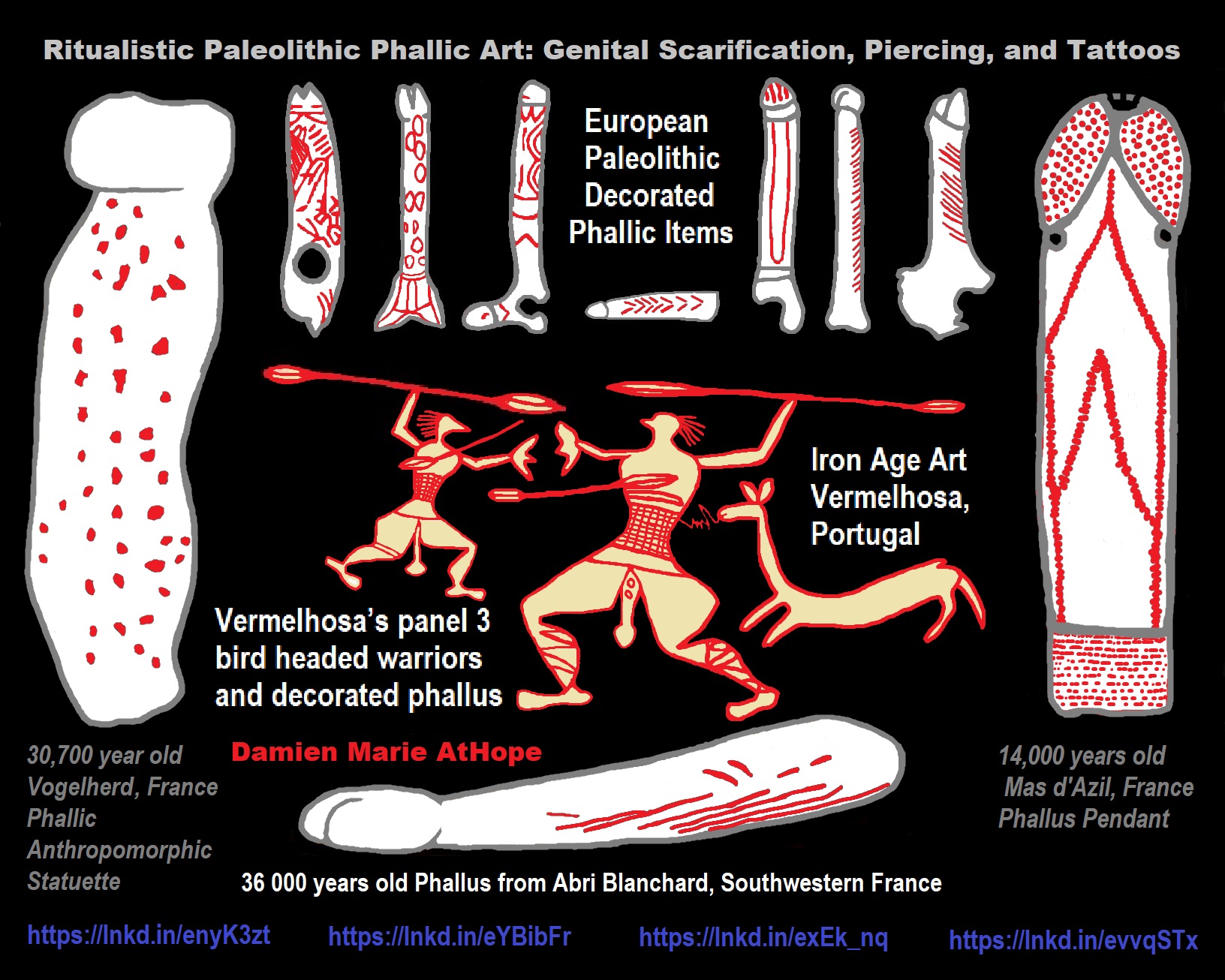
Could they be like magic wands?
“A wand is a thin, light-weight rod that is held with one hand, and is traditionally made of wood, but may also be made of other materials, such as metal, plastic or stone. Long versions of wands are often styled in forms of staves or sceptres, which could have large ornamentation on the top. In modern times, wands are usually associated with stage magic or supernatural magic, but there have been other uses, all stemming from the original meaning as a synonym of rod and virge. A stick that is used for reaching, pointing, drawing in the dirt, and directing other people, is one of the earliest and simplest of tools.” ref
“It is possible that wands were used by pre-historic peoples. It is mentioned that ‘rods’ (as well as rings) were found with Red Lady of Paviland in Britain. It is mentioned by the author in Gower – A Guide to Ancient and Historic Monuments on the Gower Peninsula that these might have been wands and are depicted as such in a reconstruction drawing of the burial of the ‘Red Lady’. In British formal government ceremony, special officials may carry a wand of office that represents their power. Compare in this context the function of the ceremonial mace, the scepter, and the staff of office. Its age may be even greater, as Stone Age cave paintings show figures holding sticks, which may be symbolic representations of their power.” ref
“During the Middle Kingdom of Egypt, apotropaic wands began to be used during birth ceremonies. These wands were made out of hippopotamus tusks which were split down the middle lengthwise, producing two wands, each with one flat side and one curved side. Due to the curved nature of a hippopotamus tusk, these wands were curved, with one pointed end (the point of the tusk) and one blunt end (where the tusk was removed from the hippopotamus). Hippopotamus tusks may have been used to invoke Taweret the hippopotamus goddess of childbirth.” ref
“The earliest apotropaic wands used in Egypt were undecorated, but “from around 1850 BCE, they were usually provided with decorations of apotropaic figures directly related to the sun religion, or particular aspects of it, inscribed on the convex upper side… most of whom carry knives to ward off evil forces”. These apotropaic wands were also inscribed with protective text on the flat side, such as “Cut off the head of the enemy when he enters the chamber of the children whom the lady… has borne”. The latest apotropaic wand found belongs to the Second Intermediate Period king Senebkay. It seems that the use of these objects in Egypt declines after this point.” ref
“The Barsom used by Zoroastrian Magi is a bundle of twigs that was used during religious ceremonies. While the Barsom is not a wand itself, it was also used for divination purposes, and may be a form of prototypical wand from which later magical wands descend. The concept of magic wands was used by the ancient Greek writer Homer, in his epic poems The Iliad and The Odyssey. In all cases, Homer used the word rhabdos (ῥᾰ́βδος), which means ‘rod’, and implies something that is thicker than the modern conception of wands. In those books, Homer wrote that magic wands were used by three different gods, namely Hermes, Athena, and Circe. In The Iliad, Homer wrote that Hermes generally used his magic wand Caduceus to make people sleep and wake up. In The Odyssey, Homer wrote that Athena used her magic wand to make Odysseus old, and then young again, and that Circe used her magic wand to turn Odysseus’s men into pigs.” ref
“By the 1st century CE, the wand was a common symbol of magic in Roman cults, especially Mithraism. In the 3rd and 4th centuries, there are frequent depictions on sarcophagi of Jesus Christ using a magic wand to perform miracles, such as the raising of Lazarus and feeding the multitude. Italian fairy tales put wands into the hands of the powerful fairies by the Late Middle Ages. Based on their magical symbolism, stage magicians often use “magic wands” as part of their misdirection. These wands are traditionally short and black, with white tips. A magic wand may be transformed into other items, grow, vanish, move, display a will of its own, or behave magically in its own right.” ref
Phallus Art
“A phallus (pl.: phalli or phalluses) is a penis (especially when erect), an object that resembles a penis, or a mimetic image of an erect penis. In art history, a figure with an erect penis is described as ithyphallic. Any object that symbolically—or, more precisely, iconically—resembles a penis may also be referred to as a phallus; however, such objects are more often referred to as being phallic (as in “phallic symbol“). Such symbols often represent fertility and cultural implications that are associated with the male sexual organ, as well as the male orgasm.” ref
“The term is a loanword from Latin phallus, itself borrowed from Greek φαλλός (phallos), which is ultimately a derivation from the Proto-Indo-European root *bʰel– “to inflate, swell”. Compare with Old Norse (and modern Icelandic) boli, “bull“, Old English bulluc, “bullock“, Greek φαλλή, “whale“. The Hohle phallus, a 28,000-year-old siltstone phallus discovered in the Hohle Fels cave is among the oldest phallic representations known. The phallus played a role in the cult of Osiris in ancient Egyptian religion. When Osiris’ body was cut in 14 pieces, Set scattered them all over Egypt, and his wife Isis retrieved all of them except one, his penis, which a fish swallowed; Isis made him a wooden replacement. The phallus was a symbol of fertility, and the god Min was often depicted as ithyphallic, that is, with an erect penis.” ref
“In traditional Greek mythology, Hermes, the god of boundaries and exchange (popularly the messenger god), is considered to be a phallic deity by association with representations of him on herms (pillars) featuring a phallus. There is no scholarly consensus on this depiction, and it would be speculation to consider Hermes a fertility god. Pan, son of Hermes, was often depicted as having an exaggerated erect phallus. Priapus is a Greek god of fertility whose symbol was an exaggerated phallus. The son of Aphrodite and Dionysus, according to Homer and most accounts, he is the protector of livestock, fruit plants, gardens, and male genitalia. His name is the origin of the medical term priapism. The city of Tyrnavos in Greece holds an annual Phallus festival, a traditional event celebrating the phallus on the first days of Lent.” ref
The phallus was ubiquitous in ancient Roman culture, particularly in the form of the fascinum, a phallic charm. The ruins of Pompeii produced bronze wind chimes (tintinnabula) that featured the phallus, often in multiples, to ward off the evil eye and other malevolent influences. Statues of Priapus similarly guarded gardens. Roman boys wore the bulla, an amulet that contained a phallic charm until they formally came of age. According to Augustine of Hippo, the cult of Father Liber, who presided over the citizen’s entry into political and sexual manhood, involved a phallus. The phallic deity Mutunus Tutunus promoted marital sex. A sacred phallus was among the objects considered vital to the security of the Roman state, which was in the keeping of the Vestal Virgins. Sexuality in ancient Rome has sometimes been characterized as “phallocentric.” ref
“Shiva, one of the most widely worshiped male deities in Hinduism pantheon, is worshiped much more commonly in the form of the lingam. Evidence of the lingam in India dates back to prehistoric times. Although Lingam is not a mere phallic iconography, nor do the textual sources signify it as so, stone Lingams with several varieties are found to this date in many of the old temples and in museums in India and abroad, which are often more clearly phallic than later stylized lingams. The famous “man-size” Gudimallam Lingam in Andhra Pradesh is about 1.5 metres (5 ft) in height, carved in polished black granite, and clearly represents an erect phallus, with a figure of the deity in relief superimposed down the shaft. Many of the earliest depictions of Shiva as a figure in human form are ithyphallic, for example, in coins of the Kushan Empire. Some figures up to about the 11th century CE have erect phalluses, although they have become increasingly rare.” ref
“In Ancient Scandinavia, The Norse god Freyr is a phallic deity, representing male fertility and love. The short story Völsa þáttr describes a family of Norwegians worshiping a preserved horse penis. Some image stones, such as the Stora Hammers and Tängelgårda stones, were phallic shaped. Kuker is a divinity personifying fecundity, sometimes in Bulgaria and Serbia it is a plural divinity. In Bulgaria, a ritual spectacle of spring (a sort of carnival performed by Kukeri) takes place after a scenario of folk theatre, in which Kuker’s role is interpreted by a man attired in a sheep or goat-pelt, wearing a horned mask and girded with a large wooden phallus. During the ritual, various physiological acts are interpreted, including the sexual act, as a symbol of the god’s sacred marriage, while the symbolical wife, appearing pregnant, mimes the pains of giving birth. This ritual inaugurates the labours of the fields (ploughing, sowing) and is carried out with the participation of numerous allegorical personages, among which are the Emperor and his entourage.” ref
“In the Americas, figures of Kokopelli and Itzamna (as the Mayan tonsured maize god) in Pre-Columbian America often include phallic content. Additionally, over forty large monolithic sculptures (Xkeptunich) have been documented from Terminal Classic Maya sites, with most examples occurring in the Puuc region of Yucatán (Amrhein 2001). Uxmal has the largest collection, with eleven sculptures now housed under a protective roof. The largest sculpture was recorded at Almuchil measuring more than 320 cm high with a diameter at the base of the shaft measuring 44 cm. The Mara Kannon Shrine (麻羅観音) in Nagato, Yamaguchi prefecture is one of many fertility shrines in Japan that still exist today. Also present in festivals such as the Danjiri Matsuri (だんじり祭) in Kishiwada, Osaka prefecture, the Kanamara Matsuri in Kawasaki, and the Hōnen Matsuri (豊年祭, Harvest Festival) in Komaki, Aichi Prefecture, though historically phallus adoration was more widespread.” ref
Fascinus: “the Divine Phallus“
“In ancient Roman religion and magic, the fascinus or fascinum was the embodiment of the divine phallus. The word can refer to phallus effigies and amulets, and to the spells used to invoke his divine protection. Pliny calls it a medicus invidiae, a “doctor” or remedy for envy (invidia, a “looking upon”), or the evil eye.” ref
Fascinus: as a Magic Symbol
“Phallic charms, often winged, were ubiquitous in Roman culture, appearing as objects of jewellery such as pendants and finger rings, relief carvings, lamps, and wind chimes (tintinnabula). Fascinus was thought particularly to ward off evil from children, mainly boys, and from conquering generals. The protective function of the phallus is usually related to the virile and regenerative powers of an erect phallus, though in most cases the emotion, shame, or laughter created by obscenity is the power that diverts the evil eye.” ref
“There are very few Roman images of people wearing a phallic charm. Varro notes the custom of hanging a phallic charm on a baby’s neck, and examples have been found of phallus-bearing rings too small to be worn except by children. A 2017 experimental archaeology project suggested that some types of phallic pendant were designed to remain pointing outwards, in the direction of travel of the wearer, in order to face towards any potential danger or bad luck and nullify it before it could affect the wearer. Other symbols may have been interchangeable with the phallus, such as the club of Hercules.” ref
“The victory of the phallus over the power of the evil eye may be represented by the phallus ejaculating towards a disembodied eye. This motif is shown in several examples of Roman art. For example, the motif is known from multiple relief sculptures from Leptis Magna in present-day Libya, as well as several instances on Hadrian’s Wall. A 1st-century BCE terracotta figurine shows “two little phallus-men sawing an eyeball in half. As a divinized phallus, Fascinus shared attributes with Mutunus Tutunus, whose shrine was supposed to date from the founding of the city, and the imported Greek god Priapus.” ref
“The “fist and phallus” amulet was prevalent amongst soldiers. These are phallic pendants with a representation of a (usually) clenched fist at the bottom of the shaft, facing away from the glans. Several examples show the fist making the manus fica or “fig sign“, a symbol of good luck. The largest known collection comes from Camulodunum. Some examples of the fist-and-phallus amulets incorporate vulvate imagery as well as an extra apotropaic device.” ref
“The Vestal Virgins tended the cult of the fascinus populi Romani, the sacred image of the phallus that was one of the tokens of the safety of the state (sacra Romana). It was thus associated with the Palladium. Roman myths, such as the begetting of Servius Tullius, suggest that this phallus was an embodiment of a masculine generative power located within the hearth, regarded as sacred. When a general celebrated a triumph, the Vestals hung an effigy of the fascinus on the underside of his chariot to protect him from invidia.” ref
“Augustine, whose primary source on Roman religion was the lost theological works of Marcus Terentius Varro, notes that a phallic image was carried in procession annually at the festival of Father Liber, the Roman god identified with Dionysus or Bacchus, for the purpose of protecting the fields from fascinatio, magic compulsion:
Varro says that certain rites of Liber were celebrated in Italy which were of such unrestrained wickedness that the shameful parts of the male were worshipped at crossroads in his honour. … For, during the days of the festival of Liber, this obscene member, placed on a little trolley, was first exhibited with great honour at the crossroads in the countryside, and then conveyed into the city itself. … In this way, it seems, the god Liber was to be propitiated, in order to secure the growth of seeds and to repel enchantment (fascinatio) from the fields.” ref
Homo symbolic us: The dawn of language, imagination, and spirituality
Abstract and Figures
“The emergence of symbolic culture, classically identified with the European cave paintings of the Ice Age, is now seen, in the light of recent groundbreaking discoveries, as a complex nonlinear process taking root in a remote past and in different regions of the planet. In this book the archaeologists responsible for some of these new discoveries, flanked by ethologists interested in primate cognition and cultural transmission, evolutionary psychologists modeling the emergence of metarepresentations, as well as biologists, philosophers, neuro-scientists, and an astronomer, combine their research findings. Their results call into question our very conception of human nature and animal behavior, and they create epistemological bridges between disciplines that build the foundations for a novel vision of our lineage’s cultural trajectory and the processes that have led to the emergence of human societies as we know them.” ref
“TÜBINGEN, GERMANY—Two fragments of a female figurine carved from mammoth ivory have been found in Hohle Fels Cave. The fragments resemble a breast and part of the stomach of the 40,000-year-old figurine known as the Venus from Hohle Fels, which was discovered in 2008. This carving may have been slightly larger, however, than the approximately two-inch-tall Venus. “The new discovery indicates that the female depictions are not as rare in the Aurignacian as previously thought, and that concerns about human sexuality, reproduction, and fertility, in general, have a very long and rich history dating to the Ice Age,” Nicholas Conard of the University of Tübingen said in a press release. To read about another masterpiece of Paleolithic art, go to “New Life for Lion Man.” ref
“34,000-year-old Venus discovered in ivory Figure is the oldest ivory sculpture outside of southern Germany. Projection of the Ivory Fragments from Breitenbach onto the thighs and chest of Venus from Hohle Fels and a Venus figure made of ivory from the Russian site of Kostenki.” ref
“Sensational find: archaeologists have discovered Paleolithic fragments of a Venus figure in Saxony-Anhalt. The carefully worked fragments of ivory are around 34,000 years old and resemble the famous Venus vom Hohe Fels. This makes them a real rarity. Because figural art from this period was previously only known from caves in the Swabian Alb. The new find now represents the oldest known ivory sculpture outside of southern Germany. The Paleolithic site in Breitenbach near Zeitz in Saxony-Anhalt is a real treasure trove for archaeologists: The site is one of the oldest ivory workshops in the world. Here our ancestors processed mammoth ivory around 34,000 years ago and made tiny pearls from it. But that’s not all: Artistic sculptures were obviously already part of the repertoire of the artists living there, as a one-off find now shows.” ref
Fragments of a Venus
“For ivory fragments from Breitenbach discovered in 2012 have now turned out to be fragments of a so-called Venus figure. The three small fragments, only between 1.4 and 1.8 centimeters in size, appear very inconspicuous at first glance, but have been carefully worked and polished. And: They can easily be assigned to completely preserved figures similar to the famous Venus vom Hohle Fels . This ivory sculpture is the oldest example of figurative art in the world and was found a few years ago in the Swabian Alb.” ref
Oldest find outside of southern Germany
“The realization of Olaf Jöris from the research center for human behavioral evolution “Monrepos” in Neuwied and his colleagues is a small sensation: Until now, sculptural statuettes from the so-called Aurignacian culture were only known from caves in southern Germany. Only later can figurative sculptures be found throughout the Eurasian region, as the team reports.” ref
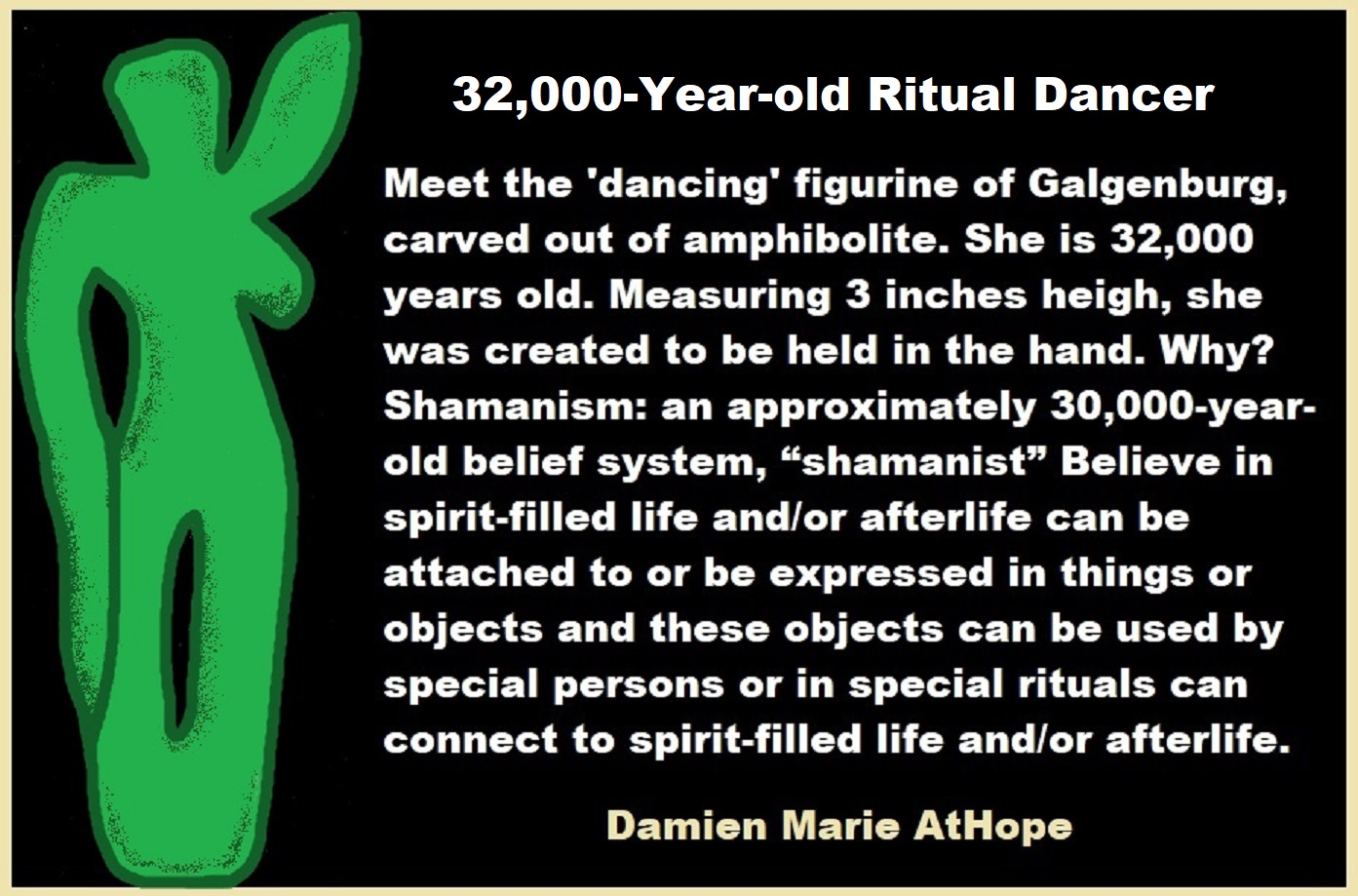

Modern humans in Northeast Asia
“A multidisciplinary study of the Shiyu archaeological site in northern China reveals a complex human behavioral record that currently is the oldest of its kind in Northeast Asia and provides insight into the nature of the northward dispersal of modern humans across Asia.” ref
“As the modern human origins debate continues to evolve, eastern Asia (including both East and Southeast Asia) is playing an increasingly important role. It is now evident that there were multiple dispersals out of Africa and across Eurasia beginning well before 60,000 years ago. Questions remain, however, regarding the dispersal routes (and timing thereof) that modern humans took out of Africa. Currently, it appears that initial late Middle Pleistocene (<300,000 years ago) human movements out of Africa spread into the Levant and touched southeastern Europe before spreading more widely across southern Asia, eventually arriving in Southeast Asia, including southern China, sometime between 120,000 years ago and 60,000 years ago. The early spread across northern Asia has been less clear. Most data suggest that the northern Asian expansion of modern humans largely occurred after 60,000 years ago, with sites appearing in Siberia, Mongolia, northern China, Korea, and Japan soon after 50,000 years ago. This later northern expansion included a westward dispersal into Europe. Writing in Nature Ecology & Evolution, Yang et al. report on multidisciplinary research from the northern Chinese site of Shiyu that brings some clarity to the nature of the dispersal of modern humans across Northeast Asia.” ref
“The potential importance of Shiyu has been evident since its discovery in 1963, as it has yielded more than 15,000 stone tools, including blades, Levallois flakes, other artifacts (for example, a perforated black disc and a bone tool), and thousands of vertebrate remains. Older (early Late Pleistocene) sites appear in central and southern China, indicative of earlier dispersals into eastern Asia from the southern route. The northward dispersal route appears to be part of the larger movement out of Africa after 60,000 years ago that included movement westward into Europe. Who (modern humans, Neanderthals, Denisovans, or a different group altogether) left the miniaturized stone tools at the Fanjiagouwan site that dates between 100,000 years ago and 90,000 years ago is still unclear. Black star, Shiyu; yellow circle, early Late Pleistocene (~120,000 years ago to ~60,000 years ago) site; blue circle: middle Late Pleistocene (~60,000 years ago to ~ 30,000 years ago) site; green circle, Gladkaya obsidian source; orange circle, Changbai obsidian source. (1) Denisova; (2) Kara Bom; (3) Tolbor 16; (4) Tsagaan Agui; (5) Salkhit; (6) Ryonggok; (7) Xiaogushan; (8) Zhoukoudian Upper Cave; (9) Tianyuandong; (10) Xiamabei; (11) Fanjiagouwan; (12) Shuidonggou; (13) Huanglongdong; (14) Fuyandong; (15) Lunadong; (16) Zhirendong; (17) Idemaruyama.” ref

“The people of the Upper Paleolithic who created these Venus figurines were nomadic hunter-gatherers. The Upper Paleolithic, from roughly 50,000-10,000 years ago, predates the advent of agriculture, and marks a transition to modern human cognitive behavior and the advent of many new technologies. Examples of these changes include, but are not limited to, increasingly sophisticated blades and hunting tools, routine use of body decoration, and the appearance of artwork in the form of carved figurines or paintings and engravings on cave walls. Behavioral changes coincide with changes in the climate; the Last Glacial Maximum was followed by a period of oscillation between warm and wet, then cold and dry. The creation of these Venuses can be seen as a response to the world in which they lived.” ref
Siberian Odyssey
“Map of Northern Asia with locations of Paleolithic sites: 1, Anui, Ust’ Karakol, Denisova Cave; 2, Kara Bom; 3, Ust’ Kanskaia Cave; 4, Maloialomanskaia Cave; 5, Shestakovo; 6, Chernoozer’e; 7, Malaia Syia; 8, Achinsk; 9, Afontova Gora; 10, Ust’ Maltat, Derbina, Listvenka; 11, Kurtak, Kashtanka; 12, Novoselovo, Kokorevo; 13, Sabanikha, Tashtyk; 14, Ui, Maina; 15, Golubaia, Nizhnii Idzhir’; 16, Ust’ Kova; 17, Igeteiskii Log; 18, Mal’ta, Buret’, Sosnovyi Bor; 19, Arembovskii, Voennyi Gospital; 20, Makarovo; 21, Nepa; 22, Alekseevsk; 23, Studenoe, Ust’ Menza, Priiskovoe, Chitkan, Kosaia Shivera; 24, Kunalei, Podzvonka; 25, Varvarina Gora, Kamenka; 26, Tolbaga, Masterov Kliuch, Masterov Gora; 27, Khotyk, Sannyi Mys, Sapun; 28, Sokhatina; 29, Diuktai Cave; 30, Ust’ Mil’, Verkhne Troitskaia; 31, Ikhine; 32, Yana; 33, Berelekh; 34, Ushki Lake; 35, Ogon’ki; 36, Kashiwadai.” ref
“Human dispersal to the Americas was a complex process. Both place of origin and the timing of this event are hotly debated. Based on genetics, geography, language, and cultural similarities, most researchers consider Siberia the homeland of the First Americans with migration via the Bering Land Bridge. Others, however, argue earliest colonizers originated in Western Europe, arriving via a trans-oceanic voyage. Some hold that this early colonization event took place before the Last Glacial Maximum (LGM), while others contend it happened much more recently during the Late Glacial. In this chapter, I review Siberian Upper Paleolithic archaeology. The Siberian record indicates two pulses of modern humans into far northeast Asia during the late Pleistocene, one before and one after the LGM. The colonization of Siberia by modern humans was an episodic process, taking over 10,000 years, setting the stage for the initial peopling of the Americas.” ref
“Archaeologists have long looked to Siberia as the homeland of the First Americans. Despite resistance from some archaeologists, mounting evidence mostly from molecular geneticists investigating dna from both ancient skeletons and living populations has very convincingly illustrated that all founding lineages and sub-lineages of First Americans originated in greater Northeast Asia and came to the Americas via a single migration. Clearly, if we are to understand where First Americans came from, then DNA studies are the definitive way to do this because try as we may, we cannot make silent stones and bones speak about their makers’ origins. Because Siberia is likely the Pleistocene homeland of Native Americans, I want to turn attention to the archaeological record of this vast region of Northeast Asia to look at the behaviors that conditioned the timing and process of dispersal to Beringia and the New World. The Siberian Upper Paleolithic record is traditionally divided into three phases: early, middle, and late Upper Paleolithic. These phases are based on typological and chronological distinctions. The record is characterized by peaks and nadirs of dated cultural layers (or occupations). When compared with global climate records, high points in occupation numbers tend to align with warm intervals, while lows in occupation numbers tend to correspond with cold intervals during the second half of the Late Pleistocene. A broad overview of the archaeological record of modern humans in Siberia during the Late Pleistocene and follow up with a discussion of how this record can inform on dispersals north and to the Americas.” ref
Early Upper Paleolithic Siberia
“Anatomically modern Homo sapiens were not the first people to inhabit southern Siberia, evidenced by archaeological and skeletal remains of Neanderthals and Denisovans at Denisova and Okladnikov Caves in southwestern Siberia. These occupations probably happened before 50,000 years ago, presumably during the last interglacial/early glacial or marine isotope stages (MIS) 5–4, so their ages cannot be established using radiocarbon (14C) dating. A series of radio-thermoluminescence or RTL dates obtained on-site sediments indicates the Middle Paleolithic layers date to late Middle Pleistocene times or before about 128,000 years ago. Despite not being the “first” to Siberia, early modern humans were certainly the first to disperse north and east into sub-arctic and eventually arctic Siberia, Beringia, and ultimately the New World. The earliest modern humans were certainly capable of inhabiting a wide array of habitats because as early as about 47,000–40,000 years ago their cultural remains were distributed from sites in South-west Asia, north, and east to sites such as Kostenki and Kara Bom found in cold, dry environments of Eastern Europe and southern Siberia, respectively. By about 38,000 years ago modern humans expanded as far north as the Arctic Circle (~66˚ N) as evidenced by a handful of lithic artifacts and faunal remains at Mamontovaya Kurya in the western foothills of the Ural Mountains of European Russia and eventually arctic Northeast Asia, where thousands of lithic and osseous cultural materials were found at Yana RHS (71˚ N) in northwestern Beringia. The initial pulse into northern environments is recognized, not by skeletal remains, but by the durable artifacts left behind. The geographical and temporal framework of the Early Upper Paleolithic (EUP) should be investigated and a further review of the archaeological record of sites in Siberia.” ref
EUP Distribution and Chronology
“Hundreds of Paleolithic sites dot the Siberian landscape; however, Early Upper Paleolithic sites have been found sparsely distributed across just the territory south of 55˚ N from the upper Ob’ River in the west to Transbaikal in the east. Localities with Early Upper Paleolithic occupations are not numerous, and many of these have contextual problems. Though at least 25 Early Upper Paleolithic sites are reported, only 8 of these were found in secure contexts with meaningful data to review, and therefore provide the corpus of data on the Early Upper Paleolithic archaeological record. In this chapter, 14C dates were calibrated using the IntCal09 curve in Calib 6.0 14C calibration program. In the northern foothills of the Altai Mountains near the headwaters of the Ob’ River in southwestern Siberia, Early Upper Paleolithic artifacts were discovered at seven sites. Four sites, Anui-1, Anui-3, Ust’ Karakol, and Kara Bom, were found in open-air contexts on terrace-like surfaces mantled by colluvium and overlooking the Anui and Ursul rivers. The other three sites, Denisova, Ust’Kanskaia, and Maloialomanskaia caves, overlook the Anui, Charysh, and Katun’ river drainages, respectively. Of these, Ust’ Karakol and Kara Bom represent the initial pulse of modern humans into this region with their clean Early Upper Paleolithic assemblages and relatively reliable 14C dates. Kara Bom contains at least four discrete Early Upper Paleolithic cultural layers (2a–2d) within a single geological stratum (4) or from two geological strata (6–5). Wood charcoal from these layers has produced eight 14C dates, placing Early Upper Paleolithic occupations between about 43,300 ± 1600 (GX-17596) and 30,990 ± 460 (GX-17594) 14C years before present or about 49,740–34,770 calendar (cal) years before present, with the lower two occupation horizons dated to 49,700–44,300 cal years before present and the subsequent horizons 40,800–34,600 cal years before present. Ust’ Karakol contains a single Early Upper Paleolithic cultural component found in four geological strata (11–8). Seven wood charcoal samples from three hearth features give an age range of 35,100 ± 2850 (SOAN-3259) to 29,720 ± 360 (SOAN-3359)14C (44,600–33,400 cal) years before present for the component. The other sites come from dubious contexts where either their small, yet diagnostic, assemblages have no associated chronometric dates (e.g., Anui-1) or from Early Upper Paleolithic artifacts found with Middle Paleolithic artifacts in stratigraphically mixed contexts in colluvial or cave deposits (e.g., Anui-3, Denisova, Ust’ Kanskaia, and Maloialomanskaia Caves). Several Early Upper Paleolithic sites were discovered in the northern foot-hills of the Saian Mountains and Lena-Angara Plateau in the upper reaches of the Enisei, Angara, and Lena rivers in south-central Siberia. All archaeological sites found from the Enisei River east to Lake Baikal are discussed together below. In this region, sites were discovered in open-air settings on terraces mantled by a combination of colluvial and eolian deposits. The best evidence of the Early Upper Paleolithic was found at Malaia Syia and Makarovo-4. There are several more that could represent Early Upper Paleolithic occupations such as Ust’ Maltat-2, Sosnovyi Bor, Arembovskii, and Voennyi Gospital; however, these sites come either from geological contexts that lack datable materials or from artifacts found in surface contexts that cannot be reliably associated with dates from nearby profiles. Malaia Syia is an open-air site that contains a 3-m-thick profile of loess with 5 stratigraphic layers and a single cultural layer containing an Early Upper Paleolithic artifact assemblage found in the paleosol of stratum 4 (about 2.5 m below the surface). Four dates are reported from this paleosol, three on bone samples from the faunal assemblage and one on a “grab-sample” of charcoal from the paleosol. Two bone dates of 34,500 ± 450 (SOAN-1286) and 34,420 ± 360 (SOAN-1287) 14C years before present place the age of the Early Upper Paleolithic component within the range of 40,800–38,600 cal years before present. The other two dates are aberrantly too young. Makarovo-4 is another open-air site that consists of a 4-m-thick profile of colluvial and aeolian deposits with four stratigraphic layers and a single Early Upper Paleolithic cultural layer. Sand-blasted artifacts were found about 2 m below the surface lying atop a sandy scree, wind-deflated lag deposit, underlying stratum 2, and capping stratum 3. The cultural layer with overlying and underlying sediment was penetrated by a network of ice-wedge pseudomorphs beginning in stratum 2 and extending down through stratum 3. Despite these post-depositional site-formation problems, the Early Upper Paleolithic assemblage appears intact as a component, and three infinite AMS dates all > 39,000 (AA-8880, AA-8878, AA-8879)14C years before present on three bone samples found in situ during excavations indicate an age > 45,000 cal years before present. Similar to the Altai region, most proposed Early Upper Paleolithic site occupations in south-central Siberia come from problematic contexts. At the Ust’ Maltat-2 site, which is being actively eroded by the Krasnoiarsk Reservoir, EUP artifacts were found eroding from a redeposited stratigraphic setting and not directly dated. Arembovskii, and Sosnovyi Bor produced characteristic Early Upper Paleolithic assemblages but remain undated. Voennyi Gospital was first excavated in 1871, and the original Early Upper Paleolithic assemblage was subsequently lost to a fire in 1879. Renewed excavations in the 1980s produced a small, unexpressive assemblage with a 14C date on horse bone of 29,700 ± 500 (GIN-4440) 14C (35,200–33,100 cal) years before present, which may or may not date the original Early Upper Paleolithic occupation. In the Transbaikal in southeastern Siberia, several Early Upper Paleolithic sites have been reported in open-air settings on alluvial terrace landforms mantled by a combination of colluvial and eolian deposits. Three of these sites contain Early Upper Paleolithic cultural occupations that were found in reasonably reliable stratigraphic situations, including Varvarina Gora, Masterov Kliuch’, and Kamenka. Varvarina Gora is an open-air site that contains a 2.5-m-thick profile of colluvial and eolian deposits with four strata and a single cultural layer containing an Early Upper Paleolithic artifact assemblage found in stratum 3 (about 1.5m below the surface). Three conventional 14C dates on bones from the faunal assemblage suggest an age range of 34,900 ± 780 (SOAN-1524) to 29,895 ± 1790 (SOAN-3054) 14C (41,600–31,100cal) years before present, but two AMS bone dates were infinite (> 34,050 [AA-8875] and > 35,300 [AA-8893] 14C or > 38,500 cal years before present). The infinite AMS dates, plus the probability that the conventional bone dates are too young, suggests an age of > 38,500 cal years before present for the cultural layer. Masterov Kliuch’ is situated in 160-cm-thick colluvial deposits with six stratigraphic units and two Early Upper Paleolithic cultural layers. Detailed geoarchaeological work found the lower Early Upper Paleolithic layer in a primary depositional context, but the upper component was not. Two AMS bone dates from the faunal assemblage associated with the lower component produced dates of 32,510 ± 1440 (AA-23640) 14C and 29,860 ± 1000 (AA-23641) 14C years before present, indicating an age range of 40,700–32,000 cal years before present (Goebel et al. 2000a). Kamenka was found in a 12-m-thick set of colluvial deposits in which an Early Upper Paleolithic cultural component, complex A/C, was found underlying a middle Upper Paleolithic (MUP) complex B. Six conventional 14C dates on bones were reported for complex A/C (Lbova 2005). Four indicate an age range of 35,845 ± 695 (SOAN-2904) to 30,220 ± 270 (SOAN-3354) 14C years before present or about 42,000–34,500 cal years before present. The other two dates seem aberrant with one far older than the rest (40,500 ± 3800 [AA-26743] 14C years before present and the other (26,760 ± 265 [SOAN-3353] 14C years before present) far too young, especially since it is statistically the same age as the dates from overlying complex B. Several other sites in the Transbaikal hint at Early Upper Paleolithic occupation, but they were found in problematic contexts. Sannyi Mys, Masterov Gora, Sapun, and Sokhatino have Early Upper Paleolithic assemblages that remain undated, while both Podzvanka and Khotyk each have Middle and Upper Paleolithic artifacts found in the same colluvial stratum, suggesting mixed stratigraphic contexts. Another problem is Tolbaga. This site contains a massive Early Upper Paleolithic component also found in colluvial sediments. All artifacts and bones were oriented downslope so it is fairly clear that the archaeological materials are secondarily deposited. The five 14C bone dates (three conventional and two AMS) span 34,860 ± 2100 (SOAN-1522) to 25,200 (AA-8874) 14C (43,000–29,500 cal) years before present. The very long time range reflected by the dates may mean the component consists of a mixture of Early Upper Paleolithic and later MUP artifacts.” ref
Modern Human Colonization of the Siberian Mammoth Steppe: A View from South-Central Siberia
“Was the transition from the middle Upper Paleolithic (MUP) to late Upper Paleolithic (LUP) in Siberia the result of gradual, in situ cultural change or abrupt change that resulted from multiple recolonization attempts? Past studies have primarily focused on chronology and typology in attempts to reconstruct cultural histories. As a result reconstruction of hunter-gatherer ecology has been limited to broad overviews and generalizations. Questions regarding the processes of human colonization have largely remained unanswered. Explaining the differences between MUP and LUP behavioral adaptations and decision-making in the Siberian mammoth steppe is critical to achieving full understanding of the process of human colonization of the North during the late Pleistocene. This study uses both radiocarbon and lithic technological data from MUP and LUP sites located in the Enisei River valley of south-central Siberia to address the problem from a more comprehensive behavioral perspective. Chronological data demonstrate the MUP and LUP in the Enisei region were separated by a 4000-year gap straddling the LGM, while lithic data suggest MUP foragers before the LGM were making different technological provisioning decisions than LUP foragers after the LGM. Results of this study indicate that the Siberian mammoth steppe was colonized during multiple dispersal events. KeywordsSiberian Upper Paleolithic-MUP-LUP-Mammoth steppe-Last Glacial Maximum-AMS-Provisioning strategies.” ref
“Distribution of mobile art in Eastern Europe: 1 Staryé Duruitory, 2 Brynzeny, 3 Kosseoutzy, 4 Klimaoutzy, 5 Suren’ 1, 6 Chan-Koba, 7 Apiantcha, 8 grotte d’Uvarov, 9 Sakagia, 10 Sagvardgilé, 11 Gvardgilas-Kldé, 12 Devis-Khvreli, 13 Taro-Kldé, 14 Molodova V, 15 Lissitchniki, 16 Lipa VI, 17 Klinetz, 18 Ossokorovka, 19 Dubovaya Balka, 20 Kaïstrovaya Balka, 21 Mejiritch (Mezhirich), 22 Kievo-Kirillovskaya, 23 Mézine (Mezin), 24 Novgorod Severskyi, 25 Puchkari I, 26 Dobranitchevka, 27 Gontzy, 28, Rogalik, 29 Amvrossievka, 30 Eliseevitchi I, 31 Eliseevitchi II, 32 Yudinovo, 33 Khoylevo II, 34 Timonovka, 35 Suponevo, 36 Avdeevo, 37 Sungir’, 38 Gagarino, 39 Kostienki 19, 40 Kostienki 21, 41 Kostienki 13, 42 Kostienki 1, 43 Kostienki 14, 44 Kostienki 12, 45 Kostienki 17, 46 Kostienki 2, 47 Kostienki 11, 48 Kostienki 4, 49 Kostienki 15, 50 Kostienki 9, 51 Kostienki 8, 52 Borchtchevo 1, 53 Borchtchevo 2, 54 Ilskaya, 55 Murakovka, 56 Ostrovskaya, 57 Bez’imyannyi, 58 Smelobskaya, 59 Kapova, 60 Ignatievskaya.” ref
“Map of Eurasia showing the location of Gravettian and Siberian Upper Palaeolithic human fossil sites. 1-Cussac, 2-Cr?-Magnon, 3-Paviland, 4-Lagar Velho, 5-Grimaldi, 6-Arene Candide, 7-Krems, 8-Doln? Vstonice, Pavlov, 9-Brno, 10-Pedmost?, 11-Paglicci, 12-Romito, 13-Ostuni, 14-Sungir, 15-Kostenki, 16Afontova Gora, 17-Malta. Background: ESRI Corp. USA.” ref
PERSPECTIVES ON THE UPPER PALEOLITHIC IN EURASIA: THE CASE OF THE DOLNI VESTONICE-PAVLOV SITES. Human Origin Sites and the World Heritage Convention in Eurasia H E A D S 4 VOLUME I UNESCO
“Since 1924, the sites of the Dolní Věstonice-Pavlov area, located on slopes of the Pavlov Hills in south Moravia (Czech Republic), have been continuously excavated by Karel Absolon, Assien Bohmers, Bohuslav Klíma, Jiří Svoboda and others. Their central place on the map of Upper Palaeolithic Eurasia has been recognized since soon after the first series of reports by Absolon (1925, 1929, 1937) in the Illustrated London News, reporting ‘a discovery as wonderful as that of Tutankhamun´s tomb’, ‘an amazing Palaeolithic Pompeii’ or ‘the world´s earliest portrait’. More recently, Klíma (1987) and Svoboda (1987) have reported on discoveries of early modern human burials, all in ritual contexts, Pamela Vandiver et al., (1989) on the origins of ceramic technology, Sarah L. Mason et al., (1994) and Anna Revedin et al., (2010) on the evidence of plant consumption and James M. Adovasio et al., (1996) on earliest fiber technologies and origins of textiles. Palaeogenetical research of the recovered human fossils is currently in process. These discoveries have greatly expanded the previous knowledge about early modern human adaptations, lifestyles, and technologies in the newly colonized Eurasian zone. The new evidence is emerging continuously, both in the field and in laboratories, through multidisciplinary and international projects involving anthropology, palaeoethnology, geology, palaeoecology, genetics, and a number of other disciplines. One of the current goals is to preserve these sites in the field and present them to the public in exhibits, in a way corresponding to their scientific value.” ref
Early modern human migrations to Eurasia
“One of the major questions in recent discussions about the early modern human expansion into northern Eurasia concerns the reason why. What was the attraction of this vast zone of steppes and parklands, prone to cold and dry oscillations of the glacial climate and occupied by well-adapted, robust, and dangerous aboriginals – the Neanderthals. We argue that the harsh, hyper-arid environment and desertification occurring in the Sahara before and during the Interpleniglacial (MIS3) could be the source of demographic pressures in the Mediterranean and may have served as a stimulus for the first penetration and later expansion of these populations further north. The complex pattern of population growth, as recorded in certain parts of northern Eurasia from the Middle Palaeolithic to the Early Upper Palaeolithic, provides a mirror image to that of the Sahara. One of the major attractions to any Palaeolithic hunter could have been the amount and size of large herbivore herds in the Eurasian zone. If attacked by organized hunting groups equipped with sophisticated techniques and weapons, large animal herds provided a good and a relatively secure source of meat, protein, fat, bone, and skins. Within a relatively short time-span between 50,000-30,000 years ago BP, we have documented a dramatic increase in the number of sites and repeated expansions of several new technologies, possibly of African and Mediterranean origin, such as the Levallois-leptolithic, backed blade, and microblade technologies. However, northern Eurasia played more than the passive role of a new home for the invading modern human populations; it also stimulated new adaptive and behavioral patterns, complex hunting strategies, technologies, and symbolism. A major obstacle in formulating these scenarios is the lack of human fossils from secure Initial and Early Upper Palaeolithic (IUP and EUP, respectively) contexts. Current evidence on the Levallois-leptolithic technology (Emirian, Bohunician, Kara Bom) does not prove the anatomical identity of the producers – all we know is that this specific technology appeared at the right time at the right places. Therefore, an association of this technology with modern humans has only the value of a hypothesis and should be treated as such. The expansion of the backed blade and bladelet technologies has some anthropological context, but the evidence is controversial; whereas the early backed points in southern and eastern Africa and the Uluzzian in southern Europe are likely products of the early modern humans, the Chatelperronian of western Europe is associated with the late Neanderthals. One of the interpretations of this dilemma could be the contemporaneity and mutual relationships between modern human expansions and Neanderthal acculturations. The Aurignacian represents the first large pan-European entity clearly associated with modern humans. However, the Aurignacian techno/typology and complex symbolic behavior (art) was not intrusive and was created in place, after the occupation of Europe. During the following Middle-Upper Palaeolithic (MUP), there is a wealth of modern human fossil remains and the anatomically modern character of this population is not in doubt. The question of Gravettian origins seems to be a complex one, where both the external impulses and local development trends are combined. The Dolní Věstonice-Pavlov area, as a large settlement agglomeration of the time, located right in the center of Europe, represents an illustrative case in these discussions. The Mid Upper Palaeolithic and the Gravettian was a period when the strategic and cultural importance of central Europe increased, in accord with the changing cultural geography of the continent. In addition to the ‘traditional’ centers, located along the Atlantic coast in the westernmost parts of Europe, new cultural centers emerged in the eastern European plains (Kostenki, Sungir, and others) creating a kind of a ‘continental balance’ between east and west. In the center of Europe, the narrow Austrian-Moravian-Polish geomorphological corridor provided a natural communication axis connecting the Danube Valley in the south-west with the large open plains in the north-east, which was open to both animal herds and human communities. An axially ordered chain of Gravettian settlements follows this corridor. In terms of palaeoclimatology, the Mid Upper Palaeolithic or later Interpleniglacial (MIS 3) was a period of climatic instability shortly preceding the Last Glacial Maximum (MIS 2). It is recorded as a sequence of short oscillations of air temperature in marine cores, in pollen sequences in terrestrial sediments, and broadly correlated with loess deposition alternating with pedogenesis in central and eastern Europe. In contrast to the previously reconstructed uniform, cold, dry and treeless landscape, recent palaeoecological research emphasizes a mosaic vegetation pattern with a higher proportion of arboreal and thermophile elements, in both floral and faunal records. The new reconstruction also corresponds with the abundance of large herbivore herds in such a landscape, as the archaeozoological evidence suggests an environment of considerable carrying capacity. A strategic role in the Moravian corridor was played by the ‘gates’, places where valleys become narrow and slopes become steep. In Lower Austria, a typical example is the Wachau Gate on the Danube, with the sites of Willendorf, Aggsbach, and Krems. Narrow valleys also occur along the Morava River, especially in the Moravian Gate, which opens a tectonically predestined passage between the Bohemian and Carpathian systems to Poland and is linked by the sites of Předmostí and Petřkovice at its southern and northern entrances, respectively. The sites of Dolní Věstonice – Pavlov lie in the southern plains near the present-day Austrian border, on the slopes of the impressive mountain chain of the Pavlov Hills (maximum elevation 550 m above sea level). This mountain emerges from the plains as a significant orientation point and, given its typically zoomorph shape, it probably also had some symbolic significance for past hunters. On a microregional scale, the Dolní Věstonice – Pavlov area provides an ideal case study for investigating the relationship between the geomorphology of the Dyje River Valley and Gravettian settlement patterns. Although the individual archaeological sites vary in size and complexity, they create an almost regular chain at approximately the same elevation, 200-240 m above sea level and about 30-70 m above the floodplain. Almost all of the terrain investigated at these elevations has been found to show evidence of archaeological activity, so that new site locations may even be predicted based on the previous field surveys (with exception of the Pavlov III and Milovice IV sites). Mid-slope locations, adjacent to the river, from which the valley floodplain and lower slopes can be controlled, are interpreted as optimal locations for mammoth exploitation. These strategic locations allow aerial views of animal herds and easy access to side gullies and blind valleys, which are interpreted as natural traps where selected individuals could be killed, as demonstrated by the frequent abundance of mammoth bones at such locations. In the current discussions questioning the role of humans in mammoth bone accumulations, this settlement pattern may be considered as one of the arguments for intentionality. These sites also display a hierarchy ranging from large semi-permanent settlements with complex hearths, domestic constructions, and an evidence of various profane and symbolic activities (Dolní Věstonice I and Pavlov I) to smaller sites of seasonal and episodic character (Figures 5-6). Some of these sites are accompanied by large dumps of accumulated mammoth bones located either inside the settled area or separately in the adjacent gullies, sometimes in moist or watered locations (Dolní Věstonice I, II and Milovice I). In interpreting these settlements, ethnoarchaeological analogies from actual cold zones are widely implied and two extreme models are usually evaluated: that of a large and contemporary ‘camp’ versus an accumulation of successive short-term occupations. We basically agree that the largest sites are, in fact, accumulations or palimpsests of smaller ones. The question is however whether they are only this. Why are the art objects and burials restricted to aggregation places, places which, through archaeologist´s eyes, look like the densest clusters of anthropogenic sediments, charcoal, and artifacts? It seems that these locations are not just archaeological summaries of the individual episodes, but that there was a pattern of human aggregation and centralized activities.” ref
Chronology?
The archaeological situations within the Dolní Věstonice-Pavlov area lie at the base of the last loess cover with radiocarbon data covering several millennia. The cultural chronology allows a rough separation into the Early Pavlovian, Evolved Pavlovian, and later Gravettian substages, but the majority of these sites and dates belong to the Evolved Pavlovian horizon, dated 27,000-25,000 years ago BP or 30,000-28,000 years ago cal BCE. These dates lie within a relatively cold Dansgaard-Oeschger period (GS-5) recorded in the proxy record of air temperature in the δ18O NGRIP ice core. There is little evidence of the earlier Aurignacian occupation and no evidence of later Palaeolithic occupation. This means that the advantages of the Dolní Věstonice-Pavlov microregion were only appreciated by one Palaeolithic population with its specific resource exploitation and lifestyle. Dolní Věstonice I (Absolon’s site). This complex of Gravettian settlements and mammoth bone deposits is located on a long slope in a vineyard in the easternmost part of the village´s cadastre. In the middle and upper parts independent settlement units were distinguished and interpreted as huts. Elevation: 200-235 above sea level. Dolní Věstonice II (Cihelna, Nad cihelnou, Pod lesem). This complex of Gravettian settlements on the eastern edge of the village, stretches from the ‘Calendar of the Ages’ geological section over the terraced terrain of the crest and the western slope up to the field below the forest (locality IIa). In this area, individual dwelling units (huts) are scattered and the adjacent gully contained a mammoth bone deposit. One of the settlement units relates to the late Aurignacian. Elevation: 200-250 m. Dolní Věstonice III (Rajny). Two smaller settlement units date to the Gravettian, one of them with an underlying Aurignacian layer and are located on a steep slope with vineyards between the sites I and II. Surface finds continue over the above field, all the way upslope and these are evidently Aurignacian. Elevation: 215-290 m. Pavlov I. A Gravettian settlement agglomeration composed of two large concentrations, in the field to the north-west of the village. The settlement units (huts) overlap mainly in the south-eastern part, where their layouts form a complex palimpsest. The site was selected for the realization of the Archaeopark project. Elevation: 190-205 m. Pavlov II. A smaller Gravettian settlement east of the village, now being gradually built over with family houses. Elevation: 205-215 m. Pavlov III. Scattered Gravettian artifacts and bones from the former, now filled-in clay pit along the road from Pavlov to Milovice. Elevation: 180 m. Pavlov IV. Surface finds of artifacts in the valley south-east of the village. Elevation: 210-250 m. Ongoing surface survey. Pavlov V (Děvičky). Surface finds of artifacts below the castle. Elevation around 360 m. Ongoing surface survey. Pavlov VI. Isolated, completely preserved Gravettian settlement unit on the eastern edge of the village. Elevation: 215 m. Milovice I (Mikulovsko). The complex of settlement and mammoth bone deposits in the valley south of the village, along the road to Mikulov. Below the Gravettian lies a discrete Aurignacian layer. Elevation: 230-240 m. Milovice II (Waldfleck, Marktsteig). Surface finds of artifacts on a little ridge north of site I. Elevation: 220 m. Ongoing surface survey. Milovice III (Brněnský, Strážný Hill). Isolated finds of artifacts and bones. Elevation 220-265 m. Ongoing surface survey. Milovice IV. Evidently, a large Gravettian settlement extending beneath the present-day village. Elevation: 180 m.” ref
Gravettian period
“The map above extends to Russia and includes Kostenki, some maps stop at the Czech Republic. If anything this map could be larger to include more of eastern Europe. The figures shown at Kostenki have similar characteristics to the Venus of Willendorf and the Venus of Lespugue. That indicates that the Venuses of Kostenki are firmly related to the more western group. The figurines with the red background are those found with evidence of red ochre. The dates are too close together to determine the direction of flow of influence but most likely would be quickly east to west and without the aid of the horse. The horse has domesticated about 10000 years ago or 8000 BC in the Eurasian Steppes. It would be the Andites that tamed that horse Equus ferus.” ref
“The Gravettian was an archaeological industry of the European Upper Paleolithic that succeeded the Aurignacian circa 33,000 years BP. It is archaeologically the last European culture many consider unified and had mostly disappeared by c. 22,000 BP, close to the Last Glacial Maximum, although some elements lasted until c. 17,000 BP. At this point, it was replaced abruptly by the Solutrean in France and Spain, and developed into or continued as the Epigravettian in Italy, the Balkans, Ukraine, and Russia. They are distinctly known for their Venus figurines, which were typically carved from either ivory or limestone. The Gravettian culture was first identified at the site of La Gravette in the Dordogne department of southwestern France.” ref

In Kostënki 17, Russia, there were numerous pendants recovered and at least one, seen above, was dated to 43,000 years ago, which was made from fossil belemite rostrum. The artifacts include a group of more than 40 pendants made from fox canines teeth. In addition, there were pendants made from stone and fossils as well. Along with shell beads from the lower layers of Kostënki 14 and the Kostënki 17 pendants are the earliest good evidence for personal adornment anywhere in Eastern Europe. The occupations at Kostenki include several Late Early Upper Paleolithic levels, dated between 42,000 to 30,000 calibrated years ago (cal BP). Kostenki, the Aurignacian sequence was considered the oldest component associated with modern humans at archaeological sites in Europe, underlain by Mousterian-like deposits representing Neanderthals. Kostenki 14, also known as Markina Gora, is the main site at Kostenki, and it has been found to contain genetic evidence concerning the migration of early modern humans from Africa into Eurasia. ref, ref

To me, Animism starts in Southern Africa, then to West Europe, and becomes Totemism. Another split goes near the Russia and Siberia border becoming Shamanism, which heads into Central Europe meeting up with Totemism, which also had moved there, mixing the two which then heads to Lake Baikal in Siberia. From there this Shamanism-Totemism heads to Turkey where it becomes Paganism.
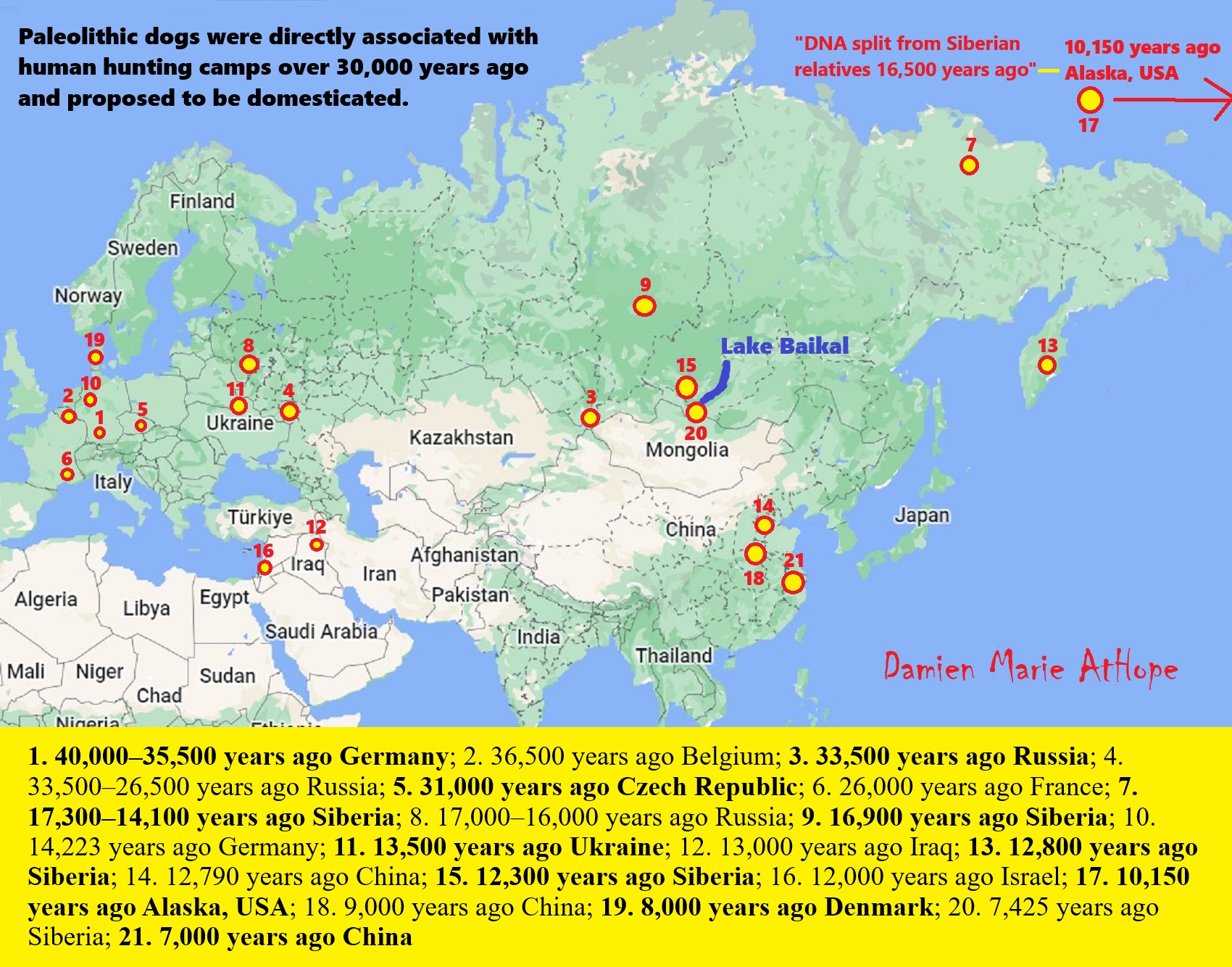
“The Paleolithic dog was a Late Pleistocene canine. They were directly associated with human hunting camps in Europe over 30,000 years ago and it is proposed that these were domesticated. They are further proposed to be either a proto-dog and the ancestor of the domestic dog or an extinct, morphologically and genetically divergent wolf population. There are a number of recently discovered specimens which are proposed as being Paleolithic dogs, however, their taxonomy is debated. These have been found in either Europe or Siberia and date 40,000–17,000 years ago. They include Hohle Fels in Germany, Goyet Caves in Belgium, Predmosti in the Czech Republic, and four sites in Russia: Razboinichya Cave in the Altai Republic, Kostyonki-8, Ulakhan Sular in the Sakha Republic, and Eliseevichi 1 on the Russian plain.” ref
1. 40,000–35,500 years ago Hohle Fels, Schelklingen, Germany
2. 36,500 years ago Goyet Caves, Samson River Valley, Belgium
3. 33,500 years ago Razboinichya Cave, Altai Mountains, (Russia/Siberia)
4. 33,500–26,500 years ago Kostyonki-Borshchyovo archaeological complex, (Kostenki site) Voronezh, Russia
5. 31,000 years ago Predmostí, Moravia, Czech Republic
6. 26,000 years ago Chauvet Cave, Vallon-Pont-d’Arc, Ardèche region, France
7. 17,300–14,100 years ago Dyuktai Cave, northern Yakutia, Siberia
8. 17,000–16,000 years ago Eliseevichi-I site, Bryansk Region, Russian Plain, Russia
9. 16,900 years ago Afontova Gora-1, Yenisei River, southern Siberia
10. 14,223 years ago Bonn–Oberkassel, Germany
11. 13,500 years ago Mezine, Chernigov region, Ukraine
12. 13,000 years ago Palegawra, (Zarzian culture) Iraq
13. 12,800 years ago Ushki I, Kamchatka, eastern Siberia
14. 12,790 years ago Nanzhuangtou, China
15. 12,300 years ago Ust’-Khaita site, Baikal region, Siberia
16. 12,000 years ago Ain Mallaha (Eynan) and HaYonim terrace, Israel
17. 10,150 years ago Lawyer’s Cave, Alaska, USA
18. 9,000 years ago Jiahu site, China
19. 8,000 years ago Svaerdborg site, Denmark
20. 7,425 years ago Lake Baikal region, Siberia
21. 7,000 years ago Tianluoshan archaeological site, Zhejiang province, China ref
- 34,000 years old Paleolithic dog or wolf dog hybrid skulls found in Razboinichya Cave, Siberia
- Dog Domestication, Shamanism, and Emerging “Sacred Companion” Mortuary Rituals between 33,000 to 12,000 years ago?
- The Mytheme of Ancient North Eurasian Sacred-Dog belief and similar motifs are found in Indo-European, Native American, and Siberian comparative mythology
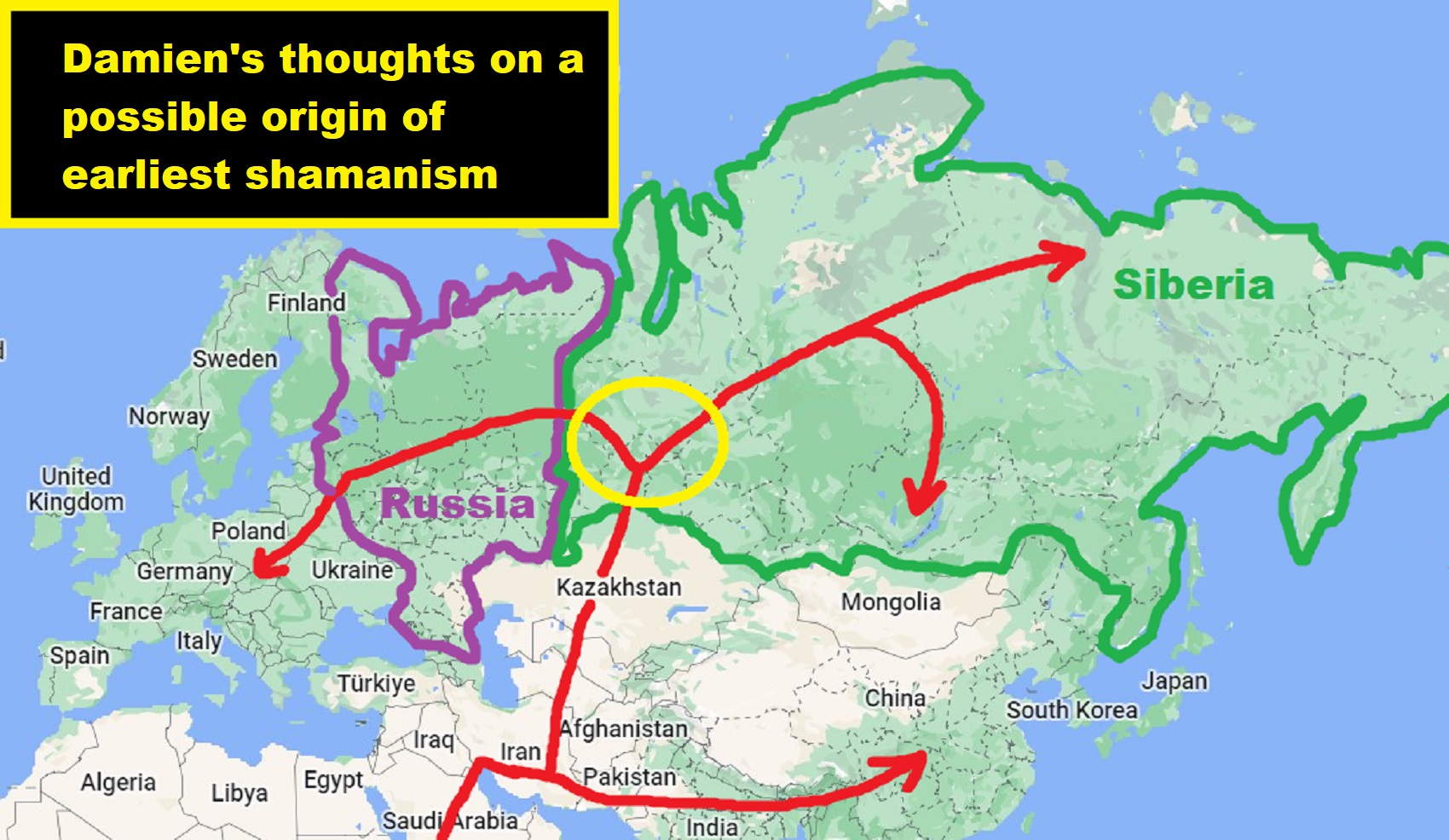
“Haplogroup U is a human mitochondrial DNA haplogroup (mtDNA). The clade arose from haplogroup R, likely during the early Upper Paleolithic. Its various subclades (labeled U1–U9, diverging over the course of the Upper Paleolithic) are found widely distributed across Northern and Eastern Europe, Central, Western, and South Asia, as well as North Africa, the Horn of Africa, and the Canary Islands. Basal U was found in the 26,000-year-old remains of Ancient North Eurasian, Mal’ta boy (MA1). The age of U5 is estimated at between 25,000 and 35,000 years old, roughly corresponding to the Gravettian culture. and is the DNA associated with the seeming first Gravettian shaman burial seen in the Pavlovian culture, around Dolní Věstonice in southern Moravia. One of the Dolní Věstonice burials, located near the huts, revealed a human female skeleton aged to 40+ years old, ritualistically placed beneath a pair of mammoth scapulae, one leaning against the other. Surprisingly, the left side of the skull was disfigured in the same manner as the aforementioned carved ivory figure, indicating that the figure was an intentional depiction of this specific individual. The bones and the earth surrounding the body contained traces of red ocher, a flint spearhead had been placed near the skull, and one hand held the body of a fox. This evidence suggests that this was the burial site of a shaman. This is the oldest site not only of ceramic figurines and artistic portraiture, but also of evidence of female shamans.” ref, ref, ref, ref
“Approximately 11% of Europeans (10% of European-Americans) have some variant of haplogroup U5. U5 was the predominant mtDNA of mesolithic Western Hunter Gatherers (WHG). U5 has been found in human remains dating from the Mesolithic in England, Germany, Lithuania, Poland, Portugal, Russia, Sweden, France, and Spain. Neolithic skeletons (~7,000 years old) that were excavated from the Avellaner cave in Catalonia, northeastern Spain included a specimen carrying haplogroup U5. Haplogroup U5 and its subclades U5a and U5b today form the highest population concentrations in the far north, among Sami, Finns, and Estonians. However, it is spread widely at lower levels throughout Europe. This distribution, and the age of the haplogroup, indicate individuals belonging to this clade were part of the initial expansion tracking the retreat of ice sheets from Europe around 10,000 years ago. The modern Basques and Cantabrians possess almost exclusively U5b lineages (U5b1f, U5b1c1, U5b2).” ref
6 Ice Age Humans (30,000 Years Ago)
“Abstract: Starting about 35,000 years ago, humans seem to have made a great leap forward culturally. The authors argue that this wasn’t because of genetic changes that caused the human brain to have increased capacity. It was because some groups culturally evolved the “social tools” that allowed them to maintain connections and share information over long distances. The groups with the most effective social tools managed to stay connected and to survive, and their descendants inherited this culture of connectedness. It’s likely that forming greater connectedness and more complex culture was necessary in order to survive the periods of high climate variability that were a feature of the last ice age.” ref
“Archaeologists usually describe two regional variants: the western Gravettian, known mainly from cave sites in France, Spain, and Britain, and the eastern Gravettian in Central Europe and Russia. The eastern Gravettians, which include the Pavlovian culture, were specialized mammoth hunters, whose remains are usually found not in caves but in open air sites. Gravettian culture thrived on their ability to hunt animals. They utilized a variety of tools and hunting strategies. Compared to theorized hunting techniques of Neanderthals and earlier human groups, Gravettian hunting culture appears much more mobile and complex. They lived in caves or semi-subterranean or rounded dwellings which were typically arranged in small “villages”. Gravettians are thought to have been innovative in the development of tools such as blunted-back knives, tanged arrowheads, and boomerangs. Other innovations include the use of woven nets and oil lamps made of stone. Blades and bladelets were used to make decorations and bone tools from animal remains.” ref
“Gravettian culture extends across a large geographic region, as far as Estremadura in Portugal. but is relatively homogeneous until about 27,000 years ago. They developed burial rites, which included simple, purpose-built offerings and/or personal ornaments owned by the deceased, placed within the grave or tomb. Surviving Gravettian art includes numerous cave paintings and small, portable Venus figurines made from clay or ivory, as well as jewelry objects. The fertility deities mostly date from the early period; there are over 100 known surviving examples. They conform to a very specific physical type, with large breasts, broad hips and prominent posteriors. The statuettes tend to lack facial details, and their limbs are often broken off. During the post glacial period, evidence of the culture begins to disappear from northern Europe but was continued in areas around the Mediterranean. The Mal’ta Culture (c. 24,000 years ago) in Siberia is often considered as belonging to the Gravettian, due to its similar characteristics, particularly its Venus figurines, but any hypothetical connection would have to be cultural and not genetic: a 2016 genomic study showed that the Mal’ta people have no genetic connections with the people of the European Gravettian culture (the Vestonice Cluster).” ref
“Fu et al. (2016) examined the remains of fourteen Gravettians. The eight males included three samples of Y-chromosomal haplogroup CT, one of I, one IJK, one BT, one C1a2, and one sample of F. Of the fourteen samples of mtDNA, there were thirteen samples of U and one sample of M. The majority of the sample of U belonged to the U5 and U2. Teschler et al. (2020) examined the remains of one adult male and two twin boys from a Gravettian site in Austria. All belonged to haplogroup Y-Haplogroup I. and all had the same mtDNA, U5. According to Scorrano et al. (2022), “the genome of an early European individual from Kostenki 14, dated to around 37,000 years ago, demonstrated that the ancestral European gene pool was already established by that time.” ref
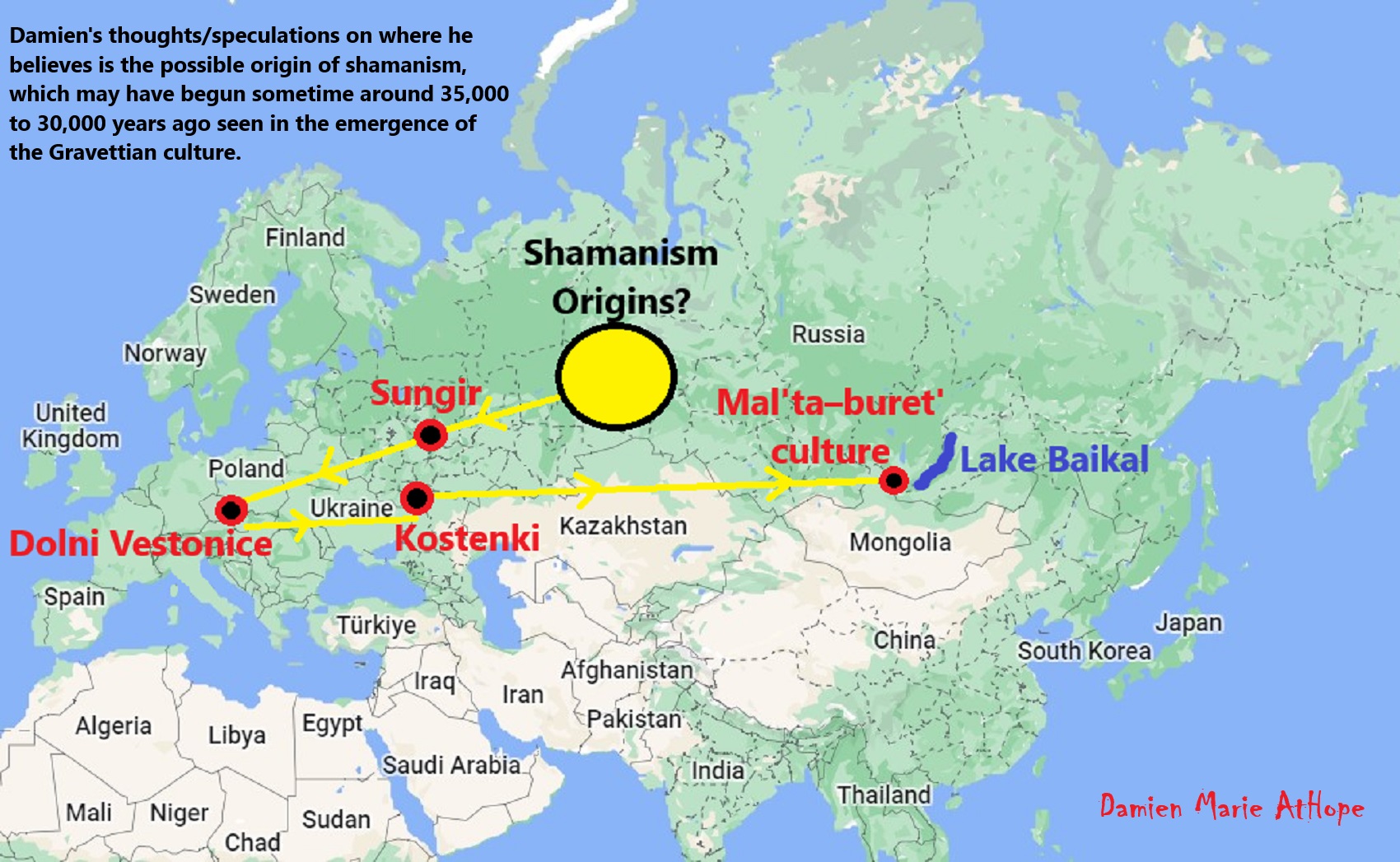
Here are Damien’s thoughts/speculations on where he believes is the possible origin of shamanism, which may have begun sometime around 35,000 to 30,000 years ago seen in the emergence of the Gravettian culture, just to outline his thinking, on what thousands of years later led to evolved Asian shamanism, in general, and thus WU shamanism as well. In both Europe-related “shamanism-possible burials” and in Gravettian mitochondrial DNA is a seeming connection to Haplogroup U. And the first believed Shaman proposed burial belonged to Eastern Gravettians/Pavlovian culture at Dolní Věstonice in southern Moravia in the Czech Republic, which is the oldest permanent human settlement that has ever been found. It is at Dolní Věstonice where approximately 27,000-25,000 years ago a seeming female shaman was buried and also there was an ivory totem portrait figure, seemingly of her.
“The Pavlovian is an Upper Paleolithic culture, a variant of the Gravettian, that existed in the region of Moravia, northern Austria, and southern Poland around 29,000–25,000 years ago. Its name is derived from the village of Pavlov, in the Pavlov Hills, next to Dolní Věstonice in southern Moravia. The culture used sophisticated stone age technology to survive in the tundra on the fringe of the ice sheets around the Last Glacial Maximum. Excavation has yielded flint implements, polished and drilled stone artifacts, bone spearheads, needles, digging tools, flutes, bone ornaments, drilled animal teeth, and seashells. Art or religious finds are bone carvings and figurines of humans and animals made of mammoth tusk, stone, and fired clay.” ref
“One of the burials, located near the huts, revealed a human female skeleton aged to 40+ years old, ritualistically placed beneath a pair of mammoth scapulae, one leaning against the other. Surprisingly, the left side of the skull was disfigured in the same manner as the aforementioned carved ivory figure, indicating that the figure was an intentional depiction of this specific individual. The bones and the earth surrounding the body contained traces of red ocher, a flint spearhead had been placed near the skull, and one hand held the body of a fox. This evidence suggests that this was the burial site of a shaman. This is the oldest site not only of ceramic figurines and artistic portraiture, but also of evidence of female shamans.” ref
“A burial of an approximately forty-year-old woman was found at Dolní Věstonice in an elaborate burial setting. Various items found with the woman have had a profound impact on the interpretation of the social hierarchy of the people at the site, as well as indicating an increased lifespan for these inhabitants. The remains were covered in red ochre, a compound known to have religious significance, indicating that this woman’s burial was ceremonial in nature. Also, the inclusion of a mammoth scapula and a fox are indicative of a high-status burial.” ref
“In the Upper Paleolithic, anatomically modern humans began living longer, often reaching middle age, by today’s standards. Rachel Caspari argues in “Human Origins: the Evolution of Grandparents,” that life expectancy increased during the Upper Paleolithic in Europe (Caspari 2011). She also describes why elderly people were highly influential in society. Grandparents assisted in childcare, perpetuated cultural transmission, and contributed to the increased complexity of stone tools (Caspari 2011). The woman found at Dolní Věstonice was old enough to have been a grandparent. Although human lifespans were increasing, elderly individuals in Upper Paleolithic societies were still relatively rare. Because of this, it is possible that the woman was attributed with great importance and wisdom, and revered because of her age. Because of her advanced age, it is also possible she had a decreased ability to care for herself, instead relying on her family group to care for her, which indicates strong social connections.” ref
“Furthermore, a female figurine was found at the site and is believed to be associated with the aged woman, because of remarkably similar facial characteristics. The woman was found to have deformities on the left side of her face. The special importance accorded with her burial, in addition to her facial deformity, makes it possible that she was a shaman in this time period, where it was “not uncommon that people with disabilities, either mental or physical, are thought to have unusual supernatural powers” (Pringle 2010).” ref
“In 1981, Patricia Rice studied a multitude of female clay figurines found at Dolní Věstonice, believed to represent fertility in this society. She challenged this assumption by analyzing all the figurines and found that, “it is womanhood, rather than motherhood that is symbolically recognized or honored” (Rice 1981: 402). This interpretation challenged the widely held assumption that all prehistoric female figurines were created to honor fertility. The fact is that we have no idea why these figurines proliferated nor of their purpose or usage.” ref
“Haplogroup U5 is estimated to be about 30,000 years old, and it is primarily found today in people with European ancestry. Both the current geographic distribution of U5 and testing of ancient human remains indicate that the ancestor of U5 expanded into Europe before 31,000 years ago. A 2013 study by Fu et al. found two U5 individuals at the Dolni Vestonice burial site in the Czech Republic that has been dated to 31,155 years ago. A third person from the same burial was identified as haplogroup U8. The Dolni Vestonice samples have only two of the five mutations ( C16192T and C16270T) that are found in the present day U5 population. This indicates that the U5-(C16192T and C16270T) mtDNA sequence is ancestral to the present day U5 population that includes the additional three mutations T3197C, G9477A and T13617C.” ref
“Haplogroup U5 is thought to have evolved in the western steppe region and then entered Europe around 30,000 to 55,000 years ago. Results support previous hypotheses that haplogroup U5 mtDNAs expanded throughout Northern, Southern, and Central Europe with more recent expansions into Western Europe and Africa. The results further allow us to explain how U5 mtDNAs are now found with high frequency in Northern Europe, as well as delineate the origins of the specific U5 subhaplogroups found in that part of Europe.” ref
“Haplogroup U5 is found throughout Europe with an average frequency ranging from 5% to 12% in most regions. U5a is most common in north-east Europe and U5b in northern Spain. Nearly half of all Sami and one fifth of Finnish maternal lineages belong to U5. Other high frequencies are observed among the Mordovians (16%), the Chuvash (14.5%) and the Tatars (10.5%) in the Volga-Ural region of Russia, the Estonians (13%), the Lithuanians (11.5%) and the Latvians in the Baltic, the Dargins (13.5%), Avars (13%) and the Chechens (10%) in the Northeast Caucasus, the Basques (12%), the Cantabrians (11%) and the Catalans (10%) in northern Spain, the Bretons (10.5%) in France, the Sardinians (10%) in Italy, the Slovaks (11%), the Croatians (10.5%), the Poles (10%), the Czechs (10%), the Ukrainians (10%) and the Slavic Russians (10%). Overall, U5 is generally found in population with high percentages of Y-haplogroups I1, I2, and R1a, three lineages already found in Mesolithic Europeans. The highest percentages are observed in populations associated predominantly with Y-haplogroup N1c1 (the Finns and the Sami), although N1c1 is originally an East Asian lineage that spread over Siberia and Northeast Europe and assimilated indigenous U5 maternal lineages.” ref
“The age of haplogroup U5 is uncertain at present. It could have arisen as recently as 35,000 years ago, or as early was 50,000 years ago. U5 appear to have been a major maternal lineage among the Paleolithic European hunter-gatherers, and even the dominant lineage during the European Mesolithic. In two papers published two months apart, Posth et al. 2016 and Fu et al. 2016 reported the results of over 70 complete human mitochondrial genomes ranging from 45,000 to 7,000 years ago. The oldest U5 samples all dated from the Gravettian culture (c. 32,000 to 22,000 years ago), while the older Aurignacian samples belonged to mt-haplogroups M, N, R*, and U2. Among the 16 Gravettian samples that yielded reliable results, six belonged to U5 – the others belonging mostly to U2, as well as isolated samples of M, U*, and U8c. Two Italian Epigravettian samples, one from the Paglicci Cave in Apulia (18,500 years ago), and another one from Villabruna in Veneto (14,000 years ago), belonged to U5b2b, as did two slightly more recent Epipaleolithic samples from the Rhône valley in France. U5b1 samples were found in Epipalaeolithic Germany, Switzerland (U5b1h in the Grotte du Bichon), and France. More 80% of the numerous Mesolithic European mtDNA tested to date belonged to various subclades of U5. Overall, it appears that U5 arrived in Europe with the Gravettian tool makers, and that it particularly prospered from the end of the glacial period (from 11,700 years ago) until the arrival of Neolithic farmers from the Near East (between 8,500 and 6,000 years ago).” ref
“Carriers of haplogroup U5 were part of the Gravettian culture, which experienced the Last Glacial Maximum (LGM, 26,000 to 19,000 years ago). During this particularly harsh period, Gravettian people would have retreated into refugia in southern Europe, from which they would have re-expanded to colonise the northern half of the continent during the Late Glacial and postglacial periods. For reasons that are yet unknown, haplogroup U5 seems to have resisted better to the LGM to other Paleolithic haplogroups like U*, U2 and U8. Mitochondrial DNA being essential for energy production, it could be that the mutations selected in early U5 subclades (U5a1, U5a2, U5b1, U5b2) conferred an advantage for survival during the coldest millennia of the LGM, which had for effect to prune less energy efficient mtDNA lineages.” ref
“It is likely that U5a and U5b lineages already existed prior to the LGM and they were geographically scattered to some extent around Europe before the growing ice sheet forced people into the refugia. Nonetheless, founder effects among the populations of each LGM refugium would have amplified the regional division between U5b and U5a. U5b would have been found at a much higher frequency in the Franco-Cantabrian region. We can deduce this from the fact that modern Western Europeans have considerably more U5b than U5a, but also because the modern Basques and Cantabrians possess almost exclusively U5b lineages. What’s more, all the Mesolithic U5 samples from Iberia whose subclade could be identified belonged to U5b.” ref
“Conversely, only U5a lineages have been found so far in Mesolithic Russia (U5a1) and Sweden (U5a1 and U5a2), which points at an eastern origin of this subclade. Mesolithic samples from Poland, Germany and Italy yielded both U5a and U5b subclades. German samples included U5a2a, U5a2c3, U5b2 and U5b2a2. The same observations are valid for the Neolithic and Chalcolithic periods too, with U5a1 being found in Russia and Ukraine, U5b in France (Cardium Pottery and Megalithic), U5b2 in Portugal. U5b1b1 arose approximately 10,000 years ago, over two millennia after the end of the Last Glaciation, when the Neolithic Revolution was already under way in the Near East. Despite this relatively young age, U5b1b1 is found scattered across all Europe and well beyond its boundaries. The Saami, who live in the far European North and have 48% of U5 and 42% of V lineages, belong exclusively to the U5b1b1 subclade. Amazingly, the Berbers of Northwest Africa also possess that U5b1b1 subclade and haplogroup V.” ref

ref, ref, ref, ref, ref, ref, ref, ref, ref, ref, ref, ref, ref, ref, ref, ref, ref, ref, ref
Here are my thoughts/speculations on where I believe is the possible origin of shamanism, which may have begun sometime around 35,000 to 30,000 years ago seen in the emergence of the Gravettian culture, just to outline his thinking, on what thousands of years later led to evolved Asian shamanism, in general, and thus WU shamanism as well. In both Europe-related “shamanism-possible burials” and in Gravettian mitochondrial DNA is a seeming connection to Haplogroup U. And the first believed Shaman proposed burial belonged to Eastern Gravettians/Pavlovian culture at Dolní Věstonice in southern Moravia in the Czech Republic, which is the oldest permanent human settlement that has ever been found. It is at Dolní Věstonice where approximately 27,000-25,000 years ago a seeming female shaman was buried and also there was an ivory totem portrait figure, seemingly of her.
And my thoughts on how cultural/ritual aspects were influenced in the area of Göbekli Tepe. I think it relates to a few different cultures starting in the area before the Neolithic. Two different groups of Siberians first from northwest Siberia with U6 haplogroup 40,000 to 30,000 or so. Then R Haplogroup (mainly haplogroup R1b but also some possible R1a both related to the Ancient North Eurasians). This second group added its “R1b” DNA of around 50% to the two cultures Natufian and Trialetian. To me, it is likely both of these cultures helped create Göbekli Tepe. Then I think the female art or graffiti seen at Göbekli Tepe to me possibly relates to the Epigravettians that made it into Turkey and have similar art in North Italy. I speculate that possibly the Totem pole figurines seen first at Kostenki, next went to Mal’ta in Siberia as seen in their figurines that also seem “Totem-pole-like”, and then with the migrations of R1a it may have inspired the Shigir idol in Russia and the migrations of R1b may have inspired Göbekli Tepe.
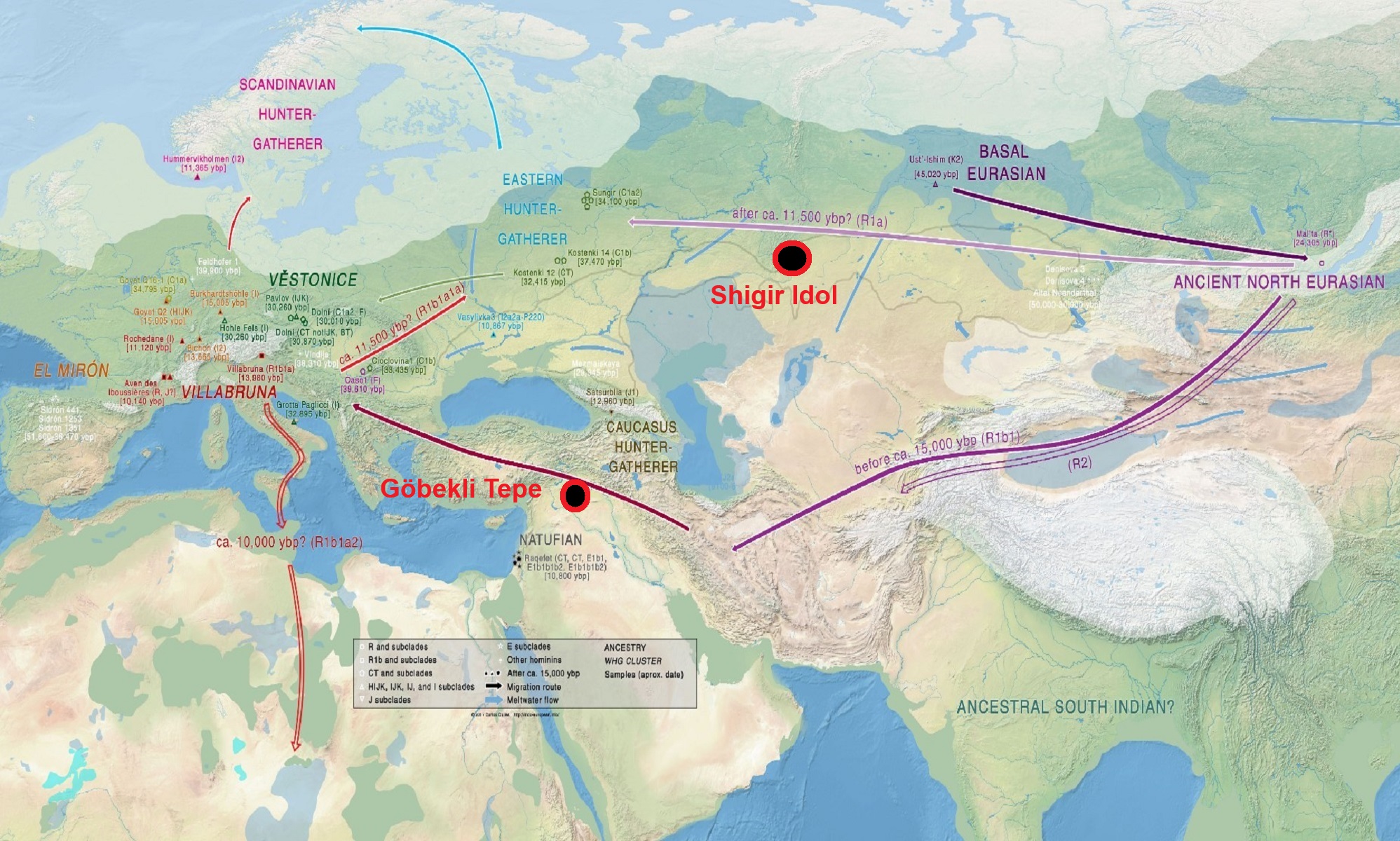
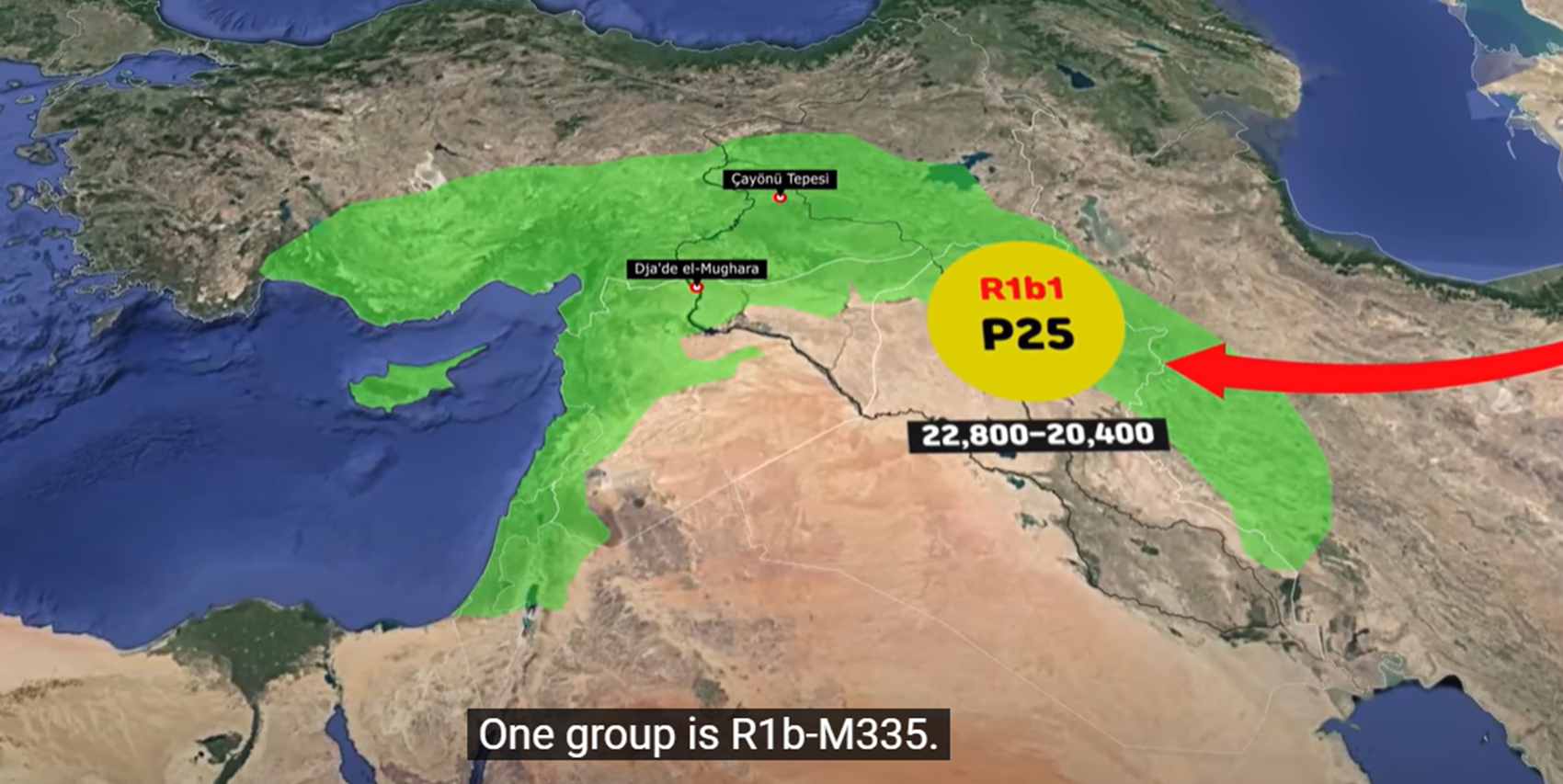
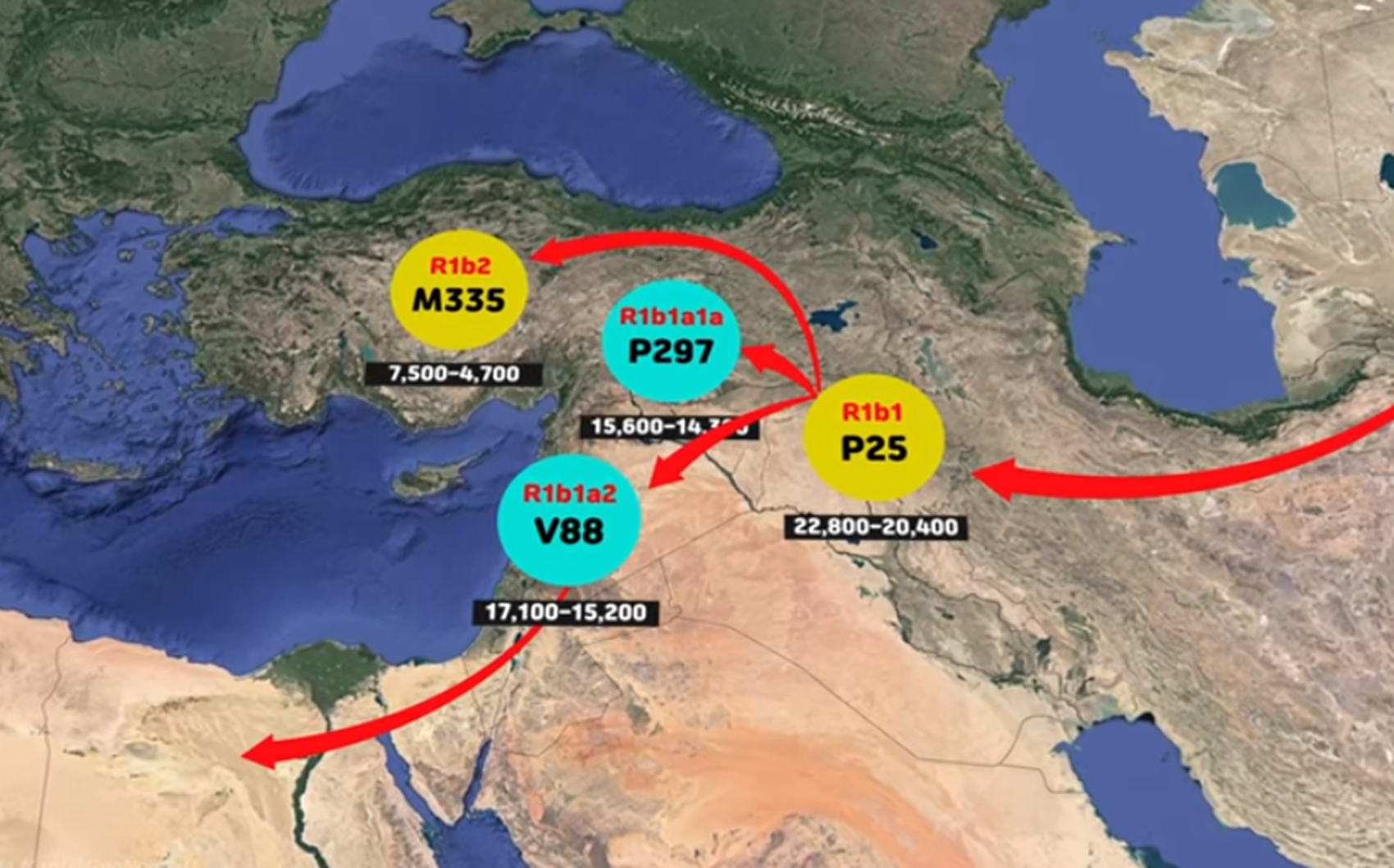
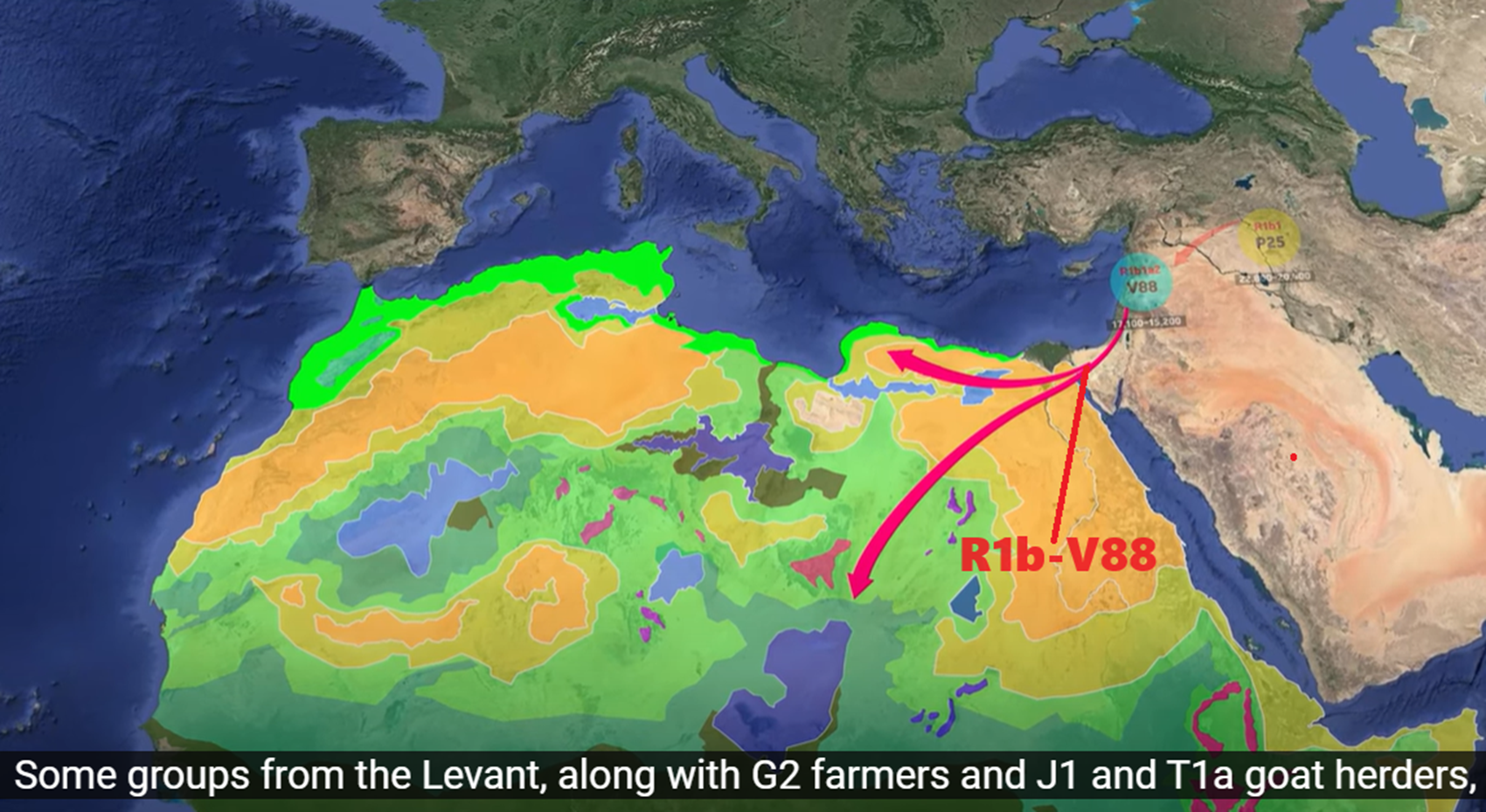
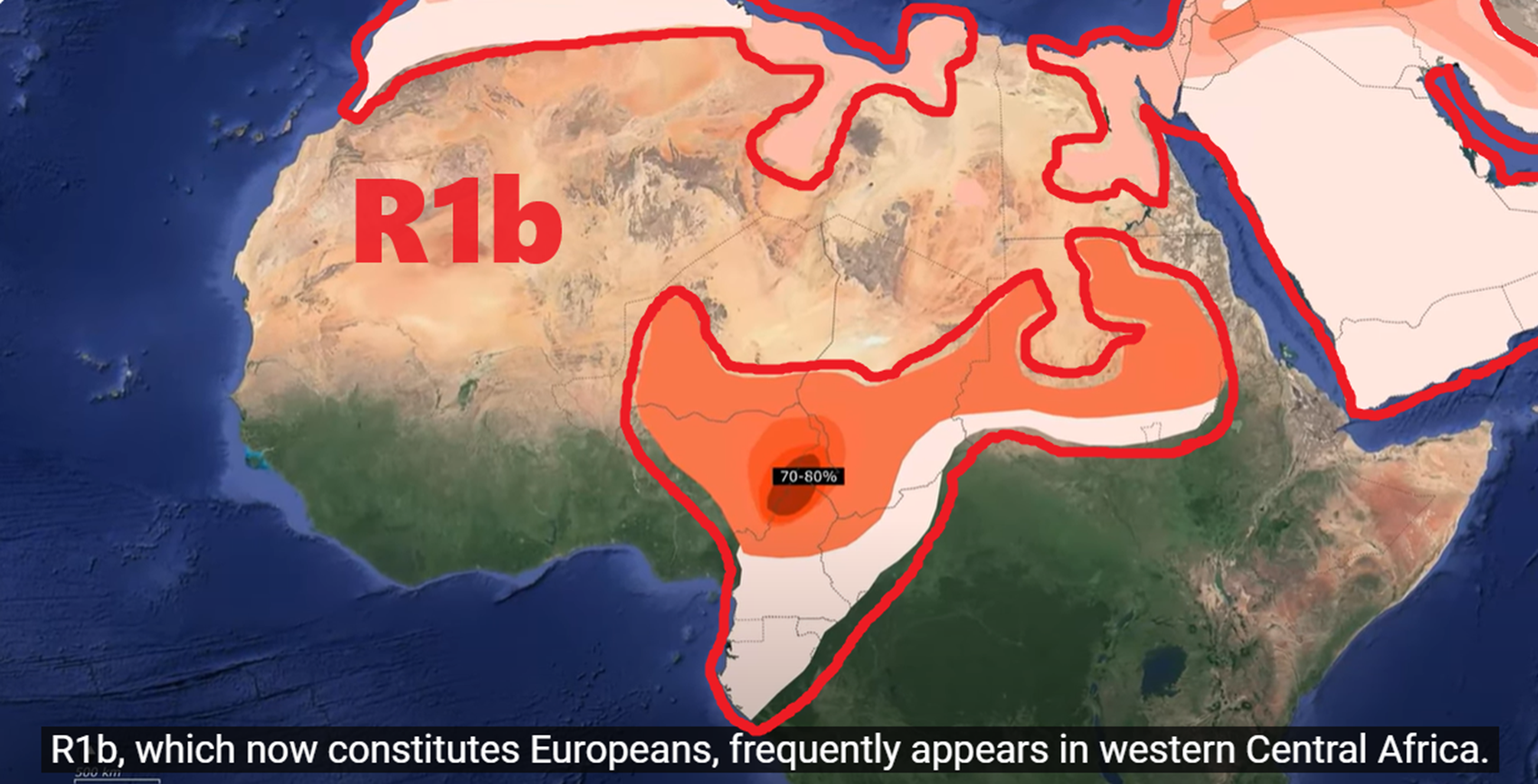
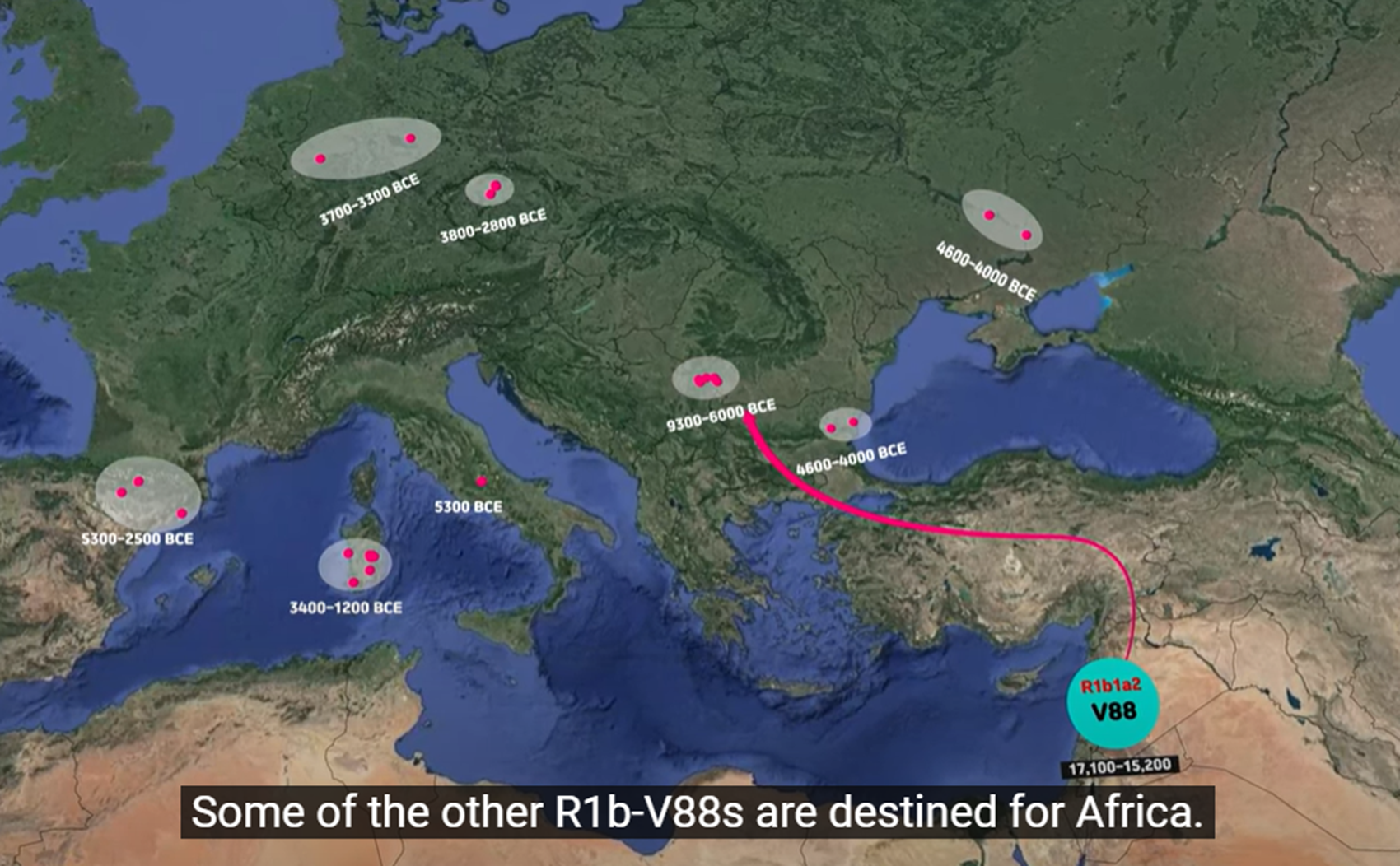
“Haplogroup R* originated in North Asia just before the Last Glacial Maximum (26,500-19,000 years ago). This haplogroup has been identified in the remains of a 24,000 year-old boy from the Altai region, in south-central Siberia (Raghavan et al. 2013). This individual belonged to a tribe of mammoth hunters that may have roamed across Siberia and parts of Europe during the Paleolithic. Autosomally this Paleolithic population appears to have contributed mostly to the ancestry of modern Europeans and South Asians, the two regions where haplogroup R also happens to be the most common nowadays (R1b in Western Europe, R1a in Eastern Europe, Central and South Asia, and R2 in South Asia).” ref
“The oldest forms of R1b (M343, P25, L389) are found dispersed at very low frequencies from Western Europe to India, a vast region where could have roamed the nomadic R1b hunter-gatherers during the Ice Age. The three main branches of R1b1 (R1b1a, R1b1b, R1b1c) all seem to have stemmed from the Middle East. The southern branch, R1b1c (V88), is found mostly in the Levant and Africa. The northern branch, R1b1a (P297), seems to have originated around the Caucasus, eastern Anatolia or northern Mesopotamia, then to have crossed over the Caucasus, from where they would have invaded Europe and Central Asia. R1b1b (M335) has only been found in Anatolia.” ref
“It has been hypothetised that R1b people (perhaps alongside neighbouring J2 tribes) were the first to domesticate cattle in northern Mesopotamia some 10,500 years ago. R1b tribes descended from mammoth hunters, and when mammoths went extinct, they started hunting other large game such as bisons and aurochs. With the increase of the human population in the Fertile Crescent from the beginning of the Neolithic (starting 12,000 years ago), selective hunting and culling of herds started replacing indiscriminate killing of wild animals. The increased involvement of humans in the life of aurochs, wild boars and goats led to their progressive taming. Cattle herders probably maintained a nomadic or semi-nomadic existence, while other people in the Fertile Crescent (presumably represented by haplogroups E1b1b, G and T) settled down to cultivate the land or keep smaller domesticates.” ref
“The analysis of bovine DNA has revealed that all the taurine cattle (Bos taurus) alive today descend from a population of only 80 aurochs. The earliest evidence of cattle domestication dates from circa 8,500 BCE in the Pre-Pottery Neolithic cultures in the Taurus Mountains. The two oldest archaeological sites showing signs of cattle domestication are the villages of Çayönü Tepesi in southeastern Turkey and Dja’de el-Mughara in northern Iraq, two sites only 250 km away from each others. This is presumably the area from which R1b lineages started expanding – or in other words the “original homeland” of R1b.” ref
“The early R1b cattle herders would have split in at least three groups. One branch (M335) remained in Anatolia, but judging from its extreme rarity today wasn’t very successful, perhaps due to the heavy competition with other Neolithic populations in Anatolia, or to the scarcity of pastures in this mountainous environment. A second branch migrated south to the Levant, where it became the V88 branch. Some of them searched for new lands south in Africa, first in Egypt, then colonising most of northern Africa, from the Mediterranean coast to the Sahel. The third branch (P297), crossed the Caucasus into the vast Pontic-Caspian Steppe, which provided ideal grazing grounds for cattle. They split into two factions: R1b1a1 (M73), which went east along the Caspian Sea to Central Asia, and R1b1a2 (M269), which at first remained in the North Caucasus and the Pontic Steppe between the Dnieper and the Volga. It is not yet clear whether M73 actually migrated across the Caucasus and reached Central Asia via Kazakhstan, or if it went south through Iran and Turkmenistan. In any case, M73 would be a pre-Indo-European branch of R1b, just like V88 and M335.” ref
“R1b-M269 (the most common form in Europe) is closely associated with the diffusion of Indo-European languages, as attested by its presence in all regions of the world where Indo-European languages were spoken in ancient times, from the Atlantic coast of Europe to the Indian subcontinent, which comprised almost all Europe (except Finland, Sardinia and Bosnia-Herzegovina), Anatolia, Armenia, European Russia, southern Siberia, many pockets around Central Asia (notably in Xinjiang, Turkmenistan, Tajikistan and Afghanistan), without forgetting Iran, Pakistan, northern India and Nepal. The history of R1b and R1a are intricately connected to each others.” ref
The Levantine & African branch of R1b (V88)
“Like its northern counterpart (R1b-M269), R1b-V88 is associated with the domestication of cattle in northern Mesopotamia. Both branches of R1b probably split soon after cattle were domesticated, approximately 10,500 years ago (8,500 BCE). R1b-V88 migrated south towards the Levant and Egypt. The migration of R1b people can be followed archeologically through the presence of domesticated cattle, which appear in central Syria around 8,000-7,500 BCE (late Mureybet period), then in the Southern Levant and Egypt around 7,000-6,500 BCE (e.g. at Nabta Playa and Bir Kiseiba). Cattle herders subsequently spread across most of northern and eastern Africa. The Sahara desert would have been more humid during the Neolithic Subpluvial period (c. 7250-3250 BCE), and would have been a vast savannah full of grass, an ideal environment for cattle herding.” ref
“Evidence of cow herding during the Neolithic has shown up at Uan Muhuggiag in central Libya around 5500 BCE, at the Capeletti Cave in northern Algeria around 4500 BCE. But the most compelling evidence that R1b people related to modern Europeans once roamed the Sahara is to be found at Tassili n’Ajjer in southern Algeria, a site famous pyroglyphs (rock art) dating from the Neolithic era. Some painting dating from around 3000 BCE depict fair-skinned and blond or auburn haired women riding on cows. The oldest known R1b-V88 sample in Europe is a 6,200 year-old farmer/herder from Catalonia tested by Haak et al. (2015). Autosomally this individual was a typical Near Eastern farmer, possessing just a little bit of Mesolithic West European admixture.” ref
“After reaching the Maghreb, R1b-V88 cattle herders could have crossed the Strait of Gibraltar to Iberia, probably accompanied by G2 farmers, J1 and T1a goat herders. These North African Neolithic farmers/herders could have been the ones who established the Almagra Pottery culture in Andalusia in the 6th millennium BCE.” ref
“Nowadays small percentages (1 to 4%) of R1b-V88 are found in the Levant, among the Lebanese, the Druze, and the Jews, and almost in every country in Africa north of the equator. Higher frequency in Egypt (5%), among Berbers from the Egypt-Libya border (23%), among the Sudanese Copts (15%), the Hausa people of Sudan (40%), the the Fulani people of the Sahel (54% in Niger and Cameroon), and Chadic tribes of northern Nigeria and northern Cameroon (especially among the Kirdi), where it is observed at a frequency ranging from 30% to 95% of men. According to Cruciani et al. (2010) R1b-V88 would have crossed the Sahara between 9,200 and 5,600 years ago, and is most probably associated with the diffusion of Chadic languages, a branch of the Afroasiatic languages. V88 would have migrated from Egypt to Sudan, then expanded along the Sahel until northern Cameroon and Nigeria. However, R1b-V88 is not only present among Chadic speakers, but also among Senegambian speakers (Fula-Hausa) and Semitic speakers (Berbers, Arabs).” ref
“R1b-V88 is found among the native populations of Rwanda, South Africa, Namibia, Angola, Congo, Gabon, Equatorial Guinea, Ivory Coast, Guinea-Bissau. The wide distribution of V88 in all parts of Africa, its incidence among herding tribes, and the coalescence age of the haplogroup all support a Neolithic dispersal. In any case, a later migration out of Egypt would be improbable since it would have brought haplogroups that came to Egypt during the Bronze Age, such as J1, J2, R1a or R1b-L23. The maternal lineages associated with the spread of R1b-V88 in Africa are mtDNA haplogroups J1b, U5 and V, and perhaps also U3 and some H subclades (=> see Retracing the mtDNA haplogroups of the original R1b people).” ref
R1b-v88 haplogroup
“According to ancient DNA studies, most R1a and R1b lineages would have expanded from the Pontic Steppe along with the Indo-European languages. Analysis of ancient Y-DNA from the remains from early Neolithic Central and North European Linear Pottery culture settlements have not yet found males belonging to haplogroup R1b-M269. Olalde et al. (2017) trace the spread of haplogroup R1b-M269 in western Europe, particularly Britain, to the spread of the Beaker culture, with a sudden appearance of many R1b-M269 haplogroups in Western Europe ca. 5000–4500 years BP during the early Bronze Age. Two branches of R-V88, R-M18 and R-V35, are found almost exclusively on the island of Sardinia. As can be seen in the above data table, R-V88 is found in northern Cameroon in west central Africa at a very high frequency, where it is considered to be caused by a pre-Islamic movement of people from Eurasia.” ref
R1b1b (R-V88)
“R1b1b (PF6279/V88; previously R1b1a2) is defined by the presence of SNP marker V88, the discovery of which was announced in 2010 by Cruciani et al. Apart from individuals in southern Europe and Western Asia, the majority of R-V88 was found in the Sahel, especially among populations speaking Afroasiatic languages of the Chadic branch. Studies in 2005–08 reported “R1b*” at high levels in Jordan, Egypt and Sudan. Subsequent research by Myres et al. (2011) indicates that the samples concerned most likely belong to the subclade R-V88, which is now concentrated in Sub-Saharan Africa.” ref
“According to Myres et al. (2011), this may be explained by a back-migration from Asia into Africa by R1b-carrying people. Gonzales et al. (2013), using more advanced techniques, indicate that it is equally probable that V88 originated in Central Africa and spread northward towards Asia. The patterns of diversity in African R1b-V88 did not seem to fit with a movement of Chadic-speaking people from the North, across the Sahara to West-Central Africa, but was compatible with the reverse. An origin of V88 lineages in Central Africa, followed by a migration to North Africa. However, Shriner, D., & Rotimi, C. N. (2018), associate the introduction of R1b into Chad, with the more recent movements of Baggara Arabs.” ref
“D’Atanasio et al. (2018) propose that R1b-V88 originated in Europe about 12 000 years ago and crossed to North Africa by about 8000 years ago; it may formerly have been common in southern Europe, where it has since been replaced by waves of other haplogroups, leaving remnant subclades almost exclusively in Sardinia. It first radiated within Africa likely between 8000 and 7000 years ago – at the same time as trans-Saharan expansions within the unrelated haplogroups E-M2 and A-M13 – possibly due to population growth allowed by humid conditions and the adoption of livestock herding in the Sahara. R1b-V1589, the main subclade within R1b-V88, underwent a further expansion around 5500 years ago, likely in the Lake Chad Basin region, from which some lines recrossed the Sahara to North Africa.” ref
“Marcus et al. (2020) provide strong evidence for this proposed model of North to South trans-Saharan movement: The earliest basal R1b-V88 haplogroups are found in several Eastern European Hunter Gatherers close to 10,000 years ago. The haplogroup then seemingly further spread with the Neolithic Cardial Ware expansion, which established agriculture in the Western Mediterranean around 7500 years ago: R1b-V88 haplogroups were identified in ancient Neolithic individuals in central Italy, Iberia and, at a particularly high frequency, in Sardinia. A part of the branch leading to present-day African haplogroups (V2197) is already derived in some of these ancient Neolithic European individuals, providing further support for a North-to-South trans-Saharan movement.” ref
“Early human remains found to carry R1b include:
- Villabruna 1 (individual I9030), a Western Hunter-Gatherer (WHG), found in an Epigravettian culture setting in the Cismon valley (modern Veneto, Italy), who lived circa 14000 years ago and belonged to R1b1a.
- Several males of the Iron Gates Mesolithic in the Balkans buried between 11,200 to 8,200 years ago carried R1b1a1a. These individuals were determined to be largely of WHG ancestry, with slight Eastern Hunter-Gatherer (EHG) admixture.
- Several males of the Mesolithic Kunda culture and Neolithic Narva culture buried in the Zvejnieki burial ground in modern-day Latvia c. 9,500–6,000 years ago carried R1b1b. These individuals were determined to be largely of WHG ancestry, with slight EHG admixture.
- Several Mesolithic and Neolithic males buried at Deriivka and Vasil’evka in modern-day Ukraine c. 9500-7000 years ago carried R1b1a. These individuals were largely of EHG ancestry, with significant WHG admixture.
- A WHG male buried at Ostrovul Corbuli, Romania c. 8,700 years ago carried R1b1c.
- A male buried at Lepenski Vir, Serbia c. 8,200-7,900 years ago carried R1b1a.
- An EHG buried near Samara, Russia 7,500 years ago carried R1b1a1a.
- An Eneolithic male buried at Khvalynsk, Russia c. 7,200-6,000 years ago carried R1b1a.
- A Neolithic male buried at Els Trocs, Spain c. 7,178-7,066 years ago, who may have belonged to the Epi-Cardial culture, was found to be a carrier of R1b1.
- A Late Chalcolithic male buried in Smyadovo, Bulgaria c. 6,500 years ago carried R1b1a.
- An Early Copper Age male buried in Cannas di Sotto, Carbonia, Sardinia c. 6,450 years ago carried R1b1b2.
- A male of the Baalberge group in Central Europe buried c. 5,600 years ago carried R1b1a.
- A male of the Botai culture in Central Asia buried c. 5,500 years ago carried R1b1a1 (R1b-M478).
- 7 males that were tested of the Yamnaya culture were all found to belong to the M269 subclade of haplogroup R1b.” ref
“R1b is a subclade within the “macro-haplogroup“ K (M9), the most common group of human male lines outside of Africa. K is believed to have originated in Asia (as is the case with an even earlier ancestral haplogroup, F (F-M89). Karafet T. et al. (2014) “rapid diversification process of K-M526 likely occurred in Southeast Asia, with subsequent westward expansions of the ancestors of haplogroups R and Q.” ref
“Three genetic studies in 2015 gave support to the Kurgan hypothesis of Marija Gimbutas regarding the Proto-Indo-European homeland. According to those studies, haplogroups R1b-M269 and R1a, now the most common in Europe (R1a is also common in South Asia) would have expanded from the West Eurasian Steppe, along with the Indo-European languages; they also detected an autosomal component present in modern Europeans which was not present in Neolithic Europeans, which would have been introduced with paternal lineages R1b and R1a, as well as Indo-European languages.” ref
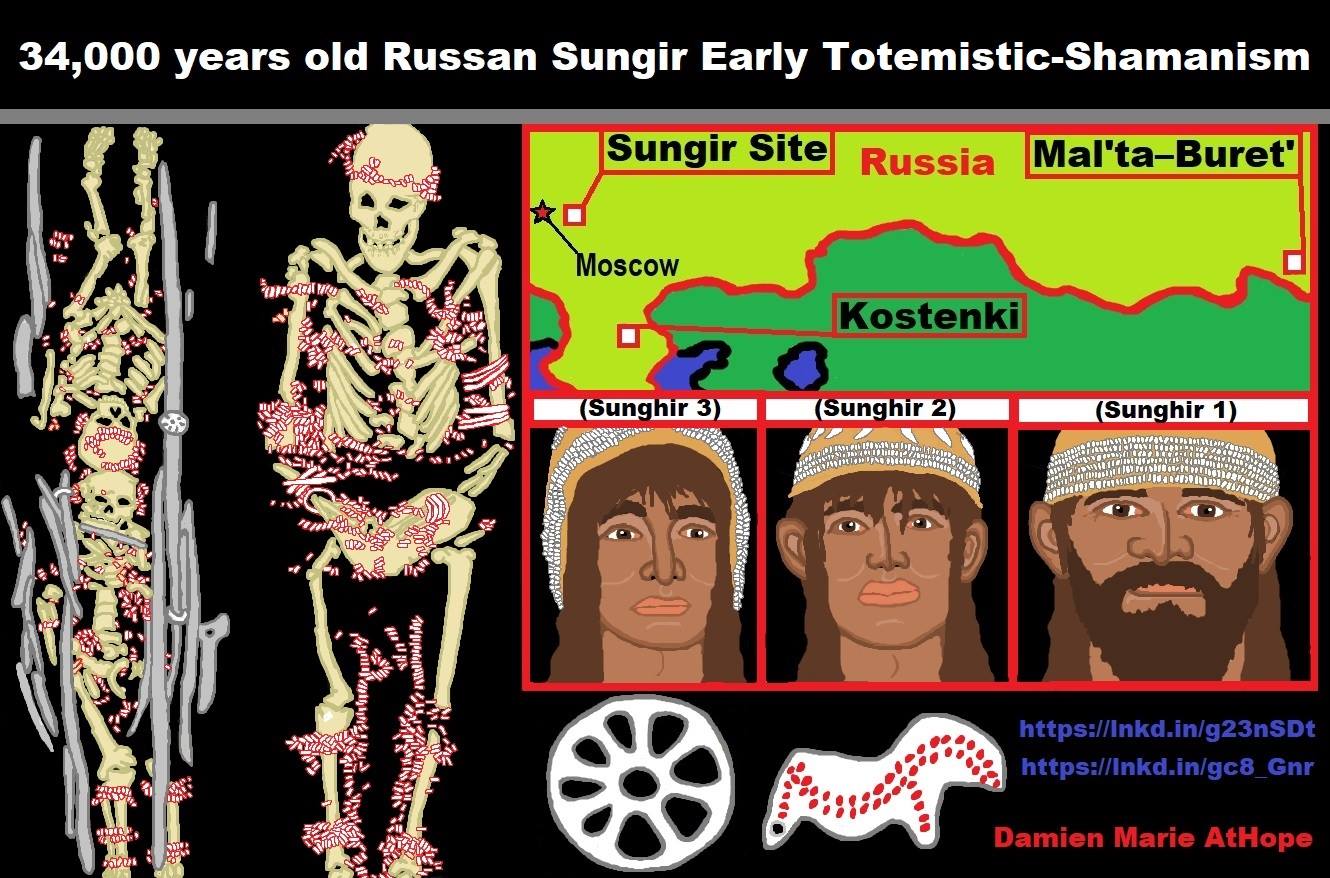
Gravettian
“The Gravettian was an archaeological industry of the European Upper Paleolithic that succeeded the Aurignacian circa 33,000 years ago. It is archaeologically the last European culture many consider unified, and had mostly disappeared by c. 22,000 years ago, close to the Last Glacial Maximum, although some elements lasted until c. 17,000 years ago. In Spain and France, it was succeeded by the Solutrean, and developed into or continued as the Epigravettian in Italy, the Balkans, Ukraine, and Russia.” ref
“The Gravettian culture is known for Venus figurines, which were typically carved from either ivory or limestone. The culture was first identified at the site of La Gravette in the southwestern French department of Dordogne. Female face, ivory carving, Dolní Věstonice, Gravettian, circa around 26,000 years ago. And the Venus of Willendorf, carving was circa around 25,000 years ago. In terms of population, the Gravettian is associated with the Vestonice cluster (while the older Aurignacian cultural complex is associated with the human remains of Goyet Q116-1).” ref
“The Gravettians were hunter-gatherers who lived in a bitterly cold period of European prehistory, and the Gravettian lifestyle was shaped by the climate. Pleniglacial environmental changes forced them to adapt. West and Central Europe were extremely cold during this period. Archaeologists usually describe two regional variants: the western Gravettian, known mainly from cave sites in France, Spain, and Britain, and the eastern Gravettian in Central Europe and Russia. The eastern Gravettians, which include the Pavlovian culture, were specialized mammoth hunters, whose remains are usually found not in caves but in open-air sites.” ref
“Gravettian culture thrived on their ability to hunt animals. They utilized a variety of tools and hunting strategies. Compared to the theorized hunting techniques of Neanderthals and earlier human groups, Gravettian hunting culture appears much more mobile and complex. They lived in caves or semi-subterranean or rounded dwellings which were typically arranged in small “villages”. Gravettians are thought to have been innovative in the development of tools such as blunted-back knives, tanged arrowheads, and boomerangs. Other innovations include the use of woven nets and oil lamps made of stone. Blades and bladelets were used to make decorations and bone tools from animal remains.” ref
“Gravettian culture extends across a large geographic region, as far as Estremadura in Portugal. but is relatively homogeneous until about 27,000 years ago. They developed burial rites, which included simple, purpose-built offerings and/or personal ornaments owned by the deceased, and placed within the grave or tomb. Surviving Gravettian art includes numerous cave paintings and small, portable Venus figurines made from clay or ivory, as well as jewelry objects. The fertility deities mostly date from the early period; there are over 100 known surviving examples. They conform to a very specific physical type, with large breasts, broad hips, and prominent posteriors. The statuettes tend to lack facial details, and their limbs are often broken off.” ref
“During the post-glacial period, evidence of the culture begins to disappear from northern Europe but was continued in areas around the Mediterranean. The Mal’ta Culture (c. 24,000 years ago) in Siberia is often considered as belonging to the Gravettian (actually likely just a cultural/religious transfer, to me), due to its similar characteristics, particularly its Venus figurines, but any hypothetical connection would have to be cultural and not genetic: a 2016 genomic study showed that the Mal’ta people have no genetic connections with the people of the European Gravettian culture (the Vestonice Cluster).” ref
“Animals were a primary food source for humans of the Gravettian period. Since Europe was extremely cold during this period, they preferred food sources high in energy and fat content. Testing comparisons among various human remains reveal that populations at higher latitudes placed greater dietary emphasis on meat. A defining trait distinguishing Gravettian people was their ease of mobility compared to their Neanderthal counterparts. Modern humans developed the technology and social organization that enabled them to migrate with their food source whereas Neanderthals were not adept at traveling, even with relatively sedentary herds.” ref
“With their ability to move with the herds, Gravettian diets incorporated a huge variety of animal prey. The main factors were the animal’s age and size. For example, first year deer offered hides most suitable for clothing, while fourth-year deer contained far more meat. Gravettian diet included larger animals such as mammoths, hyenas, wolves, and reindeer killed with stone or bone tools, as well as hares and foxes captured with nets. This time period is classified by the strong emphasis on meat consumption because agriculture had not been fully introduced nor utilized. In addition, the climate was not favorable to stable crop cultivation. Coastal Gravettians were able to avail of marine protein. From remains found in Italy and Wales, carbon dating reveals that 20–30% of Gravettian diets of coastal peoples consisted of sea animals. Populations of lower latitudes relied more on shellfish and fish while higher latitudes’ diets consisted of seals.” ref
“Clubs, stones, and sticks were the primary hunting tools during the Upper Paleolithic period. Bone, antler, and ivory points have all been found at sites in France; but proper stone arrowheads and throwing spears did not appear until the Solutrean period (~20,000 Before Present). Due to the primitive tools, many animals were hunted at close range. The typical artifact of the Gravettian industry, once considered diagnostic, is the small pointed blade with a straight blunt back. They are today known as the Gravette point, and were used to hunt big game. Gravettians used nets to hunt small game, and are credited with inventing the bow and arrow.” ref
“Gravettian settlers tended towards the valleys that pooled migrating prey. Examples found through discoveries in Gr. La Gala, a site in Southern Italy, show a strategic settlement based in a small valley. As the settlers became more aware of the migration patterns of animals like red deer, they learned that prey herd in valleys, thereby allowing the hunters to avoid travelling long distances for food. Specifically in Gr. La Gala, the glacial topography forced the deer to pass through the areas in the valley occupied by humans. Additional evidence of strategically positioned settlements include sites like Klithi in Greece, also placed to intercept migrating prey.” ref
“Discoveries in the Czech Republic suggest that nets were used to capture large numbers of smaller prey, thus offering a quick and consistent food supply and thus an alternative to the feast/famine pattern of large game hunters. Evidence comes in the form of 4 mm (0.16 in) thick rope preserved on clay imprints. Research suggests that although no larger net imprints have been discovered, there would be little reason for them not to be made as no further knowledge would be required for their creation. The weaving of nets was likely a communal task, relying on the work of both women and children.” ref
“The Gravettian era landscape is most closely related to the landscape of present-day Moravia. Pavlov I in southern Moravia is the most complete and complex Gravettian site to date, and a perfect model for a general understanding of Gravettian culture. In many instances, animal remains indicate both decorative and utilitarian purposes. In the case of, for example, Arctic foxes, incisors, and canines were used for decoration, while their humeri and radii bones were used as tools. Similarly, the skeletons of some red foxes contain decorative incisors and canines as well as ulnas used for awls and barbs.” ref
“Some animal bones were only used to create tools. Due to their shape, the ribs, fibulas, and metapodia of horses were good for awl and barb creation. In addition, the ribs were also implemented to create different types of smoothers for pelt preparation. The shapes of hare bones are also unique, and as a result, the ulnas were commonly used as awls and barbs. Reindeer antlers, ulnas, ribs, tibias, and teeth were utilized in addition to a rare documented case of a phalanx.[30] Mammoth remnants are among the most common bone remnants of the culture, while long bones and molars are also documented. Some mammoth bones were used for decorative purposes. Wolf remains were often used for tool production and decoration.” ref
“Fu et al. (2016) examined the remains of fourteen Gravettians. The eight males included three samples of Y-chromosomal haplogroup CT, one of I, one IJK, one BT, one C1a2, and one sample of F. Of the fourteen samples of mtDNA, there were thirteen samples of U and one sample of M. The majority of the sample of U belonged to the U5 and U2. Teschler et al. (2020) examined the remains of one adult male and two twin boys from a Gravettian site in Austria. All belonged to haplogroup Y-Haplogroup I. and all had the same mtDNA, U5. According to Scorrano et al. (2022), “the genome of an early European individual from Kostenki 14, dated to around 37,000 years ago, demonstrated that the ancestral European gene pool was already established by that time.” ref
Haplogroup U5 and the Gravettian culture
“The age of U5 is estimated at between 25,000 and 35,000 years old, roughly corresponding to the Gravettian culture. Approximately 11% of Europeans (10% of European-Americans) have some variant of haplogroup U5. U5 was the predominant mtDNA of mesolithic Western Hunter Gatherers (WHG). U5 has been found in human remains dating from the Mesolithic in England, Germany, Lithuania, Poland, Portugal, Russia, Sweden, France and Spain. Neolithic skeletons (~7,000 years old) that were excavated from the Avellaner cave in Catalonia, northeastern Spain included a specimen carrying haplogroup U5.” ref
“Haplogroup U5 and its subclades U5a and U5b today form the highest population concentrations in the far north, among Sami, Finns, and Estonians. However, it is spread widely at lower levels throughout Europe. This distribution, and the age of the haplogroup, indicate individuals belonging to this clade were part of the initial expansion tracking the retreat of ice sheets from Europe around 10,000 years ago. The modern Basques and Cantabrians possess almost exclusively U5b lineages (U5b1f, U5b1c1, U5b2). Additionally, haplogroup U5 is found in small frequencies and at much lower diversity in the Near East and parts of northern Africa (areas with sizable U6 concentrations), suggesting back-migration of people from Europe toward the south. U5 was the main haplogroup of Mesolithic European hunter-gatherers. U haplogroups were present at 83% in European hunter-gatherers before the influx of Middle Eastern farmers and steppe Indo-European ancestry decreased its frequency to less than 21%.” ref
- “U5
- U5a arose around 17,000 and 27,000 years ago
- U5a1 arose between 14,000 and 20,000 years ago. Found in an Etruscan individual (700-600 BCE) from southern Etruria, Italy.
- U5a1a arose between 8,000 and 16,000 years ago
- U5a1a1 arose between 3,000 and 11,000 years ago
- U5a1a1a arose less than 6,000 years ago
- U5a1a1b arose around between 600 and 6,000 years ago
- U5a1a1c
- U5a1a1d arose less than 4,300 years ago
- U5a1a2 arose between 7,000 and 14,000 years ago
- U5a1a2a arose less than 5,400 years ago
- U5a1a2a1 arose less than 3,400 years ago
- U5a1a2a arose less than 5,400 years ago
- U5a1a1 arose between 3,000 and 11,000 years ago
- U5a1b arose between 6,000 and 11,000 years ago
- U5a1b1 arose between 5,000 and 9,000 years ago
- U5a1b1a arose between 2,500 and 7,500
- U5a1b1a1 less than 4,000 years ago
- U5a1b1b arose less than 8,000 years ago
- U5a1b1c arose between 3,000 and 7,000 years ago
- U5a1b1c1 arose less than 5,000 years ago
- U5a1b1c2 arose less than 5,000 years ago
- U5a1b1d
- U5a1b1e
- U5a1b1a arose between 2,500 and 7,500
- U5a1b2
- U5a1b3
- U5a1b1 arose between 5,000 and 9,000 years ago
- U5a1c
- U5a1c1
- U5a1c2
- U5a1d arose around 19000 years ago
- U5a1d1
- U5a1d2
- U5a1d2a
- U5a1e
- U5a1f
- U5a1a arose between 8,000 and 16,000 years ago
- U5a2 arose around 14000 years ago
- U5a2a arose around 6000 years ago. It has been found in an ancient Mesolithic sample (6000-5000 cal BCE) from the Cave of Santimamiñe in the Basque Country, Spain.
- U5a2b arose around 8000 years ago
- U5a2c arose around 13000 years ago
- U5a2d Found at the Mesolithic Huseby Klev site in western Sweden.
- U5a2e
- U5a1 arose between 14,000 and 20,000 years ago. Found in an Etruscan individual (700-600 BCE) from southern Etruria, Italy.
- U5b arose between 19,000 and 26,000 years ago and has polymorphisms in 150 7768 14182 ( + U5 polymorphisms). Found among Siwa Berbers of the Siwa Oasis.
- U5b1 arose between 11,000 and 20,000 years ago.
- U5b1a
- U5b1b: has been found in Saami of Scandinavia, Finnish, and the Berbers of North Africa, which were found to share an extremely young branch, aged merely ~9,000 years. U5b1b was also found in Fulbe and Papel people in Guinea-Bissau and Yakuts people of northeastern Siberia. It arose around 11,000 years ago.
- U5b1b1
- U5b1b1b A principal element in the maternal western Eurasian lineages in Puerto Rico, matching with samples from Senegambia and northern Cameroon indicating its presence as a product of early colonization and enslavement of Senegambians.
- U5b1b1
- U5b1c arose about 13,000 years ago.
- U5b1d
- U5b1e arose about 6,600 years ago. U5b1e is mainly seen in central Europe among Czechs, Slovaks, Hungarians, and southern Russians.
- U5b1g
- U5b2 arose between 17,000 and 23,000 years ago and has polymorphisms in 1721 13637 ( + U5b polymorphisms). The clade has been found in remains dating from prehistoric times in Europe, such as the subclade U5b2c1 of La Braña man (found at the La Braña site in Spain). U5b2 is rare among French Basques (2.5%) and more frequent in the Spanish Basques.
- U5b2a between 12,000 and 19,000 years ago, prevalent in Central Europe.
- U5b2a1 between 9,000 and 18,000 years ago
- U5b2a2 between 7,000 and 14,000 years ago,
- U5b2a3 between 3,000 and 14,000 years ago
- U5b2a4 between 1,000 and 10,000 years ago
- U5b2a5 less than 2,600 years ago
- U5b2a6 less than 12,000 years ago.
- U5b2b between 12,000 and 17,000 years ago. The clade was notably linked to Neve, who, at the time of her discovery, was the oldest identified female infant burial in Europe, carbon-dated to around 10,000 years ago.
- U5b2c between 7,000 and 18,000 years ago.
- U5b2c1 less than 8,000 years ago. Found in a Phoenician individual from a Carthage tomb in Byrsa Hill, Tunisia.
- U5b2a between 12,000 and 19,000 years ago, prevalent in Central Europe.
- U5b3: The subclade likely originates in the Italian peninsula; it is at its highest distribution in southwestern Europe, peaking amongst Sardinians (3.84%), followed by Balearic people (1.56%) and northern mainland Portuguese (1.09%). According to another study, U5b3 occurs at a frequency of 2.53% amongst Majorcans and 0.96% amongst Sephardi Chuetas.
- U5b3b: this subclade is likely similarly western Mediterranean/Ibero-Italic in origin but spread to parts of northwestern and middle Europe through Roman expansion, with samples found in Crete (Greece), Spain, Central Italy, England, the German Palatinate, and Bohemia.” ref
- U5b1 arose between 11,000 and 20,000 years ago.
- U5a arose around 17,000 and 27,000 years ago
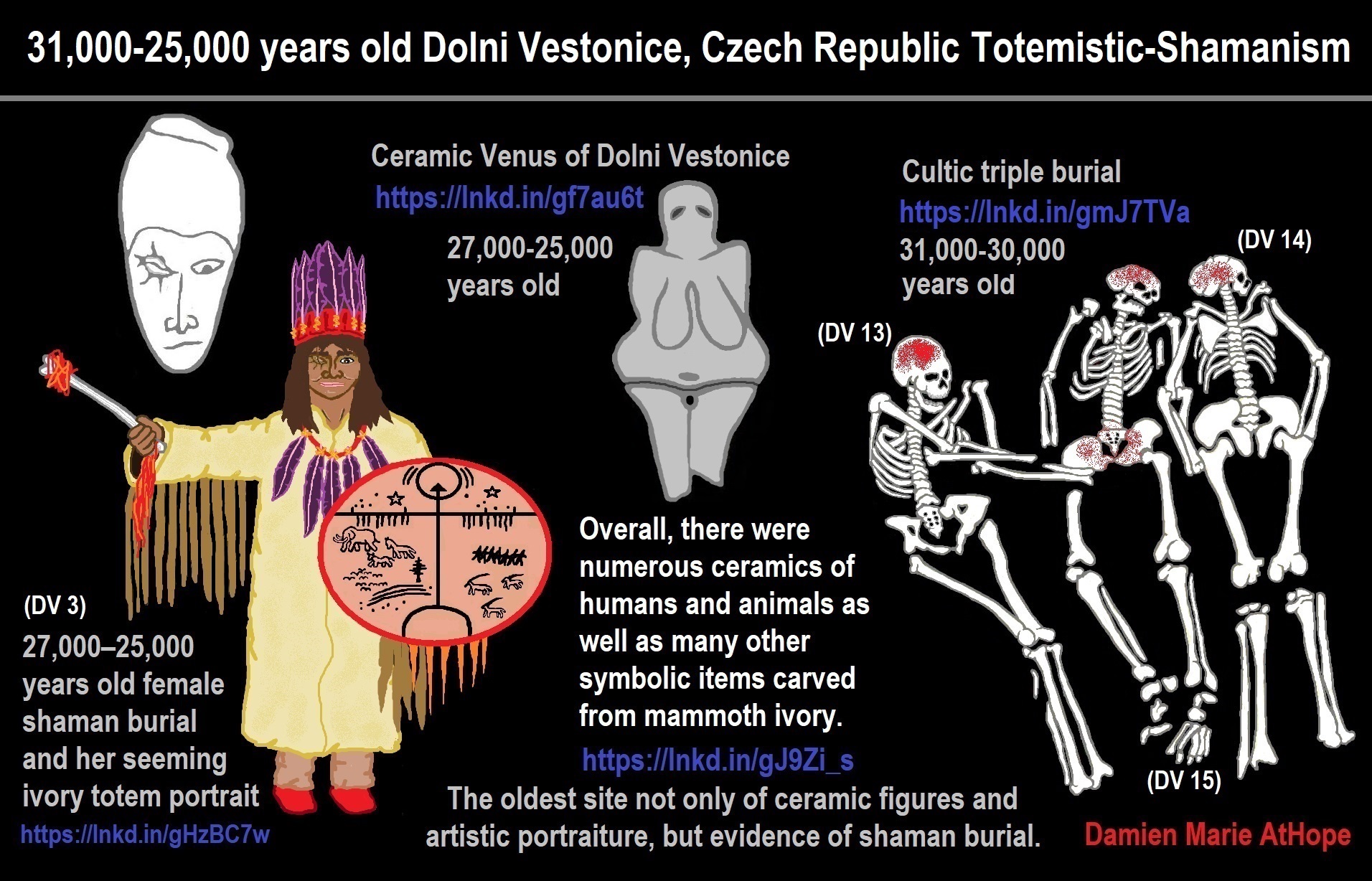
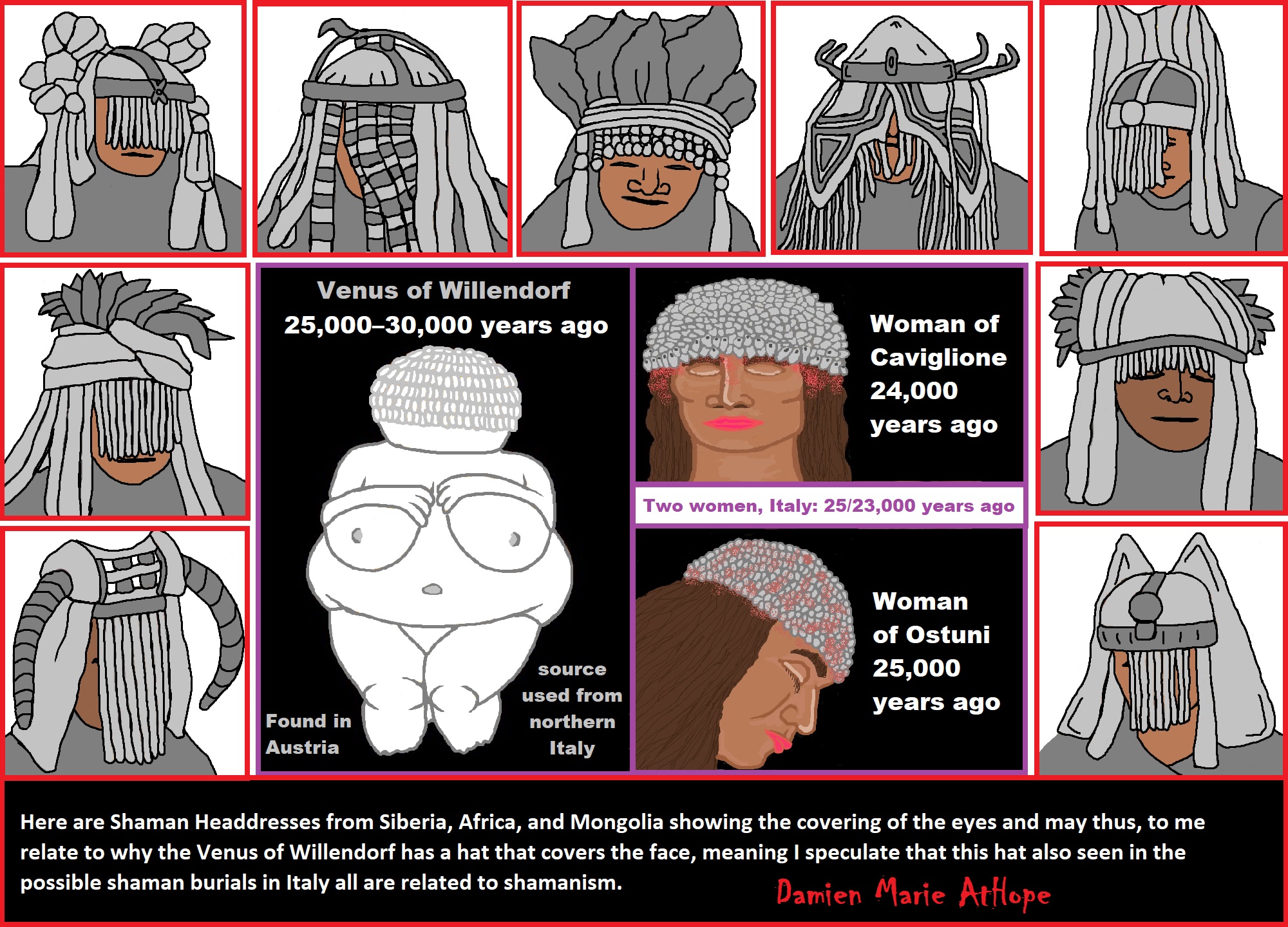
Here are Shaman Headdresses from Siberia, Africa, and Mongolia showing the covering of the eyes and may thus, to me relate to why the Venus of Willendorf has a hat that covers the face, meaning I speculate that this hat, also seen in the possible shaman burials in Italy all are related to shamanism.
“Venus figurines have been unearthed in Europe, Siberia, and much of Eurasia. Most date from the Gravettian period but start in the Aurignacian era, and lasts to the Magdalenian time.” ref
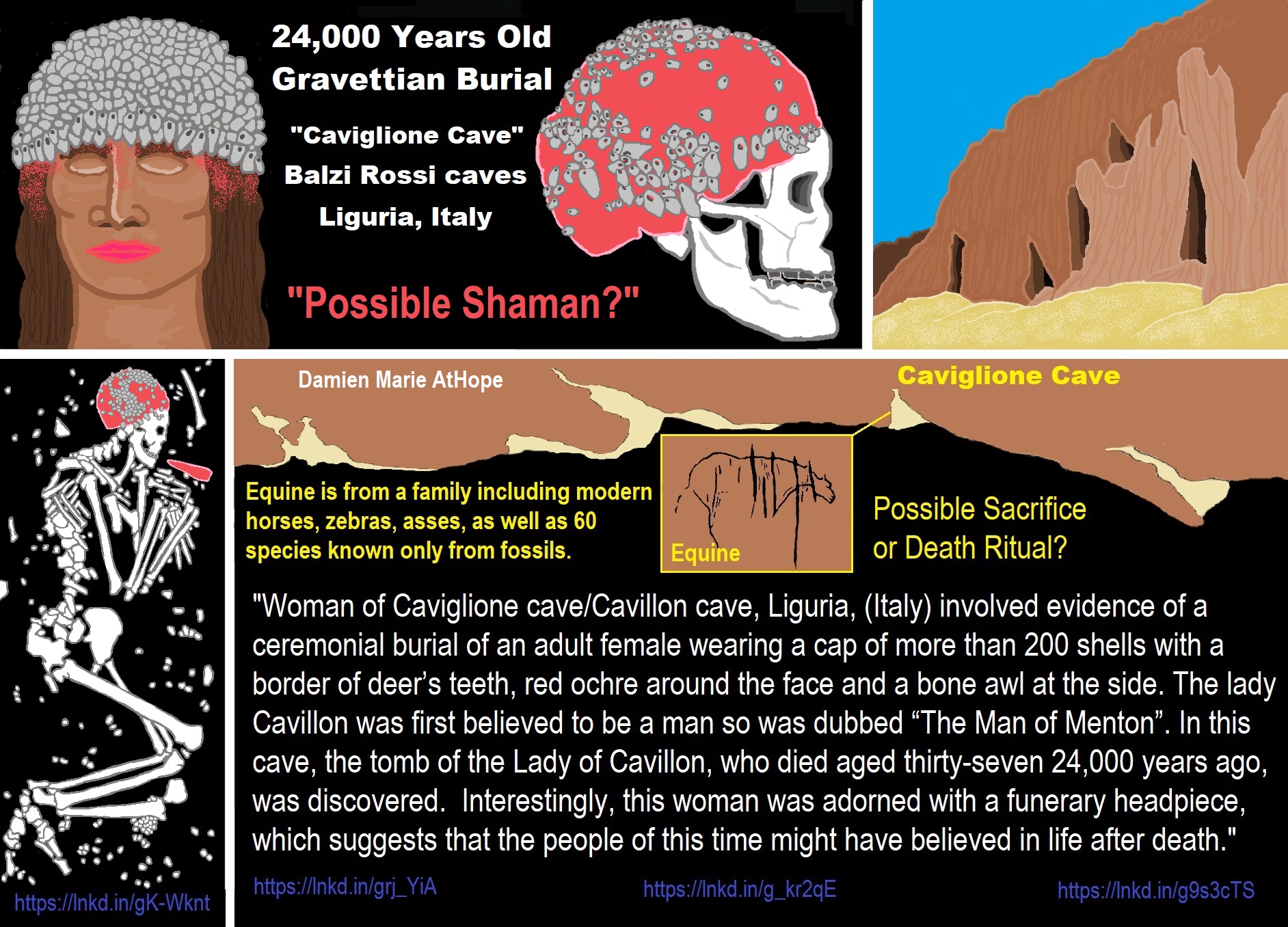
“Woman of Caviglione cave/Cavillon cave, Liguria, (Italy) involved evidence of a ceremonial burial of an adult female wearing a cap of more than 200 shells with a border of deer’s teeth, red ochre around the face, and a bone awl at the side. The lady Cavillon was first believed to be a man so was dubbed “The Man of Menton”. In this cave, the tomb of the Lady of Cavillon, who died aged thirty-seven 24,000 years ago, was discovered. Interestingly, this woman was adorned with a funerary headpiece, which suggests that the people of this time might have believed in life after death.” Ref, Ref, Ref, Ref
“The single burial, discovered in the cave of Caviglione held a woman and a possible shaman wearing a seeming headgear of shells and deer teeth. The body was covered with red ocher, buried on her left side, facing west, with the hands close to his face and legs folded.” ref
“She had been encased in an external coating of red hematite –armor that prevents the soft tissues from rotting away. The colored corpse is telling us, “I remain among you”. She had to have been buried in this place as a memorial. Burial at a predetermined depth formed a bed in the sandy clay soil that prevented predators from attacking her. She had to continue to be the fountainhead of their energies, the key to providing evidence of an organized colony. The ceremony was performed after the body ornaments had been placed in position; the death of the Lady was a great challenge to face. Examining the funerary practices and the rich cultural assemblages that provided the ornaments of the Lady who was discovered in the Cavillon cave.” ref
“Burial practices during the time of anatomically-modern humans (AMH) at Balzi Rossi have provided a number of well-preserved human remains. This burial record, coinciding in archaeological, environmental, and chronological contexts, allows the study of past hunters of animals that roamed the area, at that time unflooded, in front of the cliffs. The preponderance and relative abundances of ornamental and nutritive marine shells collected in the caves vary over time. The Gravettian layer, precisely defined by the AMH, dates probably from when the sea level was declining, and the vertebrate fauna present in the shallow cavity of the Riparo Mochi shelter, located between the Cavillon and Florestano caves in the Balzi Rossi. Researchers think that it was a site for shellfish collection, but the industrial assemblage consists of typical hunting and day-to-day items. The landscape beneath was, according to the archaeologists, a rich habitat. All foragers have broad-spectrum diet. However, the caves of the site with evidence of 15 well-preserved buried skeletons and their artwork, which encompassed both geometric and schematic style and a figurative image of a horse, are unique. In addition, small stylized figurines representing human females were found there.” ref
“Evidence from the Cavillon cave, where the red Lady was buried, tells that the burial took place during the Gravettian time, and demonstrates the technical skills of the phase. The CroMagnons, like the Neanderthals, were seasonally-nomadic; however, the diversity of the resources exploited within the territory along the Grimaldi sea coast suggests a longer-term site within which a complex symbolic culture developed. The ornaments of the Lady, like the beaded cap and bracelet, are made from shells and other materials such as red-deer canines (‘pearl teeth’ of Cervus elaphus). However, the presence of a shell-bead accumulation, closely tied to the deposition of stone artifacts and terrestrial resources, allows us to deduce that ornament usage was not confined to their graves. Furthermore, the contextual burial of the Red Lady, with variously arranged stones and a red pigment-coated animal bone, sited where a horse is engraved on the wall, indicates that the Cavillon grotto was a sanctuary cave.” ref
“Gravettian burial of Caviglione 1 is dated to around 24,000 years ago (or 22,400–26,700 years ago). The grave of the specimen named “Dame du Cavillon” (in French), initially “l’Homme de Menton”, was found in the “Grotte du Cavillon”, near the French-Italian border. The Italian term “Caviglione” is used instead of Cavillon. This cave is located in the Baousse Rousse (Balzi Rossi) complex of caves in Italy, known as the caves of Menton, and also called “Grottes de Grimaldi.” ref
“The Upper Paleolithic Caviglione 1, held a radial fracture and the asymmetrical development of the upper and lower limbs. Nevertheless, the radial fracture is defined as the result of a violent blow, during such an event, the fracture does not involve the radius. Based on the mechanical properties of bone and the concept of bone functional adaptation, diaphyseal cross-sectional geometries offer an in-depth approach to structural changes induced by functional activity. For Neanderthals and Upper Paleolithic populations, two relatively well-known prehistoric populations, trauma can modify the initial bone (functional) asymmetry and render functional interpretations particularly difficult.” ref
“Although trabecular bone analysis is currently little used for prehistoric periods, possibilities for discussing such questions is illustrated by results from primate and human studies that demonstrate a relationship between trabecular structure and function. This is the consequence of the mechanical properties of trabecular bone, strongly correlated with trabecular bone structure. Trabecular bone is more responsive to changes in mechanical loads and more metabolically active than cortical bone.” ref
“Investigations on Caviglione 1 and generate significant new results pertaining to the nature and etiology of the upper limb trauma and the after-effects upon bone mechanical properties. The ultimate aim of this study is to discern how trauma affected the manual behavior of this Upper Paleolithic female during her lifetime and the impact on her living conditions and activities.” ref
“Firstly, the internal structure of the radial trauma is described and its location facilitates a reevaluation of the violence hypothesis. Secondly, the asymmetry is measured along the diaphysis of the humerus, radius, and ulna (and some comments about the clavicle, metacarpal, and hand phalanx), including cross-sectional geometry properties (CSG) and bone trabecular fraction (TF).” ref
“These latter allow us to specify the level and pattern of asymmetry and their relationship to traumatic events (i.e., identify the most affected region and its severity). Unexpected asymmetry and abnormalities in bone size and structure in relation to non-pathological bones anchors our conclusion. As far as possible, asymmetry was compared with an Upper Paleolithic reference sample and an etiologic hypothesis is proposed. Thirdly, the robusticity index of the upper limb of Caviglione 1 is combined with previous data to discuss the impact of trauma on the reduction of function (e.g., a high index of robustness would indicate a good recovery of manipulative functions).” ref
“Finally, abnormalities in Caviglione 1 are placed in the Upper Paleolithic context for a more comprehensive understanding of the adaptability of past populations to their environment. Two lesions can be observed directly, one obvious major lesion in the left radius and probably a second minor one in the right humerus. We also discuss indirect evidence of trauma that is not directly visible, as only its consequences on bone structure can be studied.” ref
“Asymmetry in head trabecular bone density and diaphyseal bone cortical porosity in the Caviglione humerus. The head cross-sections and the diaphyseal cross-sections are located respectively at 98% and 65% of the biomechanical length. Humeral asymmetry of the total area is low in Caviglione at 35% and 65%, even in relation to females. On the other hand, in reference to the comparative sample, Caviglione shows very high asymmetry in the cortical area and relative cortical area, noticeably higher than females.” ref
“For Caviglione, no other bone trauma can be interpreted in terms of interpersonal violence (e.g., cranial injury). The parry fracture reflects a particularly problematic interpretation of trauma, which requires (for a rigorous interpretation) extensive information relative to the general context, notably the social context. The Caviglione fracture is more consistent with a Galeazzi fracture, which occurs in the weakest mechanical region (i.e., near the limit of the middle and the distal thirds of the shaft, according to cross-sectional properties. More relevant is the fact that a fracture from a direct blow does not generate a spiral fracture, as observed in the radius of Caviglione. The kind of fracture found in Caviglione is more likely due to a twisting of the forearm combined with strong compressions, such as in a fall onto the palm of the hand.” ref
“The helicoidal fracture of the left radius is a good case for successful healing, as observed here, considering the large consolidation surface. Thus, fracture reduction followed by immobilization seems the correct interpretation, as proposed in modern medicine for young individuals. However, in the present case, the third distal radius part was not reduced (i.e., there was no realignment of fragments). Due to the lack of anatomical reduction, there is still an angulation between bone fragments, resulting in a rotatory disorder. Currently, the traditional treatment of Galeazzi fractures is good in young individuals, while it is 92% unsatisfactory in adults and requires surgical treatment.” ref
“Non-surgical treatment would be the cause of persistent dislocation or recurrent dislocation of the distal ulna. Here, the homogeneity and thickness of the cortical bone along the diaphysis, the quality of the bone callus, and the high bone fraction of the epiphyseal trabecular bone resulted in the good consolidation of this bone and a “normal” level of activity of the forearm after consolidation. No evidence of secondary effects of the radial fracture is noted in other bones (i.e., humerus and ulna), except for the distal asymmetry of the ulna. This ulna asymmetry can be due to recurrent dislocations during a lifetime or a dislocation resulting from a fall. Finally, while pronation-supination movements were probably painful for one or two months (time required for consolidation), this traumatic event would probably not have had any significant consequences on the level of habitual manipulative behavior during the more recent life of this individual.” ref
“Research suggests that Caviglione was a right-dominant female and results suggest that Caviglione became left-handed. This female was probably fully engaged in a high level of manipulative behavior and right-dominant before the traumatic event in view of the pattern of asymmetry of the total area and the cortical area (relative to the Upper Paleolithic sample). Finally, the robusticity of the Caviglione female is moderate to high compared to other, mainly male Upper Paleolithic remains, for the left humerus and the left ulna. This could point to a high level of manipulative behavior after the two traumas, even if it is difficult to distinguish to what extent robusticity is due to a compensatory effect related to the immobilization of the right arm and normal levels of left arm activity.” ref
“Health generally during the Upper Paleolithic, especially during the early period (40,000–20,000 years ago), associated with a high degree of mobility. Only rare Upper Paleolithic remains were affected by limb pathologies, whether they resulted directly or indirectly from trauma. Only two early Upper Paleolithic individuals (>20 kya) exhibit fractures of the upper limb and another indicates bone modification as a secondary consequence of trauma. Dolní Věstonice 15 and Caviglione 1 respectively present a healed ulna fracture and a healed radial fracture, described in depth in this study. Barma Grande 2 shows high humeral asymmetry without direct evidence of lesion.” ref
“However, it has been argued that a pathological origin is based on the degree of asymmetry in pathological fossils (Dolní Věstonice 15, Oberkassel 1, Neanderthal 1, La Quina 5) and non-pathological recent human samples. The impact of injuries on the health and activities of human foragers is one way of understanding the adaptability of past populations to their environment. Previously, the congenitally abnormal Dolní Věstonice 15, with its severe upper limb osteoarthritis and its lower limb hypertrophy (very similar to early and middle Upper Paleolithic), showed the capacity to survive and a high level of manual activity and mobility despite significant pathology.” ref
“The late Epigravettian Arene Candide 2 also reflects this propensity to live with a debilitating trauma (i.e., bilateral absence of the lesser trochanter could be the result of severe muscular stress. The Gravettian Caviglione 1 presents two bones, from the left and right arm, clearly affected by trauma. It also, therefore, demonstrates the adaptability of an Upper Paleolithic individual. Indeed, the left radial fracture is well consolidated, and this left arm became the dominant arm because of a trauma seriously affecting the right arm. In addition, the robustness and the cortical thickness of the left long bones reveals the full use of the left arm despite some problems with fine motor control. This group did not practice fracture reduction, but we cannot know whether or not this was due to a lack of medical knowledge or individual circumstances of this specific case.” ref
“Balzi Rossi is a popular prehistoric site due to the significant findings. It’s a few metres from shore at the bottom of a red limestone wall with caves and grottos. From these caves have been recovered manufacturers made of bones and stone, fireplaces, burials and animal remains dating from Lower Paleolithic to latest Prehistory.” ref
“The Balzi Rossi complex, also known as Grimaldi Caves, includes more than ten sites that yielded abundant archaeological remains spanning a wide chronological range from the Middle Pleistocene to the Early Holocene. Riparo Mochi is located between Grotta di Florestano and Grotta del Caviglione.” ref
“The several burials, are of the Cro-Magnon type or European early modern humans, Epigravettian (like the children highlighted by Rivière and the female skeleton discovered in the upper layers of the children’s cave), and Gravettian as well as Aurignacian.” ref
“European early modern humans (EEMH) in the context of the Upper Paleolithic in Europe refers to the early presence of anatomically modern humans in Europe. The term “early modern” is usually taken to include fossils of the Bohunician, Ahmarian, Aurignacian, Gravettian, Solutrean and Magdalenian, extending throughout the Last Glacial Maximum (LGM), covering the period of roughly 48,000 to 15,000 years ago, usually referred to as the Cro-Magnon. The earliest sites in Europe dated 48,000 years ago are Riparo Mochi (Italy), Geissenklösterle (Germany), and Isturitz (France).” ref
“The archaeological sites of the Balzi Rossi complex: 1 Grotta Costantini; 2 Grotta dei Fanciulli; 3 Riparo Lorenzi; 4 Grotta di Florestano; 5 Riparo Mochi; 6 Riparo Blanc – Cardini; 7 Grotta del Caviglione; 8 Riparo Bombrini; 9 Barma Grande; 10 Barma da Baousso da Torre; 11 Grotta del Principe; 12 Sito dell’ex Casinò; 13 Sito dell’ ex Birreria.” ref
“Coming from the edge you run into the Caves of Conte Costantini and the Cave of the children which are so-called due to the grave of two children dating from Upper Paleolithic (between 35.000 and 10.000 years ago) which was found inside. Then you come across Riparo Lorenzi, the Cave of Caviglione, Bombrini’ s Cove, and Barma Grande where in 19th century they found a grave containing the remains of three bodies, one adult and two children, also dating from Upper Paleolithic.” ref
“Grave and corpses were covered by red ochre powder and their heads crowned with shells, fish bones, and teeth of stag. Three large knives of flint were found within the burial equipment, which were usually produced at more than 100 Km from the site in the area of Vaucluse which means that early hunters-collectors used to move around a lot. At last, a fragment of the pelvis of a woman of Homo erectus who lived 230.000 years ago was found into the cyclopic Grotta del Principe. There still are many drawings dating from Upper Paleolithic carved on some sections of the walls inside the caves, such as the silhouette of a horse in Grotta del Caviglione.” ref
Rock engraving representing an equine – Grotta del Caviglione. ref
Equine is from a family including modern horses, zebras, asses, as well as 60 species known only from fossils. ref
Could it be a possible sacrifice or death ritual?
“The wall drawing is thus in full daylight and framing of the figure against the backdrop of the whole field gives the site its individual character. The practical intelligence of these prehistoric people is demonstrated mainly by the tools, the choice of area in which to live, and by site management. For Cro-magnon at Cavillone it is demonstrated also by the choice of engraving tools. The extreme delicacy of the horse design and the safe working technique in the handling of chisels to trace its outline, provide evidence of a developed artistic sense. The outline of the horse creates a concrete symbol — a primitive lower form of abstraction, which was necessary; for otherwise most people would not have understood the message.” ref
“The key focus of Cro-magnon is fully integrated into the animal world, and the additional abstract signs formed by striations should not be confused with geometrical decorations. They emphasize the individualized nature of that horse, which is ‘a genuine semantic system’ designed to establish a communication. The language present within the Cavillon cave may be considered as of magical nature, thereby offering an added level of interpretation to the meaning of the image. The hieroglyphic writing on Egyptian temple walls were readable, but people were sometimes not aware of an additional, magical, obscure meaning intended for the priests. Furthermore, the dead Lady and her resting place needed protection.” ref
“The very concept of drawing is one of the remarkable traits that are characteristic of CroMagnon. They invented a language of signs and figures. The ‘vocabulary’ of Palaeolithic art conveys ideas to communicate allegorical forms. The striations associated with animals are a concrete image necessary to be understood. This consistent pattern of revealing information of a shared cognitive representation shaped during the Palaeolithic period was lost with the evolution of mind –cognitive organization in individuals being the primary locus of culture. Certainly the special mortuary rites according to the Red Lady in the Cavillon cave certainly played an important role in their society. Based on the rock engravings in the Cavillon cave, this paper identified Cro-Magnon as being the creator of illustrated stories. The audible language of Cro-Magnon is formed by these testimonials. The components manifest themselves, they are mystics. Obviously, the language and reality are related, but through their metaphorical character.” ref
“The dates for the earliest Aurignacian layers are 37,400 and 27,230 years ago for the recent ones. This latter date may represent the beginning of the Gravettian occupation. The osteological analyses on the large fauna from the Mousterian levels of Riparo Mochi (Layer I), carried out on the remains, determined that ungulates represented the most frequent species (mainly red deer, wild boar, horse, and ibex) dominating the assemblage with 93% of the identified specimens, in contrast to carnivores (including bear, lion, panther, wolf, and hyena). Alces have been recognized only in the lower part of the deposit, while Dama dama was recovered in the upper portion. Therefore Layer I is in general characterized by a cold climate with a shift to milder conditions toward the top of the deposit. In general, large carnivores are almost absent in all layers and carnivore gnawed bones are rare as well, suggesting that faunal remains had been accumulated almost exclusively by humans.” ref
“The analysis involved a total of more than 55,000 macromammal remains from the “old excavations” (1938, 1941e42, and 1959) carried out by A.C. Blanc and L. Cardini in the Gravettian layer “D” of Riparo Mochi. To date, there are no radiometric dates for this layer, which is about 2 m thick. Therefore, on the basis of the sedimentology of the deposit and of the descriptions reported in the excavation journals, the layer has been divided into 5 “phases” in order to identify possible variations in the osteological sample. A total of 18 genera belonging to 5 mammal orders (insectivores, rodents, lagomorphs, carnivores, and artiodactyls) have been identified. Almost all the identified species are characterized by few remains (E. europaeus, Carnivora, S. scrofa, A. alces, B. primigenius,) and only C. elaphus, C. ibex, C. capreolus, and O. cuniculus exceed a hundred specimens. In general, the faunal spectrum indicated mainly a forest environment, with conifers and deciduous trees, characterized by a temperate, tending to cool, climate.” ref
“Such type of ecosystem alternated with moments when the upper limit of the forest left space to the Alpine prairie, with colder temperatures and dry climate (mainly in the central phase of layer D), or times when the forest cover was thicker, with climatic conditions that were always temperate-cool, but more humid (phases I and II). However, in all periods, there is a contemporaneous presence of temperate and forest fauna (red deer, wild boar, roe deer, well adaptable also to more harsh temperatures) that probably lived in the immediate surroundings of the site, together with “cold” and open habitat species (ibex, chamois, marmot) that were present in mountain areas above the tree line. These habitats were well connected to the shelter, considering the orography of the area characterized by long and narrow valleys rapidly ascending to very high elevations.” ref
“The shelter, very close to the sea, in an area protected by high cliffs, had favorable climatic conditions even during the rigors of the winter. It is possible to note some differences in faunal composition between the osteological sample from level D. The materials recovered during the excavations show a reduced number of identified species, especially among the carnivores with the complete absence of felines, mustelids, and bear, while for the ungulates wild boar and elk were not identified. Furthermore, also the ratios between the identified species are different: red deer represents half of the sample and is quantitatively followed by roe deer and then by ibex, so that the author suggests relatively mild climatic conditions during this occupation period.” ref
“However, the discordant results obtained from the analyses of these two assemblages are probably mainly related to differences in sample size. The taphonomic analysis does not show great differences among the various phases: the whole sample presents the same kind of fragmentation and “bad” preservation of the bone surfaces. The modifications recorded on the bones allow the hypothesis that humans were the main agent of bone accumulation and that they occupied the site seasonally, lighting fires always in the same area in front of the shelter, where also butchery of hunted animals occurred, using then the bone waste and/or food debris as fuel. The specimens, besides suffering heavy modifications due to the action of fire, underwent pedogenetic transformations, especially chemical and physical ones, as well as sudden changes in humidity and temperature both before and after burial.” ref
“In general, no relevant differences in subsistence strategies have been noted among the various phases, and during the whole Gravettian occupation hunting focused mainly on red deer and ibex. Definitive evidence of exploitation has been detected also on roe deer, chamois, aurochs, and, among the carnivores, on fox, wildcat, and lynx. These latter were captured mainly for their fur, as supported by the prevalence of skinning traces recovered on distal limb elements and on cranial bones, although it is not possible to rule out that also their meat was exploited. From the analysis of the skeletal elements of red deer and ibex two hypotheses on carcass processing are plausible, even in the same phase and on the same animal, on the basis of variables that are difficult to verify (distance from the kill site, number of people in the hunting party, weight of the prey, and quantity of hunted animals).” ref
“The first hypothesizes that the complete carcasses of these artiodactyls were introduced in the site where all the butchering phases occurred (form skinning to marrow exploitation). The second suggests that a first selection of the carcasses occurred at the kill site and then only the portions with higher nutritional return were transported to the shelter. From the few bone elements recovered, it is difficult to outline models of carcass treatment for the other artiodactyls. It is possible that roe deer and chamois, on which traces produced by lithic tools have also been detected, have been treated similarly to red deer and ibex.” ref
“Using the data on the age at death of the juvenile animals for each species and phase, it is possible to hypothesize that humans occupied the shelter on a seasonal basis, mainly in spring. It is also probable that the settlement choices changed in relation to the climatic conditions. As shown in Table 5, during the earliest Gravettian phases (Base-layer D and phase IV) it seems that the site was occupied more during the winter-spring season. The rockshelter, thanks to its geographic location, was an optimal place to overcome the probable winter climatic harshness. Occasional presence during this period also occurred in summer and late autumn. In the remaining phases of this layer and mainly in the final moments of the Gravettian with Noailles burins, site occupation seems to be concentrated during the spring-summer period and only occasionally in the late winter.” ref
“A comparison with the nearby cave of the Arene Candide, based mainly on the faunal composition, indicates that the two sites reflect different occupation profiles, although the faunal associations outline a relatively similar ecological situation. The earliest Gravettian levels of the Arene Candide (P13-P9) have dates referred to the period between the Kesselt and Tursac interstadial (P13 ¼ 25,620 years ago and P12 ¼ 23,450 years ago) which may be correlated to the medio-basal phases of the Gravettian layer D at Riparo Mochi. At the Arene Candide, in the lower levels, there is a marked prevalence of carnivores (hyena, leopard, cave bear) that used the cave as a shelter and den, while the site was only occasionally used by humans, mainly in the summer-autumn period, hunting animals of all age classes. Only in the P8eP1 levels, with more recent Gravettian dates (20,470 to 18,560 years ago), there seems to be an intensification in human frequentation of the cave, with the same seasonal occupation. More comprehensive and exhaustive comparisons with the Arene Candide and with other Italian sites with Gravettian levels will be possible when the new numerical dates, at the moment still in progress, will be available for layer D of Riparo Mochi.” ref
“The study of the faunal sample related to the Gravettian occupation at Riparo Mochi demonstrated small environmental changes during the period of the deposition of the sediments, with a colder phase in the central part of the deposit followed by a more humid one in the terminal part. The faunal remains are mainly the result of human activity, as indicated by the presence of butchering traces, the abundant burned bones used as fuel, and the type of fragmentation, associated to the almost complete absence of carnivore traces. Hunting focused mainly on red deer and ibex, but roe deer, chamois, aurochs, and some carnivores, such as fox, wildcat, and lynx also were exploited. Different capture strategies were adopted: a more opportunistic hunting without prevalence of a particular age class or sex was used for red deer, while a more selective one focusing on adult individuals was employed for ibex. The rock-shelter was occupied mainly between winter and spring in the oldest phases and between spring and summer in the most recent ones, with probable abandonment during autumn.” ref
The Balzi Rossi caves (Ligurian: baussi rossi “red rocks”) in Ventimiglia commune, Liguria, Italy, is one of the most important archaeological sites of the early Upper Paleolithic in Western Europe.
- Riparo Mochi remains, evidence for the earliest presence of modern humans in Europe (early Aurignacian, 42,000 years ago).
- Grimaldi Man (Gravettian, c. 25,000 years)
- Venus figurines of Balzi Rossi (Gravettian, c. 22,000 years). ref
“A large number of statuettes portraying a woman connected to the cult of Mother Goddess were found as well, the so-called “Venus figurines.” ref
My Thought on the Evolution of Gods?
Animal protector deities from old totems/spirit animal beliefs come first to me, 13,000/12,000 years ago, then women as deities 11,000/10,000 years ago, then male gods around 7,000/8,000 years ago. Moralistic gods around 5,000/4,000 years ago, and monotheistic gods around 4,000/3,000 years ago.
Grimaldi figurines. The fourteen Grimaldi statuettes described by White et Bisson (1998):
1. The Couple, or the Double Venus
2. Woman with the perforated neck
3. The Two-Headed Woman
4. The yellow steatite statuette, or the Venus of Menton
5. Pulcinella or the Venus of Polichinelle
6. Brown Ivory Figurine
7. The Venus el Rombo, or Venus de Losange, (the diamond, or rhomboid, or lozenge shaped venus)
8. The Bust
9. The ivory figurine in red ochre
10. The flattened figure
11 The Negroid head
12. The Hermaphrodite
13. The Woman with goitre
14. Undescribed figure ref
20,000 years ago – “In the Grotta dei Fanciulli at the Balzi Rossi complex, instead, the bodies of two children aged between 2 and 3 years were found. The skeletons are arranged next to each other and at the level of the hip and femur many pierced marine shells ( Nassa neritea ) have been found that probably were part of a funerary ornament.” ref
“The triple burial, consisting of three skeletons found in the large Barma, holding an adult male, a young man and a teenager are arranged in parallel in the same trench from east to west, and buried with a rich grave outfit including seashells, flint blades and deer canines; the dating of the burial dates to about 20,000 years ago.” ref
“Also characteristic is the Triple Burial, in which three individuals were buried in the same pit, one next to the other, sprinkled with red ocher and with a rich funerary outfit. It seems that of the three two are younger, while the third is considerably older. The same anatomical peculiarities found on the right side of the frontal bone of all three skulls suggest a genetic relationship between individuals. The oldest individual was about six feet high and possessed a skeletal structure of considerable strength. The funeral outfit was instead made up of large stone blades, necklaces, spines of fish, canines of deer, pendants in ivory decorated with hollow lines and perforated shells (still Nassa neritea ).” ref
“Detail of the funeral kit of the Triple Burial, and among the various discoveries, the most interesting and recent is that of the discovery of the so-called Negroids of Grimaldi, or a couple of individuals (a teenager and an adult woman) having somatic traits different from those of other individuals. The adolescent had his head adorned with marine shells ( Nassa neritea ), and the woman had the same shells near her wrist and left elbow, perhaps originally bracelets. The burials took place at two different times.” ref
“All the burials can be dated back to the period called Gravettian or Epigravettian, a temporal gap from 29,000 to 19,000 years ago.” ref
“Detail of the funeral kit of the Triple Burial, and among the various discoveries, the most interesting and recent is that of the discovery of the so-called Negroids of Grimaldi , or a couple of individuals (a teenager and an adult woman) having somatic traits different from those of other individuals. The adolescent had his head adorned with marine shells ( Nassa neritea ), and the woman had the same shells near her wrist and left elbow, perhaps originally bracelets. The burials took place at two different times.” ref
“Many burials have been updated at Balzi Rossi or Grimaldi Caves (Liguria, Italy). 1. A woman (left) and a teenager (right) buried successively Dated 26,000 BP – Grotto of Children (Grimaldi). 2. Woman strewn with imperforated shells Dated 12 200 BP Grotto of Children (Grimaldi). 3. Grand Cro-Magnon, arms folded over the bust and hands on the upper chest Dated – 26,000 years Grotto of Children (Grimaldi).” ref
Shamanism (such as that seen in Siberia Gravettian culture: 30,000 years ago). Gravettian culture (34,000–24,000 years ago; Western Gravettian, mainly France, Spain, and Britain, as well as Eastern Gravettian in Central Europe and Russia. The eastern Gravettians, which include the Pavlovian culture). And, the Pavlovian culture (31,000 – 25,000 years ago such as in Austria and Poland). 31,000 – 20,000 years ago Oldest Shaman was Female, Buried with the Oldest Portrait Carving.
Shamanism is approximately a 30,000-year-old belief system and believe in spirit-filled life and/or afterlife that can be attached to or be expressed in things or objects and these objects can be used by special persons or in special rituals that can connect to spirit-filled life and/or afterlife. If you believe like this, regardless of your faith, you are a hidden shamanist.
Around 29,000 to 25,000 years ago in Dolní Vestonice, Czech Republic, the oldest human face representation is a carved ivory female head that was found nearby a female burial and belong to the Pavlovian culture, a variant of the Gravettian culture. The left side of the figure’s face was a distorted image and is believed to be a portrait of an elder female, who was around 40 years old. She was ritualistically placed beneath a pair of mammoth scapulae, one leaning against the other. Surprisingly, the left side of the skull was disfigured in the same manner as the aforementioned carved ivory figure, indicating that the figure was an intentional depiction of this specific individual. The bones and the earth surrounding the body contained traces of red ocher, a flint spearhead had been placed near the skull, and one hand held the body of a fox. This evidence suggests that this was the burial site of a shaman. This is the oldest site not only of ceramic figurines and artistic portraiture but also of evidence of early female shamans. Before 5,500 years ago, women were much more prominent in religion.
Archaeologists usually describe two regional variants: the western Gravettian, known namely from cave sites in France, Spain, and Britain, and the eastern Gravettian in Central Europe and Russia. The eastern Gravettians include the Pavlovian culture, which were specialized mammoth hunters and whose remains are usually found not in caves but in open air sites. The origins of the Gravettian people are not clear, they seem to appear simultaneously all over Europe. Though they carried distinct genetic signatures, the Gravettians and Aurignacians before them were descended from the same ancient founder population. According to genetic data, 37,000 years ago, all Europeans can be traced back to a single ‘founding population’ that made it through the last ice age. Furthermore, the so-called founding fathers were part of the Aurignacian culture, which was displaced by another group of early humans members of the Gravettian culture. Between 37,000 years ago and 14,000 years ago, different groups of Europeans were descended from a single founder population. To a greater extent than their Aurignacian predecessors, they are known for their Venus figurines. ref, ref, ref, ref, ref, ref, ref, ref, ref, ref, & ref
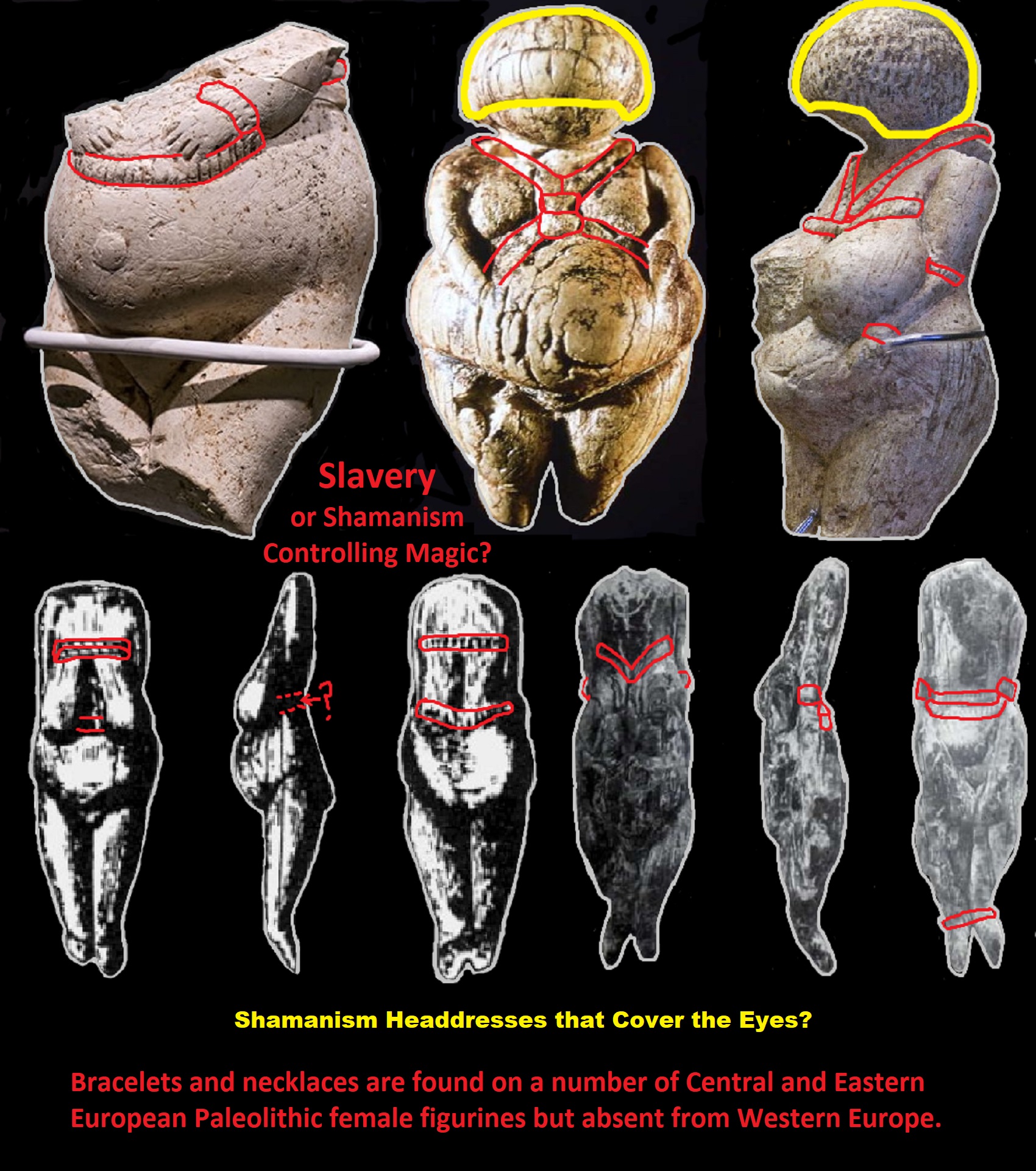
Slavery or Shamanism Controlling Magic, or Both?
“Bracelets and necklaces are found on a number of Central and Eastern European Paleolithic female figurines but absent from Western Europe.” ref
Venus figures from the Kostenki – Borshevo: link
“The Venus figurines of Kostenki are prehistoric representations of the female body, usually in ivory and usually dated to between 25,000 and 20,000 years ago, making them part of the Gravettian industry of the Upper Palaeolithic period. Found in the Kostyonki-Borshchyovo archeological complex in Russia.” ref
“Kostenki is a very important Paleolithic site on the Don River in Russia. It was a settlement which contained venus figures, dwellings made of mammoth bones, and many flint tools and bone implements. Kostenki / Kostienki is not actually a single site but really an area on the right bank of the Don River in the regions of the villages of Kostenki and Borshevo, consisting of more than twenty site locations, all dating to the Paleolithic.” ref
“The Kostyonki–Borshchyovo archaeological complex is an area where numerous Upper Paleolithic archaeological sites have been found, located around the villages of Kostyonki (also Kostenki) and Borshchyovo (also Borshchevo). The area is found on the western (right) bank of the Don River in Khokholsky District, Voronezh Oblast, Russia, some 25 km south of the city of Voronezh. The 26 Paleolithic sites of the area are numbered Kostenki 1–21 and Borshchevo 1–5. It is known for its high concentration of cultural remains of anatomically modern humans from the beginning of the Upper Paleolithic era, before 40,000 years ago. Finds are on exhibit in situ, at the State Archaeological Museum–Reserve Kostyonki built atop the mammoth bone circle Kostenki 11. Kostyonki is considered as belonging to the Aurignacian culture.” ref
“Kostenki-1/2 (site Kostenki-1, layer 2), Kostenki-1/3, Kostenki-6 (Streletskaya), Kostenki-11 and Kostenki 12/3 below the volcanic CI tephra layer are associated to the nontransitional local “Strelets culture”, analogous to early Upper Paleolithic cultures from central and western Europe such as the Szeletian culture. This initial cultural development might be attributable to local Neanderthals. Ornaments predating the volcanic eruption, found at Kostenki 17/2 (“Spitsyn culture”, 38–32 ka), were apparently perforated by a hand-operated rotary drill or drills; these may suggest that the population was technologically capable of preparing for a volcanic winter. Just above the ash layer sewing needles were found. Kostenki 1/1, Kostenki 4/2, Kostyonki 8/2 and Kostenki 21/3 belong to the eastern Gravettian (24 to 22 ka). Kostenki 2, Kostenki 3, Kostenki 11-1a and Kostenki-19 belong to the Zamyatino culture (22 to 17 ka). Kostenki 8/2 (Telmanskaya) is eponymous of “Telman culture.”As of 2016, archaeological work is done at Kostenki-14 (Markina Gora), Kostenki-6 (Streletskaya), Kostenki-15 (Gorodtsovskaya), Kostenki-16 (Ugljanka), Kostenki-17 (Spitsynskaya) and Kostenki-21 (Gmelinskaya).” ref
“Some of the earliest directly dated human remains from this site are dated to 32,600 ± 1,100 14C years and consist of a tibia and a fibula, with traits classifying the bones as European early modern humans. In 2009, DNA was extracted from the remains of a male hunter-gatherer from Kostenki-12 who lived circa around 30,000 years ago and died aged 20–25. His maternal lineage was found to be mtDNA haplogroup U2. He was buried in an oval pit in a crouched position and covered with red ochre. Kostenki 12 was later found to belong to the patrilineal Y-DNA haplogroup C1* (C-F3393).” ref
“A male from Kostenki-14 (Markina Gora), who lived approximately 38,700–36,200 year ago, was also found to belong to mtDNA haplogroup U2. His Y-DNA haplogroup was C1b* (C-F1370). The Kostenki-14 genome represents early evidence for the separation of Europeans and East Asian lineages. It was found to have a close relationship to both “Mal’ta boy” (24 ka) of south-east Siberia (Ancient North Eurasian) and to the later Mesolithic hunter-gatherers of Europe and western Siberia, as well as with a basal population ancestral to Early European Farmers, but not to East Asians. Yang et al. 2020 found that the early hunter-gatherers lineage of Kostenski-14 may have contributed (c. 68%) ancestry to the Ancient North Eurasian Yana and Mal’ta samples, with the remainder ancestry (c. 32%) being contributed from an East-Eurasian Tianyuan-related population. Kostenki-14 had some level of ancient Neanderthal admixture, which has been dated as going back to circa around 54,000 years ago.” ref
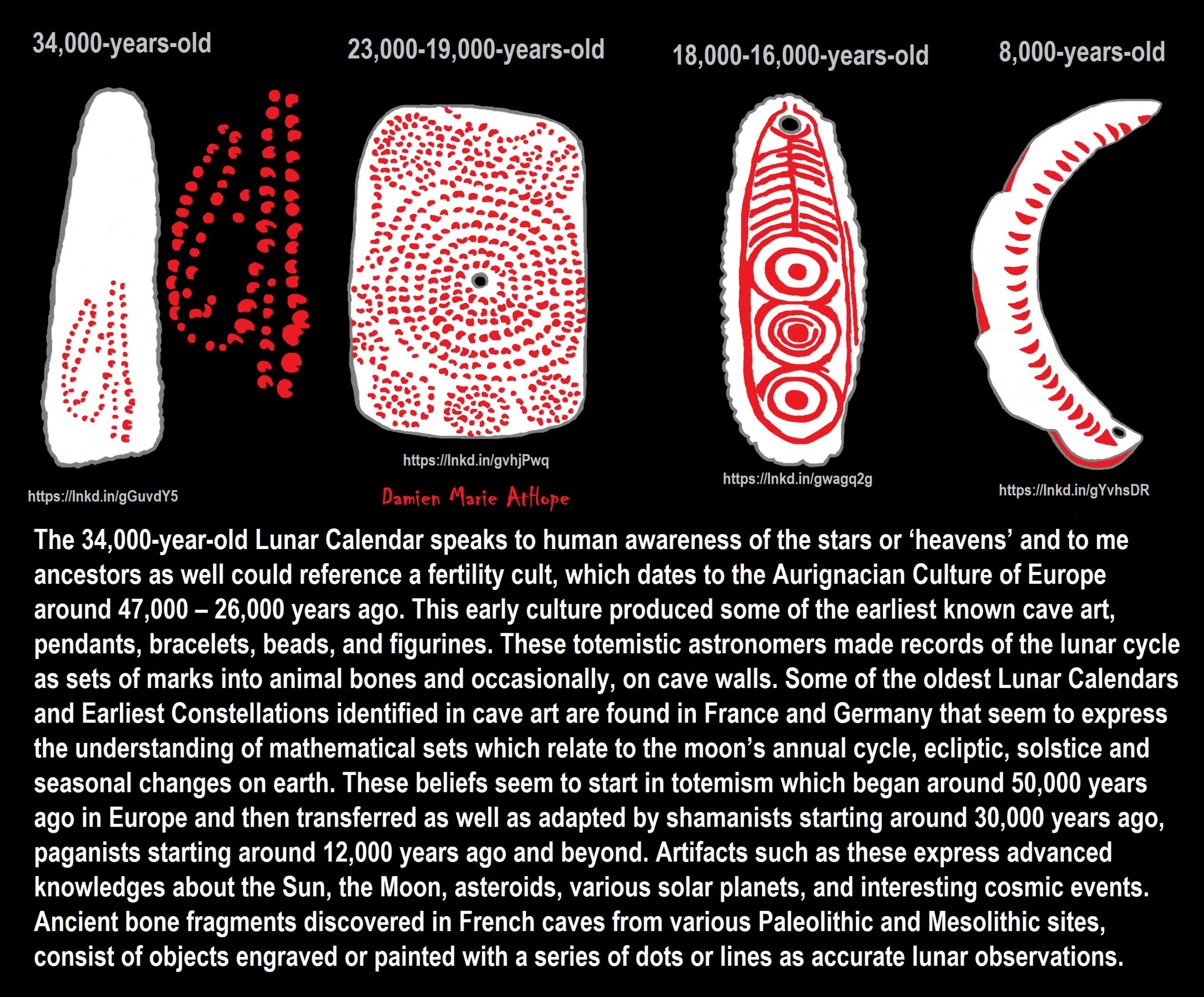
34,000 years ago Lunar Calendar Cave art around the Time Shift From Totemism to Early Shamanism?
“The Oldest Lunar Calendars and Earliest Constellations have been identified in cave art found in France and Germany. The astronomer-priests of these late Upper Paleolithic Cultures understood mathematical sets, and the interplay between the moon annual cycle, ecliptic, solstice and seasonal changes on earth. The archaeological record’s earliest data that speaks to human awareness of the stars and ‘heavens’ dates to the Aurignacian Culture of Europe, around 34,000 years ago. Between 1964 and the early 1990s, Alexander Marshack published breakthrough research that documented the mathematical and astronomical knowledge in the Late Upper Paleolithic Cultures of Europe. Marshack deciphered sets of marks carved into animal bones, and occasionally on the walls of caves, as records of the lunar cycle. These marks are sets of crescents or lines. Artisans carefully controlled line thickness so that a correlation with lunar phases would be as easy as possible to perceive. Sets of marks were often laid out in a serpentine pattern that suggests a snake deity or streams and rivers. Many of these lunar calendars were made on small pieces of stone, bone or antler so that they could be easily carried. These small, portable, lightweight lunar calendars were easily carried on extended journeys such as long hunting trips and seasonal migrations.” ref
“Hunting the largest animals was arduous, and might require hunters to follow herds of horses, bison, mammoth or ibex for many weeks. (Other big animals such as the auroch, cave bear and cave lion were well known but rarely hunted for food because they had a special status in the mythic realm. The Auroch is very important to the search for earliest constellations.) The phases of the moon depicted in these sets of marks are inexact. Precision was impossible unless all nights were perfectly clear which is an unrealistic expectation. The arithmetic counting skill implied by these small lunar calendars is obvious. The recognition that there are phases of the moon and seasons of the year that can be counted – that should be counted because they are important – is profound. “All animal activities are time factored, simply because time passes, the future is forever arriving. The reality of time factoring is objective physics and does not depend upon human awareness or consciousness. Until Marshack’s work, many archeologists believed the sets of marks he chose to study were nothing but the aimless doodles of bored toolmakers. What Marshack uncovered is the intuitive discovery of mathematical sets and the application of those sets to the construction of a calendar.” Bone is the preferred medium because it allows for easy transport and a long calendar lifetime. Mankind’s earliest astronomy brought the clan into the multi-dimensional universe of the gods. Objects used in the most potent rituals had the highest contextual, cultural value and were treated with great reverence.” ref
“Regarding the Aurignacian, between 43,000 and 35,000 years ago, the archaeological record from habitations is relatively poor in the Ardèche (Abri des Pécheurs, Grotte du Figuier) while appearing more abundant in the Languedoc (La Salpétrière, La Balauzière, Esquicho-Grapaou, La Laouza etc.). The same applies to the sites of the early phases of the Gravettian. During climatic fluctuations, and unlike the deep caves such as Chauvet, the porch and shelter fills seem to have better recorded the cold episodes than the humid phases. To date, 20 decorated caves are indexed in the gorges of the Ardèche and nearby; in other words as far as the valley of the Gardon (Baume-Latrone). This group includes several important caves (Ebbou, Oulen, Émilie etc.) which are not precisely dated and were judged to be of secondary importance until the discovery of the Chauvet Cave.” ref
“A 10,000-year-old engraved stone could be a lunar calendar. The rare pebble — found high up in the mountains near Rome, Italy, the hammer-stone was found on top of Monte Alta in the Alban Hills. It’s believed that our early ancestors would’ve used the stone to keep track of the moon’s cycles. Notches were engraved “as if they were being used to count, calculate or store the record of some kind of information. And these notches — which total either 27 or 28 — suggest the stone’s engraver used the pebble to track lunar cycles.” ref
“Archaeologists excavating in Scotland found a series of huge pits were dug by Mesolithic people to track the cycle of the Moon. They found a series of twelve huge, specially shaped pits designed to mimic the various phases of the Moon. The holes aligned perfectly on the midwinter solstice to help the hunter-gathers of Mesolithic Britain keep precise track of the passage of the seasons and the lunar cycle. The holes were dug in the shapes of various phases of the moon. “Waxing, waning, crescents, and gibbous, they’re all there and arranged in a 50-meter-long (164-foot) arc. The one representing the full moon is large and circular, approximately two meters (roughly seven feet) across, and placed right in the center. And this arc is arranged perfectly with a notch in the landscape where the sun would have risen on the day of the midwinter solstice about 10,000 years ago. Placing their calendar in the landscape the way they did would have let the people who built it to recalibrate the lunar months every winter to bring their lunar calendar in line with the solar year. This means that any effort to keep track of the seasons using the moon alone will slowly drift ever further from true. An observer needs to know when to add or subtract an extra month to make good the time or hit the reset button and start counting again.” ref
“A moon-shaped calendar was found in Smederevska Palanka, Serbia that dates back 8,000 years, and is made from a wild boar’s tusk engraved with markings to denote a lunar cycle. Farmers may have used the device to plan when to plant crops. It is made from the tusk of a wild boar and is marked with engravings thought to denote a lunar cycle of 28 days, as well as the four phases of the moon.” ref
“A lunisolar calendar was found at Warren Field in Scotland and has been dated to c. 8000 BCE, during the Mesolithic period. Some scholars argue for lunar calendars still earlier—Rappenglück in the marks on a c. 17,000-year-old cave painting at Lascaux and Marshack in the marks on a c. 27,000-year-old bone baton—but their findings remain controversial. Scholars have argued that ancient hunters conducted regular astronomical observations of the Moon back in the Upper Palaeolithic. Samuel L. Macey dates the earliest uses of the Moon as a time-measuring device back to 28,000–30,000 years ago.” ref
“A lunar calendar is a calendar based on the monthly cycles of the Moon‘s phases (synodic months, lunations), in contrast to solar calendars, whose annual cycles are based only directly on the solar year. The most commonly used calendar, the Gregorian calendar, is a solar calendar system that originally evolved out of a lunar calendar system. A purely lunar calendar is also distinguished from a lunisolar calendar, whose lunar months are brought into alignment with the solar year through some process of intercalation. The details of when months begin varies from calendar to calendar, with some using new, full, or crescent moons and others employing detailed calculations.” ref
“Since each lunation is approximately 29+1⁄2 days, it is common for the months of a lunar calendar to alternate between 29 and 30 days. Since the period of 12 such lunations, a lunar year, is 354 days, 8 hours, 48 minutes, 34 seconds (354.36707 days), purely lunar calendars are 11 to 12 days shorter than the solar year. In purely lunar calendars, which do not make use of intercalation, like the Islamic calendar, the lunar months cycle through all the seasons of a solar year over the course of a 33–34 lunar-year cycle.” ref
“Although the Gregorian calendar is in common and legal use in most countries, traditional lunar and lunisolar calendars continue to be used throughout the world to determine religious festivals and national holidays. Such holidays include Rosh Hashanah (Hebrew calendar); Easter (the Computus); the Chinese, Korean, Vietnamese, and Mongolian New Year (Chinese, Korean, Vietnamese, and Mongolian calendars, respectively); the Nepali New Year (Nepali calendar); the Mid-Autumn Festival and Chuseok (Chinese and Korean calendars); Loi Krathong (Thai calendar); Sunuwar calendar; Vesak/Buddha’s Birthday (Buddhist calendar); Diwali (Hindu calendars); Ramadan, Eid al-Fitr and Eid al-Adha (Islamic calendar).” ref
“The Japanese Calendar formerly used both the lunar and lunisolar calendar before it was replaced by the Gregorian Calendar during the Meiji government in 1872. Holidays such as the Japanese New Year were simply transposed on top as opposed to being calculated like other countries that use the lunisolar and Gregorian calendars together, for example, the Japanese New Year now falls on January 1, creating a month delay as opposed to other East Asian Countries. See customary issues in modern Japan.” ref
“Most calendars referred to as “lunar” calendars are in fact lunisolar calendars. Their months are based on observations of the lunar cycle, with intercalation being used to bring them into general agreement with the solar year. The solar “civic calendar” that was used in ancient Egypt showed traces of its origin in the earlier lunar calendar, which continued to be used alongside it for religious and agricultural purposes. Present-day lunisolar calendars include the Chinese, Vietnamese, Hindu, and Thai calendars.” ref
“Synodic months are 29 or 30 days in length, making a lunar year of 12 months about 11 to 12 days shorter than a solar year. Some lunar calendars do not use intercalation, for example, the lunar Hijri calendar used by most Muslims. For those that do, such as the Hebrew calendar, and Buddhist Calendars in Myanmar, the most common form of intercalation is to add an additional month every second or third year. Some lunisolar calendars are also calibrated by annual natural events which are affected by lunar cycles as well as the solar cycle. An example of this is the lunar calendar of the Banks Islands, which includes three months in which the edible palolo worms mass on the beaches. These events occur at the last quarter of the lunar month, as the reproductive cycle of the palolos is synchronized with the moon.” ref
“Lunar and lunisolar calendars differ as to which day is the first day of the month. In some lunisolar calendars, such as the Chinese calendar, the first day of a month is the day when an astronomical new moon occurs in a particular time zone. In others, such as some Hindu calendars, each month begins on the day after the full moon. Others are based on the first sighting of the lunar crescent, such as the lunar Hijri calendar (and, historically, the Hebrew calendar).” ref

ref, ref, ref, ref, ref, ref, ref, ref, ref, ref, ref, ref
“Aurignacian (43,000 to 26,000 years ago), Gravettian (33,000 to 21,000 years ago), Magdalenian (17,000 to 12,000 years ago), and Sami (Haplogroup N Y-DNA) at least by 3,500 years ago until the fifteenth century) were all nomadic peoples of Ancient Europe. N1c correlates closely with the distribution of the Finno-Ugrian languages. The Sami languages are thought to have split from their common ancestor about 3300 years ago.” ref, ref
“Mitochondrial DNA studies of Sami people, haplogroup U5 are consistent with multiple migrations to Scandinavia from Volga-Ural region, starting 6,000 to 7,000 years before present.” ref
“Nearly half of all Sami and one-fifth of Finnish maternal lineages belong to U5. U5 arrived in Europe with the Gravettian and appears to have been a major maternal lineage among the Paleolithic European hunter-gatherers and even the dominant lineage during the European Mesolithic at more than 80%. Among 16 Gravettian samples, six belonged to U5.” ref
“U5b1b1 arose approximately 10,000 years ago, over two millennia after the end of the Last Glaciation, when the Neolithic Revolution was already underway in the Near East. Despite this relatively young age, U5b1b1 is found scattered across all of Europe and well beyond its boundaries. The Saami, who live in the far European North and have 48% of U5 and 42% of V lineages, belong exclusively to the U5b1b1 subclade. Amazingly, the Berbers of Northwest Africa also possess that U5b1b1 subclade and haplogroup V. How could two peoples separated by some 6,000 km (3,700 mi) share such close maternal ancestry? The Berbers also have other typically Western European lineages such as H1 and H3, as well as African haplogroups like M1, L1, L2, and L3. The Saami and the Berbers presumably descend from nomadic hunter-gatherers from the Franco-Cantabrian refugium who recolonized Europe and North Africa after the LGM.” ref
“The journey of U5b1b1 didn’t stop there. The Fulbe of Senegal were also found to share U5b1b1b with the Berbers, surely through intermarriages. More impressively, the Yakuts of eastern Siberia, who have a bit under 10% of European mtDNA (including haplogroups H, HV1, J, K, T, U4, U5, and W), also share the exact same deep subclade (U5b1b1a) as the Saami and the Berbers.” ref
Epigravettian
“The Epigravettian (Greek: epi “above, on top of”, and Gravettian ) was one of the last archaeological industries and cultures of the European Upper Paleolithic. It emerged after the Last Glacial Maximum around 19,050 BCE or around 21,050 years ago, and is considered to be a cultural derivative of the Gravettian culture. Three subphases, the Early Epigravettian (20,000 to 16,000 years ago), the Evolved Epigravettian (16,000 to 14,000 years ago), and the Final Epigravettian (14,000 to 8,000 years ago), have been established, which were further subdivided and reclassified. In this sense, the Epigravettian is simply the Gravettian after ~21,000 years ago, when the Solutrean had replaced the Gravettian in most of France and Spain.” ref
“Several Epigravettian cultural centers have developed contemporaneously after 22,000 years years ago in Europe. These range across southern, central, and most of eastern Europe, including south-western France, Italy, Southeast Europe, the Caucasus, Ukraine, and Western Russia to the banks of the Volga River. Its lithic complex was first documented at numerous sites in Italy. Great geographical and local variability of the facies is present, however, all sites are characterized by the predominance of microliths, such as backed blades, backed points, and bladelets with retouched ends. The Epigravettian is the last stage of the Upper Paleolithic succeeded by Mesolithic cultures after 10,000 years ago.” ref
“In a genetic study published in Nature in May 2016, the remains of an Epigravettian male from Ripari Villabruna in Italy were examined. He carried the paternal haplogroup R1b1 and the maternal haplogroup U5b . An Epigravettian from the Satsurblia Cave in Georgia , who was examined in a previous study, has been found to be carrying the paternal haplogroup J1 and the maternal haplogroup K3. In a genetic study published in Nature in March 2023, the authors found that the ancestors of the Mesolithic Western Hunter-Gatherers (WHGs) were populations associated with the Epigravettian culture, which largely replaced populations associated with the Magdalenian culture about 14,000 years ago. The Magdalenian-associated individuals descended from populations associated with the western Gravettian , Solutrean, and Aurignacian cultures.” ref
Magdalenian
“The Magdalenian cultures (also Madelenian; French: Magdalénien) are later cultures of the Upper Paleolithic and Mesolithic in western Europe. They date from around 17,000 to 12,000 years ago. It is named after the type site of La Madeleine, a rock shelter located in the Vézère valley, commune of Tursac, in France’s Dordogne department. The genes of seven Magdalenians, the El Miron Cluster in Iberia, have shown a close relationship to a population who had lived in Northern Europe some 20,000 years previously. The analyses suggested that 70-80% of the ancestry of these individuals was from the population represented by Goyet Q116-1, associated with the Aurignacian culture of about 35,000 BP, from the Goyet Caves in modern Belgium.” ref
“The three samples of Y-DNA included two samples of haplogroup I and one sample of HIJK. All samples of mtDNA belonged to U, including five samples of U8b and one sample of U5b. In a genetic study published in Nature in March 2023, the authors found that the ancestors of the WHGs were populations associated with the Epigravettian culture, which largely replaced populations associated with the Magdalenian culture about 14,000 years ago (the ancestors of the Magdalenian-associated individuals were the populations associated with the western Gravettian, Solutrean and Aurignacian cultures).” ref
“The Magdalenian epoch is associated with reindeer hunters, although Magdalenian sites contain extensive evidence for the hunting of red deer, horses, and other large mammals present in Europe toward the end of the last glacial period. The culture was geographically widespread, and later Magdalenian sites stretched from Portugal in the west to Poland in the east, and as far north as France, the Channel Islands, England, and Wales. It is the third epoch of Gabriel de Mortillet’s cave chronology system, corresponding roughly to the Late Pleistocene. Besides La Madeleine, the chief stations of the epoch are Les Eyzies, Laugerie-Basse, and Gorges d’Enfer in the Dordogne; Grotte du Placard in Charente and others in south-west France.” ref
“The Magdalenian epoch is represented by numerous sites, whose contents show progress in arts and culture. It was characterized by a cold and dry climate, humans in association with the reindeer, and the extinction of the mammoth. The use of bone and ivory as implements, begun in the preceding Solutrean epoch, increased, making the period essentially a bone period. Bone instruments are quite varied: spear-points, harpoon-heads, borers, hooks, and needles. The fauna of the Magdalenian epoch seems to have included tigers and other tropical species along with reindeer, arctic foxes, arctic hares, and other polar creatures.” ref
“The culture spans from approximately 17,000 to 12,000 years ago, toward the end of the most recent ice age. Magdalenian tool culture is characterized by regular blade industries struck from carinated cores. The Magdalenian epoch is divided into six phases generally agreed to have chronological significance (Magdalenian I through VI, I being the earliest and VI being the latest). The earliest phases are recognized by the varying proportion of blades and specific varieties of scrapers, the middle phases are marked by the emergence of a microlithic component (particularly the distinctive denticulated microliths), and the later phases by the presence of uniserial (phase 5) and biserial ‘harpoons’ (phase 6) made of bone, antler, and ivory.” ref
“Debate continues about the nature of the earliest Magdalenian assemblages, and it remains questionable whether the Badegoulian culture is the earliest phase of Magdalenian culture. Similarly, finds from the forest of Beauregard near Paris have been suggested as belonging to the earliest Magdalenian. The earliest Magdalenian sites are in France. The Epigravettian is a similar culture appearing at the same time. Its known range extends from southeast France to the western shores of the Volga River, Russia, with many sites in Italy.” ref
“The later phases of Magdalenian culture are contemporaneous with the human re-settlement of north-western Europe after the Last Glacial Maximum during the Late Glacial Maximum. As hunter-gatherers, Magdalenians did not re-settle permanently in northwest Europe, instead following herds and seasons. By the end of the Magdalenian epoch, lithic technology shows a pronounced trend toward increased microlithisation. The bone harpoons and points have the most distinctive chronological markers within the typological sequence. As well as flint tools, Magdalenians are known for their elaborate worked bone, antler, and ivory that served both functional and aesthetic purposes, including perforated batons.” ref
“The sea shells and fossils found in Magdalenian sites may be sourced to relatively precise areas and have been used to support hypotheses of Magdalenian hunter-gatherer seasonal ranges, and perhaps trade routes. In northern Spain and south-west France this tool culture was superseded by the Azilian culture. In northern Europe it was followed by variants of the Tjongerian techno-complex. It has been suggested that key Late-glacial sites in south-western Britain may be attributed to Magdalenian culture, including Kent’s Cavern.” ref
“Bones, reindeer antlers and animal teeth display pictures carved or etched on them of seals, fish, reindeer, mammoths and other creatures. The best of Magdalenian artworks are a mammoth engraved on a fragment of its own ivory; a dagger of reindeer antler, with a handle in form of a reindeer; a cave-bear cut on a flat piece of schist; a seal on a bear’s tooth; a fish drawn on a reindeer antler; and a complete picture, also on reindeer antler, showing horses, an aurochs, trees, and a snake biting a man’s leg. The man is naked, which, together with the snake, suggests a warm climate in spite of the presence of the reindeer.” ref
“In the Tuc d’Audoubert cave, an 18-inch clay statue of two bison sculpted in relief was discovered in the deepest room, now known as the Room of the Bisons. Examples of Magdalenian portable art include batons, figurines, and intricately engraved projectile points, as well as items of personal adornment including sea shells, perforated carnivore teeth (presumably necklaces), and fossils. Cave sites such as Lascaux contain the best known examples of Magdalenian cave art. The site of Altamira in Spain, with its extensive and varied forms of Magdalenian mobiliary art has been suggested to be an agglomeration site where groups of Magdalenian hunter-gatherers congregated.” ref

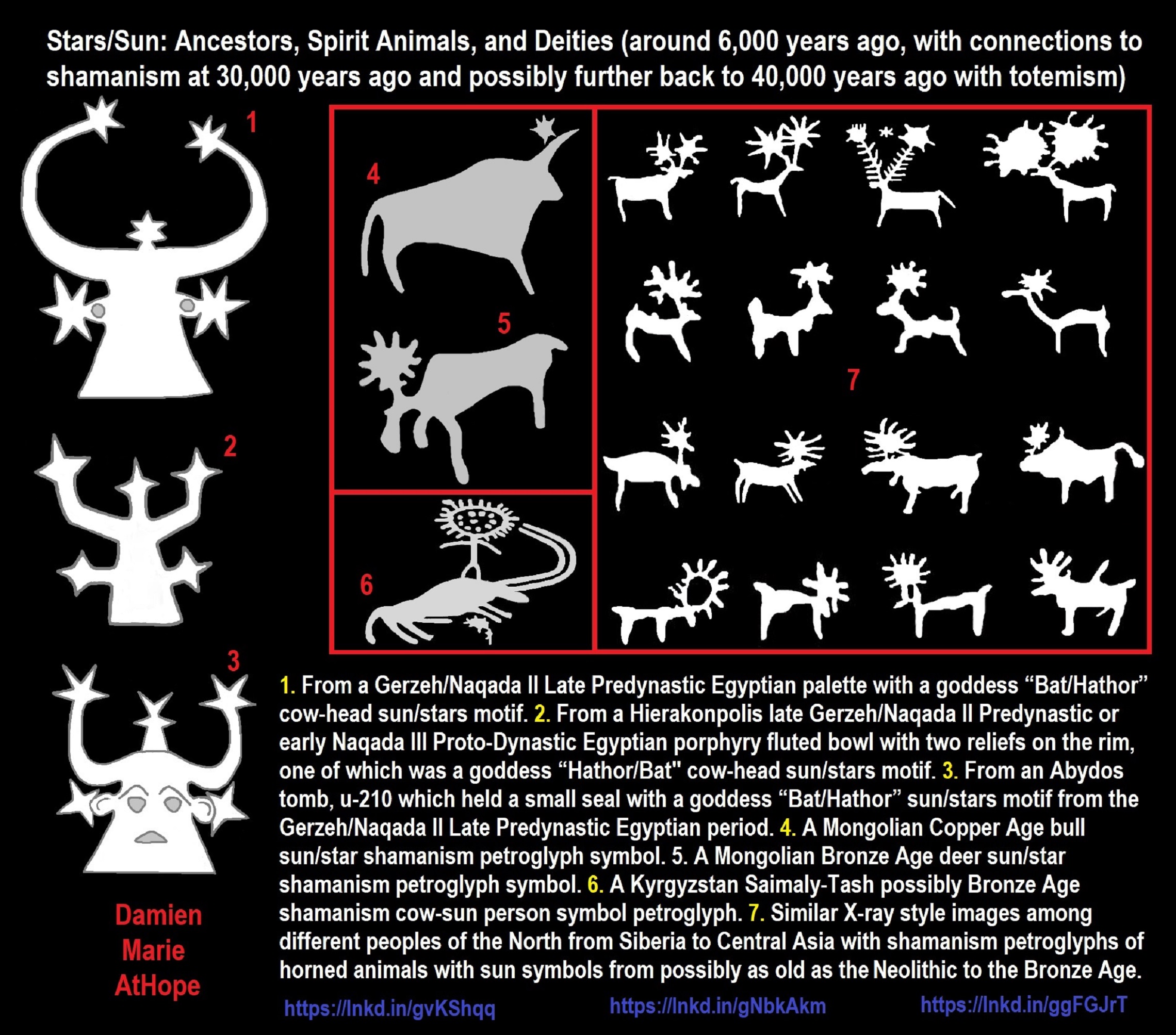
- From a Gerzeh/Naqada II Late Predynastic Egyptian palette with a goddess “Bat/Hathor” cow-head sun/stars motif.
- From a Hierakonpolis late Gerzeh/Naqada II Predynastic or early Naqada III Proto-Dynastic Egyptian porphyry fluted bowl with two reliefs on the rim, one of which was a goddess “Hathor/Bat” cow-head sun/stars motif.
- From an Abydos tomb, u-210 which held a small seal with a goddess “Bat/Hathor” sun/stars motif from the Gerzeh/Naqada II Late Predynastic Egyptian period.
- A Mongolian Copper Age bull sun/star shamanism petroglyph
- A Mongolian Bronze Age deer sun/star shamanism petroglyph symbol.
- A Kyrgyzstan Saimaly-Tash possibly Bronze Age shamanism cow-sun person symbol petroglyph.
- Similar X-ray style images among different peoples of the North from Siberia to Central Asia with shamanism petroglyphs of horned animals with sun symbols from possibly as old as the Neolithic to the Bronze Age. ref, ref, ref
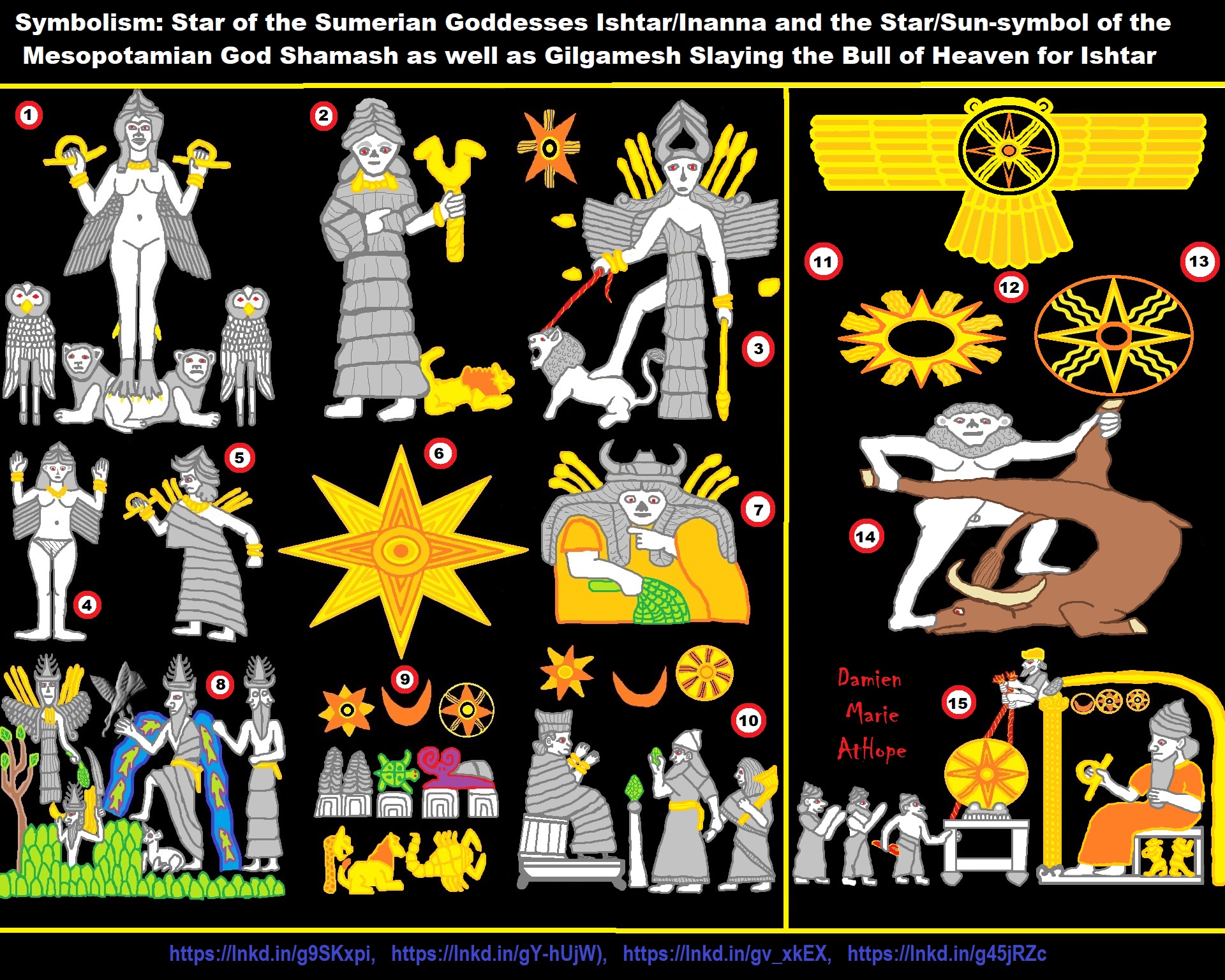
ref, ref, ref, ref, ref, ref, ref, ref, ref
Symbolism: Star of the Sumerian Goddesses Ishtar/Inanna and the Star/Sun-symbol of the Mesopotamian God Shamash as well as Gilgamesh Slaying the Bull of Heaven for Ishtar
- The “Burney Relief,” believed to represent either Ishtar or her older sister Ereshkigal (1900 or 1800 BCE)
- Babylonian relief of Ishtar from Eshnunna (early second millennium BCE)
- Akkadian cylinder seal depicting Inanna resting her foot on the back of a lion (2334 – 2154 BCE)
- Depiction of Inanna/Ishtar from the Ishtar Vase (early second millennium BCE)
- Ishtar on the Anubanini rock relief (2300-2000 BCE)
- The Star of the Sumerian goddess Inanna was her symbol and that of her East Semitic counterpart goddess Ishtar. Because Ishtar was associated with the planet Venus, the star is also known as the Star of Venus.
- From a plaque from the Sumerian temple of Inanna plaque at Nippur (2500 BCE)
- Akkadian cylinder seal with the deities Inanna, Utu, Enki, and Isimud (2300 BCE)
- 1125-1100 BCE Kudurru stone document boundary stone with an Ishtar/Inanna star as part of a sky triad shown left to right along with the god Sin crescent moon symbol and Shamash star/sun symbol.
- The star of Inanna-Ishtar alongside the star/solar disk of her brother Shamash (Sumerian Utu) and the crescent moon of her father Sin (Sumerian Nanna) on a boundary stone of Meli-Shipak II (1200 BCE)
- Star of Ishtar and Shamash
- Assyrian Democratic Movement Brand Identity (Logo)
- Star of Shamash
- Mesopotamian relief of Gilgamesh slaying the Bull of Heaven, having been sent by Ishtar in Tablet VI of the Epic of Gilgamesh after he spurns her amorous advances.


ref, ref, ref, ref, ref, ref, ref, ref
Sky Burials: Animism, Totemism, Shamanism, and Paganism
“In archaeology and anthropology, the term excarnation (also known as defleshing) refers to the practice of removing the flesh and organs of the dead before burial, leaving only the bones. Excarnation may be precipitated through natural means, involving leaving a body exposed for animals to scavenge, or it may be purposefully undertaken by butchering the corpse by hand. Practices making use of natural processes for excarnation are the Tibetan sky burial, Comanche platform burials, and traditional Zoroastrian funerals (see Tower of Silence). Some Native American groups in the southeastern portion of North America practiced deliberate excarnation in protohistoric times. Archaeologists believe that in this practice, people typically left the body exposed on a woven litter or altar.” ref
Ancient Headless Corpses Were Defleshed By Griffon Vultures
Sky burial ( Animal Worship mixed with Ancestor Worship) is a funeral practice where a human corpse is placed on a mountaintop, elevated ground, tree, or constructed perch to decompose while be eaten by scavenging animals, especially birds. This Animal Worship (or Zoolatry) rituals may go back to the Neanderthals who seem to Sacralize birds starting around 130,000 years ago in Croatia with eagle talon jewelry and oldest confirmed burial. Or possible (Aurignacian) “Bird Worship” at Hohle Fels cave, Germany, early totemism and small bird figurine at around 33,000 years old, which had been cited as evidence of shamanism.
As well as possible ‘Bird Worship’ (in the Pavlovian culture/Gravettian culture) part of Early Shamanism at Dolní Věstonice (Czech Republic) from around 31,000-25,000 years ago, which held the “first shaman burial.” The shamanistic Mal’ta–Buret’ culture of Siberia, dating to 24,000-15,000 years ago, who connect to the indigenous peoples of the Americas show Bird Worship. The Magdalenian cultures in western Europe, dating from around 17,000-12,000 years ago have a famous artistic mural with a bird that I think could relate to reincarnation and at least bird symbolism. Likewise, there is evidence of possible ‘Bird Worship’ at Göbekli Tepe (Turkey), dated to around 13,000/11,600-9,370 Years ago with “first human-made temple” and at Çatalhöyük (Turkey), dated to around 9,500-7,700 Years ago with “first religious designed city” both with seeming ancestor, animal, and possible goddess worship.
The Tibetan sky-burials appear to have evolved from ancient practices of defleshing corpses as discovered in archeological finds in the region. These practices most likely came out of practical considerations, but they could also be related to more ceremonial practices similar to the suspected sky burial evidence found at Göbekli Tepe (11,500 years ago) and Stonehenge (4,500 years ago). ref
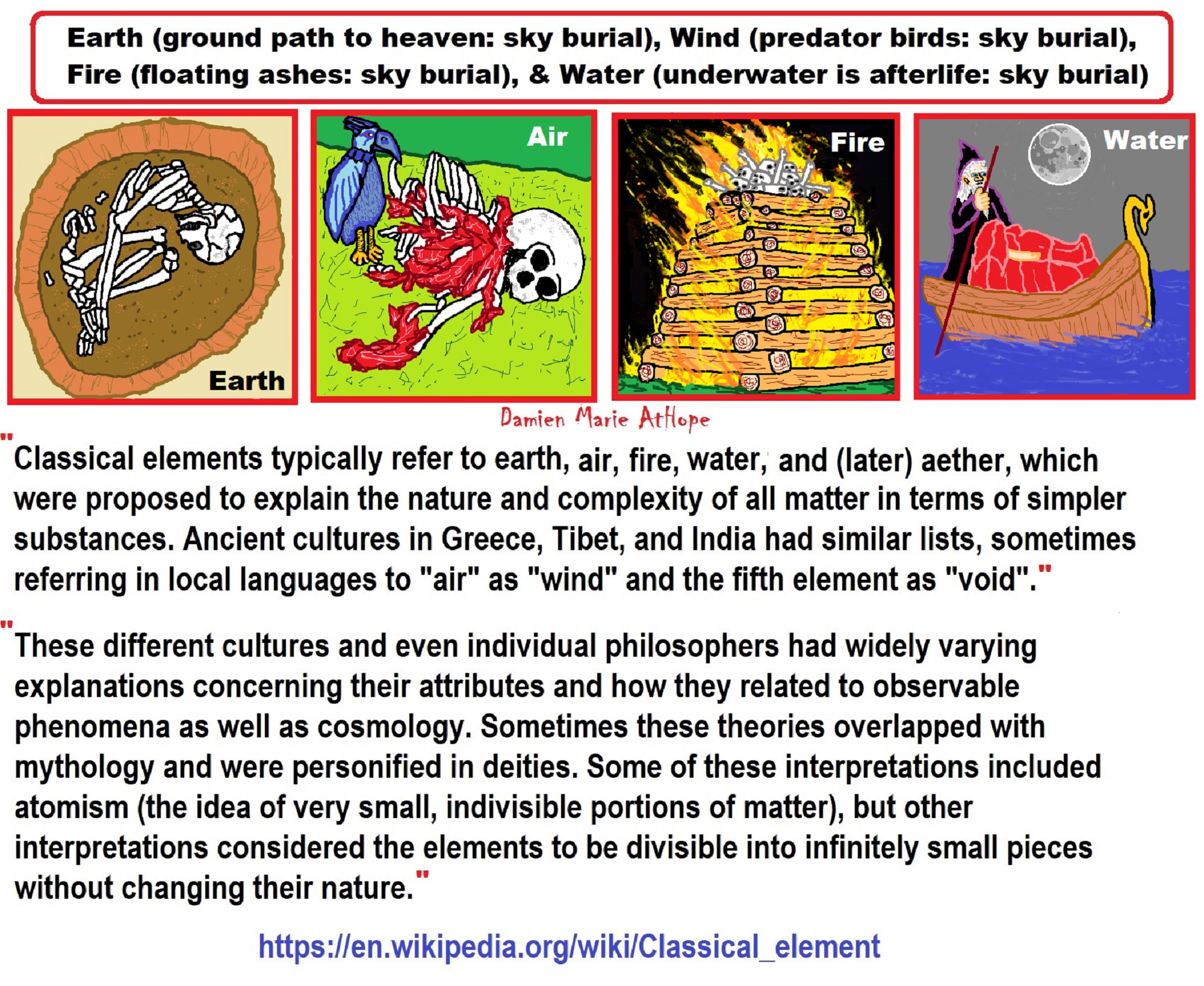
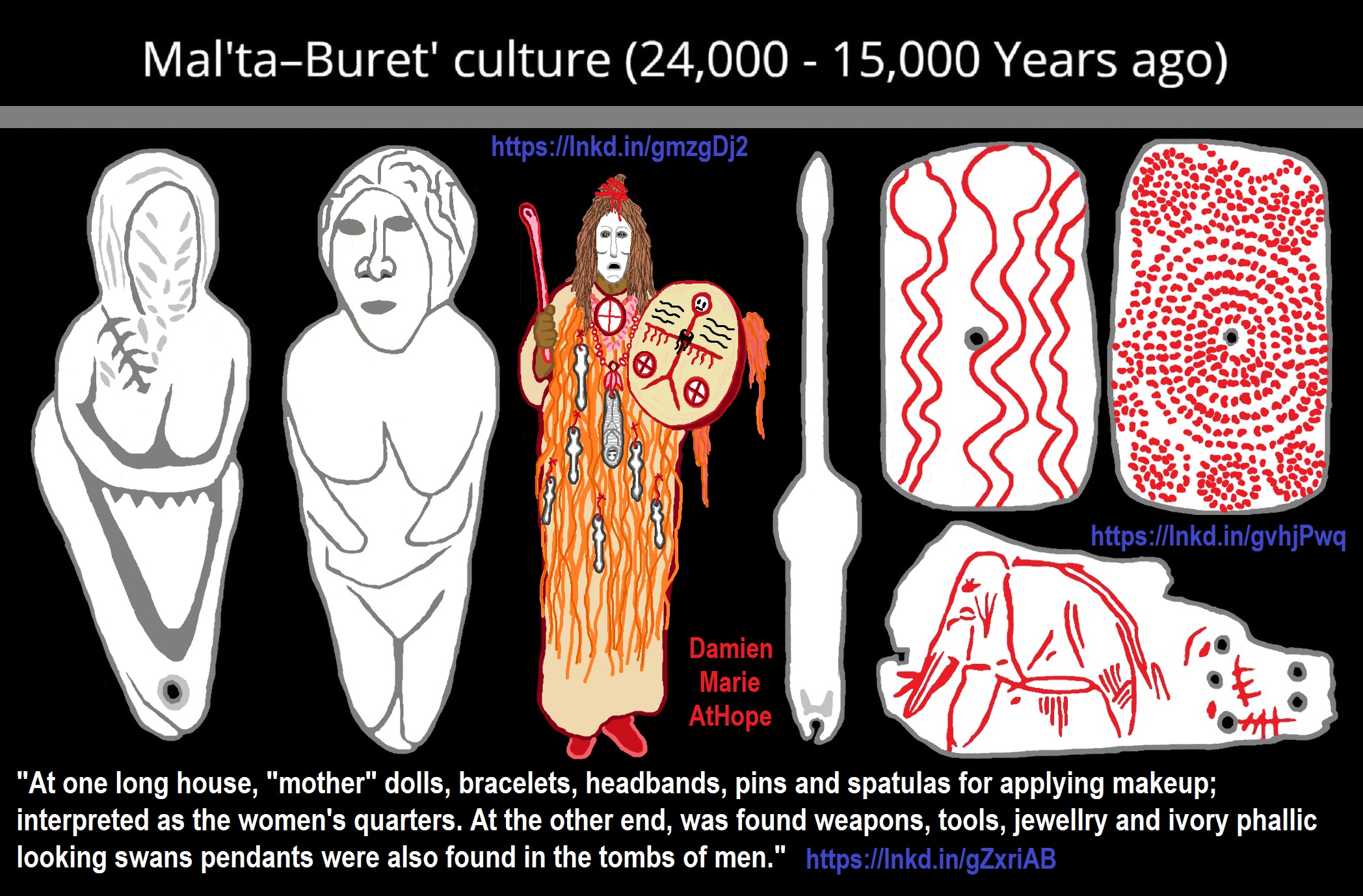

Ancient North Eurasian (ANE)
Ancient Beringian/Ancestral Native American (AB/ANA)
Eastern Hunter-Gatherer (EHG)
Western Hunter-Gatherers (WHG)
Western Steppe Herders (WSH)
Scandinavian Hunter-Gatherer (SHG)
Early European Farmers (EEF)
Jōmon people (Ainu people OF Hokkaido Island)
Neolithic Iranian farmers (Iran_N) (Iran Neolithic)
Haplogroup R possible time of origin about 27,000 years in Central Asia, South Asia, or Siberia:
- Mal’ta–Buret’ culture (24,000-15,000 years ago)
- Afontova Gora culture (21,000-12,000 years ago)
- Trialetian culture (16,000–8000 years ago)
- Samara culture (7,000-6,500 years ago)
- Khvalynsk culture (7,000-6,500 years ago)
- Afanasievo culture (5,300-4,500 years ago)
- Yamna/Yamnaya Culture (5,300-4,500 years ago)
- Andronovo culture (4,000–2,900 years ago) ref
Groups partially derived from the Ancient North Eurasians
“The ANE lineage is defined by association with the MA-1, or “Mal’ta boy”, remains of 24,000 years ago in central Siberia Mal’ta-Buret’ culture 24,000-15,000 years ago. The Ancient North Eurasians (ANE) samples (Afontova Gora 3, Mal’ta 1, and Yana-RHS) show evidence for minor gene flow from an East Asian-related group (simplified by the Amis, Han, or Tianyuan) but no evidence for ANE-related geneflow into East Asians (Amis, Han, Tianyuan), except the Ainu, of North Japan.” ref
“The ANE lineage is defined by association with the MA-1, or “Mal’ta boy”, remains of 24,000 years ago in central Siberia Mal’ta-Buret’ culture 24,000-15,000 years ago “basal to modern-day Europeans”. Some Ancient North Eurasians also carried East Asian populations, such as Tianyuan Man.” ref
“Bronze-age-steppe Yamnaya and Afanasevo cultures were ANE at around 50% and Eastern Hunter-Gatherer (EHG) at around 75% ANE. Karelia culture: Y-DNA R1a-M417 8,400 years ago, Y-DNA J, 7,200 years ago, and Samara, of Y-haplogroup R1b-P297 7,600 years ago is closely related to ANE from Afontova Gora, 18,000 years ago around the time of blond hair first seen there.” ref
Ancient North Eurasian
“In archaeogenetics, the term Ancient North Eurasian (often abbreviated as ANE) is the name given to an ancestral West Eurasian component that represents descent from the people similar to the Mal’ta–Buret’ culture and populations closely related to them, such as from Afontova Gora and the Yana Rhinoceros Horn Site. Significant ANE ancestry are found in some modern populations, including Europeans and Native Americans.” ref
“The ANE lineage is defined by association with the MA-1, or “Mal’ta boy“, the remains of an individual who lived during the Last Glacial Maximum, 24,000 years ago in central Siberia, Ancient North Eurasians are described as a lineage “which is deeply related to Paleolithic/Mesolithic hunter-gatherers in Europe,” meaning that they diverged from Paleolithic Europeans a long time ago.” ref
“The ANE population has also been described as having been “basal to modern-day Europeans” but not especially related to East Asians, and is suggested to have perhaps originated in Europe or Western Asia or the Eurasian Steppe of Central Asia. However, some samples associated with Ancient North Eurasians also carried ancestry from an ancient East Asian population, such as Tianyuan Man. Sikora et al. (2019) found that the Yana RHS sample (31,600 BP) in Northern Siberia “can be modeled as early West Eurasian with an approximately 22% contribution from early East Asians.” ref
“Populations genetically similar to MA-1 were an important genetic contributor to Native Americans, Europeans, Central Asians, South Asians, and some East Asian groups, in order of significance. Lazaridis et al. (2016:10) note “a cline of ANE ancestry across the east-west extent of Eurasia.” The ancient Bronze-age-steppe Yamnaya and Afanasevo cultures were found to have a noteworthy ANE component at ~50%.” ref
“According to Moreno-Mayar et al. 2018 between 14% and 38% of Native American ancestry may originate from gene flow from the Mal’ta–Buret’ people (ANE). This difference is caused by the penetration of posterior Siberian migrations into the Americas, with the lowest percentages of ANE ancestry found in Eskimos and Alaskan Natives, as these groups are the result of migrations into the Americas roughly 5,000 years ago.” ref
“Estimates for ANE ancestry among first wave Native Americans show higher percentages, such as 42% for those belonging to the Andean region in South America. The other gene flow in Native Americans (the remainder of their ancestry) was of East Asian origin. Gene sequencing of another south-central Siberian people (Afontova Gora-2) dating to approximately 17,000 years ago, revealed similar autosomal genetic signatures to that of Mal’ta boy-1, suggesting that the region was continuously occupied by humans throughout the Last Glacial Maximum.” ref
“The earliest known individual with a genetic mutation associated with blonde hair in modern Europeans is an Ancient North Eurasian female dating to around 16000 BCE from the Afontova Gora 3 site in Siberia. It has been suggested that their mythology may have included a narrative, found in both Indo-European and some Native American fables, in which a dog guards the path to the afterlife.” ref
“Genomic studies also indicate that the ANE component was introduced to Western Europe by people related to the Yamnaya culture, long after the Paleolithic. It is reported in modern-day Europeans (7%–25%), but not of Europeans before the Bronze Age. Additional ANE ancestry is found in European populations through paleolithic interactions with Eastern Hunter-Gatherers, which resulted in populations such as Scandinavian Hunter-Gatherers.” ref
“The Ancient North Eurasians (ANE) split from the ancestors of European peoples somewhere in the Middle East or South-central Asia, and used a northern dispersal route through Central Asia into Northern Asia and Siberia. Genetic analyses show that all ANE samples (Afontova Gora 3, Mal’ta 1, and Yana-RHS) show evidence for minor gene flow from an East Asian-related group (simplified by the Amis, Han, or Tianyuan). In contrast, no evidence for ANE-related geneflow into East Asians (Amis, Han, Tianyuan), except the Ainu, was found.” ref
“Genetic data suggests that the ANE formed during the Terminal Upper-Paleolithic (36+-1,5ka) period from a deeply European-related population, which was once widespread in Northern Eurasia, and from an early East Asian-related group, which migrated northwards into Central Asia and Siberia, merging with this deeply European-related population. These population dynamics and constant northwards geneflow of East Asian-related ancestry would later gave rise to the “Ancestral Native Americans” and Paleosiberians, which replaced the ANE as dominant population of Siberia.” ref
Groups partially derived from the Ancient North Eurasians
“Eastern Hunter-Gatherer (EHG) is a lineage derived predominantly (75%) from ANE. It is represented by two individuals from Karelia, one of Y-haplogroup R1a-M417, dated c. 8.4 kya, the other of Y-haplogroup J, dated c. 7.2 kya; and one individual from Samara, of Y-haplogroup R1b-P297, dated c. 7.6 kya. This lineage is closely related to the ANE sample from Afontova Gora, dated c. 18 kya. After the end of the Last Glacial Maximum, the Western Hunter-Gatherers (WHG) and EHG lineages merged in Eastern Europe, accounting for early presence of ANE-derived ancestry in Mesolithic Europe. Evidence suggests that as Ancient North Eurasians migrated West from Eastern Siberia, they absorbed Western Hunter-Gatherers and other West Eurasian populations as well.” ref
“Caucasian Hunter-Gatherer (CHG) is represented by the Satsurblia individual dated ~13 kya (from the Satsurblia cave in Georgia), and carried 36% ANE-derived admixture. While the rest of their ancestry is derived from the Dzudzuana cave individual dated ~26 kya, which lacked ANE-admixture, Dzudzuana affinity in the Caucasus decreased with the arrival of ANE at ~13 kya Satsurblia.” ref
“Scandinavian Hunter-Gatherer (SHG) is represented by several individuals buried at Motala, Sweden ca. 6000 BC. They were descended from Western Hunter-Gatherers who initially settled Scandinavia from the south, and later populations of EHG who entered Scandinavia from the north through the coast of Norway.” ref
“Iran Neolithic (Iran_N) individuals dated ~8.5 kya carried 50% ANE-derived admixture and 50% Dzudzuana-related admixture, marking them as different from other Near-Eastern and Anatolian Neolithics who didn’t have ANE admixture. Iran Neolithics were later replaced by Iran Chalcolithics, who were a mixture of Iran Neolithic and Near Eastern Levant Neolithic.” ref
“Ancient Beringian/Ancestral Native American are specific archaeogenetic lineages, based on the genome of an infant found at the Upward Sun River site (dubbed USR1), dated to 11,500 years ago. The AB lineage diverged from the Ancestral Native American (ANA) lineage about 20,000 years ago.” ref
“West Siberian Hunter-Gatherer (WSHG) are a specific archaeogenetic lineage, first reported in a genetic study published in Science in September 2019. WSGs were found to be of about 30% EHG ancestry, 50% ANE ancestry, and 20% to 38% East Asian ancestry.” ref
“Western Steppe Herders (WSH) is the name given to a distinct ancestral component that represents descent closely related to the Yamnaya culture of the Pontic–Caspian steppe. This ancestry is often referred to as Yamnaya ancestry or Steppe ancestry.” ref
“Late Upper Paeolithic Lake Baikal – Ust’Kyakhta-3 (UKY) 14,050-13,770 BP were mixture of 30% ANE ancestry and 70% East Asian ancestry.” ref
“Lake Baikal Holocene – Baikal Eneolithic (Baikal_EN) and Baikal Early Bronze Age (Baikal_EBA) derived 6.4% to 20.1% ancestry from ANE, while rest of their ancestry was derived from East Asians. Fofonovo_EN near by Lake Baikal were mixture of 12-17% ANE ancestry and 83-87% East Asian ancestry.” ref
“Hokkaido Jōmon people specifically refers to the Jōmon period population of Hokkaido in northernmost Japan. Though the Jōmon people themselves descended mainly from East Asian lineages, one study found an affinity between Hokkaido Jōmon with the Northern Eurasian Yana sample (an ANE-related group, related to Mal’ta), and suggest as an explanation the possibility of minor Yana gene flow into the Hokkaido Jōmon population (as well as other possibilities). A more recent study by Cooke et al. 2021, confirmed ANE-related geneflow among the Jōmon people, partially ancestral to the Ainu people. ANE ancestry among Jōmon people is estimated at 21%, however, there is a North to South cline within the Japanese archipelago, with the highest amount of ANE ancestry in Hokkaido and Tohoku.” ref

Mammoth bone dwellings are a very an early type of housing constructed by Upper Paleolithic hunter-gatherers mainly in central Europe. ref
Mammoth Bone Dwellings range from around 44,000 to 14,000 years ago, likely expressions of Cultist Culture and maybe some “Totemism” socio-religious-symbolic meanings. These ritual structures seem to have begun with Neandertals and then continued with Modern Human Hunter Gather groups like the Gravettian and connected Epi-gravettian cultures. ref
Gravettian and Epigravettian mammoth bone dwellings range from: Pavlovian (Early Gravettian of Moravia), Gagarino and Pouchkari (Gravettian of Eastern Europe), Kostienki 11/1a (Zamiatnine culture), and Mezinian. ref
The 44,000-year-old site from Molodova in eastern Ukraine was a Neanderthal “Mousterian Culture” Mammoth Bone Dwelling with possible “Totemism” connections due to how some of the bones used to build the ritual structure home had decorative carvings and added pigments. It was an incredible 26 foot wide circular building believed to be earliest bone built cultural structure and where they lived for extended periods of time. ref, ref
The 44,000-year-old Neanderthal bone structure near Molodova was constructed with 116 large deliberately selected mammoth bones including skulls, jaws, tusks and leg. Inside there was at least 25 fire pits and from the artifacts found Neanderthals made many decorated carvings in addition to the symbolic adding of ochre pigments to the bones. ref, ref
The painting in red on the front of mammoth skull may represent the flames and sparks of a fire and as bones where found burned in fire pits so there could be a ritualistic representation connection, which I think it is. It could be a prehistoric “drum” consisted of a mammoth skull, which may relate to a change from totemism to shamanism and was set at the entrance as well as contained a painted pattern of red ocher dots and lines. The top of this skull bears depressions where it seems to have been beaten by “drumsticks,” the animal long bones that were found to bear corresponding damage on their ends. It is possible that the building may have served some ritual or communal function at which the mammoth bone rhythms were beaten out, although many Ukrainian huts of a similar size seem to have been ordinary living places. ref, ref, ref
Even more telling to its ritualistic relevance is that is was found at the entrance to one of the mammoth hunter’s huts, which could also hold a vaginal/womb reference and as there was also an oddly placed signal tusk pointing in and hugging the head sticking upright out of the ground almost as if it represents a phallus entering the vaginal/womb thus fertility hunting cult suggestions as well as maybe fire worship. ref, ref
Inside the Mezherich building, there were some remarkable finds: amber ornaments and fossil shells, transported an estimated 218 to 310 miles from their source, and the remains of one of the earliest percussion instruments ever found. The middle Dnepr basin is the origin of amber is well known near Kiev where it was collected throughout the Upper Palaeolithic. Amber objects have been used as pieces of small adornment in the Upper Palaeolithic sites of the Dnepr basin: Gontsy, Dobra-nichivka, Mejiriche, Semenivka 2, Ioudinovo, Chulatovo 2, Mezine, Osokorivka (level 2), and Kaistrova balka 2 ref, ref
A spectacular prehistoric art is visible in the dwellings of the Mezinian, in the grouping in the outer wall of jaws and long bones showing a geometric pattern of lines, chevrons and zigzags, which are also figured in the painted bones of the dwellings and in the mobile art of the statuettes, tools and various artifacts, confirming they are the manifestation of a socio-symbolic system of the Mezinian culture. ref
A mammoth bone dwelling hold a common form of a circular or oval structure with walls made of stacked large mammoth bones often modified to allow them to be lashed together or implanted into the soil. Within the interior is typically found a central fire pits or several scattered fire pits. External fire pits, butchering areas, and flint workshops are often found in association with the hut: scholars call these combinations Mammoth Bone Settlements (MBS). ref
The mammoth bone dwellings are not random. And they seem to express a pattern, thus this may demonstrate cultural/religious transfer inclinations and consistency in tradition over thousands of years. Similarly they are composed of several hundred bones and tusks arranged in a rough circles with a diameter of 20 to 33 feet. Even more interesting is that the first Neanderthal mammoth bone dwelling at 44,000-year-old was also in the range at 26 feet, thus it too is consistent with all the rest seeming to hit that they share some deep possible connection. ref
Such bone houses have been found in considerable numbers, often clustered together in little “villages” of four or five houses in the fertile valleys of the Ukraine and the same method of construction has appeared as far west as Kracow, in Poland, with three rings of mammoth bones exactly similar to those in Russia and dating to about 20 000 years ago. ref
Relatively all of the mammoth bone dwelling sites date to the Upper Paleolithic period (Gravettian or Epi-Gravettian), with the sole exception of Molodova 1, which dates to the Middle Stone Age and is associated with Neanderthals. ref

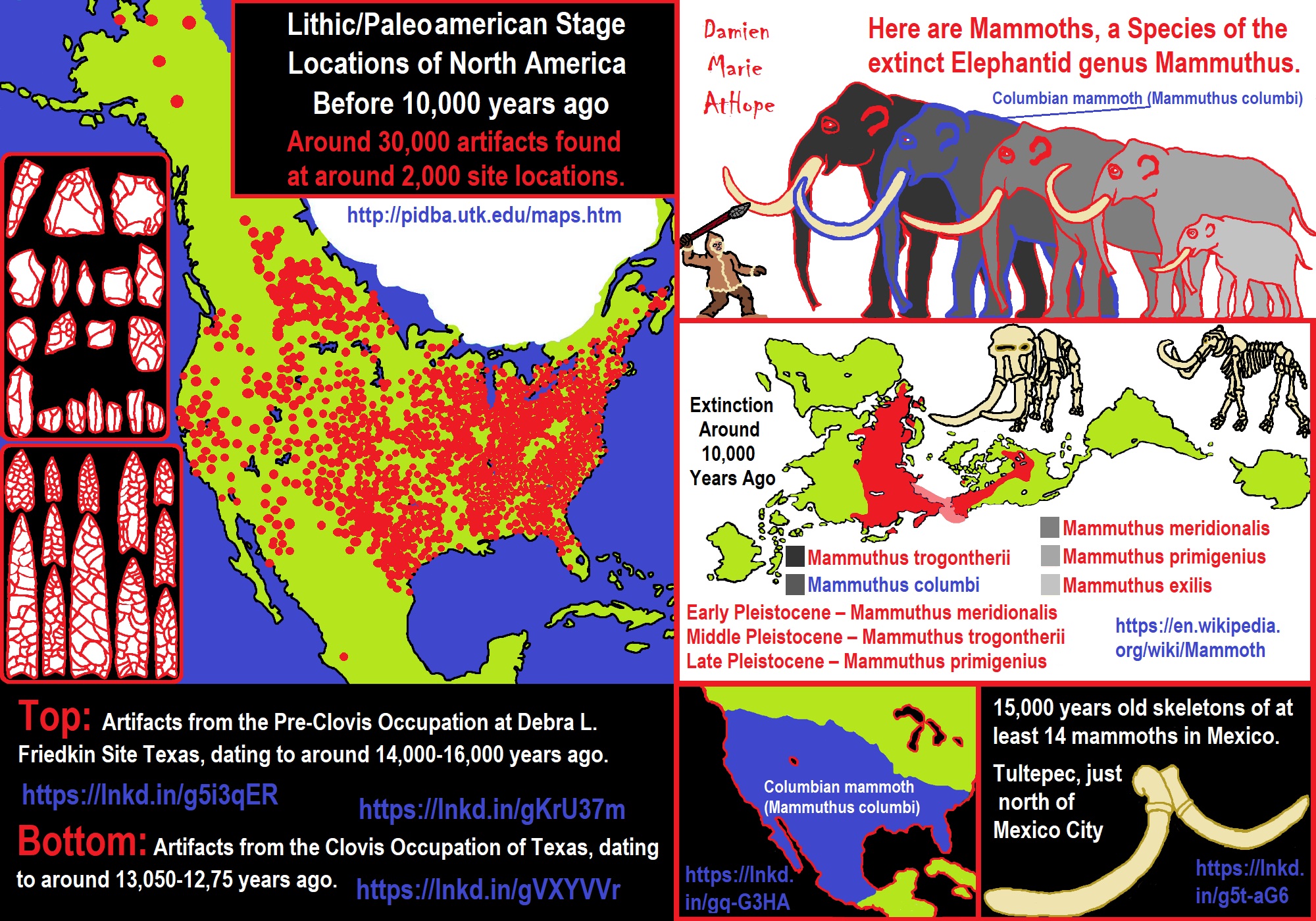
Human and Mammoth relationships
“The intensity of occupation layers and richness of artifacts, large hearths and related dwelling structures, variability in seasonal occupation over the year, and time-consuming and delicate technologies (microliths, fine ivory carvings, textiles, and so forth) suggest a relative sedentism or, at least, tethered nomadism. As a paradox, the strong cultural relationship among the sites along the Austrian-Moravian-Polish geomorphological corridor, long-distance lithic material importations, and probable following the animals along the rivers, also suggest a mobility across the landscape at the same time. Thus we expect a flexible and less risky resource exploitation system controlling a larger territory and capable of supplies all throughout the year. Although discussions are in course about the intentionality of mammoth hunting, this animal played a key role in human economy, accompanied by middle-sized animals such as reindeer and horse, together with smaller fur-bearing mammals such as wolf, arctic and common fox and also by hares, birds, fish, and plants. Extensive mammoth bone deposits, as a typical formative phenomenon at these Moravian sites, were located either inside the settlements or separately, in the adjacent gullies or on the slopes. Various authors underline different aspects of the archaeological record and argue for mammoth hunting versus mammoth scavenging, reindeer hunting, net-hunting of smaller game, or plant gathering. As early as the nineteenth century, the first large site of this type, with mammoth bone deposits, was excavated by J. Wankel at Předmostí. However, the authority of a visiting Danish scholar, J. Steenstrup, convinced Wankel that man was not contemporaneous with the mammoth nor did he hunt them. In his later works, Wankel accepted Steenstrup´s view that later hunters of the ‘reindeer age’ would have come to the site to explore bones from earlier natural bone deposits. As soon as the larger and more systematic excavation was initiated at Dolní Věstonice in 1924 by K. Absolon, all doubts about man and mammoth contemporaneity disappeared and the idea of ‘mammoth hunters’ was widely adopted in both scientific and popular literature. However, L. Binford’s critical work concerning the pattern of human hunting in general and revision of the Moravian mammoth hunting by O. Soffer etal., (2001), raised further doubts about human capacity to hunt as large animals as the mammoth. We agree that the model of ‘mammoth hunters’ during the Palaeolithic should be considered and tested separately, from case to case.” ref
- “Recent archaeozoological analysis of the mammoth bone deposits in the Gravettian of Moravia and southern Poland show a certain preference for younger animals but no visible pattern in selecting a particular type of bone and only few cut marks. Thus, our present arguments on the intentional human hunting of mammoth during the Gravettian may only be indirect:
- One of them is the spatial relationship of the sites to ‘mammoth environments’ such as the river valleys, to strategic locations, and to side gorges that may have served as ‘natural traps’.
- Secondly, the faunal composition, in cases where the horse-and-reindeer component is restricted and the remaining faunal spectrum is dominated by smaller animals (hares, foxes, wolves, birds), would not have supplied sufficient food resources. Thus, the meat and fat content provided by the mammoth bone deposits must be calculated into the food consumption expected in such extensive and complex human settlements.
- Finally, the development and complexity of Gravettian technology and symbolism suggests that, if ever any Palaeolithic society would systematically attack as large animal as the mammoth, the Gravettians would represent one well-equipped society in terms of material, knowledge, and psychology.” ref
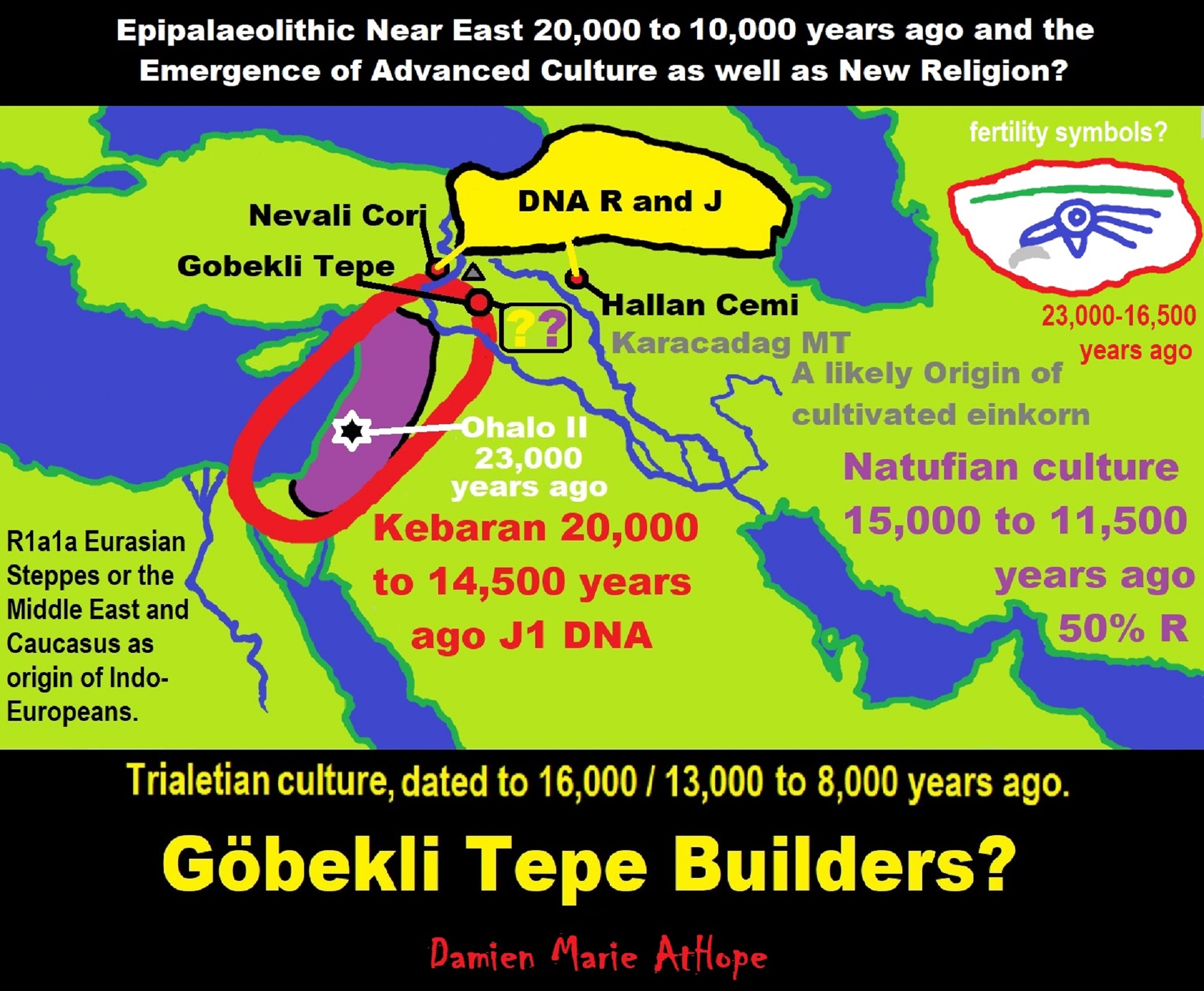
ref, ref, ref, ref, ref, ref, ref
Trialetian culture (16,000–8000 years ago) the Caucasus, Iran, and Turkey, likely involved in Göbekli Tepe. Migration 1?
Haplogroup R possible time of origin about 27,000 years in Central Asia, South Asia, or Siberia:
- Mal’ta–Buret’ culture (24,000-15,000 years ago)
- Afontova Gora culture (21,000-12,000 years ago)
- Trialetian culture (16,000–8000 years ago)
- Samara culture (7,000-6,500 years ago)
- Khvalynsk culture (7,000-6,500 years ago)
- Afanasievo culture (5,300-4,500 years ago)
- Yamna/Yamnaya Culture (5,300-4,500 years ago)
- Andronovo culture (4,000–2,900 years ago) ref
Trialetian sites
Caucasus and Transcaucasia:
- Edzani (Georgia)
- Chokh (Azerbaijan), layers E-C200
- Kotias Klde, layer B” ref
Eastern Anatolia:
- Hallan Çemi (from ca. 8.6-8.5k BC to 7.6-7.5k BCE)
- Nevali Çori shows some Trialetian admixture in a PPNB context” ref
Trialetian influences can also be found in:
- Cafer Höyük
- Boy Tepe” ref
Southeast of the Caspian Sea:
- Hotu (Iran)
- Ali Tepe (Iran) (from cal. 10,500 to 8,870 BCE)
- Belt Cave (Iran), layers 28-11 (the last remains date from ca. 6,000 BCE)
- Dam-Dam-Cheshme II (Turkmenistan), layers7,000-3,000 BCE)” ref
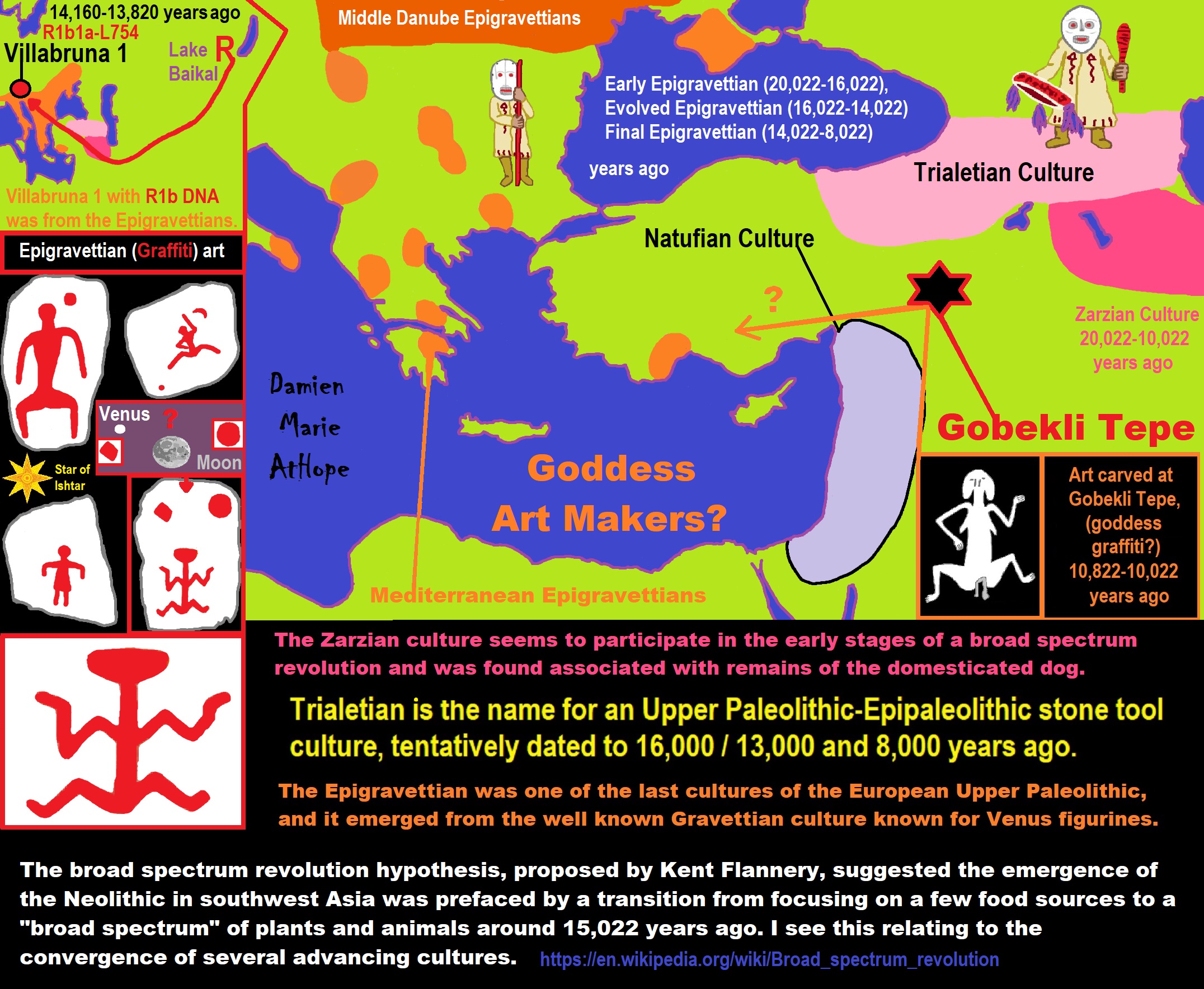
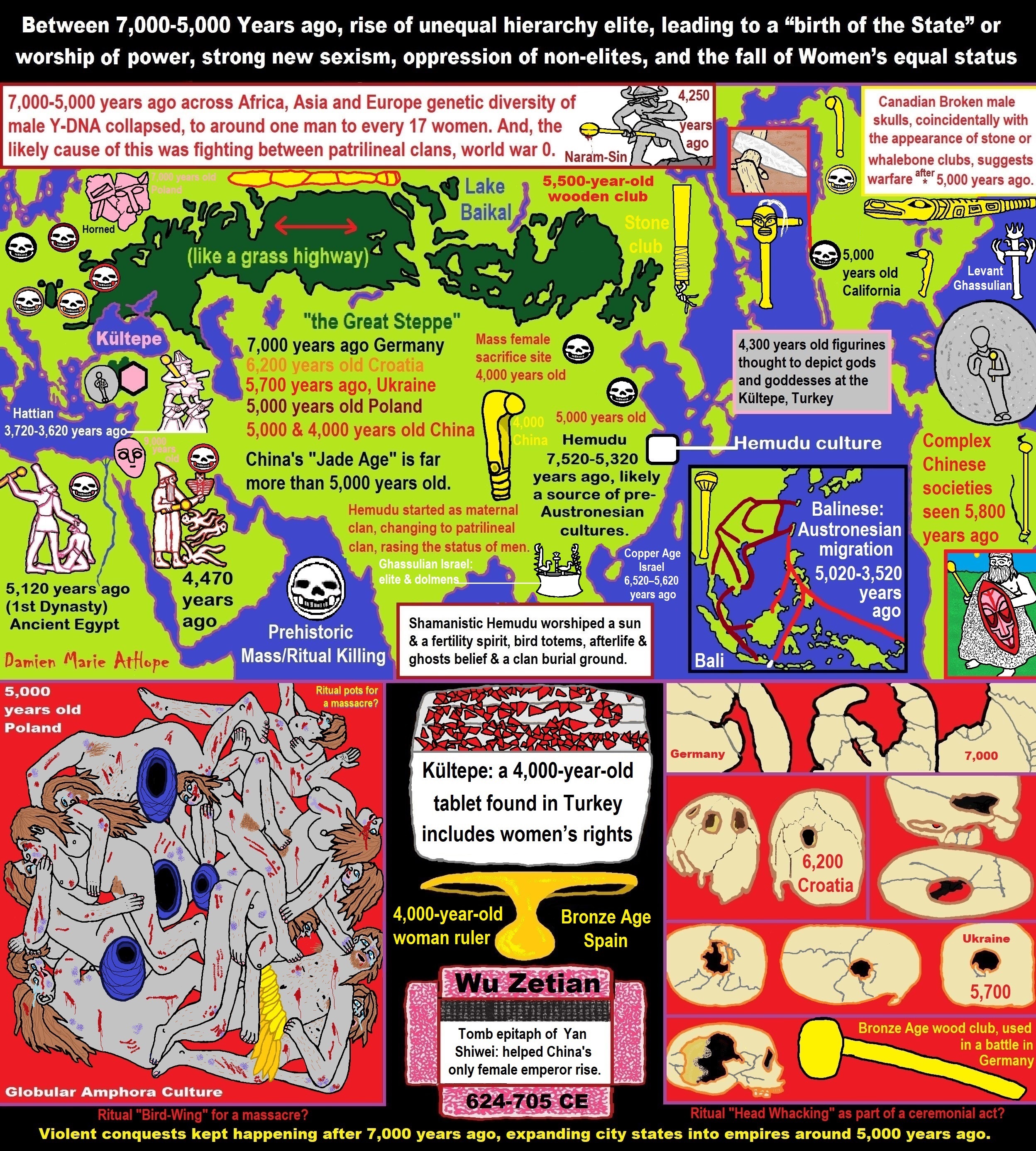
ref, ref, ref, ref, ref, ref, ref, ref, ref, ref, ref, ref, ref, ref, ref, ref, ref, ref, ref, ref, ref, ref, ref, ref, ref, ref, ref, ref, ref, ref, ref, ref, ref, ref, ref, ref, ref, ref, ref, ref, ref, ref, ref, ref, ref, ref, ref, ref, ref, ref, ref, ref, ref, ref, ref, ref, ref, ref, ref, ref, ref, ref, ref, ref, ref, ref, ref, ref, ref, ref, ref, ref, ref, ref, ref, ref, ref, ref, ref, ref, ref, ref, ref, ref, ref, ref, ref, ref, ref, ref
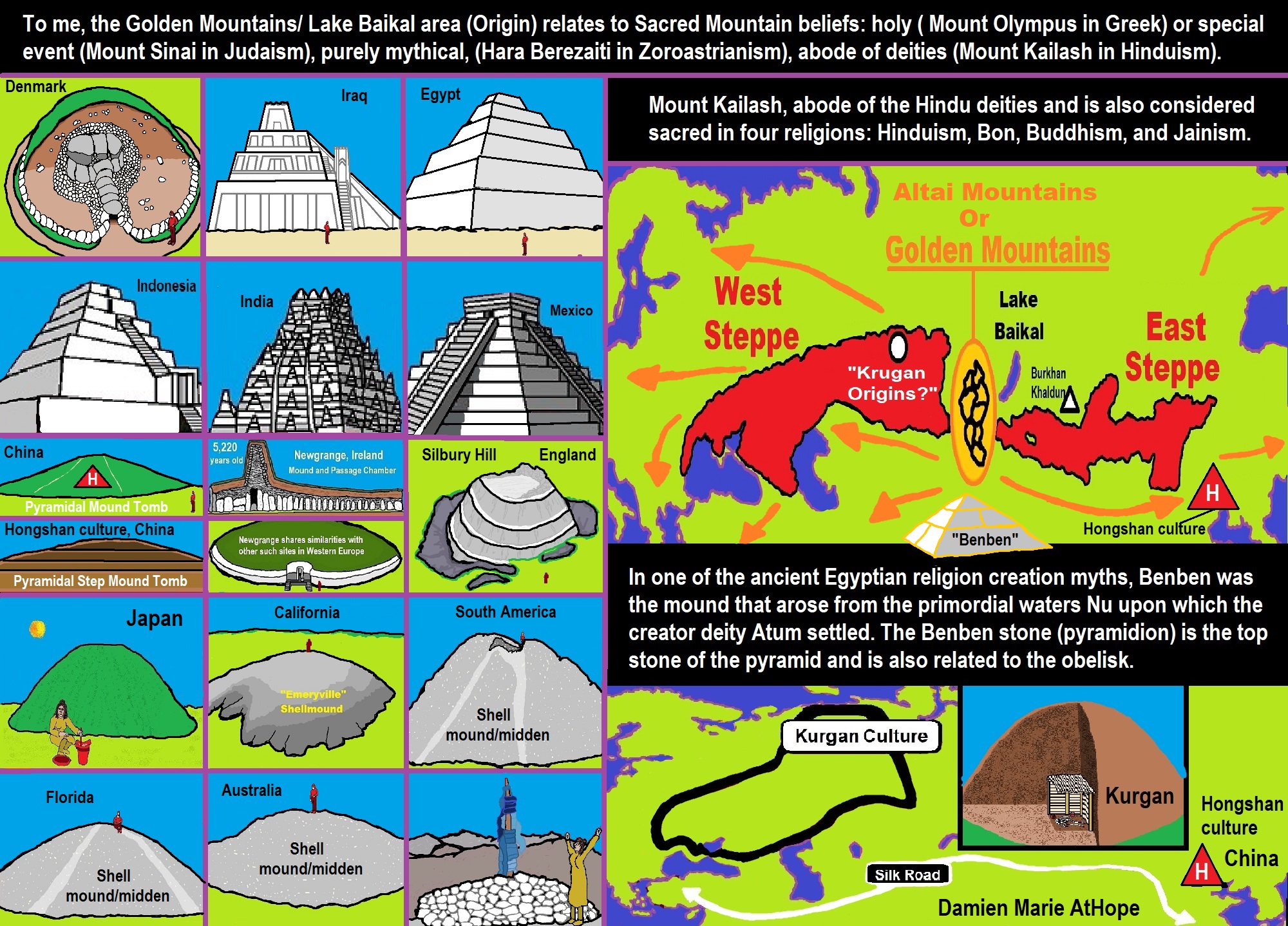
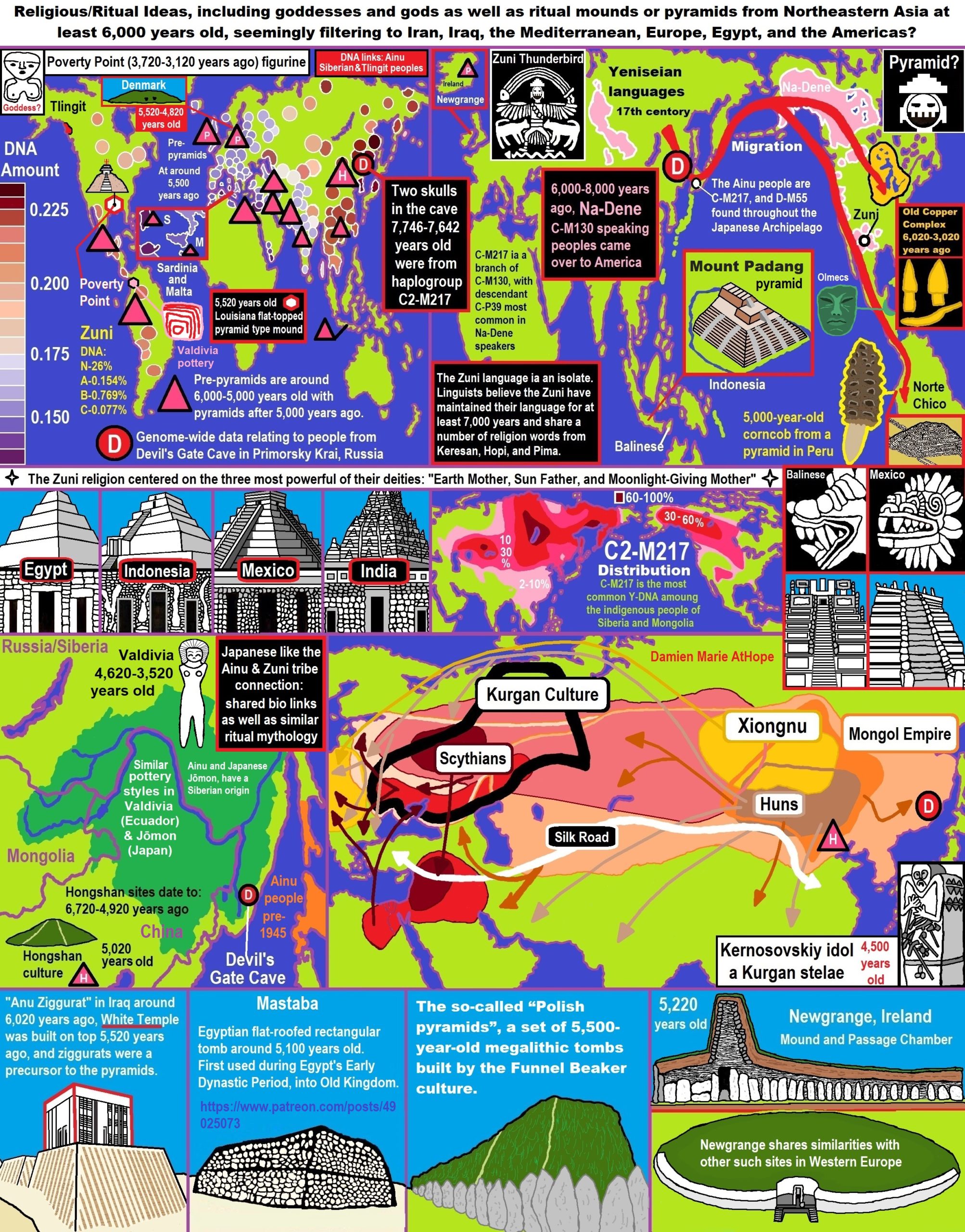
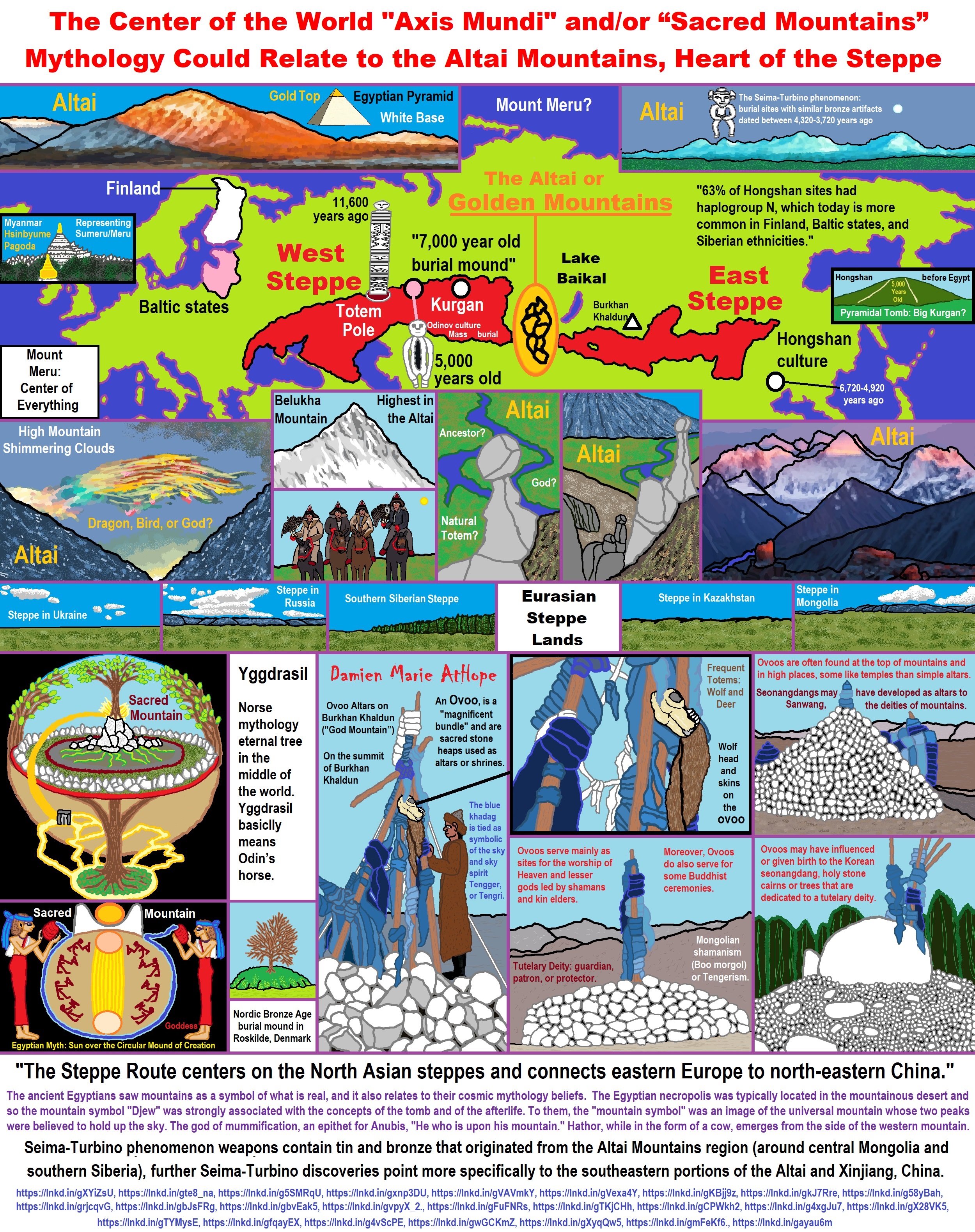
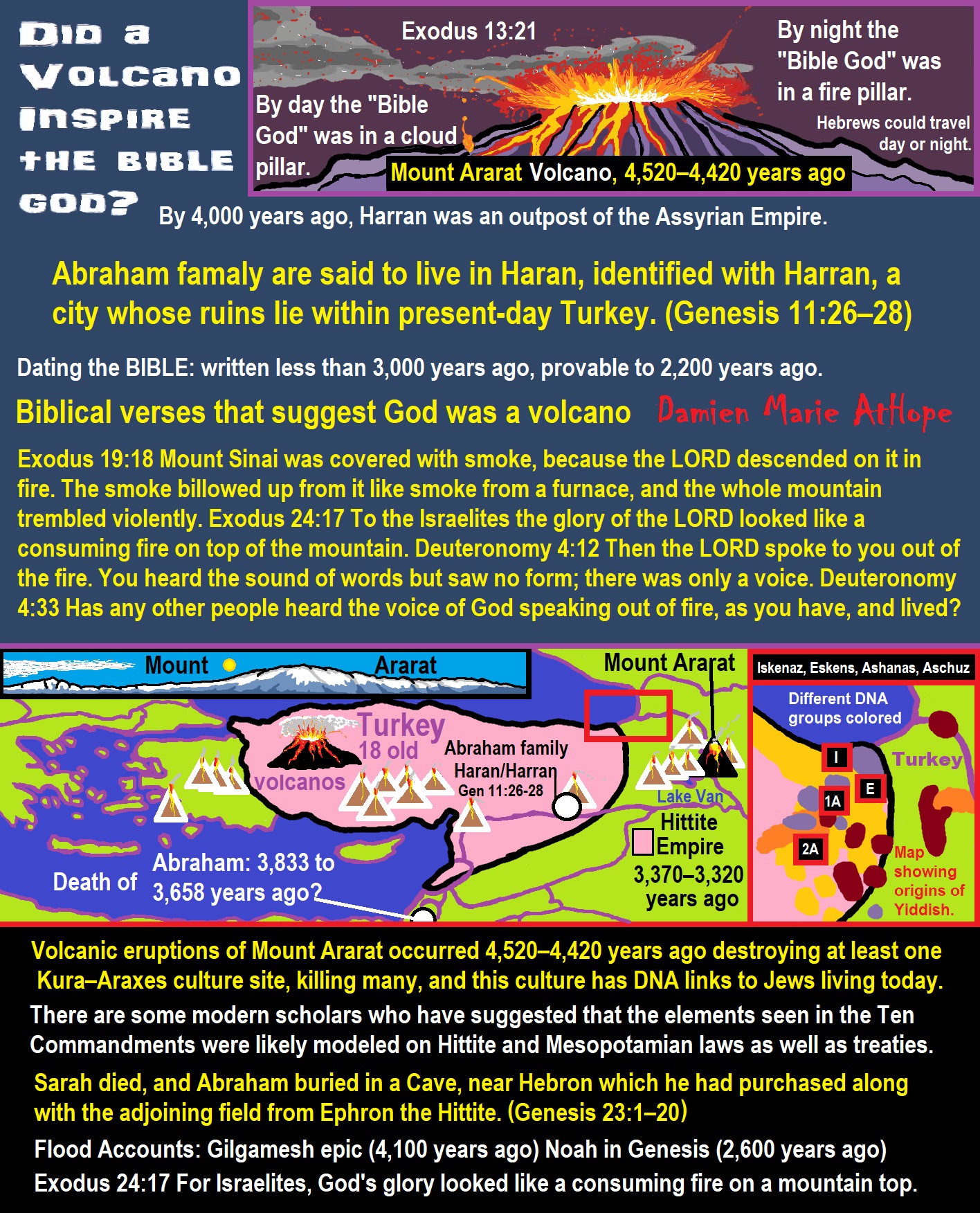
ref, ref, ref, ref, ref, ref, ref, ref, ref, ref, ref, ref, ref
By day the LORD went ahead of them in a pillar of cloud to guide them on their way and by night in a pillar of fire to give them light, so that they could travel by day or night.
- By day the “Bible God” was in a cloud pillar.
- By night the “Bible God” was in a fire pillar.

People don’t commonly teach religious history, even that of their own claimed religion. No, rather they teach a limited “pro their religion” history of their religion from a religious perspective favorable to the religion of choice.

Do you truly think “Religious Belief” is only a matter of some personal choice?
Do you not see how coercive one’s world of choice is limited to the obvious hereditary belief, in most religious choices available to the child of religious parents or caregivers? Religion is more commonly like a family, culture, society, etc. available belief that limits the belief choices of the child and that is when “Religious Belief” is not only a matter of some personal choice and when it becomes hereditary faith, not because of the quality of its alleged facts or proposed truths but because everyone else important to the child believes similarly so they do as well simply mimicking authority beliefs handed to them. Because children are raised in religion rather than being presented all possible choices but rather one limited dogmatic brand of “Religious Belief” where children only have a choice of following the belief as instructed, and then personally claim the faith hereditary belief seen in the confirming to the belief they have held themselves all their lives. This is obvious in statements asked and answered by children claiming a faith they barely understand but they do understand that their family believes “this or that” faith, so they feel obligated to believe it too. While I do agree that “Religious Belief” should only be a matter of some personal choice, it rarely is… End Hereditary Religion!

Animism: Respecting the Living World by Graham Harvey
“How have human cultures engaged with and thought about animals, plants, rocks, clouds, and other elements in their natural surroundings? Do animals and other natural objects have a spirit or soul? What is their relationship to humans? In this new study, Graham Harvey explores current and past animistic beliefs and practices of Native Americans, Maori, Aboriginal Australians, and eco-pagans. He considers the varieties of animism found in these cultures as well as their shared desire to live respectfully within larger natural communities. Drawing on his extensive casework, Harvey also considers the linguistic, performative, ecological, and activist implications of these different animisms.” ref

We are like believing machines we vacuum up ideas, like Velcro sticks to almost everything. We accumulate beliefs that we allow to negatively influence our lives, often without realizing it. Our willingness must be to alter skewed beliefs that impend our balance or reason, which allows us to achieve new positive thinking and accurate outcomes.

My thoughts on Religion Evolution with external links for more info:
- (Pre-Animism Africa mainly, but also Europe, and Asia at least 300,000 years ago), (Pre-Animism – Oxford Dictionaries)
- (Animism Africa around 100,000 years ago), (Animism – Britannica.com)
- (Totemism Europe around 50,000 years ago), (Totemism – Anthropology)
- (Shamanism Siberia around 30,000 years ago), (Shamanism – Britannica.com)
- (Paganism Turkey around 12,000 years ago), (Paganism – BBC Religion)
- (Progressed Organized Religion “Institutional Religion” Egypt around 5,000 years ago), (Ancient Egyptian Religion – Britannica.com)
- (CURRENT “World” RELIGIONS after 4,000 years ago) (Origin of Major Religions – Sacred Texts)
- (Early Atheistic Doubting at least by 2,600 years ago) (History of Atheism – Wikipedia)
“Religion is an Evolved Product” and Yes, Religion is Like Fear Given Wings…
Atheists talk about gods and religions for the same reason doctors talk about cancer, they are looking for a cure, or a firefighter talks about fires because they burn people and they care to stop them. We atheists too often feel a need to help the victims of mental slavery, held in the bondage that is the false beliefs of gods and the conspiracy theories of reality found in religions.
Understanding Religion Evolution:
- Pre-Animism (at least 300,000 years ago)
- Animism (Africa: 100,000 years ago)
- Totemism (Europe: 50,000 years ago)
- Shamanism (Siberia: 30,000 years ago)
- Paganism (Turkey: 12,000 years ago)
- Progressed organized religion (Egypt: 5,000 years ago), (Egypt, the First Dynasty 5,150 years ago)
- CURRENT “World” RELIGIONS (after 4,000 years ago)
- Early Atheistic Doubting (at least by 2,600 years ago)
“An Archaeological/Anthropological Understanding of Religion Evolution”
It seems ancient peoples had to survived amazing threats in a “dangerous universe (by superstition perceived as good and evil),” and human “immorality or imperfection of the soul” which was thought to affect the still living, leading to ancestor worship. This ancestor worship presumably led to the belief in supernatural beings, and then some of these were turned into the belief in gods. This feeble myth called gods were just a human conceived “made from nothing into something over and over, changing, again and again, taking on more as they evolve, all the while they are thought to be special,” but it is just supernatural animistic spirit-belief perceived as sacred.
Quick Evolution of Religion?
Pre-Animism (at least 300,000 years ago) pre-religion is a beginning that evolves into later Animism. So, Religion as we think of it, to me, all starts in a general way with Animism (Africa: 100,000 years ago) (theoretical belief in supernatural powers/spirits), then this is physically expressed in or with Totemism (Europe: 50,000 years ago) (theoretical belief in mythical relationship with powers/spirits through a totem item), which then enlists a full-time specific person to do this worship and believed interacting Shamanism (Siberia/Russia: 30,000 years ago) (theoretical belief in access and influence with spirits through ritual), and then there is the further employment of myths and gods added to all the above giving you Paganism (Turkey: 12,000 years ago) (often a lot more nature-based than most current top world religions, thus hinting to their close link to more ancient religious thinking it stems from). My hypothesis is expressed with an explanation of the building of a theatrical house (modern religions development). Progressed organized religion (Egypt: 5,000 years ago) with CURRENT “World” RELIGIONS (after 4,000 years ago).
Historically, in large city-state societies (such as Egypt or Iraq) starting around 5,000 years ago culminated to make religion something kind of new, a sociocultural-governmental-religious monarchy, where all or at least many of the people of such large city-state societies seem familiar with and committed to the existence of “religion” as the integrated life identity package of control dynamics with a fixed closed magical doctrine, but this juggernaut integrated religion identity package of Dogmatic-Propaganda certainly did not exist or if developed to an extent it was highly limited in most smaller prehistoric societies as they seem to lack most of the strong control dynamics with a fixed closed magical doctrine (magical beliefs could be at times be added or removed). Many people just want to see developed religious dynamics everywhere even if it is not. Instead, all that is found is largely fragments until the domestication of religion.
Religions, as we think of them today, are a new fad, even if they go back to around 6,000 years in the timeline of human existence, this amounts to almost nothing when seen in the long slow evolution of religion at least around 70,000 years ago with one of the oldest ritual worship. Stone Snake of South Africa: “first human worship” 70,000 years ago. This message of how religion and gods among them are clearly a man-made thing that was developed slowly as it was invented and then implemented peace by peace discrediting them all. Which seems to be a simple point some are just not grasping how devastating to any claims of truth when we can see the lie clearly in the archeological sites.
I wish people fought as hard for the actual values as they fight for the group/clan names political or otherwise they think support values. Every amount spent on war is theft to children in need of food or the homeless kept from shelter.
Here are several of my blog posts on history:
- To Find Truth You Must First Look
- (Magdalenian/Iberomaurusian) Connections to the First Paganists of the early Neolithic Near East Dating from around 17,000 to 12,000 Years Ago
- Natufians: an Ancient People at the Origins of Agriculture and Sedentary Life
- Possible Clan Leader/Special “MALE” Ancestor Totem Poles At Least 13,500 years ago?
- Jewish People with DNA at least 13,200 years old, Judaism, and the Origins of Some of its Ideas
- Baltic Reindeer Hunters: Swiderian, Lyngby, Ahrensburgian, and Krasnosillya cultures 12,020 to 11,020 years ago are evidence of powerful migratory waves during the last 13,000 years and a genetic link to Saami and the Finno-Ugric peoples.
- The Rise of Inequality: patriarchy and state hierarchy inequality
- Fertile Crescent 12,500 – 9,500 Years Ago: fertility and death cult belief system?
- 12,400 – 11,700 Years Ago – Kortik Tepe (Turkey) Pre/early-Agriculture Cultic Ritualism
- Ritualistic Bird Symbolism at Gobekli Tepe and its “Ancestor Cult”
- Male-Homosexual (female-like) / Trans-woman (female) Seated Figurine from Gobekli Tepe
- Could a 12,000-year-old Bull Geoglyph at Göbekli Tepe relate to older Bull and Female Art 25,000 years ago and Later Goddess and the Bull cults like Catal Huyuk?
- Sedentism and the Creation of goddesses around 12,000 years ago as well as male gods after 7,000 years ago.
- Alcohol, where Agriculture and Religion Become one? Such as Gobekli Tepe’s Ritualistic use of Grain as Food and Ritual Drink
- Neolithic Ritual Sites with T-Pillars and other Cultic Pillars
- Paganism: Goddesses around 12,000 years ago then Male Gods after 7,000 years ago
- First Patriarchy: Split of Women’s Status around 12,000 years ago & First Hierarchy: fall of Women’s Status around 5,000 years ago.
- Natufians: an Ancient People at the Origins of Agriculture and Sedentary Life
- J DNA and the Spread of Agricultural Religion (paganism)
- Paganism: an approximately 12,000-year-old belief system
- Paganism 12,000 years old: related to “Anarchism and Socialism” (Pre-Capitalism)
- Shaman burial in Israel 12,000 years ago and the Shamanism Phenomena
- Need to Mythicized: gods and goddesses
- 12,000 – 7,000 Years Ago – Paleo-Indian Culture (The Americas)
- 12,000 – 2,000 Years Ago – Indigenous-Scandinavians (Nordic)
- Norse did not wear helmets with horns?
- Pre-Pottery Neolithic Skull Cult around 11,500 to 8,400 Years Ago?
- 10,400 – 10,100 Years Ago, in Turkey the Nevail Cori Religious Settlement
- 9,000-6,500 Years Old Submerged Pre-Pottery/Pottery Neolithic Ritual Settlements off Israel’s Coast
- Catal Huyuk “first religious designed city” around 9,500 to 7,700 years ago (Turkey)
- Cultic Hunting at Catal Huyuk “first religious designed city”
- Special Items and Art as well as Special Elite Burials at Catal Huyuk
- New Rituals and Violence with the appearance of Pottery and People?
- Haplogroup N and its related Uralic Languages and Cultures
- Ainu people, Sámi people, Native Americans, the Ancient North Eurasians, and Paganistic-Shamanism with Totemism
- Ideas, Technology and People from Turkey, Europe, to China and Back again 9,000 to 5,000 years ago?
- First Pottery of Europe and the Related Cultures
- 9,000 years old Neolithic Artifacts Judean Desert and Hills Israel
- 9,000-7,000 years-old Sex and Death Rituals: Cult Sites in Israel, Jordan, and the Sinai
- 9,000-8500 year old Horned Female shaman Bad Dürrenberg Germany
- Neolithic Jewelry and the Spread of Farming in Europe Emerging out of West Turkey
- 8,600-year-old Tortoise Shells in Neolithic graves in central China have Early Writing and Shamanism
- Swing of the Mace: the rise of Elite, Forced Authority, and Inequality begin to Emerge 8,500 years ago?
- Migrations and Changing Europeans Beginning around 8,000 Years Ago
- My “Steppe-Anatolian-Kurgan hypothesis” 8,000/7,000 years ago
- Around 8,000-year-old Shared Idea of the Mistress of Animals, “Ritual” Motif
- Pre-Columbian Red-Paint (red ochre) Maritime Archaic Culture 8,000-3,000 years ago
- 7,522-6,522 years ago Linear Pottery culture which I think relates to Arcane Capitalism’s origins
- Arcane Capitalism: Primitive socialism, Primitive capital, Private ownership, Means of production, Market capitalism, Class discrimination, and Petite bourgeoisie (smaller capitalists)
- 7,500-4,750 years old Ritualistic Cucuteni-Trypillian culture of Moldova, Romania, and Ukraine
- Roots of a changing early society 7,200-6,700 years ago Jordan and Israel
- Agriculture religion (Paganism) with farming reached Britain between about 7,000 to 6,500 or so years ago and seemingly expressed in things like Western Europe’s Long Barrows
- My Thoughts on Possible Migrations of “R” DNA and Proto-Indo-European?
- “Millet” Spreading from China 7,022 years ago to Europe and related Language may have Spread with it leading to Proto-Indo-European
- Proto-Indo-European (PIE), ancestor of Indo-European languages: DNA, Society, Language, and Mythology
- The Dnieper–Donets culture and Asian varieties of Millet from China to the Black Sea region of Europe by 7,022 years ago
- Kurgan 6,000 years ago/dolmens 7,000 years ago: funeral, ritual, and other?
- 7,020 to 6,020-year-old Proto-Indo-European Homeland of Urheimat or proposed home of their Language and Religion
- Ancient Megaliths: Kurgan, Ziggurat, Pyramid, Menhir, Trilithon, Dolman, Kromlech, and Kromlech of Trilithons
- The Mytheme of Ancient North Eurasian Sacred-Dog belief and similar motifs are found in Indo-European, Native American, and Siberian comparative mythology
- Elite Power Accumulation: Ancient Trade, Tokens, Writing, Wealth, Merchants, and Priest-Kings
- Sacred Mounds, Mountains, Kurgans, and Pyramids may hold deep connections?
- Between 7,000-5,000 Years ago, rise of unequal hierarchy elite, leading to a “birth of the State” or worship of power, strong new sexism, oppression of non-elites, and the fall of Women’s equal status
- Paganism 7,000-5,000 years old: related to “Anarchism and Socialism” (Capitalism) (World War 0) Elite & their slaves
- Hell and Underworld mythologies starting maybe as far back as 7,000 to 5,000 years ago with the Proto-Indo-Europeans?
- The First Expression of the Male God around 7,000 years ago?
- White (light complexion skin) Bigotry and Sexism started 7,000 years ago?
- Around 7,000-year-old Shared Idea of the Divine Bird (Tutelary and/or Trickster spirit/deity), “Ritual” Motif
- Nekhbet an Ancient Egyptian Vulture Goddess and Tutelary Deity
- 6,720 to 4,920 years old Ritualistic Hongshan Culture of Inner Mongolia with 5,000-year-old Pyramid Mounds and Temples
- First proto-king in the Balkans, Varna culture around 6,500 years ago?
- 6,500–5,800 years ago in Israel Late Chalcolithic (Copper Age) Period in the Southern Levant Seems to Express Northern Levant Migrations, Cultural and Religious Transfer
- KING OF BEASTS: Master of Animals “Ritual” Motif, around 6,000 years old or older…
- Around 6000-year-old Shared Idea of the Solid Wheel & the Spoked Wheel-Shaped Ritual Motif
- “The Ghassulian Star,” a mysterious 6,000-year-old mural from Jordan; a Proto-Star of Ishtar, Star of Inanna or Star of Venus?
- Religious/Ritual Ideas, including goddesses and gods as well as ritual mounds or pyramids from Northeastern Asia at least 6,000 years old, seemingly filtering to Iran, Iraq, the Mediterranean, Europe, Egypt, and the Americas?
- Maykop (5,720–5,020 years ago) Caucasus region Bronze Age culture-related to Copper Age farmers from the south, influenced by the Ubaid period and Leyla-Tepe culture, as well as influencing the Kura-Araxes culture
- 5-600-year-old Tomb, Mummy, and First Bearded Male Figurine in a Grave
- Kura-Araxes Cultural 5,520 to 4,470 years old DNA traces to the Canaanites, Arabs, and Jews
- Minoan/Cretan (Keftiu) Civilization and Religion around 5,520 to 3,120 years ago
- Evolution Of Science at least by 5,500 years ago
- 5,500 Years old birth of the State, the rise of Hierarchy, and the fall of Women’s status
- “Jiroft culture” 5,100 – 4,200 years ago and the History of Iran
- Stonehenge: Paganistic Burial and Astrological Ritual Complex, England (5,100-3,600 years ago)
- Around 5,000-year-old Shared Idea of the “Tree of Life” Ritual Motif
- Complex rituals for elite, seen from China to Egypt, at least by 5,000 years ago
- Around 5,000 years ago: “Birth of the State” where Religion gets Military Power and Influence
- The Center of the World “Axis Mundi” and/or “Sacred Mountains” Mythology Could Relate to the Altai Mountains, Heart of the Steppe
- Progressed organized religion starts, an approximately 5,000-year-old belief system
- China’s Civilization between 5,000-3,000 years ago, was a time of war and class struggle, violent transition from free clans to a Slave or Elite society
- Origin of Logics is Naturalistic Observation at least by around 5,000 years ago.
- Paganism 5,000 years old: progressed organized religion and the state: related to “Anarchism and Socialism” (Kings and the Rise of the State)
- Ziggurats (multi-platform temples: 4,900 years old) to Pyramids (multi-platform tombs: 4,700 years old)
- Did a 4,520–4,420-year-old Volcano In Turkey Inspire the Bible God?
- Finland’s Horned Shaman and Pre-Horned-God at least 4,500 years ago?
- 4,000-year-Old Dolmens in Israel: A Connected Dolmen Religious Phenomenon?
- Creation myths: From chaos, Ex nihilo, Earth-diver, Emergence, World egg, and World parent
- Bronze Age “Ritual” connections of the Bell Beaker culture with the Corded Ware/Single Grave culture, which were related to the Yamnaya culture and Proto-Indo-European Languages/Religions
- Low Gods (Earth/ Tutelary deity), High Gods (Sky/Supreme deity), and Moralistic Gods (Deity enforcement/divine order)
- The exchange of people, ideas, and material-culture including, to me, the new god (Sky Father) and goddess (Earth Mother) religion between the Cucuteni-Trypillians and others which is then spread far and wide
- Koryaks: Indigenous People of the Russian Far East and Big Raven myths also found in Tlingit, Haida, Tsimshian, and other Indigenous People of North America
- 42 Principles Of Maat (Egyptian Goddess of the justice) around 4,400 years ago, 2000 Years Before Ten Commandments
- “Happy Easter” Well Happy Eostre/Ishter
- 4,320-3,820 years old “Shimao” (North China) site with Totemistic-Shamanistic Paganism and a Stepped Pyramid
- 4,250 to 3,400 Year old Stonehenge from Russia: Arkaim?
- 4,100-year-old beaker with medicinal & flowering plants in a grave of a woman in Scotland
- Early European Farmer ancestry, Kelif el Boroud people with the Cardial Ware culture, and the Bell Beaker culture Paganists too, spread into North Africa, then to the Canary Islands off West Africa
- Flood Accounts: Gilgamesh epic (4,100 years ago) Noah in Genesis (2,600 years ago)
- Paganism 4,000 years old: related to “Anarchism and Socialism” (First Moralistic gods, then the Origin time of Monotheism)
- When was the beginning: TIMELINE OF CURRENT RELIGIONS, which start around 4,000 years ago.
- Early Religions Thought to Express Proto-Monotheistic Systems around 4,000 years ago
- Kultepe? An archaeological site with a 4,000 years old women’s rights document.
- Single God Religions (Monotheism) = “Man-o-theism” started around 4,000 years ago with the Great Sky Spirit/God Tiān (天)?
- Confucianism’s Tiān (Shangdi god 4,000 years old): Supernaturalism, Pantheism or Theism?
- Yes, Your Male God is Ridiculous
- Mythology, a Lunar Deity is a Goddess or God of the Moon
- Sacred Land, Hills, and Mountains: Sami Mythology (Paganistic Shamanism)
- Horse Worship/Sacrifice: mythical union of Ruling Elite/Kingship and the Horse
- The Amorite/Amurru people’s God Amurru “Lord of the Steppe”, relates to the Origins of the Bible God?
- Bronze Age Exotic Trade Routes Spread Quite Far as well as Spread Religious Ideas with Them
- Sami and the Northern Indigenous Peoples Landscape, Language, and its Connection to Religion
- Prototype of Ancient Analemmatic Sundials around 3,900-3,150 years ago and a Possible Solar Connection to gods?
- Judaism is around 3,450 or 3,250 years old. (“Paleo-Hebrew” 3,000 years ago and Torah 2,500 years ago)
- The Weakening of Ancient Trade and the Strengthening of Religions around 3000 years ago?
- Are you aware that there are religions that worship women gods, explain now religion tears women down?
- Animistic, Totemistic, and Paganistic Superstition Origins of bible god and the bible’s Religion.
- Myths and Folklore: “Trickster gods and goddesses”
- Jews, Judaism, and the Origins of Some of its Ideas
- An Old Branch of Religion Still Giving Fruit: Sacred Trees
- Dating the BIBLE: naming names and telling times (written less than 3,000 years ago, provable to 2,200 years ago)
- Did a Volcano Inspire the bible god?
- The Amorite/Amurru people’s God Amurru “Lord of the Steppe”, relates to the Origins of the Bible God?
- Dené–Yeniseian language, Old Copper Complex, and Pre-Columbian Mound Builders?
- No “dinosaurs and humans didn’t exist together just because some think they are in the bible itself”
- Sacred Shit and Sacred Animals?
- Everyone Killed in the Bible Flood? “Nephilim” (giants)?
- Hey, Damien dude, I have a question for you regarding “the bible” Exodus.
- Archaeology Disproves the Bible
- Bible Battle, Just More, Bible Babble
- The Jericho Conquest lie?
- Canaanites and Israelites?
- Accurate Account on how did Christianity Began?
- Let’s talk about Christianity.
- So the 10 commandments isn’t anything to go by either right?
- Misinformed christian
- Debunking Jesus?
- Paulism vs Jesus
- Ok, you seem confused so let’s talk about Buddhism.
- Unacknowledged Buddhism: Gods, Savior, Demons, Rebirth, Heavens, Hells, and Terrorism
- His Foolishness The Dalai Lama
- Yin and Yang is sexist with an ORIGIN around 2,300 years ago?
- I Believe Archaeology, not Myths & Why Not, as the Religious Myths Already Violate Reason!
- Archaeological, Scientific, & Philosophic evidence shows the god myth is man-made nonsense.
- Aquatic Ape Theory/Hypothesis? As Always, Just Pseudoscience.
- Ancient Aliens Conspiracy Theorists are Pseudohistorians
- The Pseudohistoric and Pseudoscientific claims about “Bakoni Ruins” of South Africa
- Why do people think Religion is much more than supernaturalism and superstitionism?
- Religion is an Evolved Product
- Was the Value of Ancient Women Different?
- 1000 to 1100 CE, human sacrifice Cahokia Mounds a pre-Columbian Native American site
- Feminist atheists as far back as the 1800s?
- Promoting Religion as Real is Mentally Harmful to a Flourishing Humanity
- Screw All Religions and Their Toxic lies, they are all fraud
- Forget Religions’ Unfounded Myths, I Have Substantiated “Archaeology Facts.”
- Religion Dispersal throughout the World
- I Hate Religion Just as I Hate all Pseudoscience
- Exposing Scientology, Eckankar, Wicca and Other Nonsense?
- Main deity or religious belief systems
- Quit Trying to Invent Your God From the Scraps of Science.
- Archaeological, Scientific, & Philosophic evidence shows the god myth is man-made nonsense.
- Ancient Alien Conspiracy Theorists: Misunderstanding, Rhetoric, Misinformation, Fabrications, and Lies
- Misinformation, Distortion, and Pseudoscience in Talking with a Christian Creationist
- Judging the Lack of Goodness in Gods, Even the Norse God Odin
- Challenging the Belief in God-like Aliens and Gods in General
- A Challenge to Christian use of Torture Devices?
- Yes, Hinduism is a Religion
- Trump is One of the Most Reactionary Forces of Far-right Christian Extremism
- Was the Bull Head a Symbol of God? Yes!
- Primate Death Rituals
- Christian – “God and Christianity are objectively true”
- Australopithecus afarensis Death Ritual?
- You Claim Global Warming is a Hoax?
- Doubter of Science and Defamer of Atheists?
- I think that sounds like the Bible?
- History of the Antifa (“anti-fascist”) Movements
- Indianapolis Anti-Blasphemy Laws #Free Soheil Rally
- Damien, you repeat the golden rule in so many forms then you say religion is dogmatic?
- Science is a Trustable Methodology whereas Faith is not Trustable at all!
- Was I ever a believer, before I was an atheist?
- Atheists rise in reason
- Mistrust of science?
- Open to Talking About the Definition of ‘God’? But first, we address Faith.
- ‘United Monarchy’ full of splendor and power – Saul, David, and Solomon? Most likely not.
- Is there EXODUS ARCHAEOLOGY? The short answer is “no.”
- Lacking Proof of Bigfoots, Unicorns, and Gods is Just a Lack of Research?
- Religion and Politics: Faith Beliefs vs. Rational Thinking
- Hammer of Truth that lying pig RELIGION: challenged by an archaeologist
- “The Hammer of Truth” -ontology question- What do You Mean by That?
- Navigation of a bad argument: Ad Hominem vs. Attack
- Why is it Often Claimed that Gods have a Gender?
- Why are basically all monotheistic religions ones that have a male god?
- Shifting through the Claims in support of Faith
- Dear Mr. AtHope, The 20th Century is an Indictment of Secularism and a Failed Atheist Century
- An Understanding of the Worldwide Statistics and Dynamics of Terrorist Incidents and Suicide Attacks
- Intoxication and Evolution? Addressing and Assessing the “Stoned Ape” or “Drunken Monkey” Theories as Catalysts in Human Evolution
- Sacred Menstrual cloth? Inanna’s knot, Isis knot, and maybe Ma’at’s feather?
- Damien, why don’t the Hebrews accept the bible stories?
- Dealing with a Troll and Arguing Over Word Meaning
- Knowledge without Belief? Justified beliefs or disbeliefs worthy of Knowledge?
- Afrocentrism and African Religions
- Crecganford @crecganford offers history & stories of the people, places, gods, & culture
- Empiricism-Denier?
I am not an academic. I am a revolutionary that teaches in public, in places like social media, and in the streets. I am not a leader by some title given but from my commanding leadership style of simply to start teaching everywhere to everyone, all manner of positive education.


To me, Animism starts in Southern Africa, then to West Europe, and becomes Totemism. Another split goes near the Russia and Siberia border becoming Shamanism, which heads into Central Europe meeting up with Totemism, which also had moved there, mixing the two which then heads to Lake Baikal in Siberia. From there this Shamanism-Totemism heads to Turkey where it becomes Paganism.

Not all “Religions” or “Religious Persuasions” have a god(s) but
All can be said to believe in some imaginary beings or imaginary things like spirits, afterlives, etc.

Paganism 12,000-4,000 years old
12,000-7,000 years old: related to (Pre-Capitalism)
7,000-5,000 years old: related to (Capitalism) (World War 0) Elite and their slaves!
5,000 years old: related to (Kings and the Rise of the State)
4,000 years old: related to (First Moralistic gods, then the Origin time of Monotheism)

ref, ref, ref, ref, ref, ref, ref, ref, ref, ref, ref, ref, ref, ref, ref, ref, ref, ref, ref, ref, ref
Low Gods “Earth” or Tutelary deity and High Gods “Sky” or Supreme deity
“An Earth goddess is a deification of the Earth. Earth goddesses are often associated with the “chthonic” deities of the underworld. Ki and Ninhursag are Mesopotamian earth goddesses. In Greek mythology, the Earth is personified as Gaia, corresponding to Roman Terra, Indic Prithvi/Bhūmi, etc. traced to an “Earth Mother” complementary to the “Sky Father” in Proto-Indo-European religion. Egyptian mythology exceptionally has a sky goddess and an Earth god.” ref
“A mother goddess is a goddess who represents or is a personification of nature, motherhood, fertility, creation, destruction or who embodies the bounty of the Earth. When equated with the Earth or the natural world, such goddesses are sometimes referred to as Mother Earth or as the Earth Mother. In some religious traditions or movements, Heavenly Mother (also referred to as Mother in Heaven or Sky Mother) is the wife or feminine counterpart of the Sky father or God the Father.” ref
“Any masculine sky god is often also king of the gods, taking the position of patriarch within a pantheon. Such king gods are collectively categorized as “sky father” deities, with a polarity between sky and earth often being expressed by pairing a “sky father” god with an “earth mother” goddess (pairings of a sky mother with an earth father are less frequent). A main sky goddess is often the queen of the gods and may be an air/sky goddess in her own right, though she usually has other functions as well with “sky” not being her main. In antiquity, several sky goddesses in ancient Egypt, Mesopotamia, and the Near East were called Queen of Heaven. Neopagans often apply it with impunity to sky goddesses from other regions who were never associated with the term historically. The sky often has important religious significance. Many religions, both polytheistic and monotheistic, have deities associated with the sky.” ref
“In comparative mythology, sky father is a term for a recurring concept in polytheistic religions of a sky god who is addressed as a “father”, often the father of a pantheon and is often either a reigning or former King of the Gods. The concept of “sky father” may also be taken to include Sun gods with similar characteristics, such as Ra. The concept is complementary to an “earth mother“. “Sky Father” is a direct translation of the Vedic Dyaus Pita, etymologically descended from the same Proto-Indo-European deity name as the Greek Zeûs Pater and Roman Jupiter and Germanic Týr, Tir or Tiwaz, all of which are reflexes of the same Proto-Indo-European deity’s name, *Dyēus Ph₂tḗr. While there are numerous parallels adduced from outside of Indo-European mythology, there are exceptions (e.g. In Egyptian mythology, Nut is the sky mother and Geb is the earth father).” ref
Tutelary deity
“A tutelary (also tutelar) is a deity or spirit who is a guardian, patron, or protector of a particular place, geographic feature, person, lineage, nation, culture, or occupation. The etymology of “tutelary” expresses the concept of safety and thus of guardianship. In late Greek and Roman religion, one type of tutelary deity, the genius, functions as the personal deity or daimon of an individual from birth to death. Another form of personal tutelary spirit is the familiar spirit of European folklore.” ref
“A tutelary (also tutelar) in Korean shamanism, jangseung and sotdae were placed at the edge of villages to frighten off demons. They were also worshiped as deities. Seonangshin is the patron deity of the village in Korean tradition and was believed to embody the Seonangdang. In Philippine animism, Diwata or Lambana are deities or spirits that inhabit sacred places like mountains and mounds and serve as guardians. Such as: Maria Makiling is the deity who guards Mt. Makiling and Maria Cacao and Maria Sinukuan. In Shinto, the spirits, or kami, which give life to human bodies come from nature and return to it after death. Ancestors are therefore themselves tutelaries to be worshiped. And similarly, Native American beliefs such as Tonás, tutelary animal spirit among the Zapotec and Totems, familial or clan spirits among the Ojibwe, can be animals.” ref
“A tutelary (also tutelar) in Austronesian beliefs such as: Atua (gods and spirits of the Polynesian peoples such as the Māori or the Hawaiians), Hanitu (Bunun of Taiwan‘s term for spirit), Hyang (Kawi, Sundanese, Javanese, and Balinese Supreme Being, in ancient Java and Bali mythology and this spiritual entity, can be either divine or ancestral), Kaitiaki (New Zealand Māori term used for the concept of guardianship, for the sky, the sea, and the land), Kawas (mythology) (divided into 6 groups: gods, ancestors, souls of the living, spirits of living things, spirits of lifeless objects, and ghosts), Tiki (Māori mythology, Tiki is the first man created by either Tūmatauenga or Tāne and represents deified ancestors found in most Polynesian cultures). ” ref, ref, ref, ref, ref, ref, ref
Mesopotamian Tutelary Deities can be seen as ones related to City-States
“Historical city-states included Sumerian cities such as Uruk and Ur; Ancient Egyptian city-states, such as Thebes and Memphis; the Phoenician cities (such as Tyre and Sidon); the five Philistine city-states; the Berber city-states of the Garamantes; the city-states of ancient Greece (the poleis such as Athens, Sparta, Thebes, and Corinth); the Roman Republic (which grew from a city-state into a vast empire); the Italian city-states from the Middle Ages to the early modern period, such as Florence, Siena, Ferrara, Milan (which as they grew in power began to dominate neighboring cities) and Genoa and Venice, which became powerful thalassocracies; the Mayan and other cultures of pre-Columbian Mesoamerica (including cities such as Chichen Itza, Tikal, Copán and Monte Albán); the central Asian cities along the Silk Road; the city-states of the Swahili coast; Ragusa; states of the medieval Russian lands such as Novgorod and Pskov; and many others.” ref
“The Uruk period (ca. 4000 to 3100 BCE; also known as Protoliterate period) of Mesopotamia, named after the Sumerian city of Uruk, this period saw the emergence of urban life in Mesopotamia and the Sumerian civilization. City-States like Uruk and others had a patron tutelary City Deity along with a Priest-King.” ref
“Chinese folk religion, both past, and present, includes myriad tutelary deities. Exceptional individuals, highly cultivated sages, and prominent ancestors can be deified and honored after death. Lord Guan is the patron of military personnel and police, while Mazu is the patron of fishermen and sailors. Such as Tu Di Gong (Earth Deity) is the tutelary deity of a locality, and each individual locality has its own Earth Deity and Cheng Huang Gong (City God) is the guardian deity of an individual city, worshipped by local officials and locals since imperial times.” ref
“A tutelary (also tutelar) in Hinduism, personal tutelary deities are known as ishta-devata, while family tutelary deities are known as Kuladevata. Gramadevata are guardian deities of villages. Devas can also be seen as tutelary. Shiva is the patron of yogis and renunciants. City goddesses include: Mumbadevi (Mumbai), Sachchika (Osian); Kuladevis include: Ambika (Porwad), and Mahalakshmi. In NorthEast India Meitei mythology and religion (Sanamahism) of Manipur, there are various types of tutelary deities, among which Lam Lais are the most predominant ones. Tibetan Buddhism has Yidam as a tutelary deity. Dakini is the patron of those who seek knowledge.” ref
“A tutelary (also tutelar) The Greeks also thought deities guarded specific places: for instance, Athena was the patron goddess of the city of Athens. Socrates spoke of hearing the voice of his personal spirit or daimonion:
You have often heard me speak of an oracle or sign which comes to me … . This sign I have had ever since I was a child. The sign is a voice which comes to me and always forbids me to do something which I am going to do, but never commands me to do anything, and this is what stands in the way of my being a politician.” ref
“Tutelary deities who guard and preserve a place or a person are fundamental to ancient Roman religion. The tutelary deity of a man was his Genius, that of a woman her Juno. In the Imperial era, the Genius of the Emperor was a focus of Imperial cult. An emperor might also adopt a major deity as his personal patron or tutelary, as Augustus did Apollo. Precedents for claiming the personal protection of a deity were established in the Republican era, when for instance the Roman dictator Sulla advertised the goddess Victory as his tutelary by holding public games (ludi) in her honor.” ref
“Each town or city had one or more tutelary deities, whose protection was considered particularly vital in time of war and siege. Rome itself was protected by a goddess whose name was to be kept ritually secret on pain of death (for a supposed case, see Quintus Valerius Soranus). The Capitoline Triad of Juno, Jupiter, and Minerva were also tutelaries of Rome. The Italic towns had their own tutelary deities. Juno often had this function, as at the Latin town of Lanuvium and the Etruscan city of Veii, and was often housed in an especially grand temple on the arx (citadel) or other prominent or central location. The tutelary deity of Praeneste was Fortuna, whose oracle was renowned.” ref
“The Roman ritual of evocatio was premised on the belief that a town could be made vulnerable to military defeat if the power of its tutelary deity were diverted outside the city, perhaps by the offer of superior cult at Rome. The depiction of some goddesses such as the Magna Mater (Great Mother, or Cybele) as “tower-crowned” represents their capacity to preserve the city. A town in the provinces might adopt a deity from within the Roman religious sphere to serve as its guardian, or syncretize its own tutelary with such; for instance, a community within the civitas of the Remi in Gaul adopted Apollo as its tutelary, and at the capital of the Remi (present-day Rheims), the tutelary was Mars Camulus.” ref
Household deity (a kind of or related to a Tutelary deity)
“A household deity is a deity or spirit that protects the home, looking after the entire household or certain key members. It has been a common belief in paganism as well as in folklore across many parts of the world. Household deities fit into two types; firstly, a specific deity – typically a goddess – often referred to as a hearth goddess or domestic goddess who is associated with the home and hearth, such as the ancient Greek Hestia.” ref
“The second type of household deities are those that are not one singular deity, but a type, or species of animistic deity, who usually have lesser powers than major deities. This type was common in the religions of antiquity, such as the Lares of ancient Roman religion, the Gashin of Korean shamanism, and Cofgodas of Anglo-Saxon paganism. These survived Christianisation as fairy-like creatures existing in folklore, such as the Anglo-Scottish Brownie and Slavic Domovoy.” ref
“Household deities were usually worshipped not in temples but in the home, where they would be represented by small idols (such as the teraphim of the Bible, often translated as “household gods” in Genesis 31:19 for example), amulets, paintings, or reliefs. They could also be found on domestic objects, such as cosmetic articles in the case of Tawaret. The more prosperous houses might have a small shrine to the household god(s); the lararium served this purpose in the case of the Romans. The gods would be treated as members of the family and invited to join in meals, or be given offerings of food and drink.” ref
“In many religions, both ancient and modern, a god would preside over the home. Certain species, or types, of household deities, existed. An example of this was the Roman Lares. Many European cultures retained house spirits into the modern period. Some examples of these include:
- Brownie (Scotland and England) or Hob (England) / Kobold (Germany) / Goblin / Hobgoblin
- Domovoy (Slavic)
- Nisse (Norwegian or Danish) / Tomte (Swedish) / Tonttu (Finnish)
- Húsvættir (Norse)” ref
“Although the cosmic status of household deities was not as lofty as that of the Twelve Olympians or the Aesir, they were also jealous of their dignity and also had to be appeased with shrines and offerings, however humble. Because of their immediacy they had arguably more influence on the day-to-day affairs of men than the remote gods did. Vestiges of their worship persisted long after Christianity and other major religions extirpated nearly every trace of the major pagan pantheons. Elements of the practice can be seen even today, with Christian accretions, where statues to various saints (such as St. Francis) protect gardens and grottos. Even the gargoyles found on older churches, could be viewed as guardians partitioning a sacred space.” ref
“For centuries, Christianity fought a mop-up war against these lingering minor pagan deities, but they proved tenacious. For example, Martin Luther‘s Tischreden have numerous – quite serious – references to dealing with kobolds. Eventually, rationalism and the Industrial Revolution threatened to erase most of these minor deities, until the advent of romantic nationalism rehabilitated them and embellished them into objects of literary curiosity in the 19th century. Since the 20th century this literature has been mined for characters for role-playing games, video games, and other fantasy personae, not infrequently invested with invented traits and hierarchies somewhat different from their mythological and folkloric roots.” ref
“In contradistinction to both Herbert Spencer and Edward Burnett Tylor, who defended theories of animistic origins of ancestor worship, Émile Durkheim saw its origin in totemism. In reality, this distinction is somewhat academic, since totemism may be regarded as a particularized manifestation of animism, and something of a synthesis of the two positions was attempted by Sigmund Freud. In Freud’s Totem and Taboo, both totem and taboo are outward expressions or manifestations of the same psychological tendency, a concept which is complementary to, or which rather reconciles, the apparent conflict. Freud preferred to emphasize the psychoanalytic implications of the reification of metaphysical forces, but with particular emphasis on its familial nature. This emphasis underscores, rather than weakens, the ancestral component.” ref
“William Edward Hearn, a noted classicist, and jurist, traced the origin of domestic deities from the earliest stages as an expression of animism, a belief system thought to have existed also in the neolithic, and the forerunner of Indo-European religion. In his analysis of the Indo-European household, in Chapter II “The House Spirit”, Section 1, he states:
The belief which guided the conduct of our forefathers was … the spirit rule of dead ancestors.” ref
“In Section 2 he proceeds to elaborate:
It is thus certain that the worship of deceased ancestors is a vera causa, and not a mere hypothesis. …
In the other European nations, the Slavs, the Teutons, and the Kelts, the House Spirit appears with no less distinctness. … [T]he existence of that worship does not admit of doubt. … The House Spirits had a multitude of other names which it is needless here to enumerate, but all of which are more or less expressive of their friendly relations with man. … In [England] … [h]e is the Brownie. … In Scotland this same Brownie is well known. He is usually described as attached to particular families, with whom he has been known to reside for centuries, threshing the corn, cleaning the house, and performing similar household tasks. His favorite gratification was milk and honey.” ref

ref, ref, ref, ref, ref, ref, ref, ref, ref, ref, ref, ref, ref, ref, ref, ref, ref
“These ideas are my speculations from the evidence.”
I am still researching the “god‘s origins” all over the world. So you know, it is very complicated but I am smart and willing to look, DEEP, if necessary, which going very deep does seem to be needed here, when trying to actually understand the evolution of gods and goddesses. I am sure of a few things and less sure of others, but even in stuff I am not fully grasping I still am slowly figuring it out, to explain it to others. But as I research more I am understanding things a little better, though I am still working on understanding it all or something close and thus always figuring out more.
Sky Father/Sky God?
“Egyptian: (Nut) Sky Mother and (Geb) Earth Father” (Egypt is different but similar)
Turkic/Mongolic: (Tengri/Tenger Etseg) Sky Father and (Eje/Gazar Eej) Earth Mother *Transeurasian*
Hawaiian: (Wākea) Sky Father and (Papahānaumoku) Earth Mother *Austronesian*
New Zealand/ Māori: (Ranginui) Sky Father and (Papatūānuku) Earth Mother *Austronesian*
Proto-Indo-European: (Dyḗus/Dyḗus ph₂tḗr) Sky Father and (Dʰéǵʰōm/Pleth₂wih₁) Earth Mother
Indo-Aryan: (Dyaus Pita) Sky Father and (Prithvi Mata) Earth Mother *Indo-European*
Italic: (Jupiter) Sky Father and (Juno) Sky Mother *Indo-European*
Etruscan: (Tinia) Sky Father and (Uni) Sky Mother *Tyrsenian/Italy Pre–Indo-European*
Hellenic/Greek: (Zeus) Sky Father and (Hera) Sky Mother who started as an “Earth Goddess” *Indo-European*
Nordic: (Dagr) Sky Father and (Nótt) Sky Mother *Indo-European*
Slavic: (Perun) Sky Father and (Mokosh) Earth Mother *Indo-European*
Illyrian: (Deipaturos) Sky Father and (Messapic Damatura’s “earth-mother” maybe) Earth Mother *Indo-European*
Albanian: (Zojz) Sky Father and (?) *Indo-European*
Baltic: (Perkūnas) Sky Father and (Saulė) Sky Mother *Indo-European*
Germanic: (Týr) Sky Father and (?) *Indo-European*
Colombian-Muisca: (Bochica) Sky Father and (Huythaca) Sky Mother *Chibchan*
Aztec: (Quetzalcoatl) Sky Father and (Xochiquetzal) Sky Mother *Uto-Aztecan*
Incan: (Viracocha) Sky Father and (Mama Runtucaya) Sky Mother *Quechuan*
China: (Tian/Shangdi) Sky Father and (Dì) Earth Mother *Sino-Tibetan*
Sumerian, Assyrian and Babylonian: (An/Anu) Sky Father and (Ki) Earth Mother
Finnish: (Ukko) Sky Father and (Akka) Earth Mother *Finno-Ugric*
Sami: (Horagalles) Sky Father and (Ravdna) Earth Mother *Finno-Ugric*
Puebloan-Zuni: (Ápoyan Ta’chu) Sky Father and (Áwitelin Tsíta) Earth Mother
Puebloan-Hopi: (Tawa) Sky Father and (Kokyangwuti/Spider Woman/Grandmother) Earth Mother *Uto-Aztecan*
Puebloan-Navajo: (Tsohanoai) Sky Father and (Estsanatlehi) Earth Mother *Na-Dene*
ref, ref, ref, ref, ref, ref, ref, ref, ref, ref, ref, ref, ref, ref, ref, ref, ref, ref, ref, ref, ref, ref, ref, ref, ref, ref, ref

Hinduism around 3,700 to 3,500 years old. ref
Judaism around 3,450 or 3,250 years old. (The first writing in the bible was “Paleo-Hebrew” dated to around 3,000 years ago Khirbet Qeiyafa is the site of an ancient fortress city overlooking the Elah Valley. And many believe the religious Jewish texts were completed around 2,500) ref, ref
Judaism is around 3,450 or 3,250 years old. (“Paleo-Hebrew” 3,000 years ago and Torah 2,500 years ago)
“Judaism is an Abrahamic, its roots as an organized religion in the Middle East during the Bronze Age. Some scholars argue that modern Judaism evolved from Yahwism, the religion of ancient Israel and Judah, by the late 6th century BCE, and is thus considered to be one of the oldest monotheistic religions.” ref
“Yahwism is the name given by modern scholars to the religion of ancient Israel, essentially polytheistic, with a plethora of gods and goddesses. Heading the pantheon was Yahweh, the national god of the Israelite kingdoms of Israel and Judah, with his consort, the goddess Asherah; below them were second-tier gods and goddesses such as Baal, Shamash, Yarikh, Mot, and Astarte, all of whom had their own priests and prophets and numbered royalty among their devotees, and a third and fourth tier of minor divine beings, including the mal’ak, the messengers of the higher gods, who in later times became the angels of Judaism, Christianity and Islam. Yahweh, however, was not the ‘original’ god of Israel “Isra-El”; it is El, the head of the Canaanite pantheon, whose name forms the basis of the name “Israel”, and none of the Old Testament patriarchs, the tribes of Israel, the Judges, or the earliest monarchs, have a Yahwistic theophoric name (i.e., one incorporating the name of Yahweh).” ref
“El is a Northwest Semitic word meaning “god” or “deity“, or referring (as a proper name) to any one of multiple major ancient Near Eastern deities. A rarer form, ‘ila, represents the predicate form in Old Akkadian and in Amorite. The word is derived from the Proto-Semitic *ʔil-, meaning “god”. Specific deities known as ‘El or ‘Il include the supreme god of the ancient Canaanite religion and the supreme god of East Semitic speakers in Mesopotamia’s Early Dynastic Period. ʼĒl is listed at the head of many pantheons. In some Canaanite and Ugaritic sources, ʼĒl played a role as father of the gods, of creation, or both. For example, in the Ugaritic texts, ʾil mlk is understood to mean “ʼĒl the King” but ʾil hd as “the god Hadad“. The Semitic root ʾlh (Arabic ʾilāh, Aramaic ʾAlāh, ʾElāh, Hebrew ʾelōah) may be ʾl with a parasitic h, and ʾl may be an abbreviated form of ʾlh. In Ugaritic the plural form meaning “gods” is ʾilhm, equivalent to Hebrew ʾelōhîm “powers”. In the Hebrew texts this word is interpreted as being semantically singular for “god” by biblical commentators. However the documentary hypothesis for the Old Testament (corresponds to the Jewish Torah) developed originally in the 1870s, identifies these that different authors – the Jahwist, Elohist, Deuteronomist, and the Priestly source – were responsible for editing stories from a polytheistic religion into those of a monotheistic religion. Inconsistencies that arise between monotheism and polytheism in the texts are reflective of this hypothesis.” ref
Jainism around 2,599 – 2,527 years old. ref
Confucianism around 2,600 – 2,551 years old. ref
Buddhism around 2,563/2,480 – 2,483/2,400 years old. ref
Christianity around 2,o00 years old. ref
Shinto around 1,305 years old. ref
Islam around 1407–1385 years old. ref

Knowledge to Ponder:
Stars/Astrology:
- Possibly, around 30,000 years ago (in simpler form) to 6,000 years ago, Stars/Astrology are connected to Ancestors, Spirit Animals, and Deities.
- The star also seems to be a possible proto-star for Star of Ishtar, Star of Inanna, or Star of Venus.
- Around 7,000 to 6,000 years ago, Star Constellations/Astrology have connections to the “Kurgan phenomenon” of below-ground “mound” stone/wood burial structures and “Dolmen phenomenon” of above-ground stone burial structures.
- Around 6,500–5,800 years ago, The Northern Levant migrations into Jordon and Israel in the Southern Levant brought new cultural and religious transfer from Turkey and Iran.
- “The Ghassulian Star,” a mysterious 6,000-year-old mural from Jordan may have connections to the European paganstic kurgan/dolmens phenomenon.
“Astrology is a range of divinatory practices, recognized as pseudoscientific since the 18th century, that claim to discern information about human affairs and terrestrial events by studying the apparent positions of celestial objects. Different cultures have employed forms of astrology since at least the 2nd millennium BCE, these practices having originated in calendrical systems used to predict seasonal shifts and to interpret celestial cycles as signs of divine communications. Most, if not all, cultures have attached importance to what they observed in the sky, and some—such as the Hindus, Chinese, and the Maya—developed elaborate systems for predicting terrestrial events from celestial observations. Western astrology, one of the oldest astrological systems still in use, can trace its roots to 19th–17th century BCE Mesopotamia, from where it spread to Ancient Greece, Rome, the Islamicate world and eventually Central and Western Europe. Contemporary Western astrology is often associated with systems of horoscopes that purport to explain aspects of a person’s personality and predict significant events in their lives based on the positions of celestial objects; the majority of professional astrologers rely on such systems.” ref
Around 5,500 years ago, Science evolves, The first evidence of science was 5,500 years ago and was demonstrated by a body of empirical, theoretical, and practical knowledge about the natural world. ref
Around 5,000 years ago, Origin of Logics is a Naturalistic Observation (principles of valid reasoning, inference, & demonstration) ref
Around 4,150 to 4,000 years ago: The earliest surviving versions of the Sumerian Epic of Gilgamesh, which was originally titled “He who Saw the Deep” (Sha naqba īmuru) or “Surpassing All Other Kings” (Shūtur eli sharrī) were written. ref
Hinduism:
- 3,700 years ago or so, the oldest of the Hindu Vedas (scriptures), the Rig Veda was composed.
- 3,500 years ago or so, the Vedic Age began in India after the collapse of the Indus Valley Civilization.
Judaism:
- around 3,000 years ago, the first writing in the bible was “Paleo-Hebrew”
- around 2,500 years ago, many believe the religious Jewish texts were completed
Myths: The bible inspired religion is not just one religion or one myth but a grouping of several religions and myths
- Around 3,450 or 3,250 years ago, according to legend, is the traditionally accepted period in which the Israelite lawgiver, Moses, provided the Ten Commandments.
- Around 2,500 to 2,400 years ago, a collection of ancient religious writings by the Israelites based primarily upon the Hebrew Bible, Tanakh, or Old Testament is the first part of Christianity’s bible.
- Around 2,400 years ago, the most accepted hypothesis is that the canon was formed in stages, first the Pentateuch (Torah).
- Around 2,140 to 2,116 years ago, the Prophets was written during the Hasmonean dynasty, and finally the remaining books.
- Christians traditionally divide the Old Testament into four sections:
- The first five books or Pentateuch (Torah).
- The proposed history books telling the history of the Israelites from their conquest of Canaan to their defeat and exile in Babylon.
- The poetic and proposed “Wisdom books” dealing, in various forms, with questions of good and evil in the world.
- The books of the biblical prophets, warning of the consequences of turning away from God:
- Henotheism:
- Exodus 20:23 “You shall not make other gods besides Me (not saying there are no other gods just not to worship them); gods of silver or gods of gold, you shall not make for yourselves.”
- Polytheism:
- Judges 10:6 “Then the sons of Israel again did evil in the sight of the LORD, served the Baals and the Ashtaroth, the gods of Aram, the gods of Sidon, the gods of Moab, the gods of the sons of Ammon, and the gods of the Philistines; thus they forsook the LORD and did not serve Him.”
- 1 Corinthians 8:5 “For even if there are so-called gods whether in heaven or on earth, as indeed there are many gods and many lords.”
- Monotheism:
- Isaiah 43:10 “You are my witnesses,” declares the LORD, “and my servant whom I have chosen, so that you may know and believe me and understand that I am he. Before me no god was formed, nor will there be one after me.
Around 2,570 to 2,270 Years Ago, there is a confirmation of atheistic doubting as well as atheistic thinking, mainly by Greek philosophers. However, doubting gods is likely as old as the invention of gods and should destroy the thinking that belief in god(s) is the “default belief”. The Greek word is apistos (a “not” and pistos “faithful,”), thus not faithful or faithless because one is unpersuaded and unconvinced by a god(s) claim. Short Definition: unbelieving, unbeliever, or unbelief.

Expressions of Atheistic Thinking:
- Around 2,600 years ago, Ajita Kesakambali, ancient Indian philosopher, who is the first known proponent of Indian materialism. ref
- Around 2,535 to 2,475 years ago, Heraclitus, Greek pre-Socratic philosopher, a native of the Greek city Ephesus, Ionia, on the coast of Anatolia, also known as Asia Minor or modern Turkey. ref
- Around 2,500 to 2,400 years ago, according to The Story of Civilization book series certain African pygmy tribes have no identifiable gods, spirits, or religious beliefs or rituals, and even what burials accrue are without ceremony. ref
- Around 2,490 to 2,430 years ago, Empedocles, Greek pre-Socratic philosopher and a citizen of Agrigentum, a Greek city in Sicily. ref
- Around 2,460 to 2,370 years ago, Democritus, Greek pre-Socratic philosopher considered to be the “father of modern science” possibly had some disbelief amounting to atheism. ref
- Around 2,399 years ago or so, Socrates, a famous Greek philosopher was tried for sinfulness by teaching doubt of state gods. ref
- Around 2,341 to 2,270 years ago, Epicurus, a Greek philosopher known for composing atheistic critics and famously stated, “Is God willing to prevent evil, but not able? Then he is not omnipotent. Is he able, but not willing? Then he is malevolent. Is he both able and willing? Then whence cometh evil? Is he neither able nor willing? Then why call him god?” ref
This last expression by Epicurus, seems to be an expression of Axiological Atheism. To understand and utilize value or actually possess “Value Conscious/Consciousness” to both give a strong moral “axiological” argument (the problem of evil) as well as use it to fortify humanism and positive ethical persuasion of human helping and care responsibilities. Because value-blindness gives rise to sociopathic/psychopathic evil.

“Theists, there has to be a god, as something can not come from nothing.”
Well, thus something (unknown) happened and then there was something. This does not tell us what the something that may have been involved with something coming from nothing. A supposed first cause, thus something (unknown) happened and then there was something is not an open invitation to claim it as known, neither is it justified to call or label such an unknown as anything, especially an unsubstantiated magical thinking belief born of mythology and religious storytelling.


While hallucinogens are associated with shamanism, it is alcohol that is associated with paganism.
The Atheist-Humanist-Leftist Revolutionaries Shows in the prehistory series:
Show two: Pre-animism 300,000 years old and animism 100,000 years old: related to “Anarchism and Socialism”
Show tree: Totemism 50,000 years old: related to “Anarchism and Socialism”
Show four: Shamanism 30,000 years old: related to “Anarchism and Socialism”
Show five: Paganism 12,000 years old: related to “Anarchism and Socialism”
Show six: Emergence of hierarchy, sexism, slavery, and the new male god dominance: Paganism 7,000-5,000 years old: related to “Anarchism and Socialism” (Capitalism) (World War 0) Elite and their slaves!
Prehistory: related to “Anarchism and Socialism” the division of labor, power, rights, and recourses: VIDEO
Pre-animism 300,000 years old and animism 100,000 years old: related to “Anarchism and Socialism”: VIDEO
Totemism 50,000 years old: related to “Anarchism and Socialism”: VIDEO
Shamanism 30,000 years old: related to “Anarchism and Socialism”: VIDEO
Paganism 12,000 years old: related to “Anarchism and Socialism” (Pre-Capitalism): VIDEO
Paganism 7,000-5,000 years old: related to “Anarchism and Socialism” (Capitalism) (World War 0) Elite and their slaves: VIEDO
Paganism 5,000 years old: progressed organized religion and the state: related to “Anarchism and Socialism” (Kings and the Rise of the State): VIEDO
Paganism 4,000 years old: related to “Anarchism and Socialism” (First Moralistic gods, then the Origin time of Monotheism): VIEDO
I do not hate simply because I challenge and expose myths or lies any more than others being thought of as loving simply because of the protection and hiding from challenge their favored myths or lies.
The truth is best championed in the sunlight of challenge.
An archaeologist once said to me “Damien religion and culture are very different”
My response, So are you saying that was always that way, such as would you say Native Americans’ cultures are separate from their religions? And do you think it always was the way you believe?
I had said that religion was a cultural product. That is still how I see it and there are other archaeologists that think close to me as well. Gods too are the myths of cultures that did not understand science or the world around them, seeing magic/supernatural everywhere.
I personally think there is a goddess and not enough evidence to support a male god at Çatalhöyük but if there was both a male and female god and goddess then I know the kind of gods they were like Proto-Indo-European mythology.
This series idea was addressed in, Anarchist Teaching as Free Public Education or Free Education in the Public: VIDEO
Our 12 video series: Organized Oppression: Mesopotamian State Force and the Politics of power (9,000-4,000 years ago), is adapted from: The Complete and Concise History of the Sumerians and Early Bronze Age Mesopotamia (7000-2000 BC): https://www.youtube.com/watch?v=szFjxmY7jQA by “History with Cy“
Show #1: Mesopotamian State Force and the Politics of Power (Samarra, Halaf, Ubaid)
Show #2: Mesopotamian State Force and the Politics of Power (Eridu “Tell Abu Shahrain”)
Show #3: Mesopotamian State Force and the Politics of Power (Uruk and the First Cities)
Show #4: Mesopotamian State Force and the Politics of Power (First Kings)
Show #5: Mesopotamian State Force and the Politics of Power (Early Dynastic Period)
Show #6: Mesopotamian State Force and the Politics of Power (King/Ruler Lugalzagesi)
Show #7: Mesopotamian State Force and the Politics of Power (Sargon and Akkadian Rule)
Show #9: Mesopotamian State Force and the Politics of Power (Gudea of Lagash and Utu-hegal)
Show #12: Mesopotamian State Force and the Politics of Power (Aftermath and Legacy of Sumer)

The “Atheist-Humanist-Leftist Revolutionaries”
Cory Johnston ☭ Ⓐ Atheist Leftist @Skepticallefty & I (Damien Marie AtHope) @AthopeMarie (my YouTube & related blog) are working jointly in atheist, antitheist, antireligionist, antifascist, anarchist, socialist, and humanist endeavors in our videos together, generally, every other Saturday.
Why Does Power Bring Responsibility?
Think, how often is it the powerless that start wars, oppress others, or commit genocide? So, I guess the question is to us all, to ask, how can power not carry responsibility in a humanity concept? I know I see the deep ethical responsibility that if there is power their must be a humanistic responsibility of ethical and empathic stewardship of that power. Will I be brave enough to be kind? Will I possess enough courage to be compassionate? Will my valor reach its height of empathy? I as everyone, earns our justified respect by our actions, that are good, ethical, just, protecting, and kind. Do I have enough self-respect to put my love for humanity’s flushing, over being brought down by some of its bad actors? May we all be the ones doing good actions in the world, to help human flourishing.
I create the world I want to live in, striving for flourishing. Which is not a place but a positive potential involvement and promotion; a life of humanist goal precision. To master oneself, also means mastering positive prosocial behaviors needed for human flourishing. I may have lost a god myth as an atheist, but I am happy to tell you, my friend, it is exactly because of that, leaving the mental terrorizer, god belief, that I truly regained my connected ethical as well as kind humanity.
Cory and I will talk about prehistory and theism, addressing the relevance to atheism, anarchism, and socialism.
At the same time as the rise of the male god, 7,000 years ago, there was also the very time there was the rise of violence, war, and clans to kingdoms, then empires, then states. It is all connected back to 7,000 years ago, and it moved across the world.
Cory Johnston: https://damienmarieathope.com/2021/04/cory-johnston-mind-of-a-skeptical-leftist/?v=32aec8db952d
The Mind of a Skeptical Leftist (YouTube)
Cory Johnston: Mind of a Skeptical Leftist @Skepticallefty
The Mind of a Skeptical Leftist By Cory Johnston: “Promoting critical thinking, social justice, and left-wing politics by covering current events and talking to a variety of people. Cory Johnston has been thoughtfully talking to people and attempting to promote critical thinking, social justice, and left-wing politics.” http://anchor.fm/skepticalleft
Cory needs our support. We rise by helping each other.
Cory Johnston ☭ Ⓐ @Skepticallefty Evidence-based atheist leftist (he/him) Producer, host, and co-host of 4 podcasts @skeptarchy @skpoliticspod and @AthopeMarie
Damien Marie AtHope (“At Hope”) Axiological Atheist, Anti-theist, Anti-religionist, Secular Humanist. Rationalist, Writer, Artist, Poet, Philosopher, Advocate, Activist, Psychology, and Armchair Archaeology/Anthropology/Historian.
Damien is interested in: Freedom, Liberty, Justice, Equality, Ethics, Humanism, Science, Atheism, Antiteism, Antireligionism, Ignosticism, Left-Libertarianism, Anarchism, Socialism, Mutualism, Axiology, Metaphysics, LGBTQI, Philosophy, Advocacy, Activism, Mental Health, Psychology, Archaeology, Social Work, Sexual Rights, Marriage Rights, Woman’s Rights, Gender Rights, Child Rights, Secular Rights, Race Equality, Ageism/Disability Equality, Etc. And a far-leftist, “Anarcho-Humanist.”
I am not a good fit in the atheist movement that is mostly pro-capitalist, I am anti-capitalist. Mostly pro-skeptic, I am a rationalist not valuing skepticism. Mostly pro-agnostic, I am anti-agnostic. Mostly limited to anti-Abrahamic religions, I am an anti-religionist.
To me, the “male god” seems to have either emerged or become prominent around 7,000 years ago, whereas the now favored monotheism “male god” is more like 4,000 years ago or so. To me, the “female goddess” seems to have either emerged or become prominent around 11,000-10,000 years ago or so, losing the majority of its once prominence around 2,000 years ago due largely to the now favored monotheism “male god” that grow in prominence after 4,000 years ago or so.
My Thought on the Evolution of Gods?
Animal protector deities from old totems/spirit animal beliefs come first to me, 13,000/12,000 years ago, then women as deities 11,000/10,000 years ago, then male gods around 7,000/8,000 years ago. Moralistic gods around 5,000/4,000 years ago, and monotheistic gods around 4,000/3,000 years ago.
To me, animal gods were likely first related to totemism animals around 13,000 to 12,000 years ago or older. Female as goddesses was next to me, 11,000 to 10,000 years ago or so with the emergence of agriculture. Then male gods come about 8,000 to 7,000 years ago with clan wars. Many monotheism-themed religions started in henotheism, emerging out of polytheism/paganism.


Damien Marie AtHope (Said as “At” “Hope”)/(Autodidact Polymath but not good at math):
Axiological Atheist, Anti-theist, Anti-religionist, Secular Humanist, Rationalist, Writer, Artist, Jeweler, Poet, “autodidact” Philosopher, schooled in Psychology, and “autodidact” Armchair Archaeology/Anthropology/Pre-Historian (Knowledgeable in the range of: 1 million to 5,000/4,000 years ago). I am an anarchist socialist politically. Reasons for or Types of Atheism
My Website, My Blog, & Short-writing or Quotes, My YouTube, Twitter: @AthopeMarie, and My Email: damien.marie.athope@gmail.com

